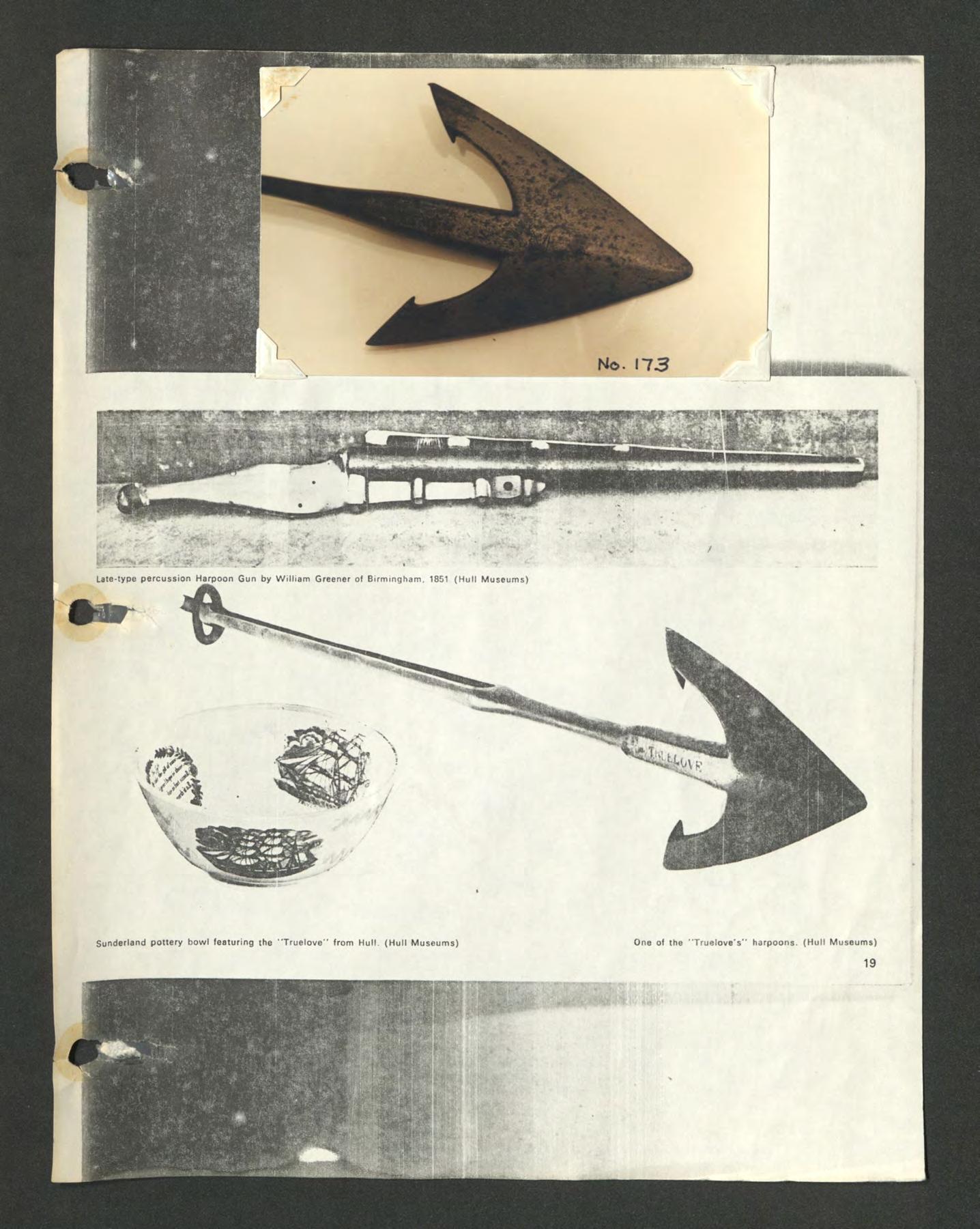No. 100 (RH123) gogi
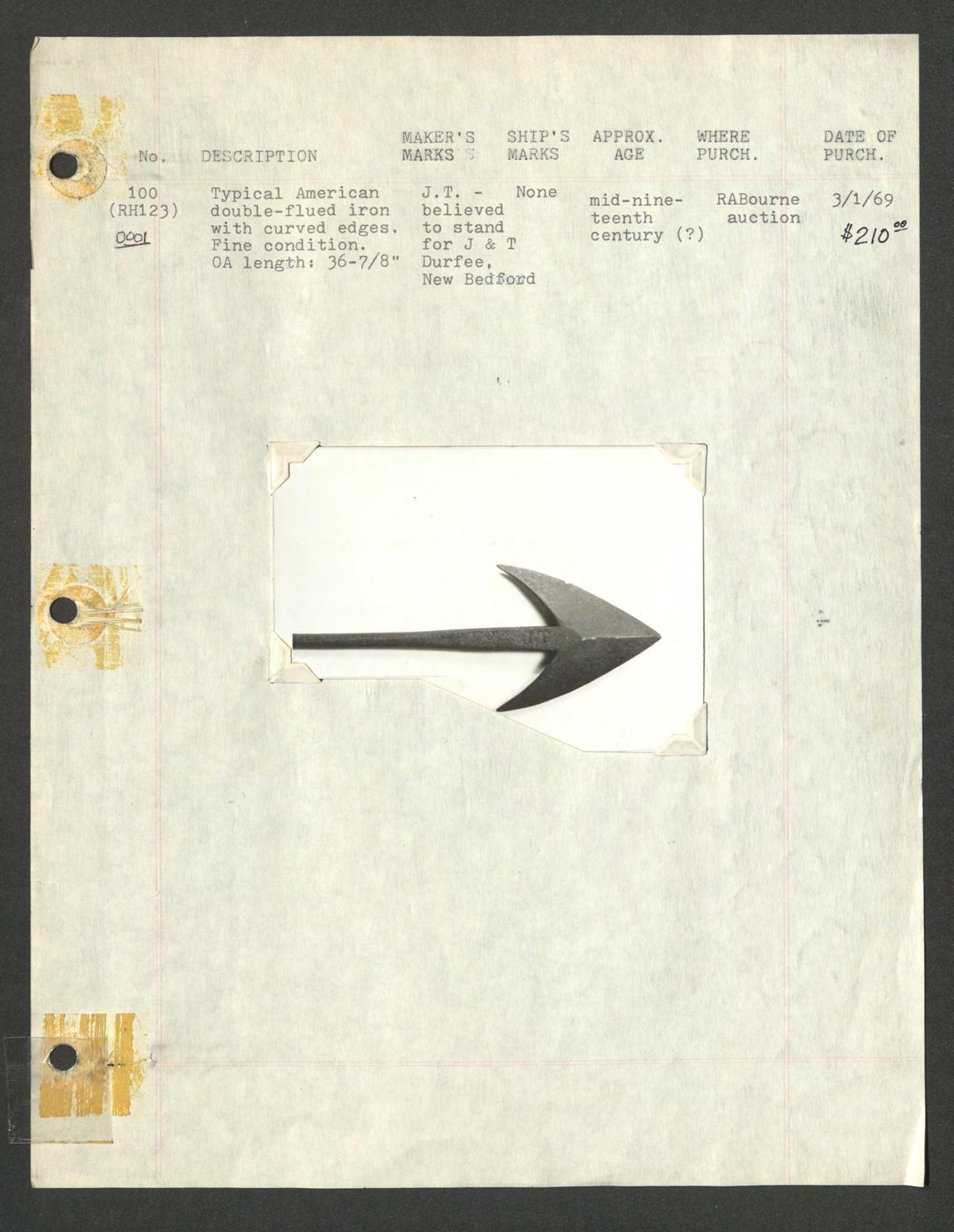
DESCRIPTION
Typical American double-flued iron with curved edges. Fine condition. OA length: 36-7/8"
MAKER'S MARKS SHIP'S MARKS
J.T. - None believed to stand for J & T Durfee, New Bedford
APPROX. AGE WHERE PURCH.
mid-nineteenth century (?) RABourne auction
DATE OF PURCH. 3/1/69 4Bio 00
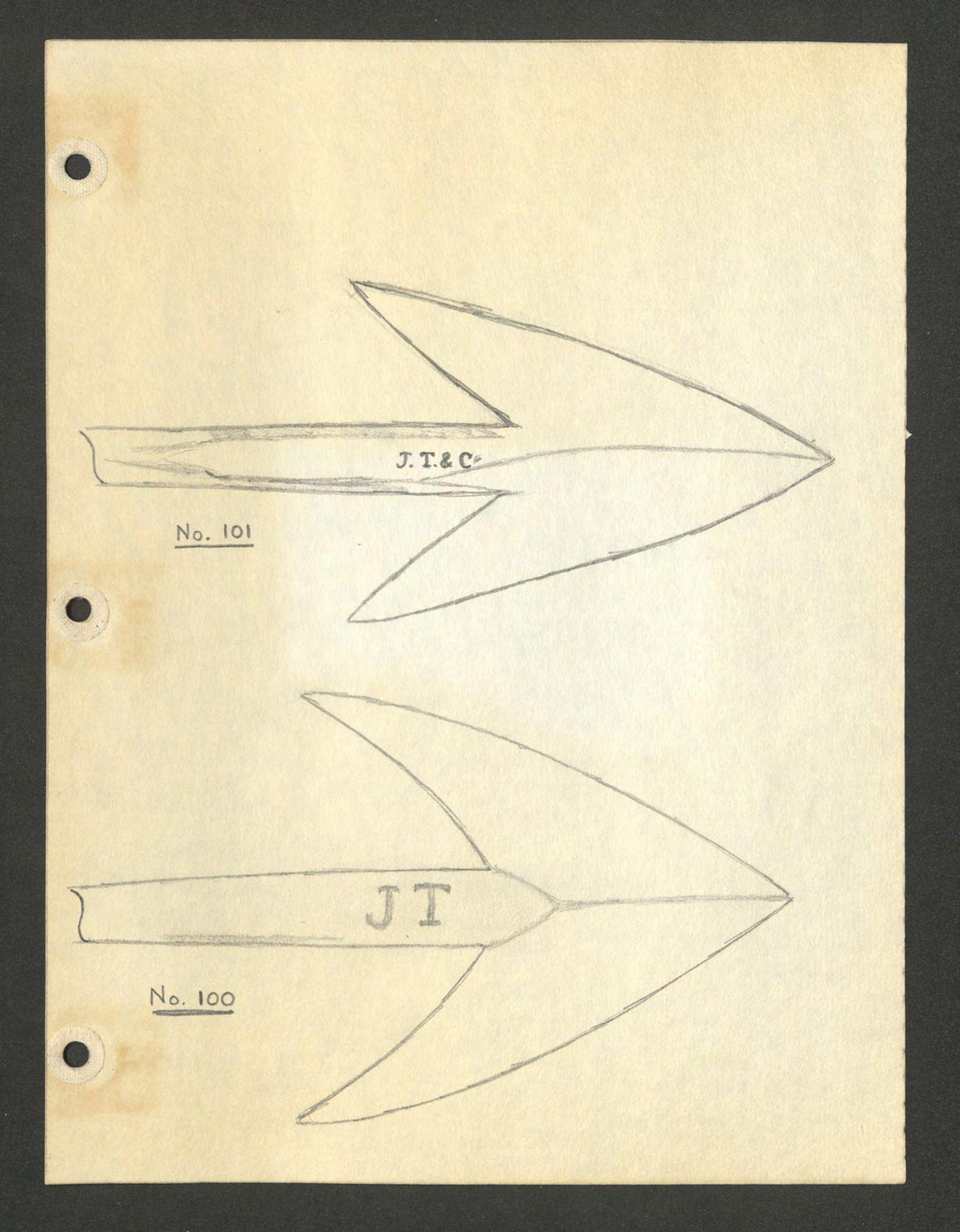
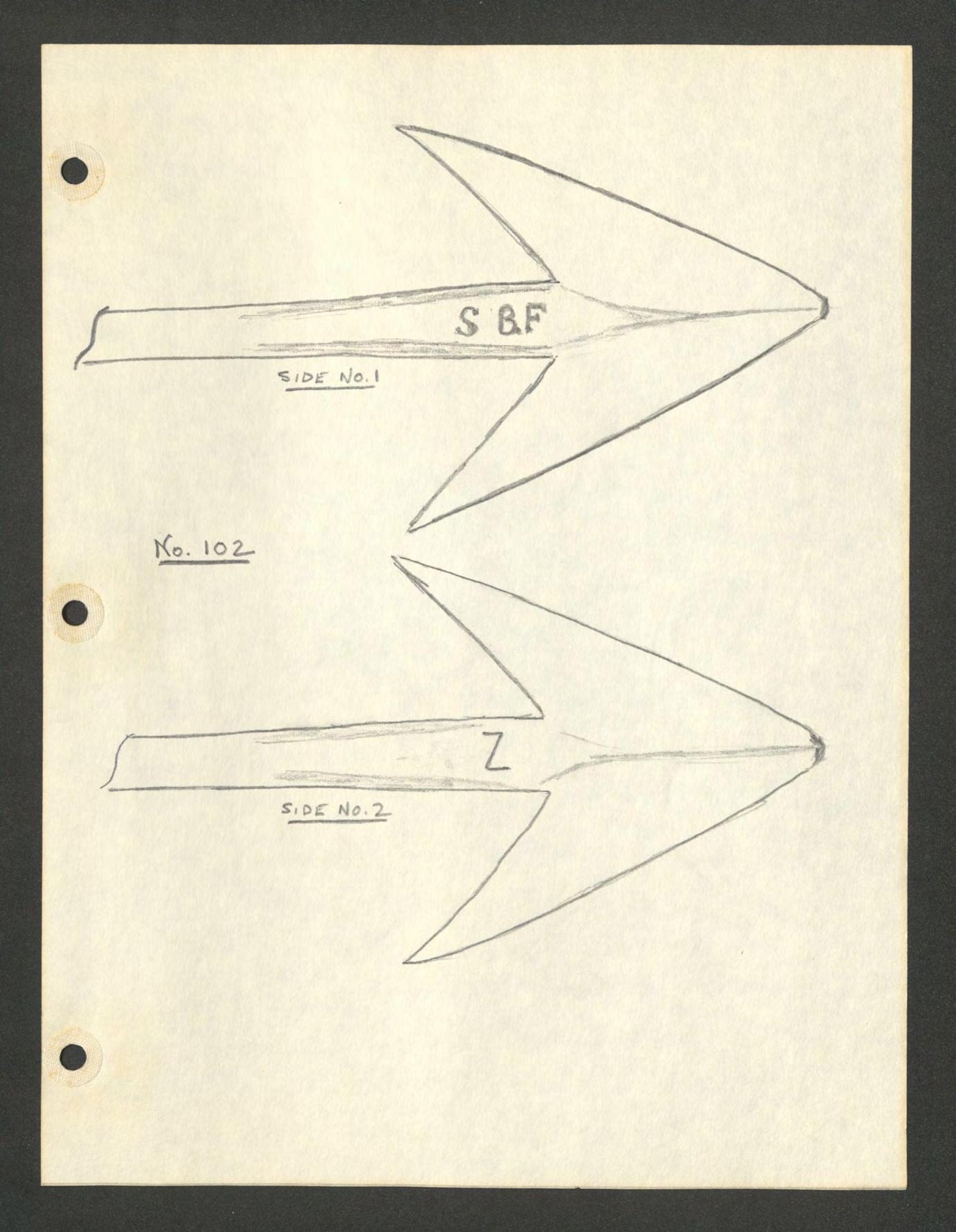
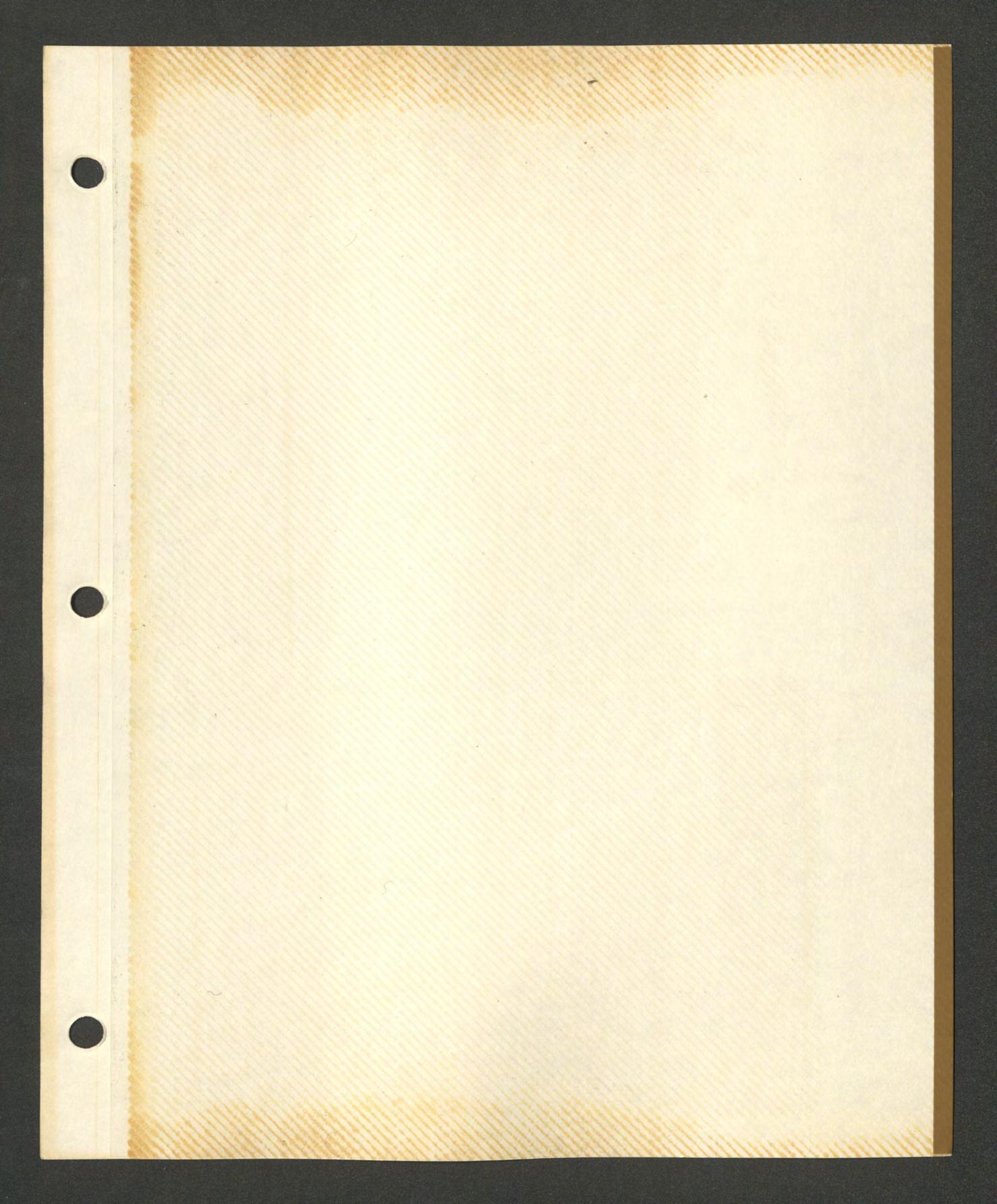
No. oool~ DESCRIPTION
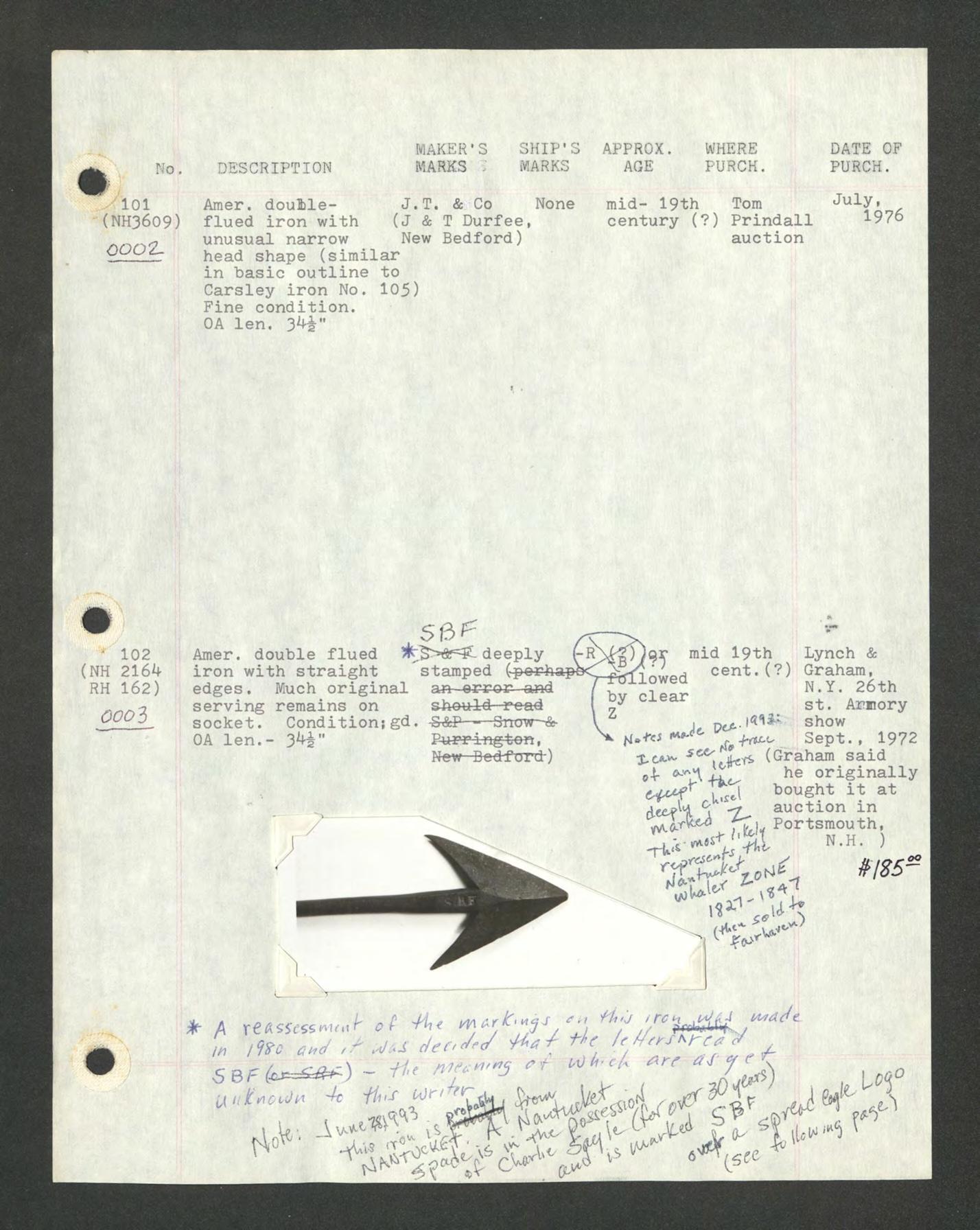
MAKER'S MARKS : SHIP'S MARKS APPROX. AGE WHERE PURCH,
101 Amer. doulble(NH3609) flued iron with unusual narrow head shape (similar in hasic outline to Carsley iron No. 105) Fine condition. OA len. 3H"
J.T. & Co None (J & T Durfee, New Bedford) mid- 19th Tom century (?) Prindall auction
DATE OF PURCH.
July, 1976
• 102 (NH 216*4RH 162)
OOO 3
Amer. double flued ^'.$>68=5^deeply iron with straight stamped (• edges. Much original an-error and serving remains on should read socket. Condition;gd.-ST&P Snow—&OA len.- 3H" Purringtort, New Bed-ford-)
mid 19th Lynch & lowed cent-(?) Graham, , x°wea N.Y. 26th by clear gt> Arinory U VtA-'w show ^ ,-f^ Sept., 1972 scc" Izfi, (Graham said o*r **$.+1^ he originally b0U!13t ib at Axc»h \ -~7 auction m fV,L Portsmouth, N.H. )
#IS5~
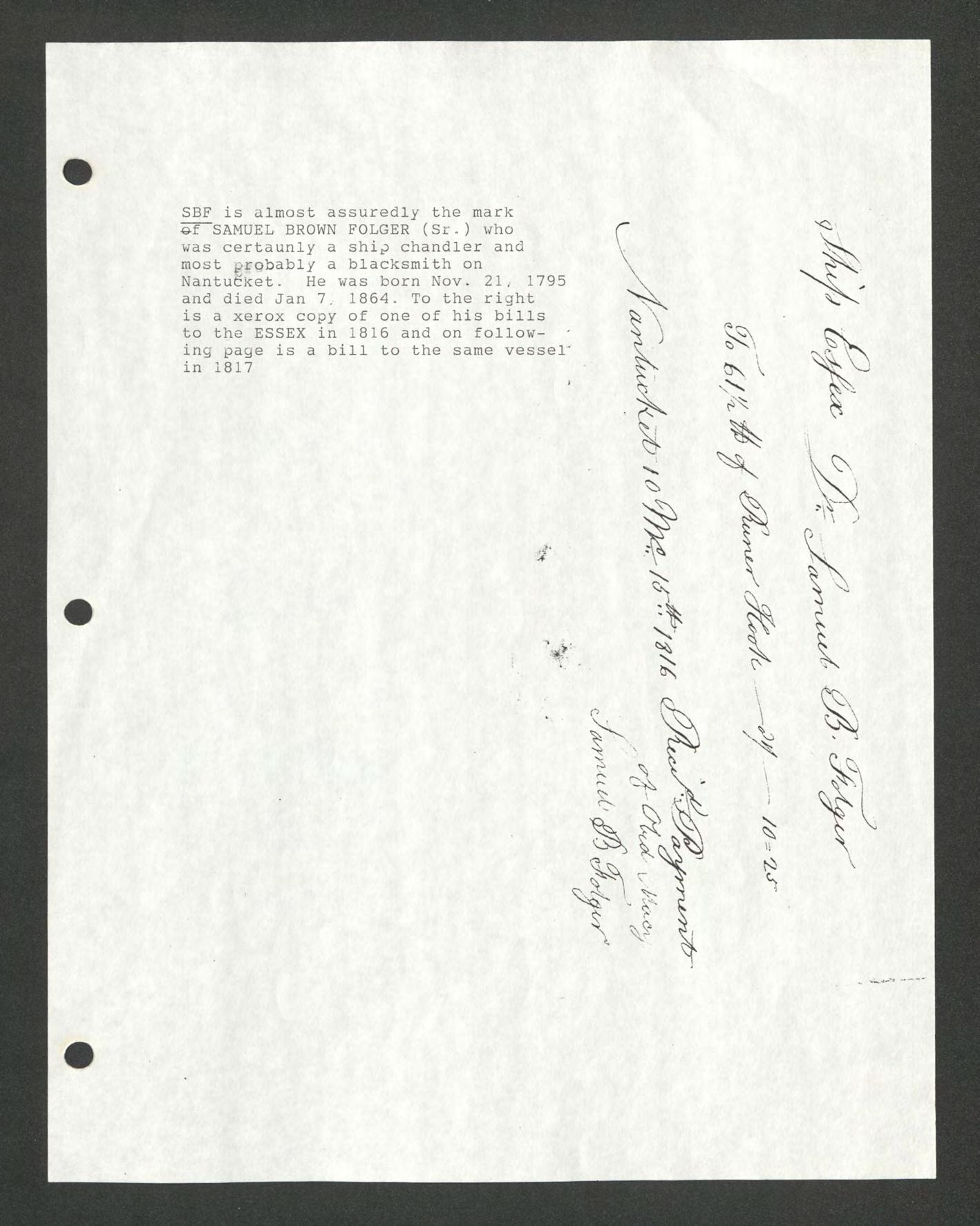
SBF is almost assuredly the mark if SAMUEL BROWN FOLGER (Sr.) who was certaunly a ship chandler and most probably a blacksmith on Nantu6ket. He was born Nov. 21, 1795 and died Jan 7. 1854. To the right is a xerox copy of one of his bills to the ESSEX in 1816 and on following page is a bill to the same vessel" in 1817
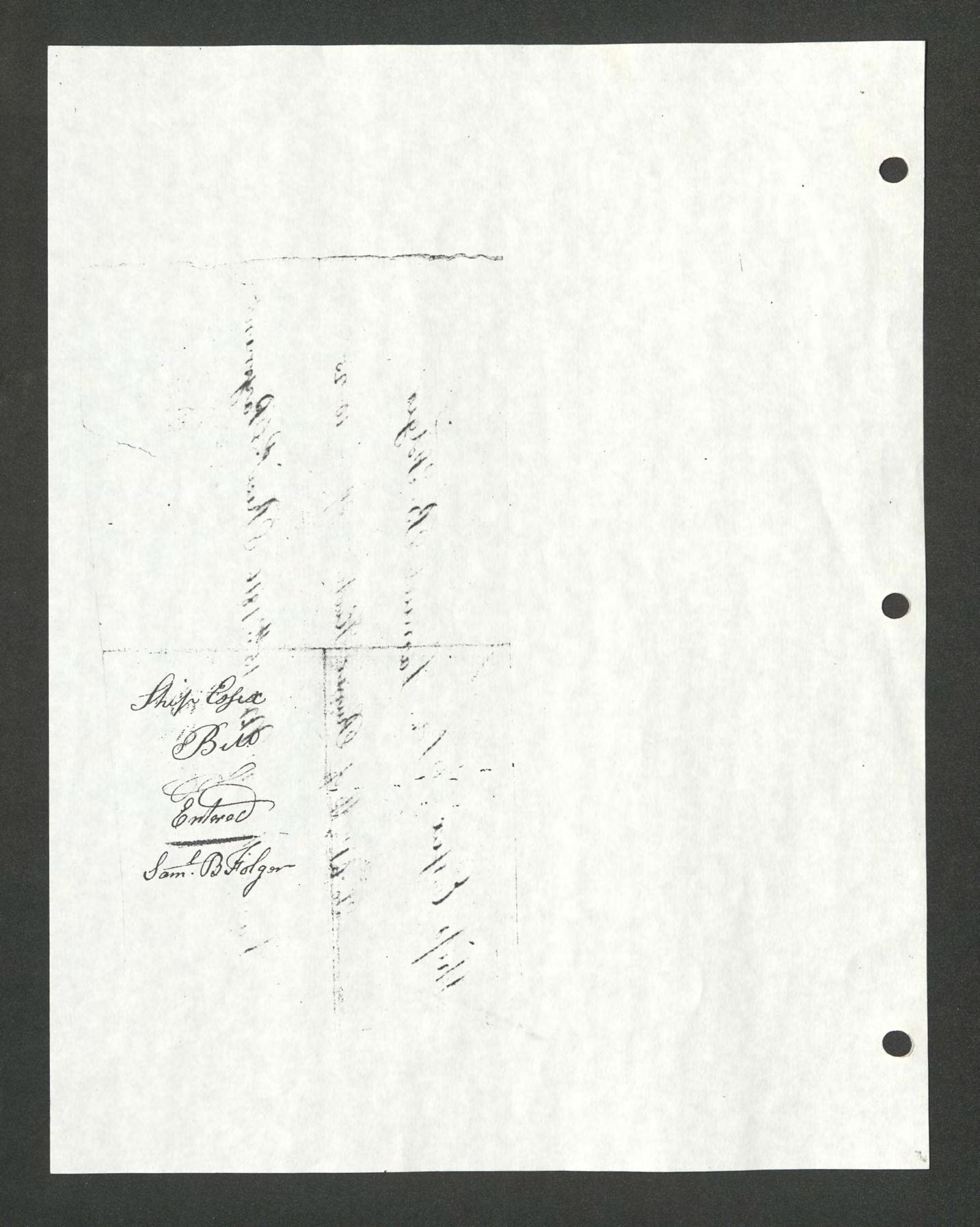
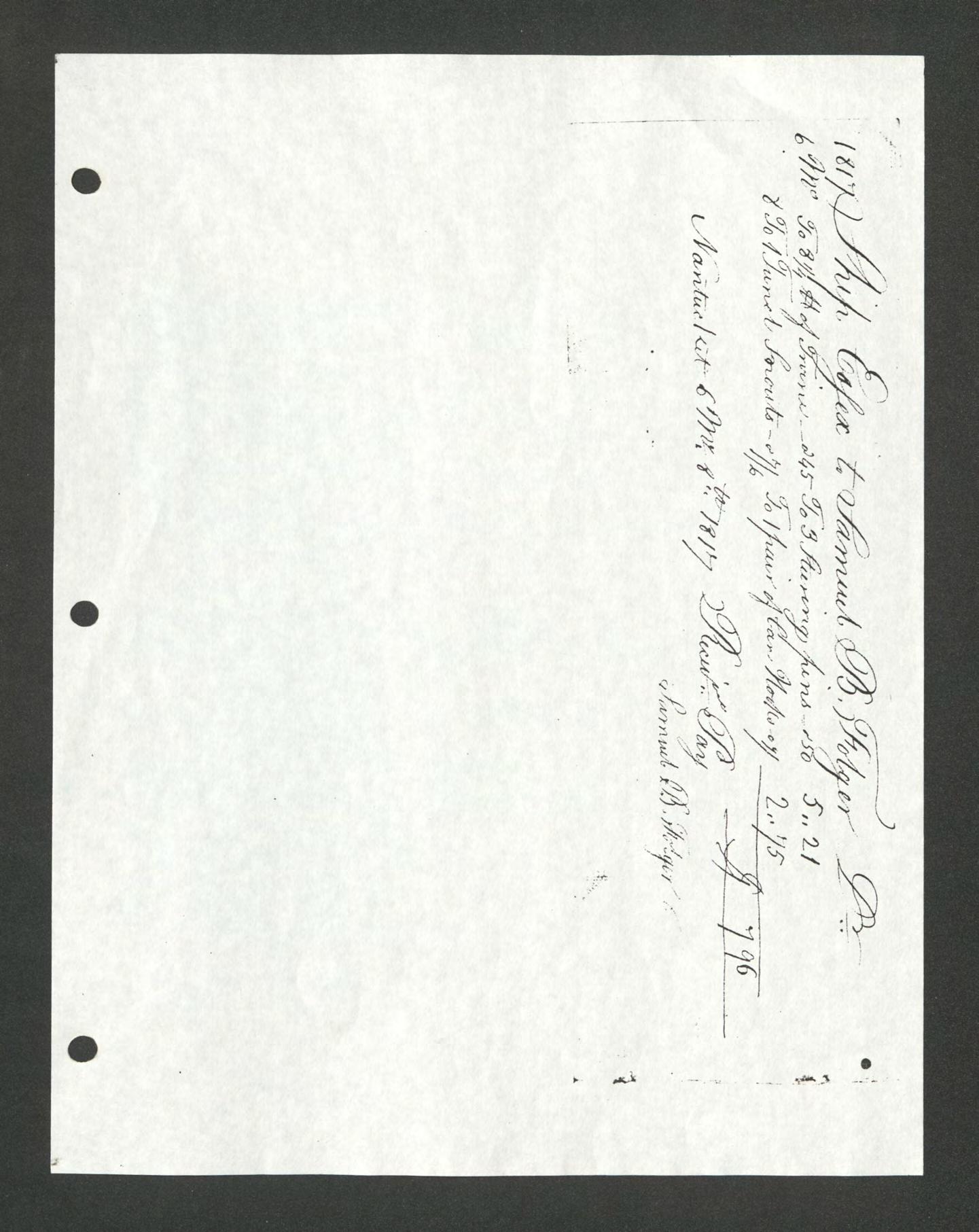
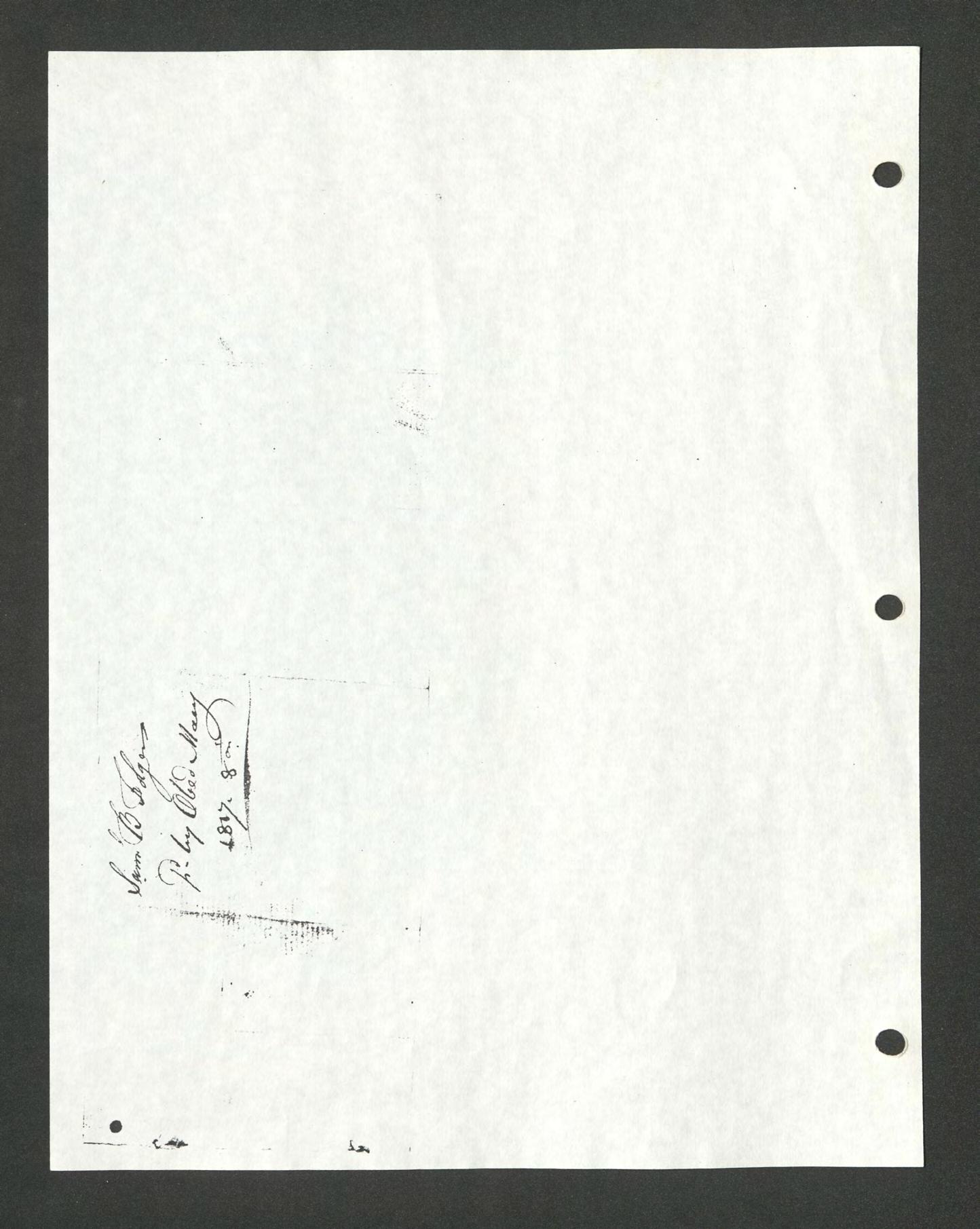
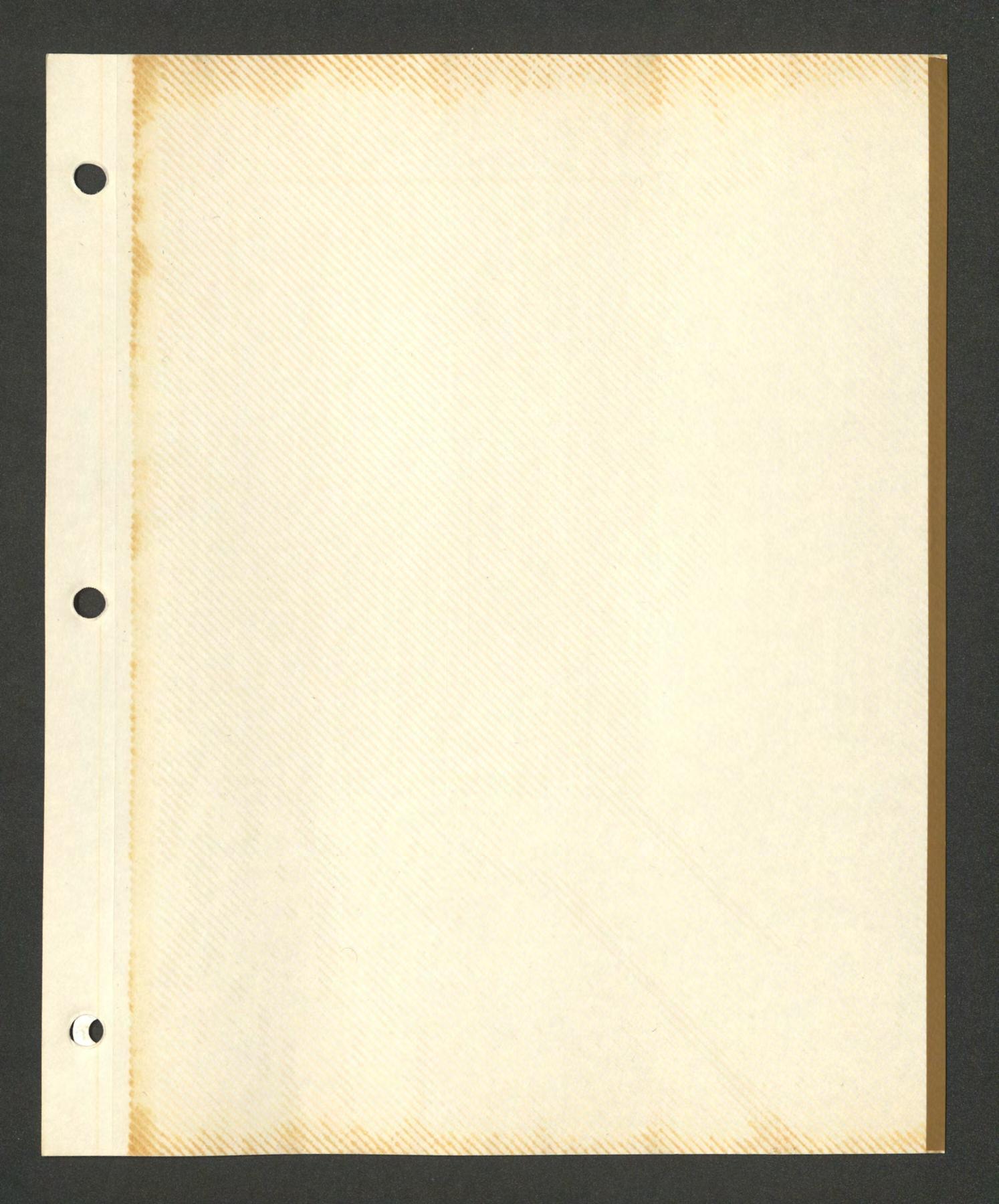
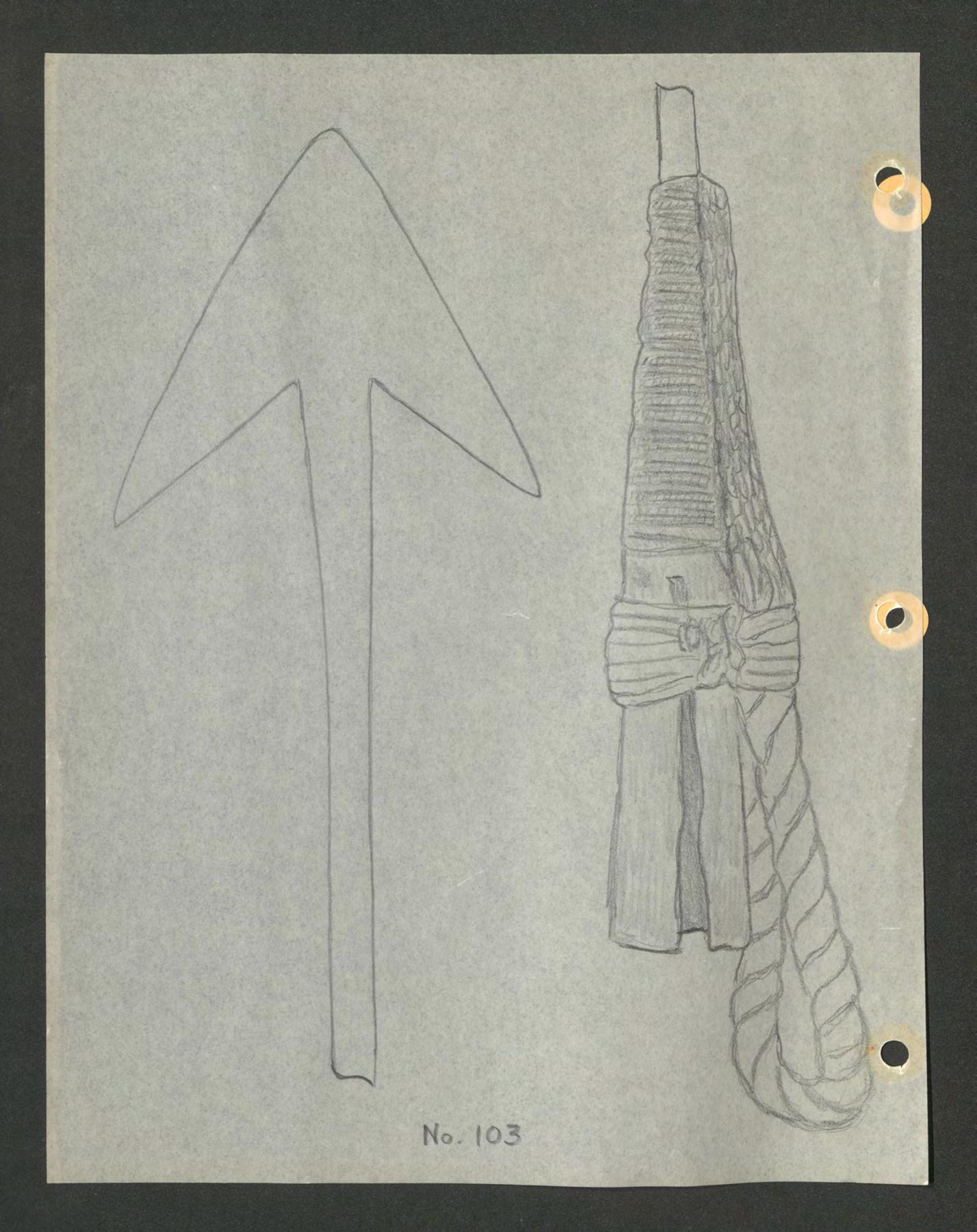
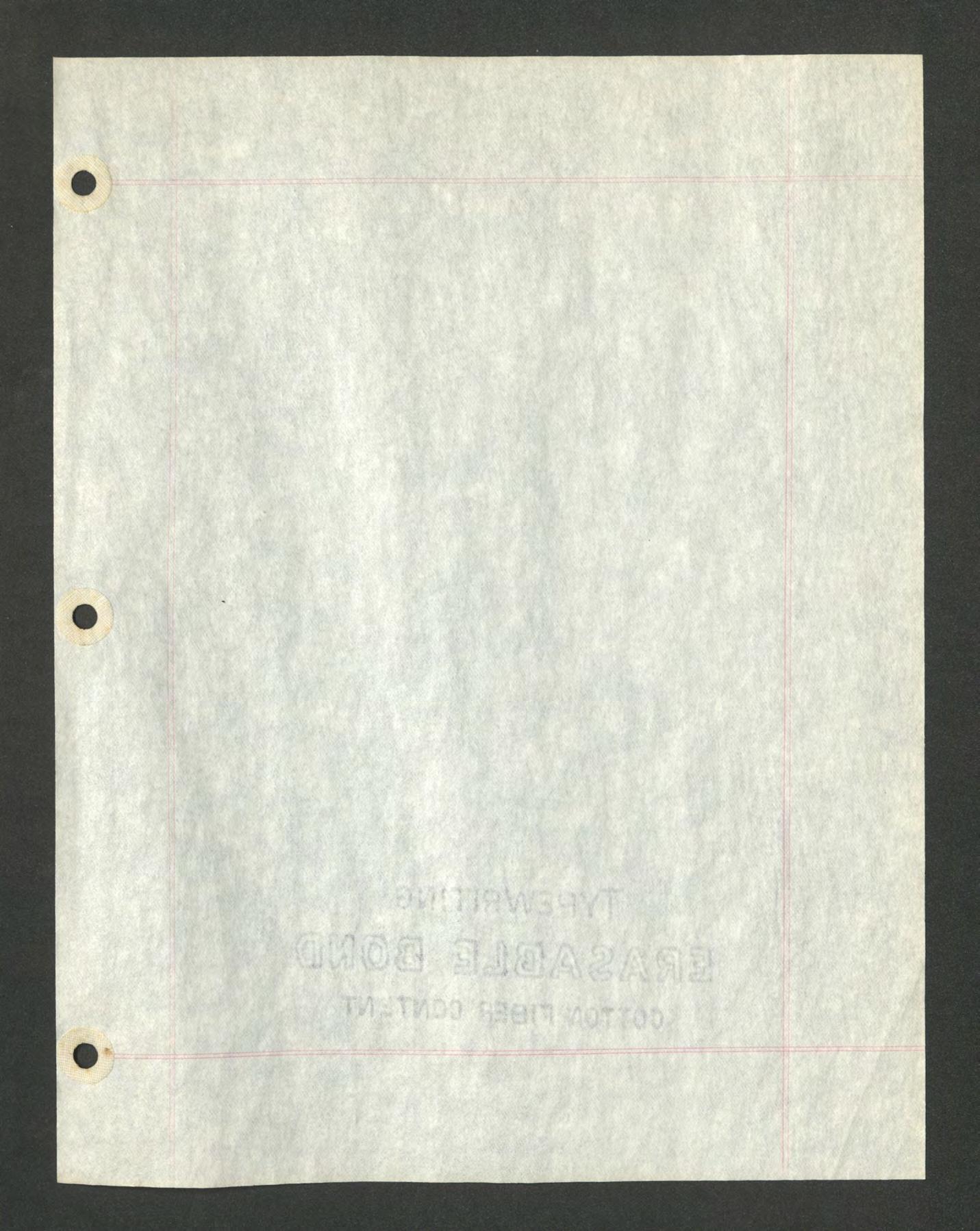
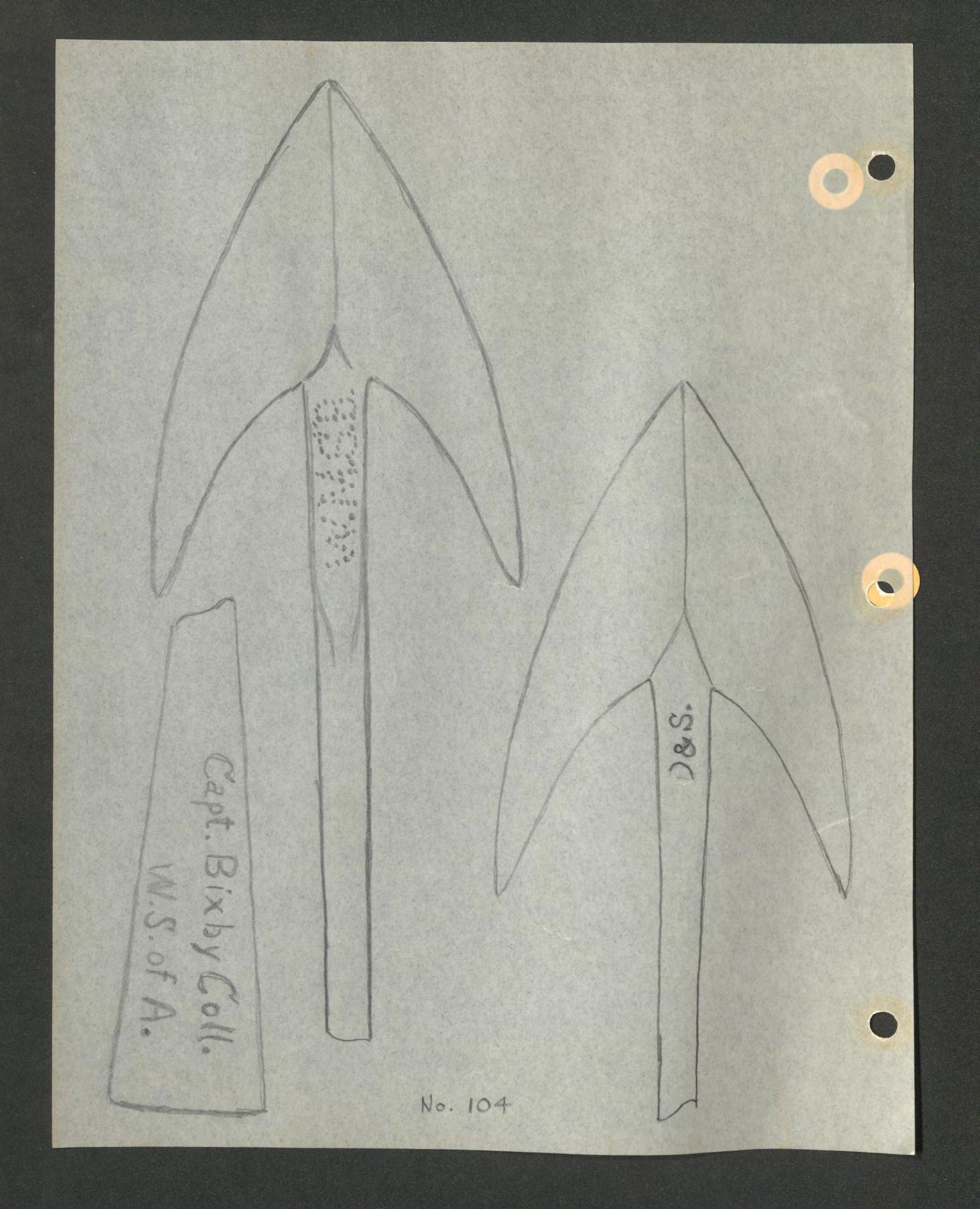
No. DESCRIPTION
103 ass8
00c*h
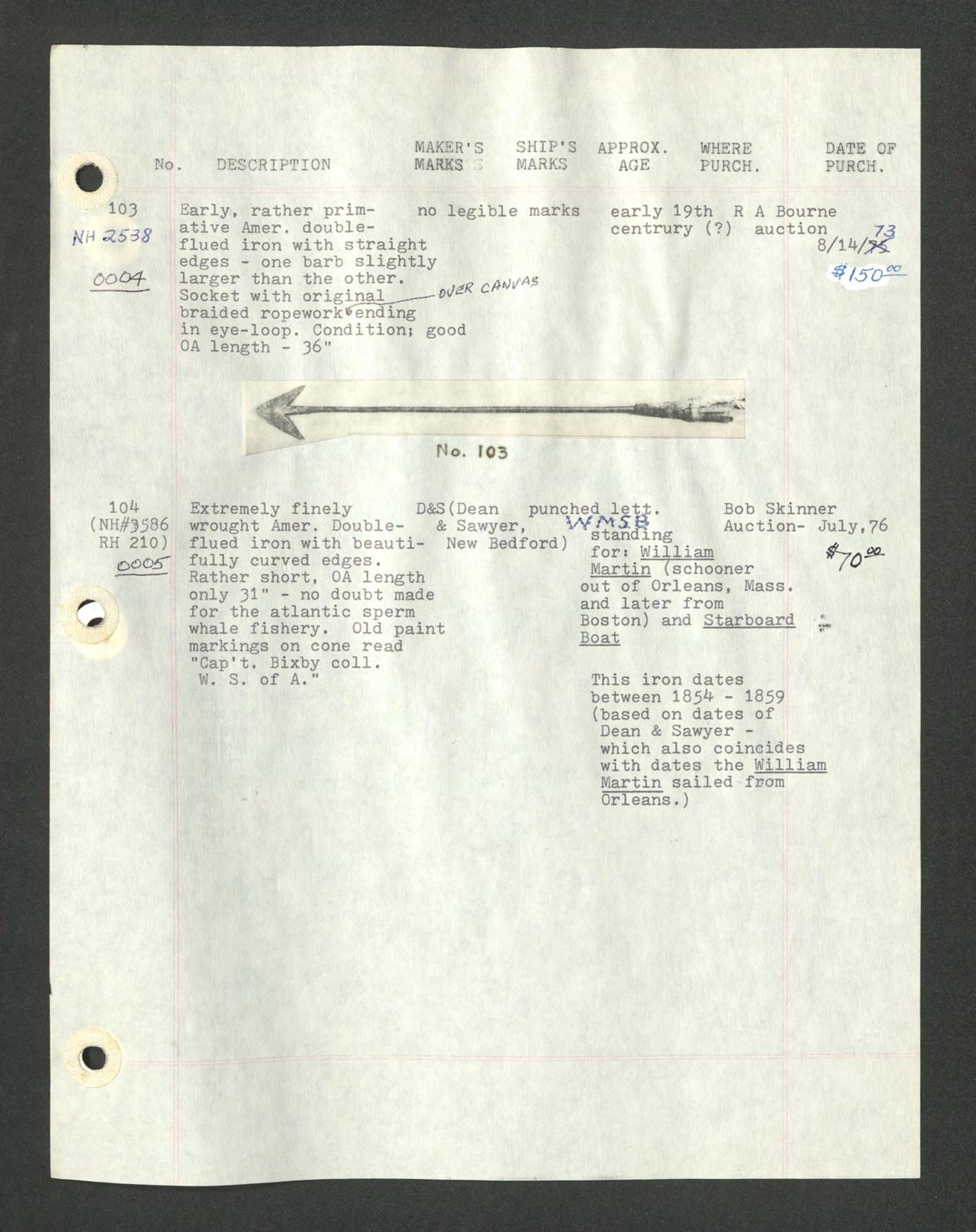
MAKER'S SHIP'S APPROX. WHERE DATE OF MARKS O MARKS AGE PURCH. PURCH.
Early, rather primative Amer. doubleflued iron with straight edges - one barb slightlylarger than the other. Socket with original.braided ropework(£ending in eye-loop. Condition; good OA length - 36"
no legible marks early 19th R A Bourne centrury (?) auction 8/14.
No. 103
104
Extremely finely D&S(Dean punched lett. (NH#3586 wrought Amer. Double- & Sawyer, WAtS.|5 RH 210) flued iron with beauti- New Bedford) CxDCgT f"ully curved edges. * Rather short, OA length ^ only 31" - no doubt made for the atlantic sperm * whale fishery. Old paint markings on cone read "Cap't. Bixby coll. W. S. of A."
standing for: William Martin (schooner out of Orleans, Mass. and later from Boston) and Starboard Boat
Bob Skinner Auction- July,76 7'0 OIL
This iron dates between 1854 - 1859 (based on dates of Dean& Sawyerwhich also coincides with dates the William Martin sailed from Orleans.)
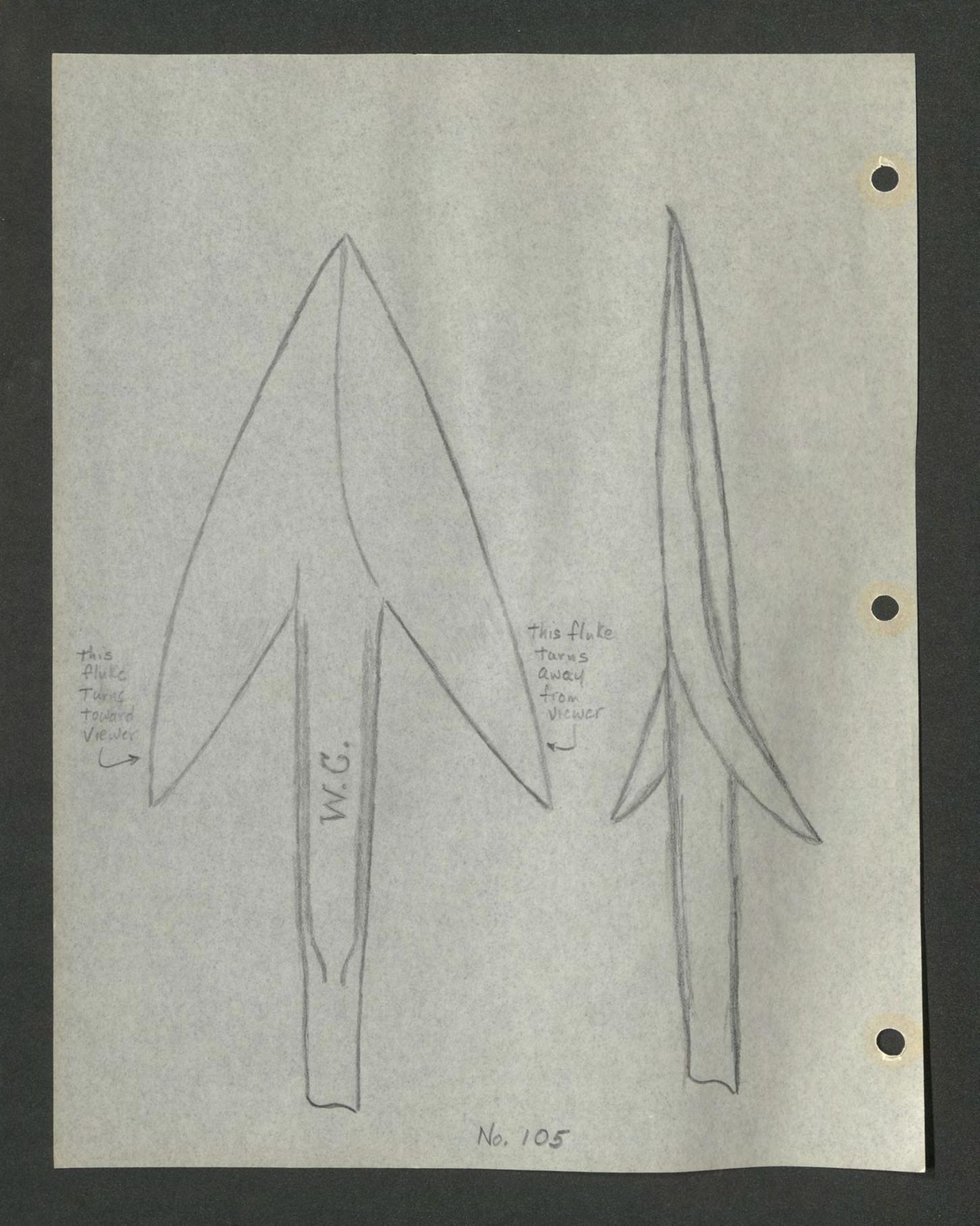
Ttir i •to;--- r \f i€ k, Lx*
No, DESCRIPTION
105 "William Carsley" (RH219) double-flued iron with twisted barbs.
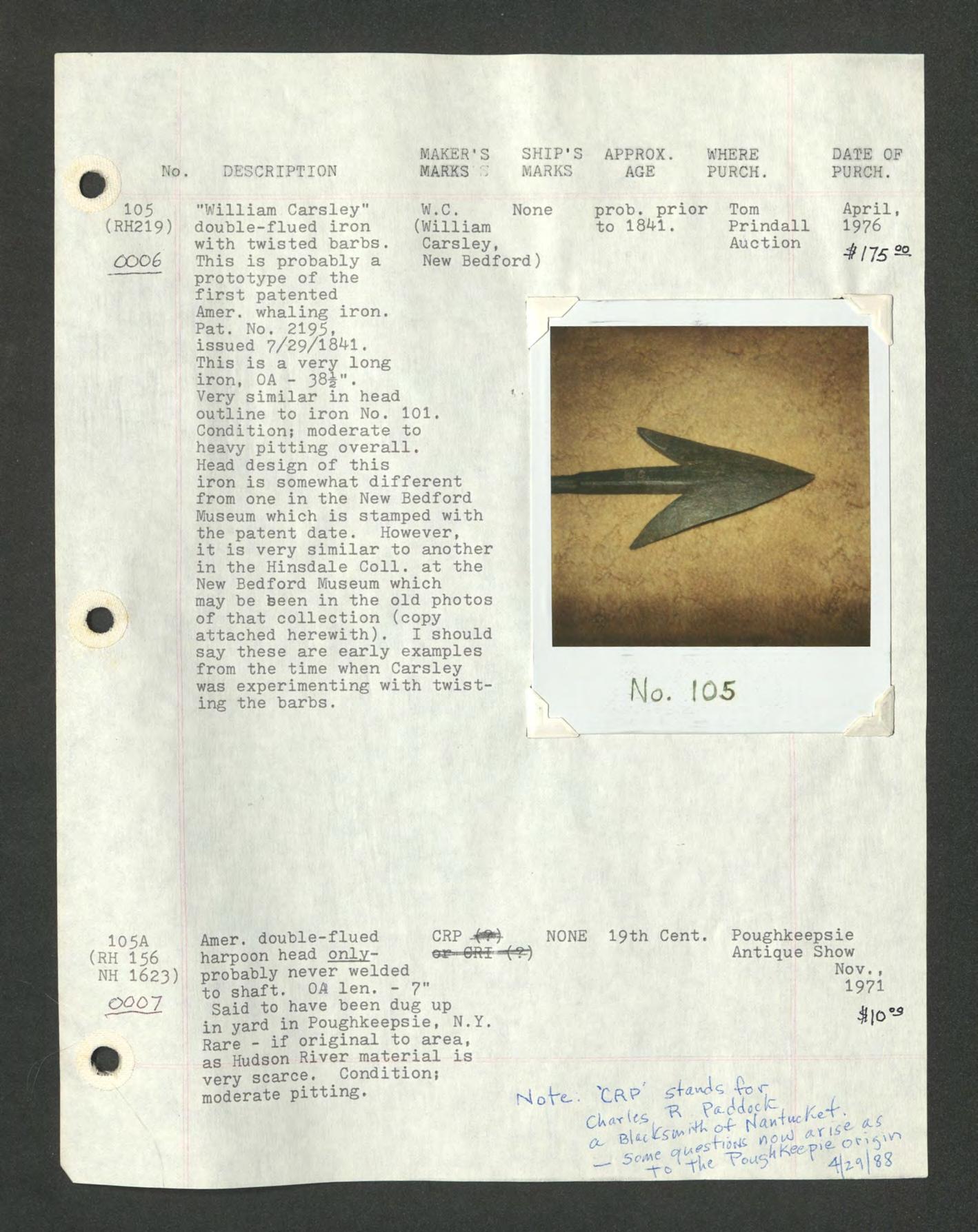
MAKER'S MARKS
W.C. None (William Carsley, New Bedford)
COOG This is probably a prototype of the first patented Amer. whaling iron. Pat. No. 2195, issued 7/29/1841. This is a very long iron, OA - 38£". Very similar in head outline to iron No. 101. Condition; moderate to heavy pitting overall. Head design of this iron is somewhat different from one in the New Bedford Museum which is stamped with the patent date. However, it is very similar to another in the Hinsdale Coll. at the New Bedford Museum which may be been in the old photos of that collection (copy attached herewith). I should say these are early examples from the time when Carsley was experimenting with twisting the barbs.
prob. prior to 1841. Tom Prindall Auction April, 1976 4176 °o
105A (RH 156 NH 1623) 0007 CRP
Amer. double-flued harpoon head onlyprobably never welded to shaft. OA len. - 7" Said to have been dug up in yard in Poughkeepsie, N.Y. Rare - if original to area, as Hudson River material is very scarce. Condition; moderate pitting.
NONE 19th Cent. Poughkeepsie Antique Show Nov., 1971 05
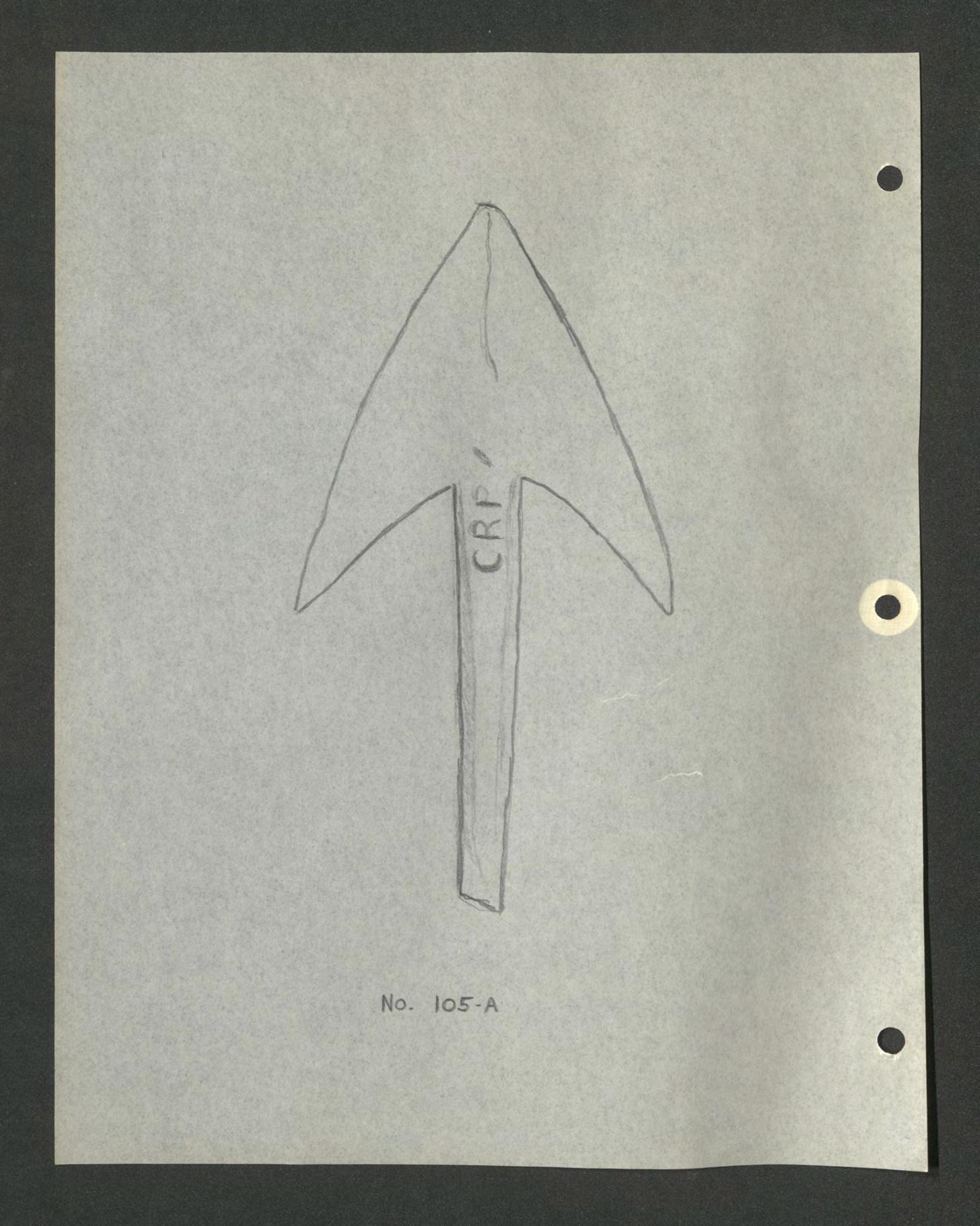
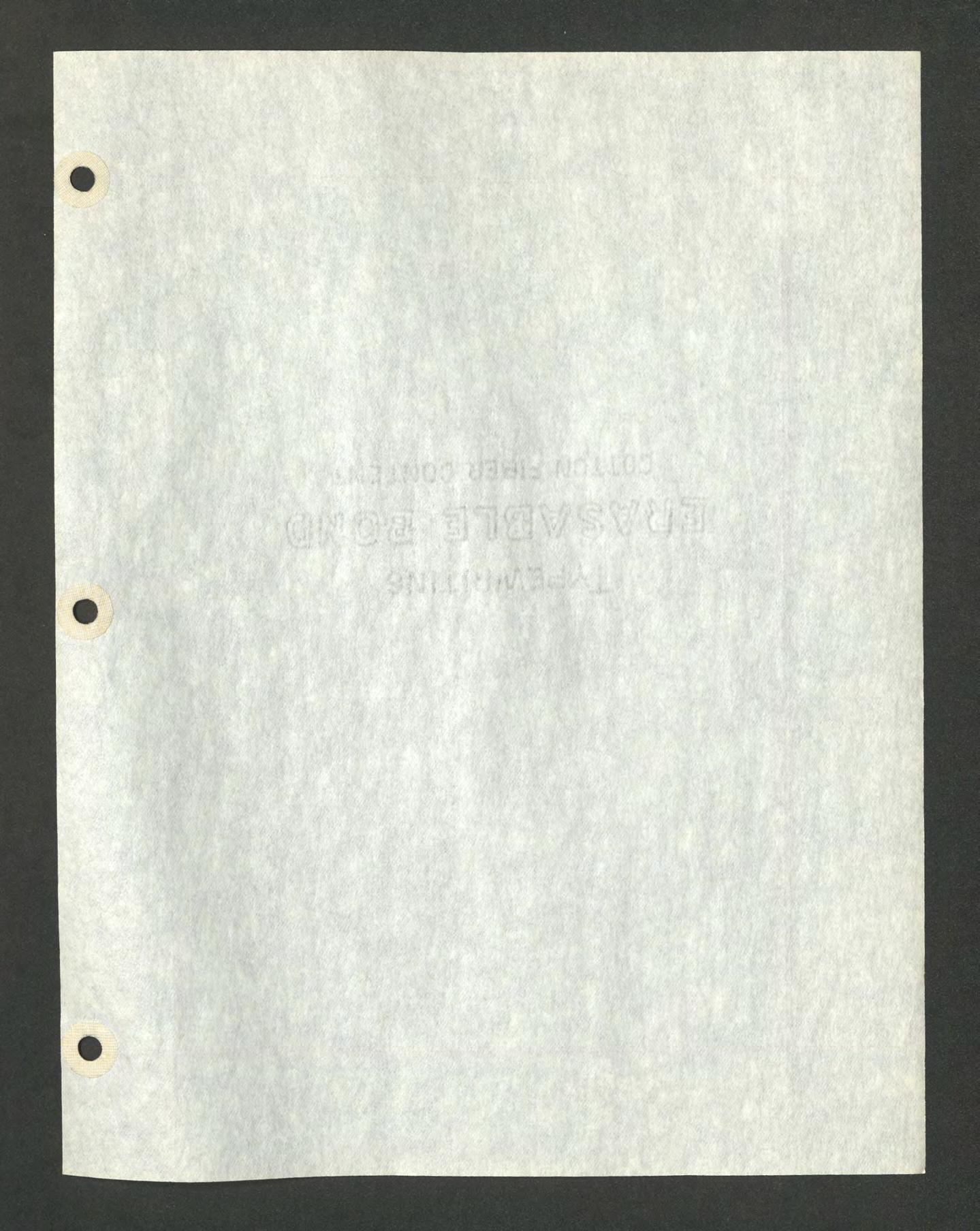
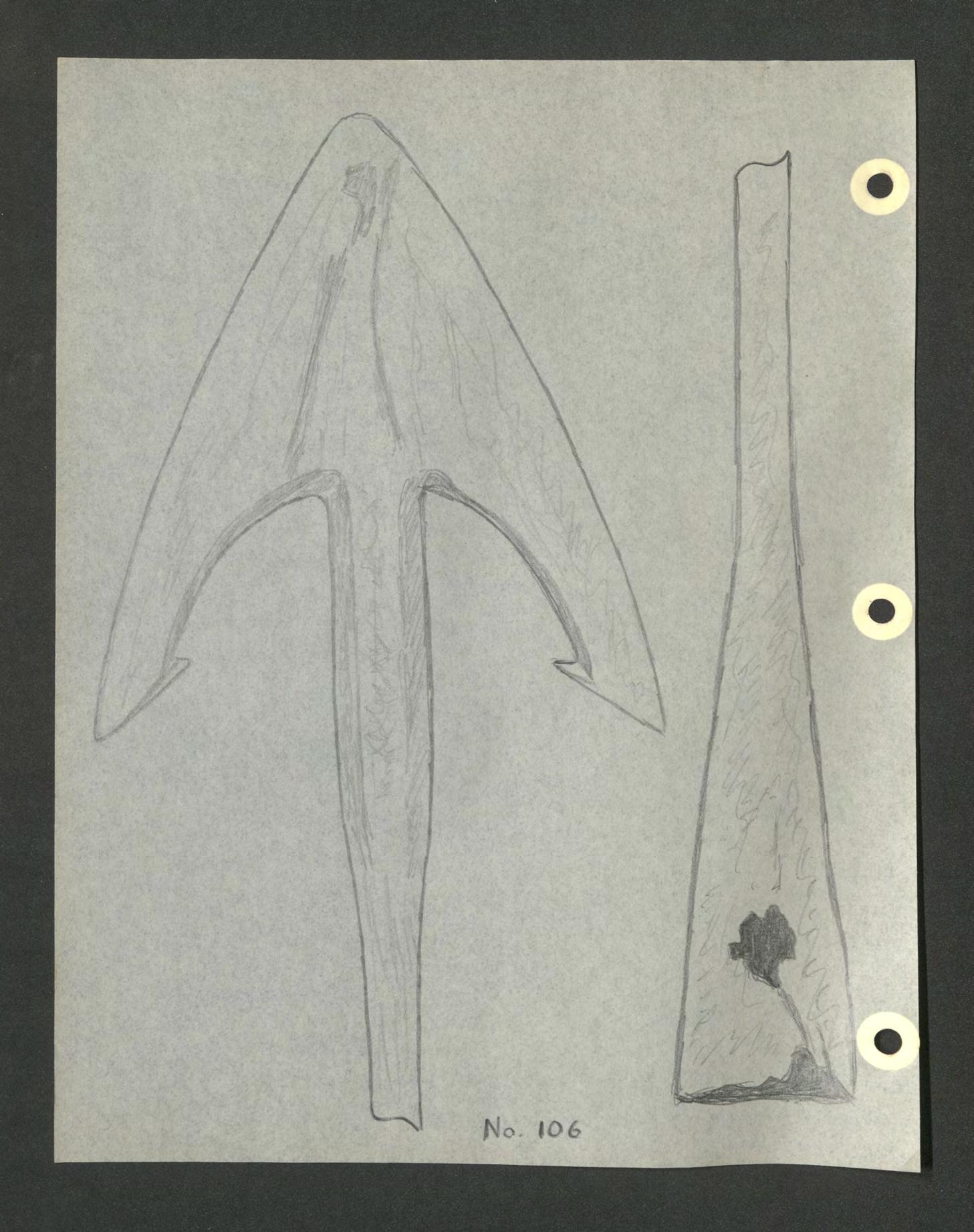
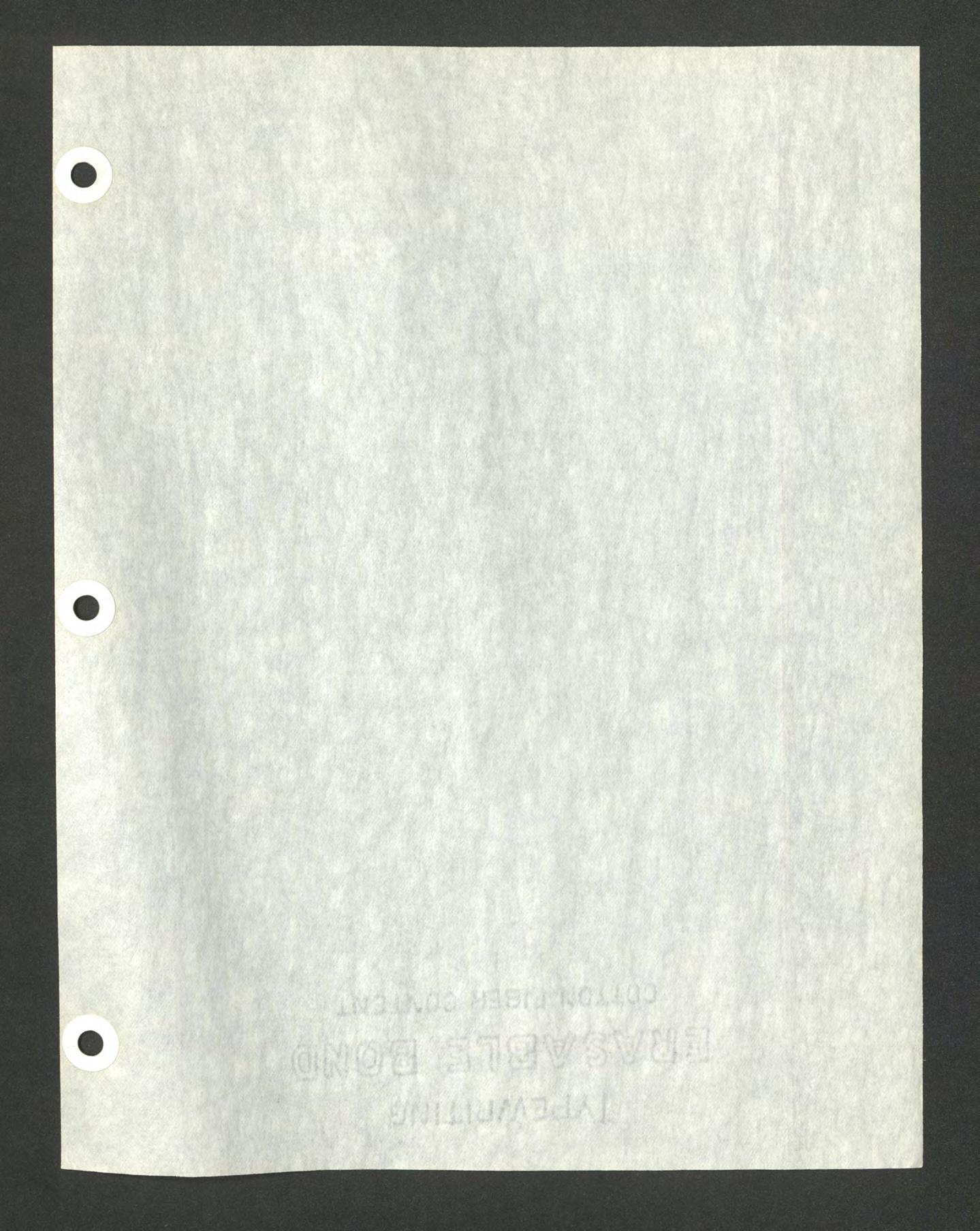
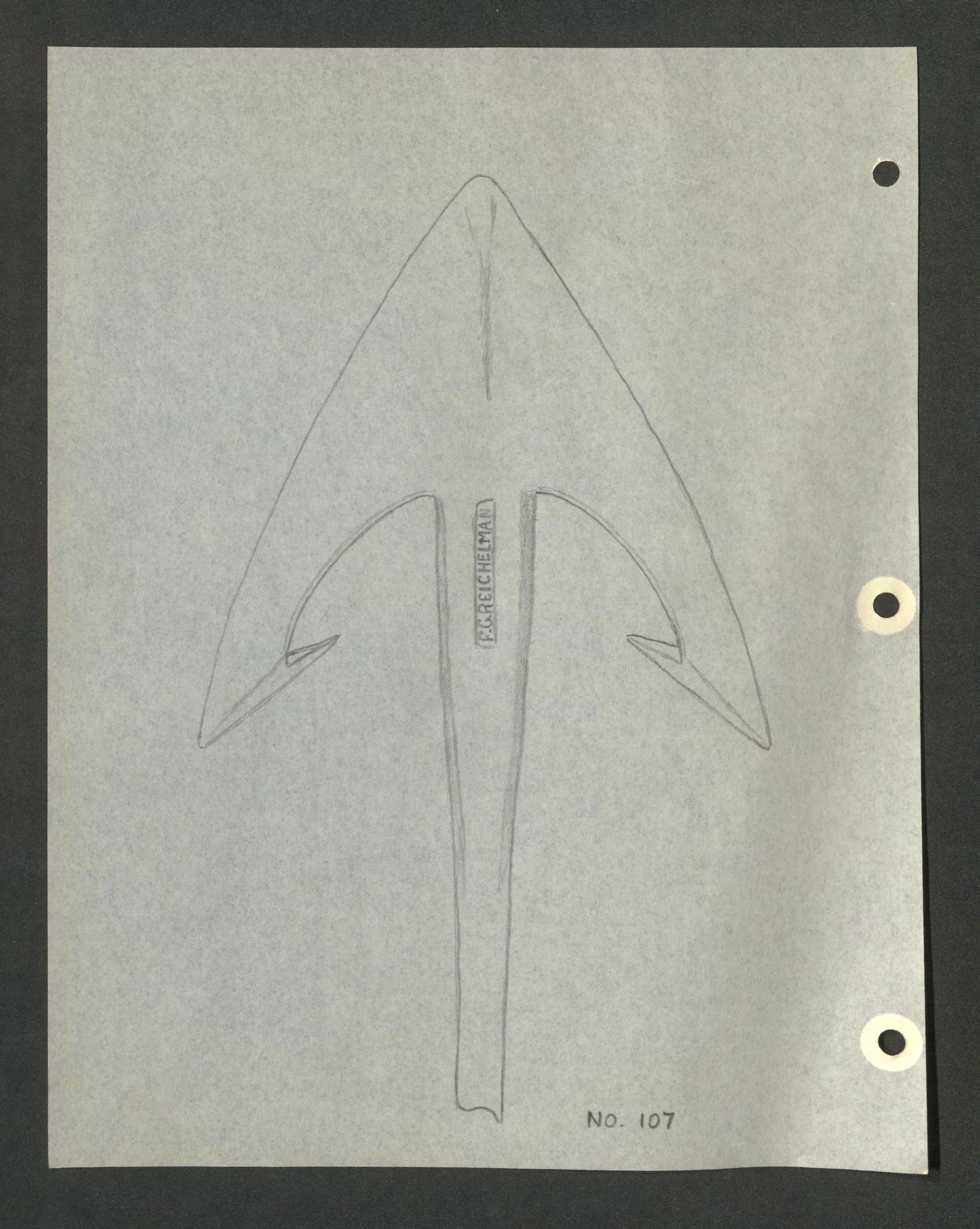
nESCRIPTION
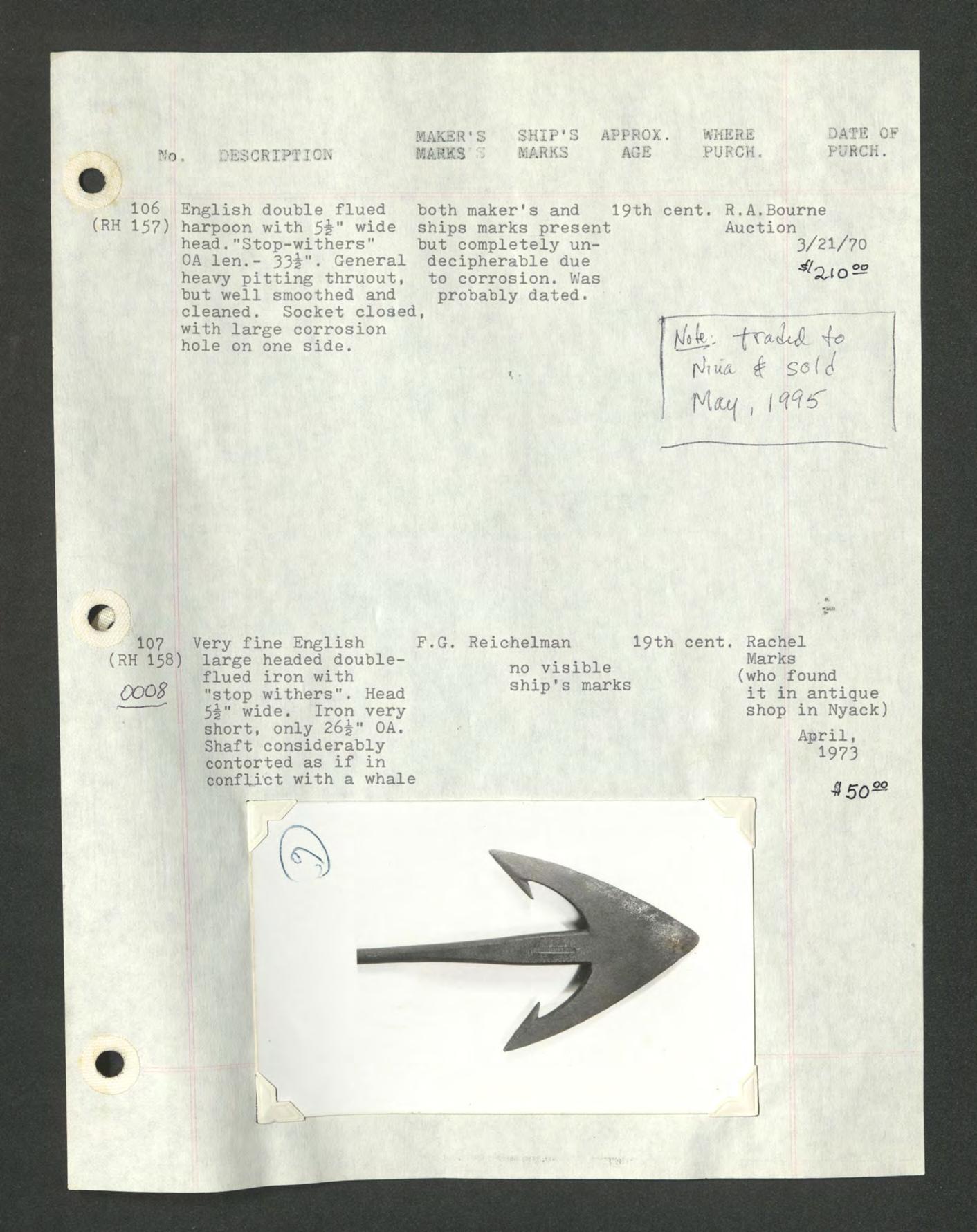
MAKER'S SHIP'S APPROX. WHERE MARKS 3 MARKS AGE PURCH.
106 English double flued (RH 157) harpoon with Sz" wide head."Stop-withers" OA len.- 33a"' General heavy pitting thruout, but well smoothed and cleaned. Socket closed, with large corrosion hole on one side.
both maker's and 19th cent, ships marks present but completely undecipherable due to corrosion. Was probably dated.
DATE OF PURCH.
R.A.Bourne Auction 3/21/70 4'XlO —
1/
107 (RH 158) OOOS
Very fine English large headed doubleflued iron with "stop withers". Head 5|" wide. Iron very short, only 26|" OA. Shaft considerably contorted as if in conflict with a whale
F.G. Reichelman no visible ship's marks 19th cent. Rachel Marks (who found it in antique shop in Nyack)
April, 1973
45000
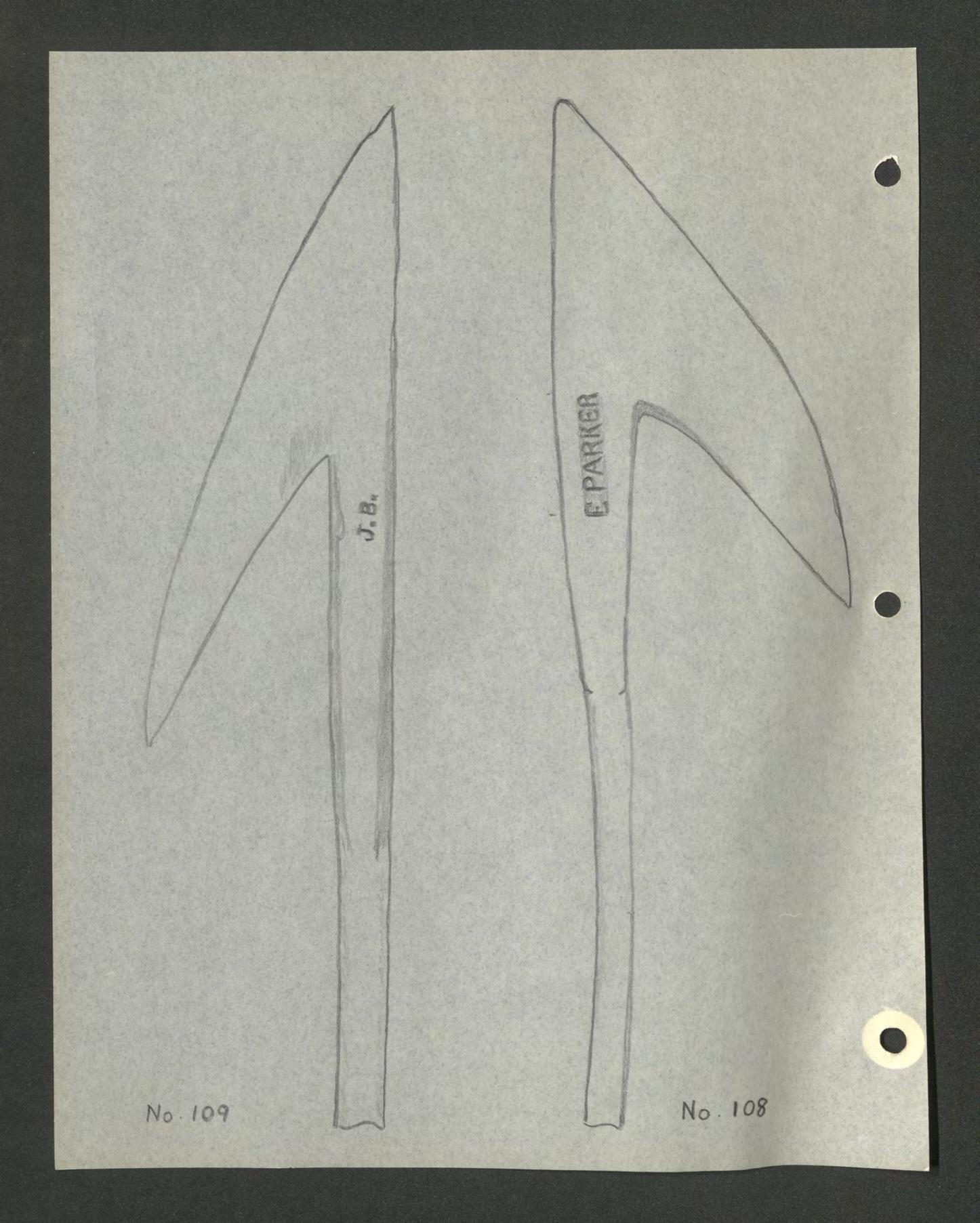
MAKER
!S No. DESCRIPTION /IARKS
SHIP'S MARKS
APPROX AGE
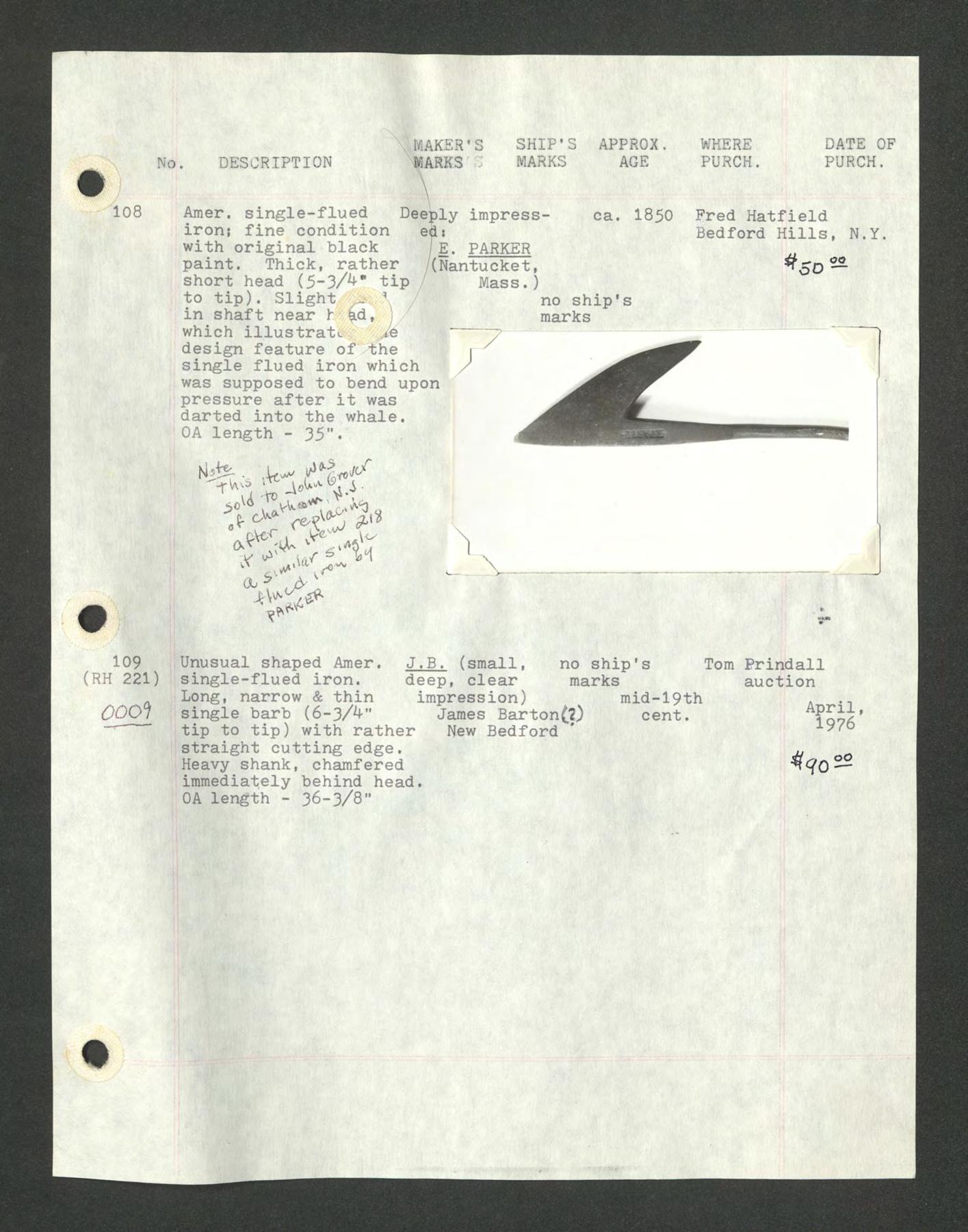
108 Amer. single-flued iron; fine condition with original black paint. Thick, rather short head (5-3/^" tip to tip). Slight _ 1 /k in shaft near I id, which illustrate M design feature of the single flued iron which was supposed to bend upon pressure after it was darted into the whale. OA length - 35".
Deeply impressed!
E. PARKER
ca. 1850 WHERE PURCH. DATE OF PURCH, (Nantucket, Mass.)
no ship's marks
Fred Hatfield Bedford Hills, N.Y.
109 (RH 221) 000°!
Unusual shaped Amer. single-flued iron. Long, narrow & thin single barb (6-3/^" tip to tip) with rather straight cutting edge. Heavy shank, chamfered immediately behind head, OA length - 36-3/8"
J.B, (small, deep, clear impression)
James Barton(?) New Bedford
no ship's Tom Prindall marks auction mid-l9th cent. April, 1976
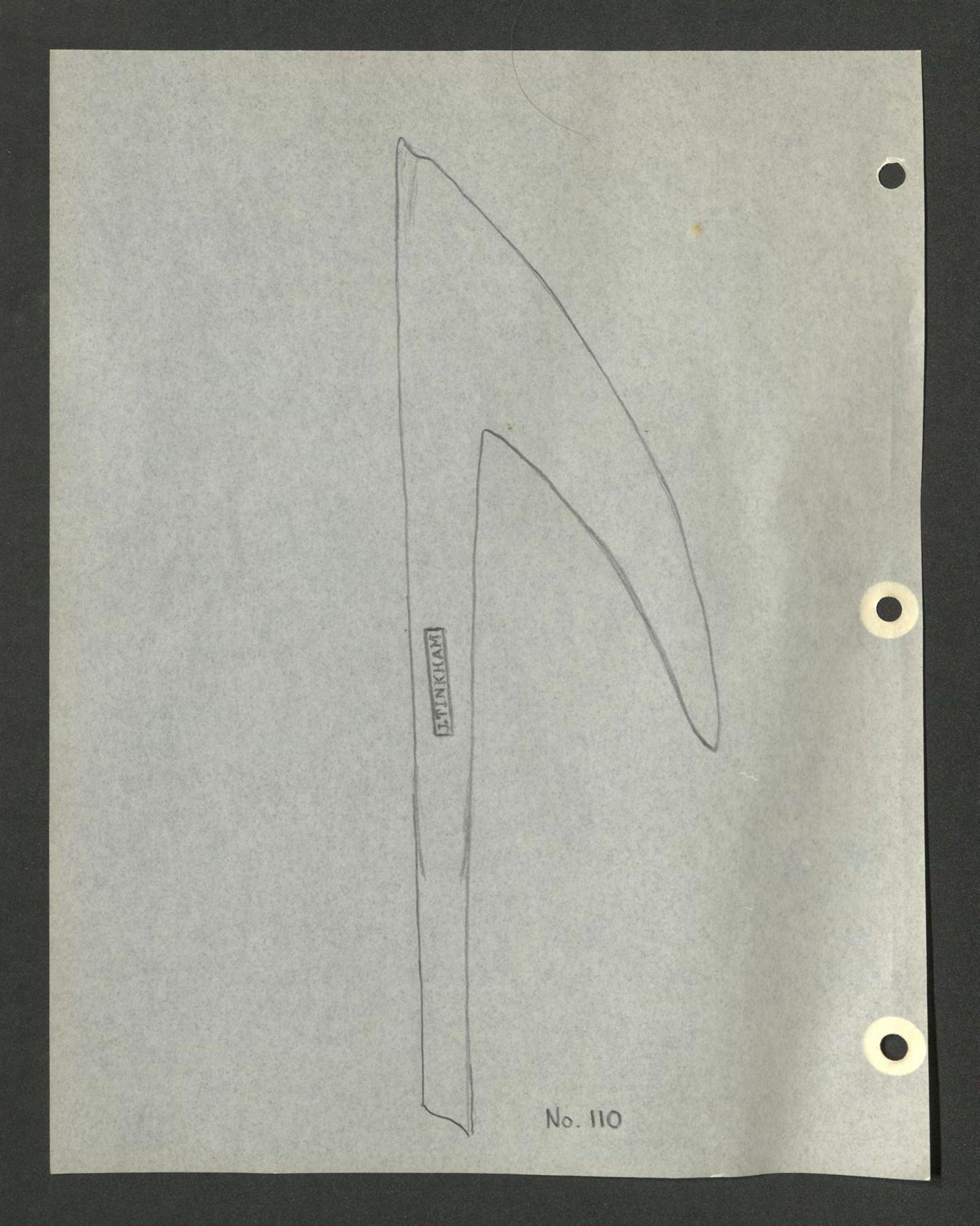
1W (RHT25)
No, DESCRIPTION
Good Amer. singleflued iron with long strongly curved barb (6f" on str. line measure-
(J. TINKHAM 1
^ment - tip to tip)shank
lmPrfl§?lniSetypical of Tinkham's trademark
\ Jo i jr moderately heavy and short. OA len. - 31-7/8"
Moderate pitting on shaft and head. Sizeable
" A, v \ flake missing from head i°.^hnear point on left side 0^1 \\l (see photo)
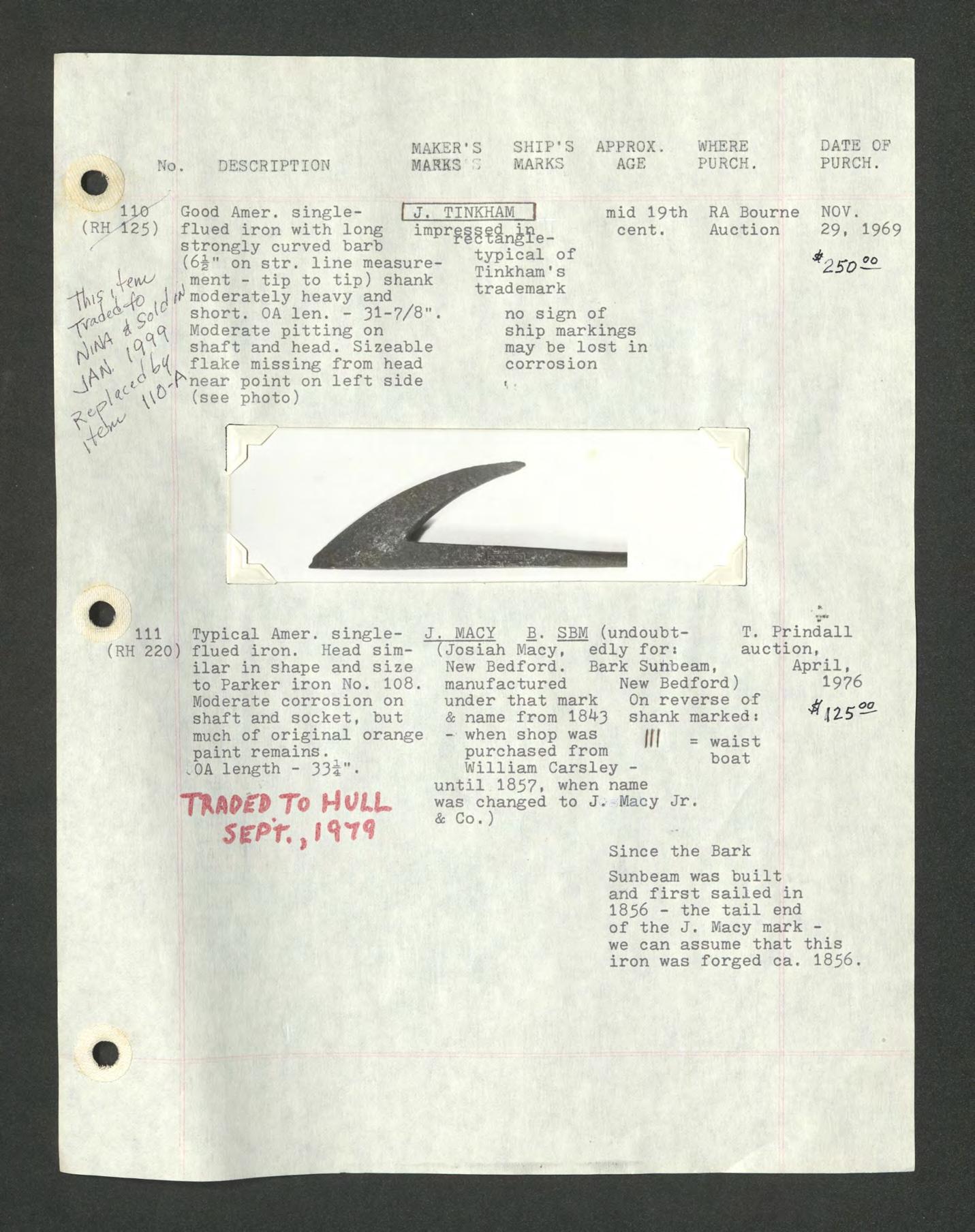
mid 19th cent. RA Bourne Auction NOV. 29, 1969
no sign of ship markings may be lost in corrosion
111 Typical Amer. single(RH 220)flued iron. Head similar in shape and size to Parker iron No. 108. Moderate corrosion on shaft and socket, but much of original orange paint remains. .OA length - 33!"•
J. MACY B. SBM (undoubt(Josiah Macy, edly fors New Bedford. Bark Sunbeam, manufactured New Bedford)
T. Prindall auction, April, 1976 under that mark & name from 18*4-3 - when shop was purchased from William Carsleyuntil 1857, when name was changed to J. Macy Jr & Co.) On reverse of shank markeds III = waist boat
Since the Bark Sunbeam was built and first sailed in 1856 - the tail end of the J. Macy markwe can assume that this iron was forared ca. 1856
m
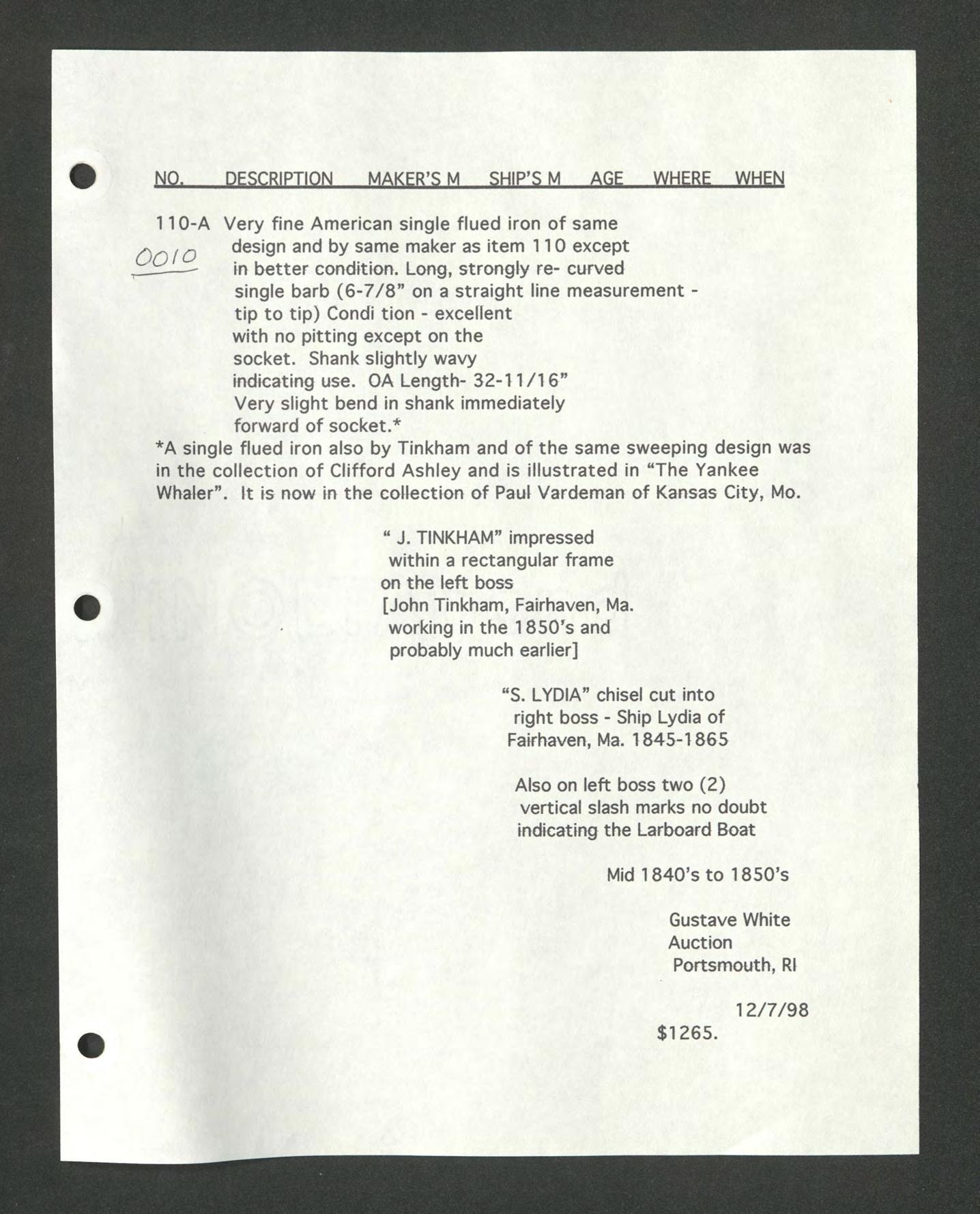
DESCRIPTION
MAKER'S M
110-A Very fine American single flued iron of same 0 design and by same maker as item 110 except —- in better condition. Long, strongly re- curved single barb (6-7/8" on a straight line measurementtip to tip) Condi tion - excellent with no pitting except on the socket. Shank slightly wavy indicating use. OA Length- 32-11/16" Very slight bend in shank immediately forward of socket.*
*A single flued iron also by Tinkham and of the same sweeping design was in the collection of Clifford Ashley and is illustrated in "The Yankee Whaler". It is now in the collection of Paul Vardeman of Kansas City, Mo.
" J. TINKHAM" impressed within a rectangular frame on the left boss [John Tinkham, Fairhaven, Ma. working in the 1850's and probably much earlier]
"S. LYDIA" chisel cut into right boss - Ship Lydia of Fairhaven, Ma. 1845-1865
Also on left boss two (2) vertical slash marks no doubt indicating the Larboard Boat
Mid 1840's to 1850's
Gustave White
Auction Portsmouth, Rl 12/7/98 $1265.
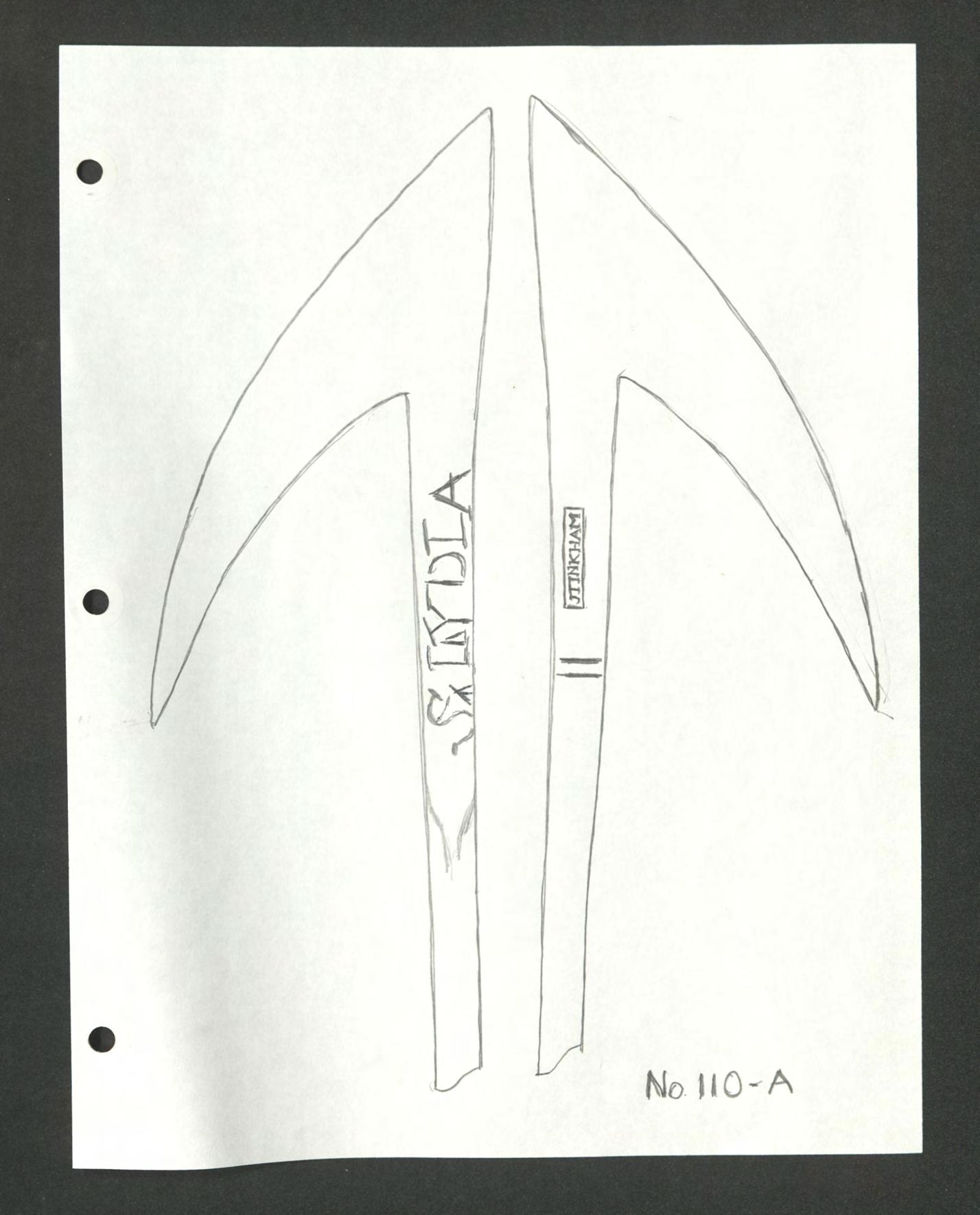

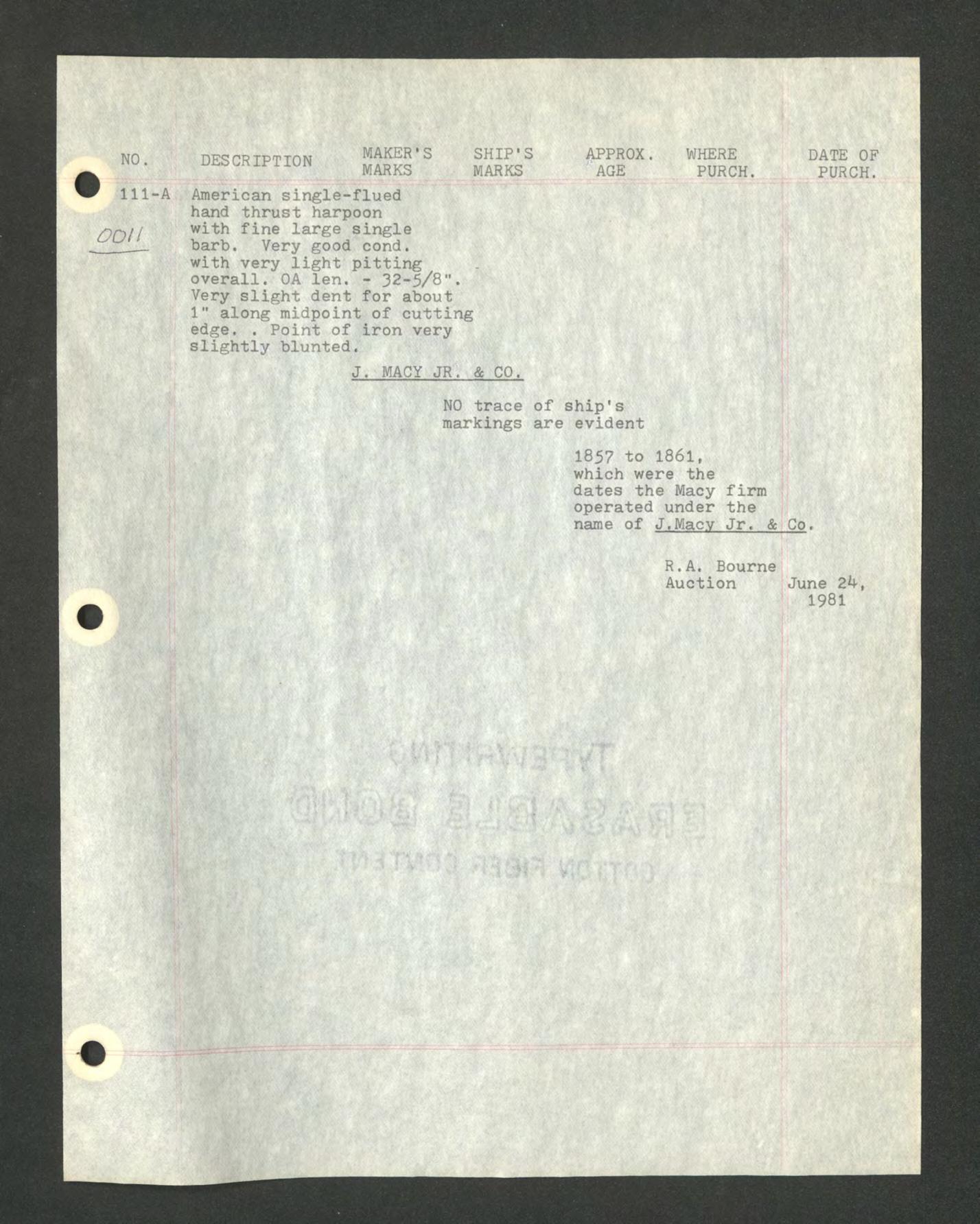
NO DFSPRTPFTON MAKER'S SHIP'S APPROX. WHERE DATE OF DESCRIPTION MARKS MARKS AGE PURCH. PURCH.
111-A American single-flued hand thrust harpoon nr~)il with fine large single barb. Very good cond. with very light pitting overall. OA len. - 32-5/8". Very slight dent for about 1" along midpoint of cutting edge, . Point of iron very slightly blunted.
J. MACY JR. & CO.
NO trace of ship's markings are evident
1857 to 1861, which were the dates the Macy firm operated under the name of J,Macy Jr. & Co.
R.A. Bourne
Auction June 24, 1981
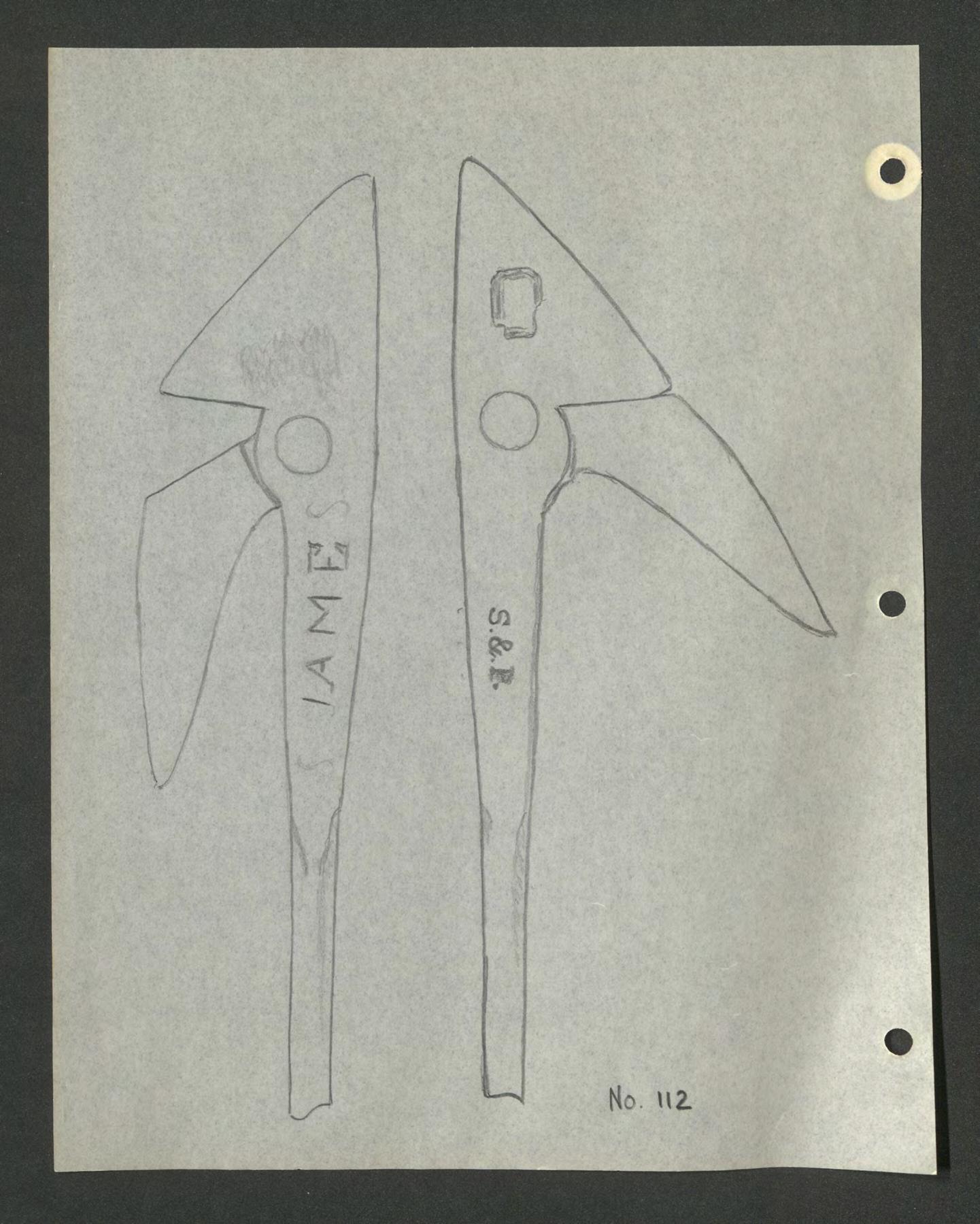
No, DESCRIPTION MARKS
112 Amer. single-flued (NH420g>) iron with moveable rear half of barb. I believe this iron may have been developed by Snow & Purrington, whalecrafters of New Bedford, to compete with the Temple toggle iron, after the latters appearence ca. 1848.
OO/t
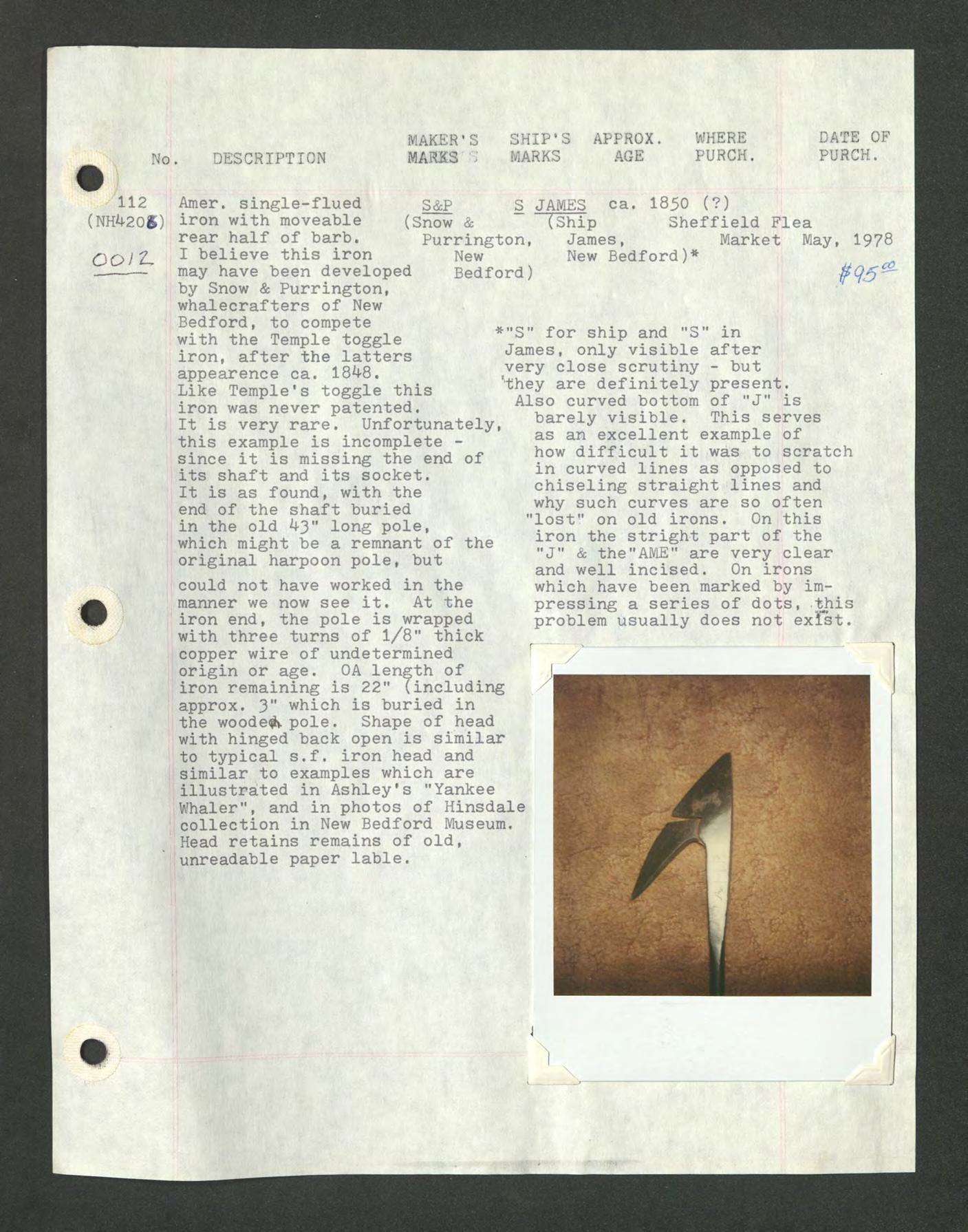
SHIP'S MARKS APPROX. AGE WHERE PURCH. DATE OF PURCH.
S&P S JAMES ca. 1850 (?) (Snow & (Ship Sheffield Flea Purrington, James, Market May, 1978 New New Bedford)* Bedford)
*"S" for ship and "S" in James, only visible after very close scrutiny - but 'they are definitely present. Also curved bottom of "J" is barely visible. This serves as an excellent example of how difficult it was to scratch in curved lines as opposed to chiseling straight lines and why such curves are so often "lost" on old irons. On this iron the stright part of the "J" & the"AME" are very clear and well incised. On irons which have been marked by impressing a series of dots, this problem usually does not exist.
Like Temple's toggle this iron was never patented. It is very rare. Unfortunately, this example is incompletesince it is missing the end of its shaft and its socket. It is as found, with the end of the shaft buried in the old 4-3" long pole, which might be a remnant of the original harpoon pole, but could not have worked in the manner we now see it. At the iron end, the pole is wrapped with three turns of 1/8" thick copper wire of undetermined origin or age. OA length of iron remaining is 22" (including approx. 3" which is buried in the wooded*,pole. Shape of head with hinged back open is similar to typical s.f. iron head and similar to examples which are illustrated in Ashley's "Yankee Whaler", and in photos of Hinsdale collection in New Bedford Museum, Head retains remains of old, unreadable paper lable.
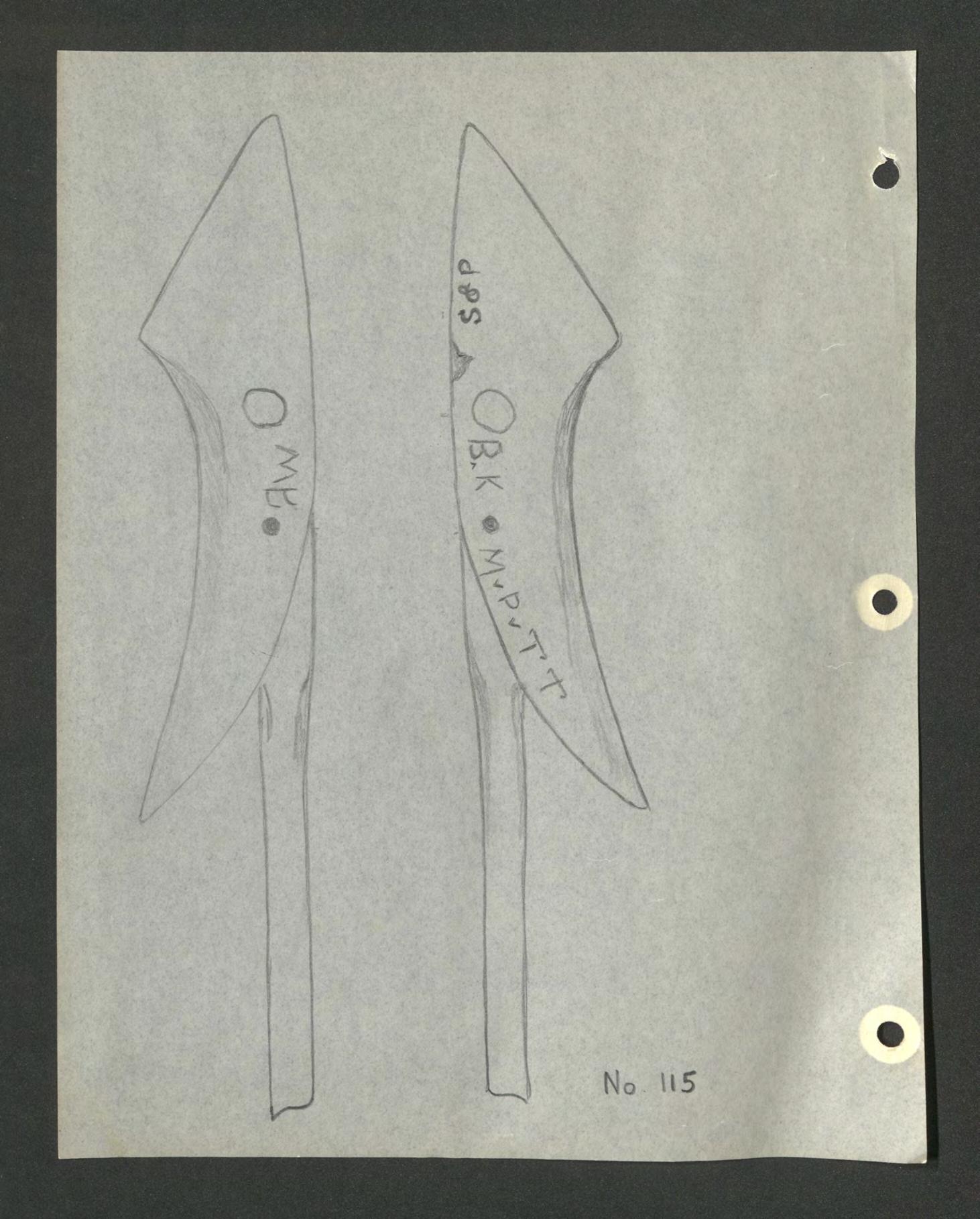
11^ "Modern" toggle (NH 2786) iron. Shaft & socket with black paint which is prob-
• ably not original. Paint on socket is heat blistered (we removed paint from head). OA len.- 32f"
none apparent 19th cent.(1861center punch 1886 are dates marks on head of vessel) appear to read, one side: Q.S. - believed to be for schooner •• quickstep;' Provincetown, Mass. opposite side: = Larboard boat also lettersE.B. (?)
John Newton at Springfield, Mass. Show Feb., 197^
'pvKl'i Ot (Uc-b OK, av\t\ so I J
(possibly initials 6/' 1 " ^\^'AA • of the harpooner)\ ,5Kcw) P^-C M&O M v P
115 "Modern" toggle iron. S&P (Snow chisel marked (NH 3896) Good condition; socket & Purrington, B-K (bark) with nearly all of New Bedford) original serving and —-2 length of old rope (i" dia.) with eye - possibly orig. OA length - 33"
John Veenschoten, Erie, Pa. (from TT a home in Ohio) June, 1977
(MattaPoisett, Westport, Mass.)
on opp. side: MB - I believe WB = waist boat, with "W" upsided in error.
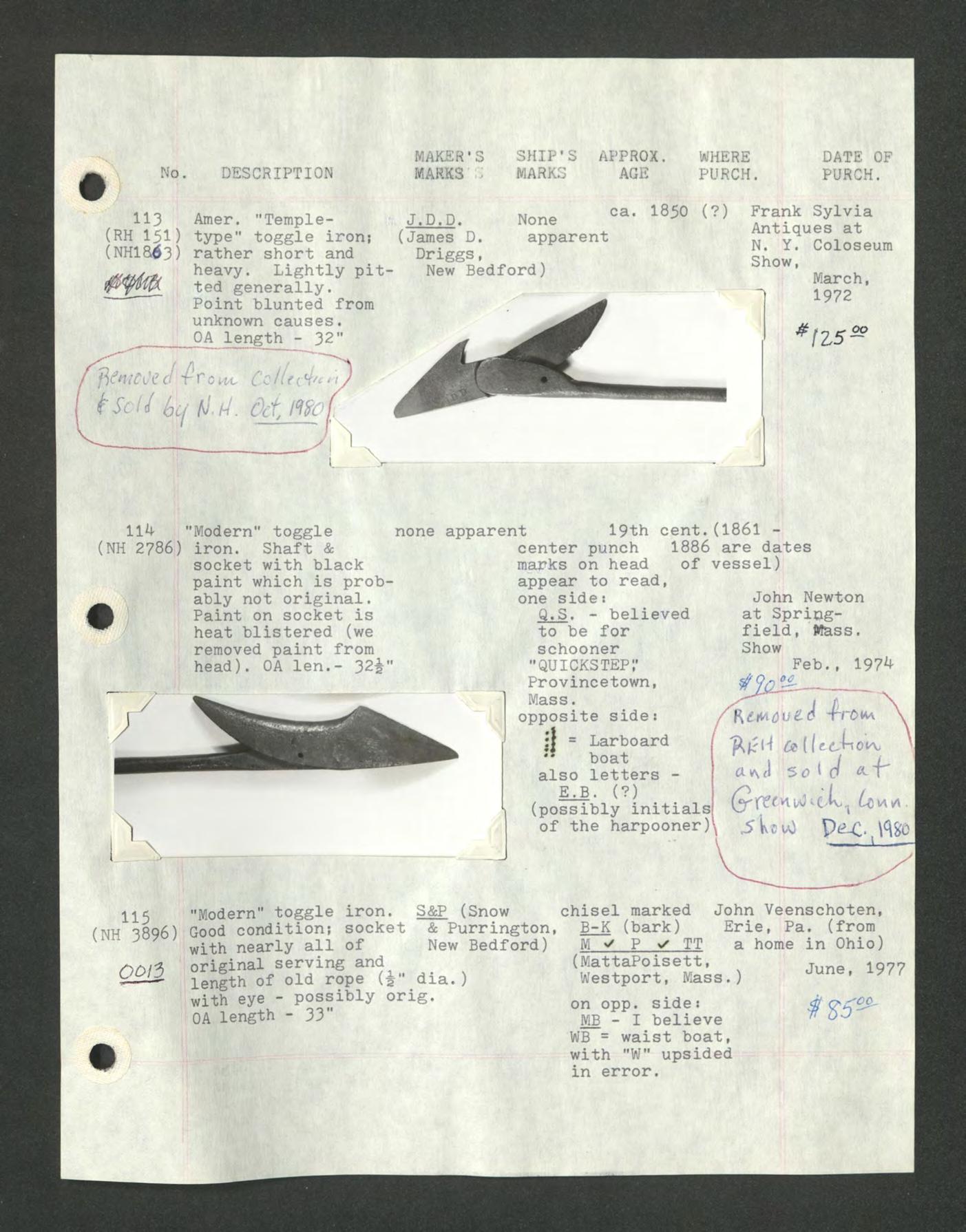
#£5V2D_
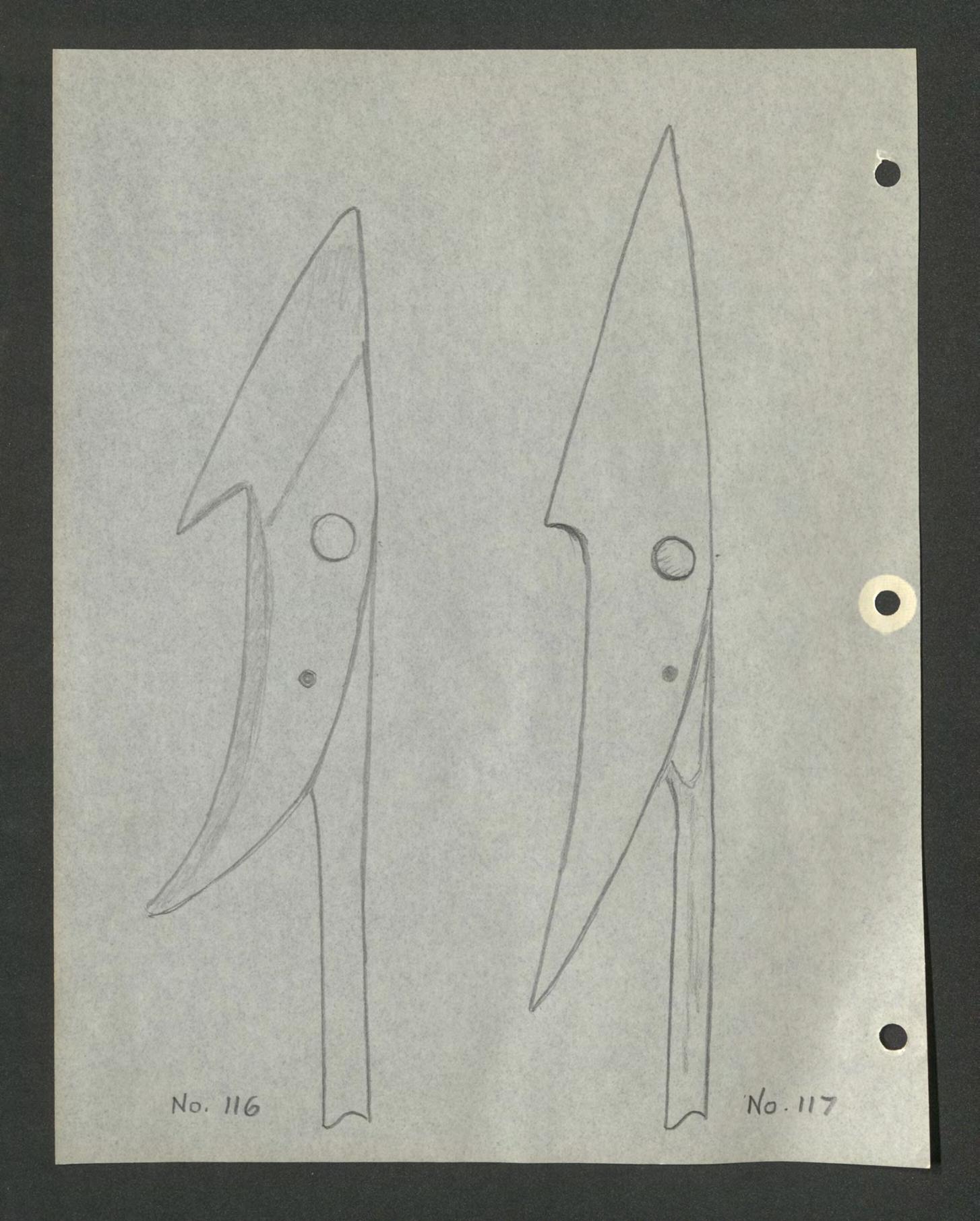
No. DESCRIPTION
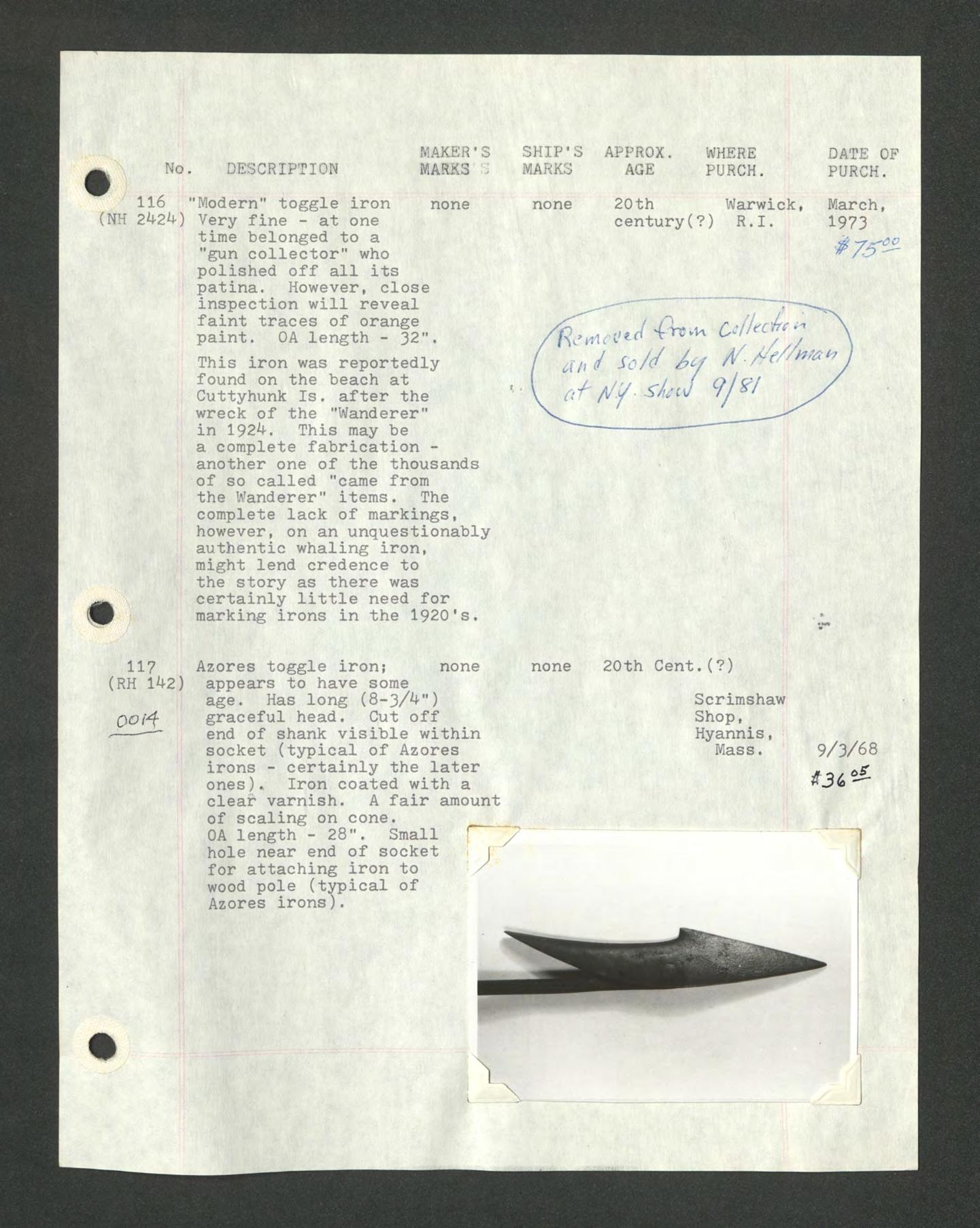
MAKER'S MARKS i,
116 "Modern" toggle iron none (NH 242*0 Very fine - at one time belonged to a "gun collector" who polished off all its patina. However, close inspection will reveal faint traces of orange paint. OA length - 32".
This iron was reportedly found on the beach at Cuttyhunk Is. after the wreck of the "Wanderer" in 1924. This may be a complete fabricationanother one of the thousands of so called "came from the Wanderer" items. The complete lack of markings, however, on an unquestionably authentic whaling iron, might lend credence to the story as there was certainly little need for marking irons in the 1920*s.
SHIP'S APPROX. WHERE MARKS AGE PURCH.
none 20th Warwick, century(?) R.I.
DATE OF PURCH. March, 1973
117 (RH 142)
QOrf
Azores toggle iron; none appears to have some age. Has long (8-3/4") graceful head. Cut off end of shank visible within socket (typical of Azores irons - certainly the later ones). Iron coated with a clear varnish. A fair amount of scaling on cone. OA length - 28". Small hole near end of socket j for attaching iron to wood pole (typical of Azores irons).
none 20th Cent.(?)
Scrimshaw Shop, Hyannis, Mass. 9/3/68
t3i^
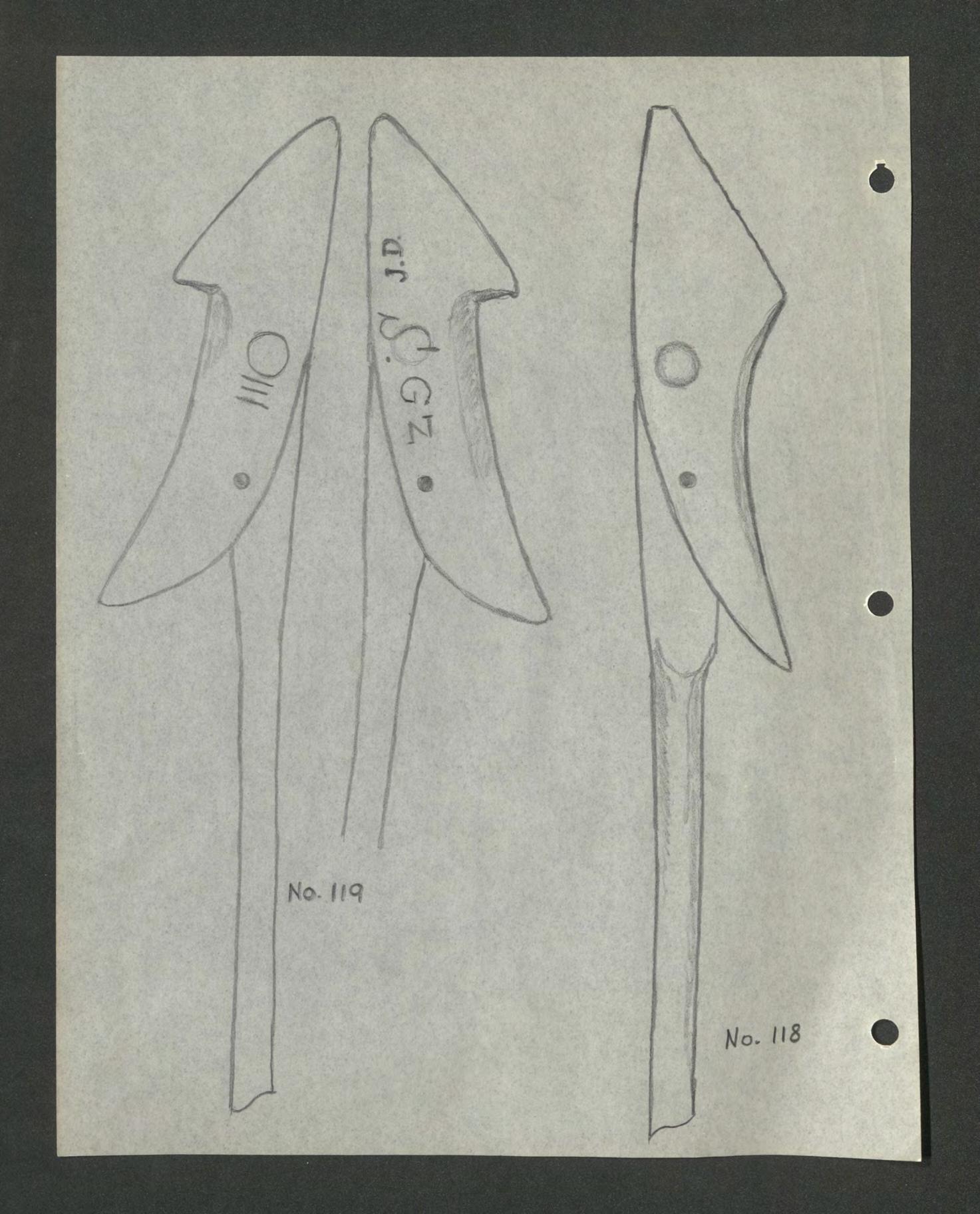
No, DESCRIPTION
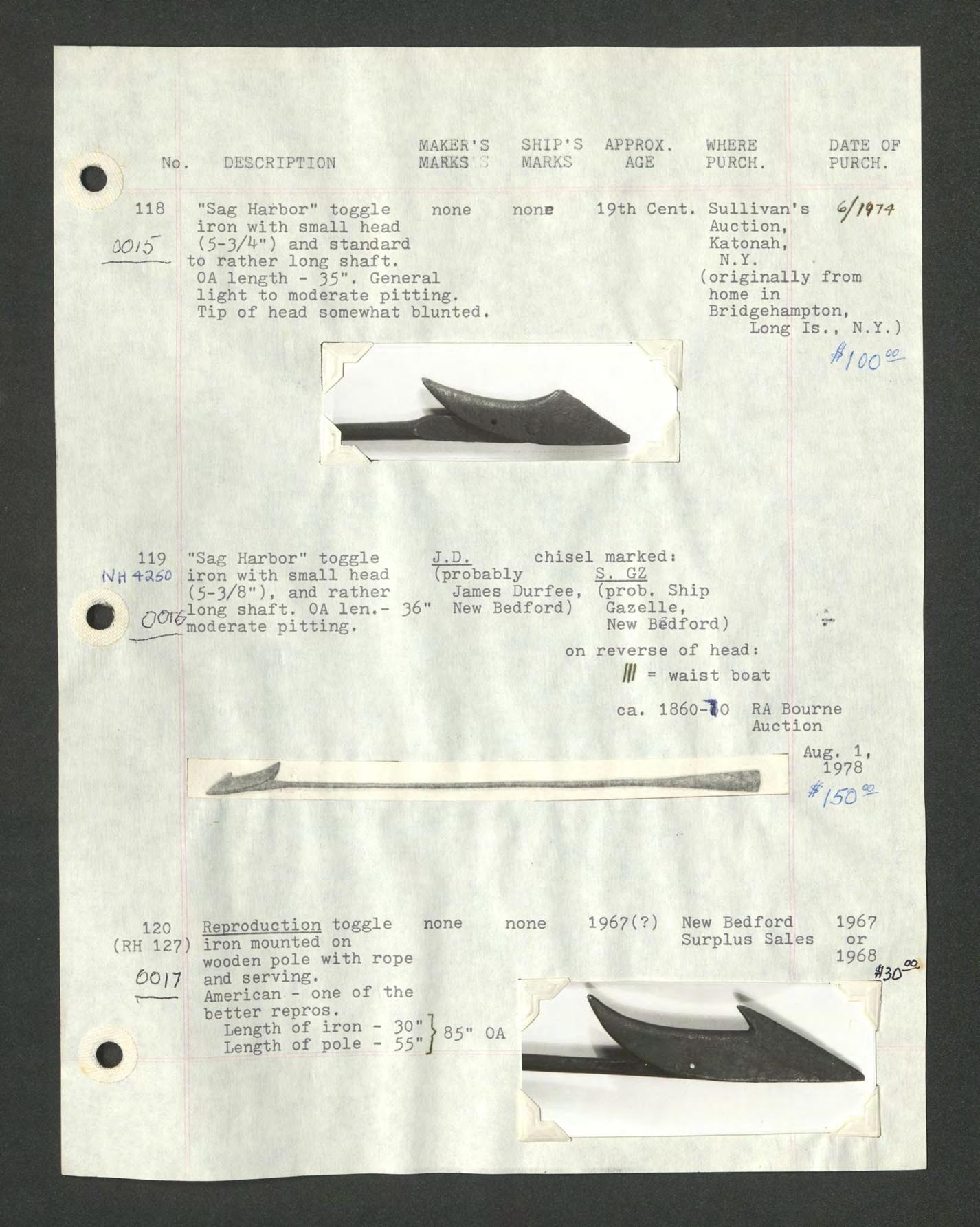
MAKER'S MARKS 'I
118 "Sag Harbor" toggle none iron with small head SOJif (5~3/^") and standard to rather long shaft. OA length - 35"« General light to moderate pitting. Tip of head somewhat blunted.
SHIP'S APPROX. WHERE MARKS AGE PURCH,
DATE OF PURCH.
none 19th Cent. Sullivan's Auction, Katonah, N.Y. (originally from home in Bridgehampton, Long Is., N.Y.)
119 "Sag Harbor" toggle iron with small head (5-3/8")» and rather 0<5Rcl°ng shaft. OA len.^ ^moderate pitting.
J.D. chisel markeds (probably S. GZ James Durfee, (prob. Ship 36" New Bedford) Gazelle, New Bedford) on reverse of heads III = waist boat
ca. 1860~|0 RA Bourne Auction
Aug. 1, 1978
120 (RH 127)
£0/7
Reproduction toggle none iron mounted on wooden pole with rope and serving.
American - one of the better repros.
Length of iron - 30"I oV.
Length of pole - 55"/
none
1967(?) New Bedford Surplus Sales
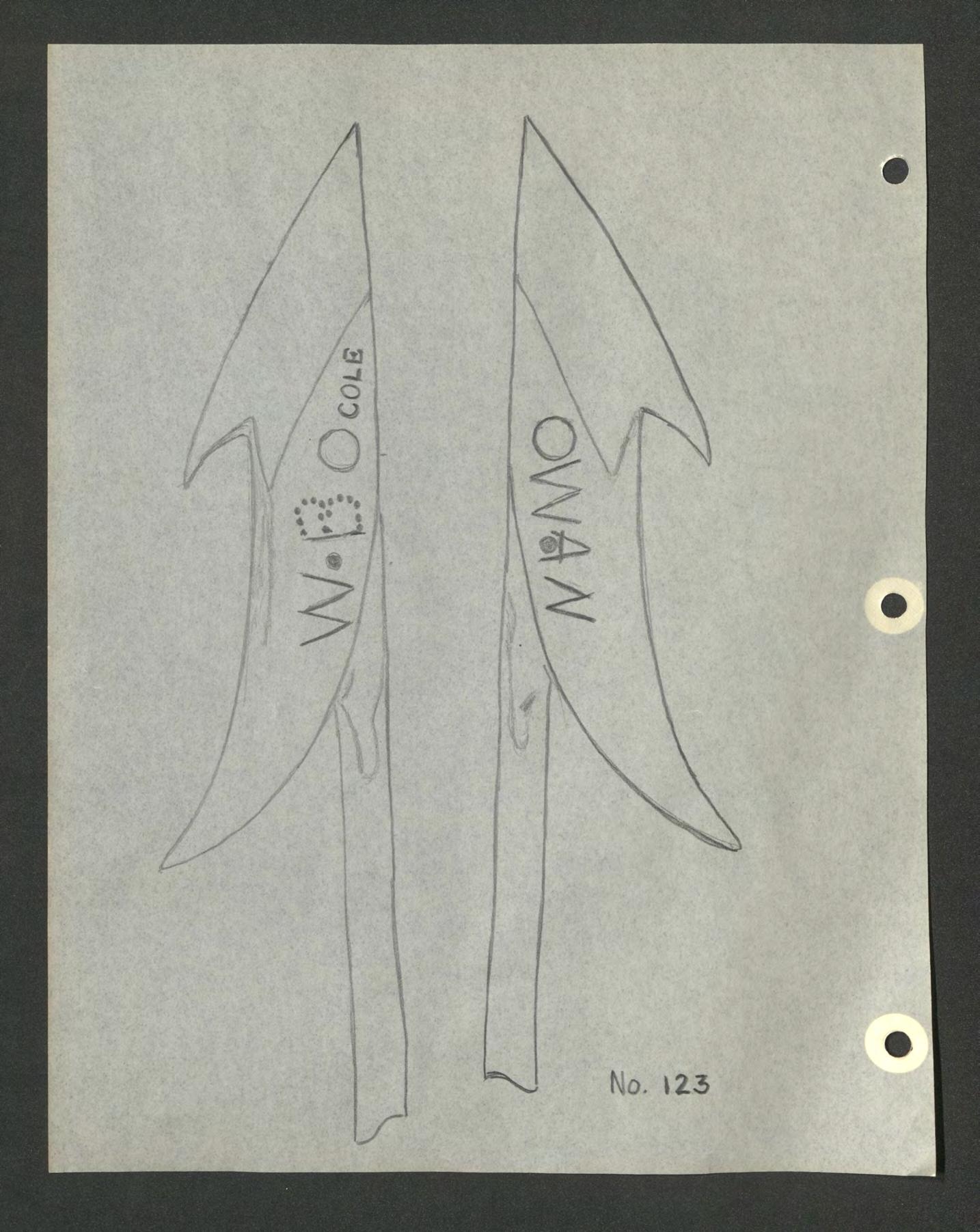
No. DESCRIPTION
121 Amer. darting gun (NH toggle iron. Nice 2916) condition. Blackened (paint?)
OA length - 38"
Seff. 1979
MAKER'S SHIP'S APPROX. WHERE DATE OF MARKS : MARKS AGE PURCH. PURCH.
COLE (very faint) Edward R. Cole, Fairhaven, Mass. E. Cole was the grandson of William Carsley. He was one of the last of the whalecrafters. center early 20th cent.(?) punched ship's marks: B. ??? Hartsdale Flea Market - bought / —7 , from Todd Oberdorf (not readable) ( i on reverse side T3«+4.„ center- from Betty center Long)
June, of head, puncheds S B = starboard boat 197^
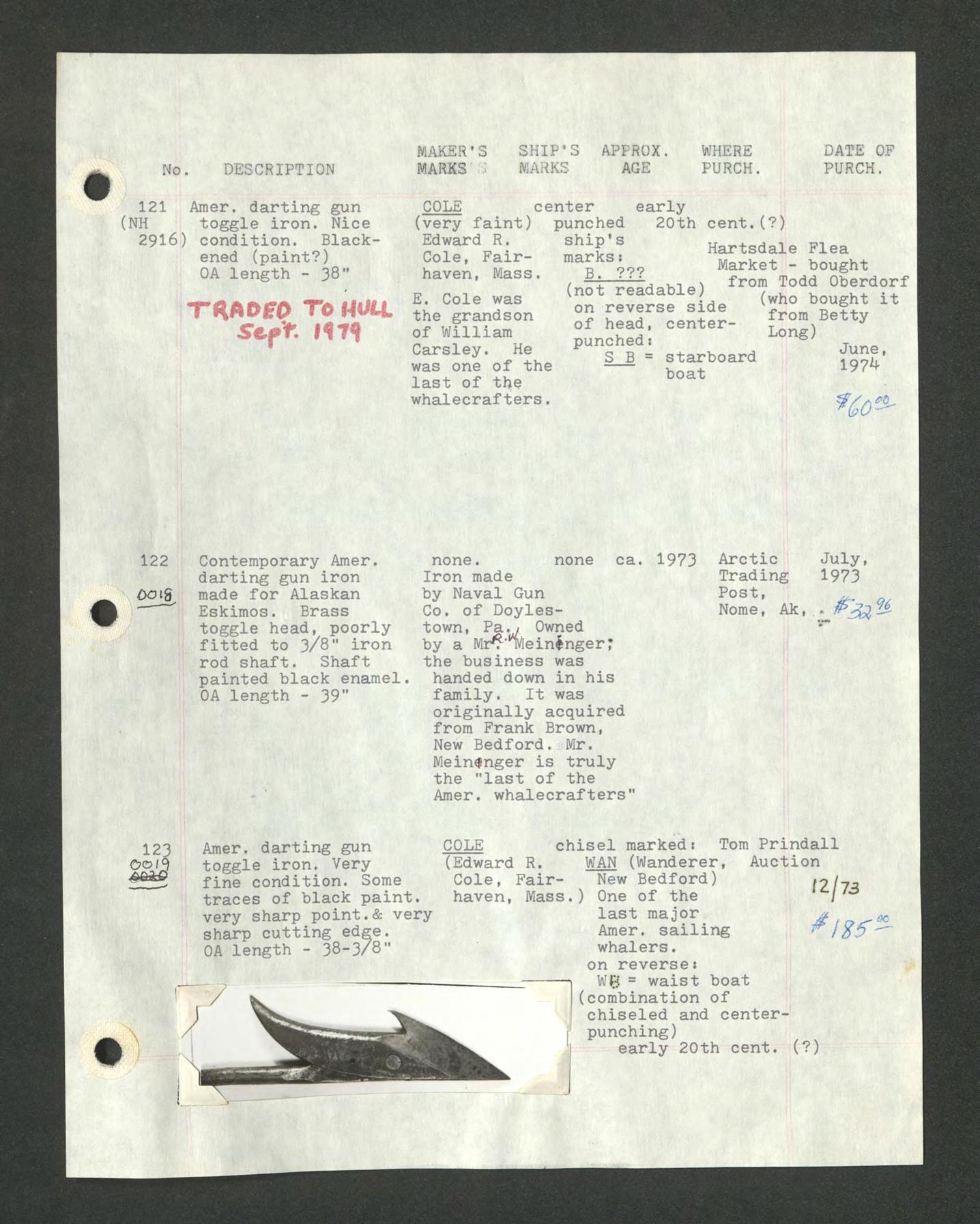
122 Contemporary Amer. darting gun iron
Doig made for Alaskan Eskimos. Brass toggle head, poorly fitted to 3/8" iron rod shaft. Shaft painted black enamel. OA length - 39"
none. Iron made by Naval Gun Co. of Doylestown, Pa./ Owned by a Mr^'Mein&nger* the business was handed down in his family. It was originally acquired from Frank Brown, New Bedford. Mr. Mein^nger is truly the "last of the Amer. whalecrafters
none ca. 1973 Arctic Trading Post, Nome, Ak, July, 1973 - ^3%
123 Amer. darting gun toggle iron. Very &&&% fine condition. Some traces of black paint, very sharp point.& very sharp cutting edge. OA length - 38-3/8"
COLE chisel marked? Tom Prindall (Edward R. Cole, Fairhaven, Mass, WAN (Wanderer, Auction New Bedford) ) One of the last major a Amer. sailing whalers. on reverse: W$= waist boat (combination of chiseled and centerpunching) early 20th cent. (?) 12/73 GC
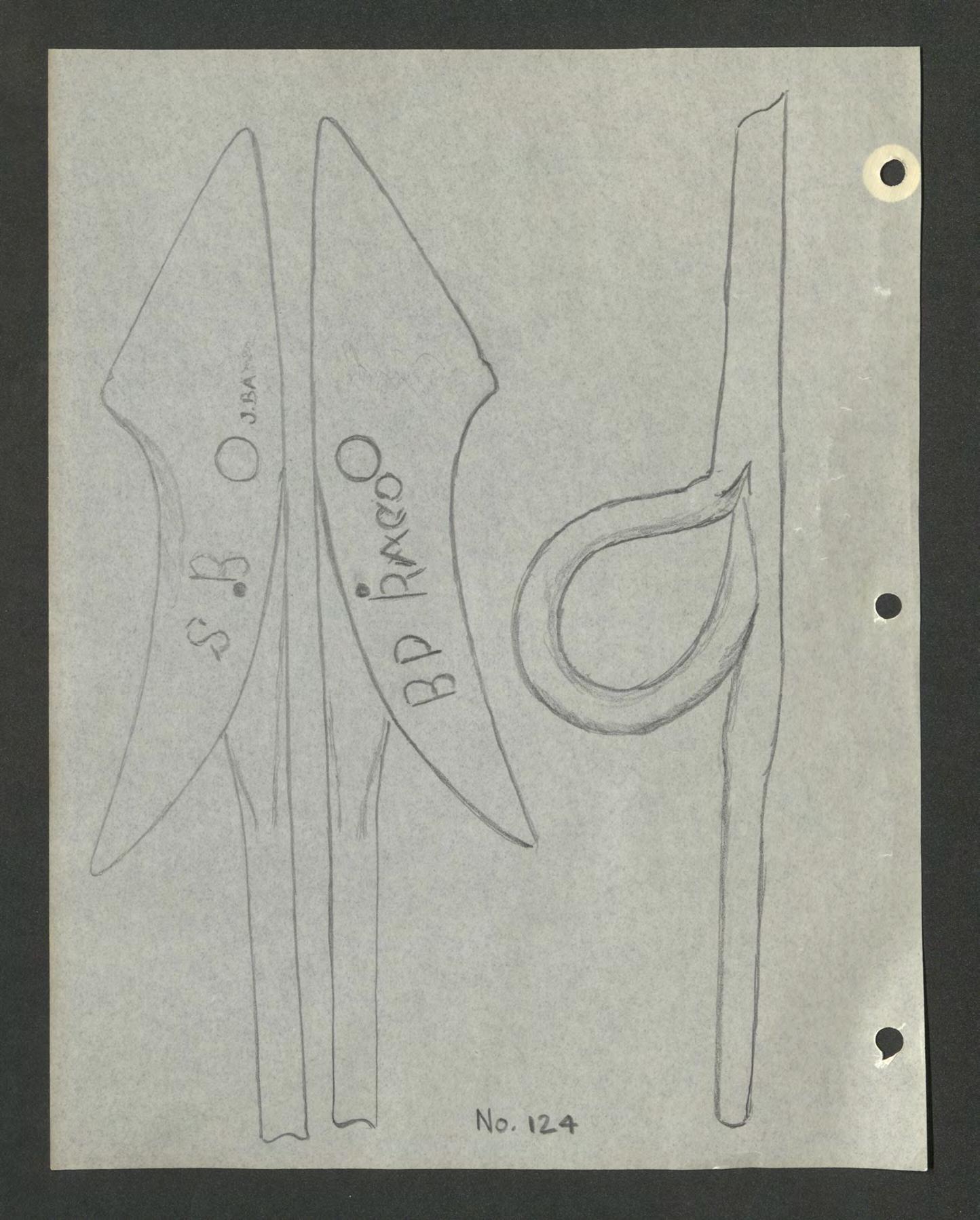
No,
124 (NH3829)
DESCRIPTION X
Rather short Amer. darting gun toggle iron with unusual looking (narrows
MAKER'S MARK'S ;
J. BA—
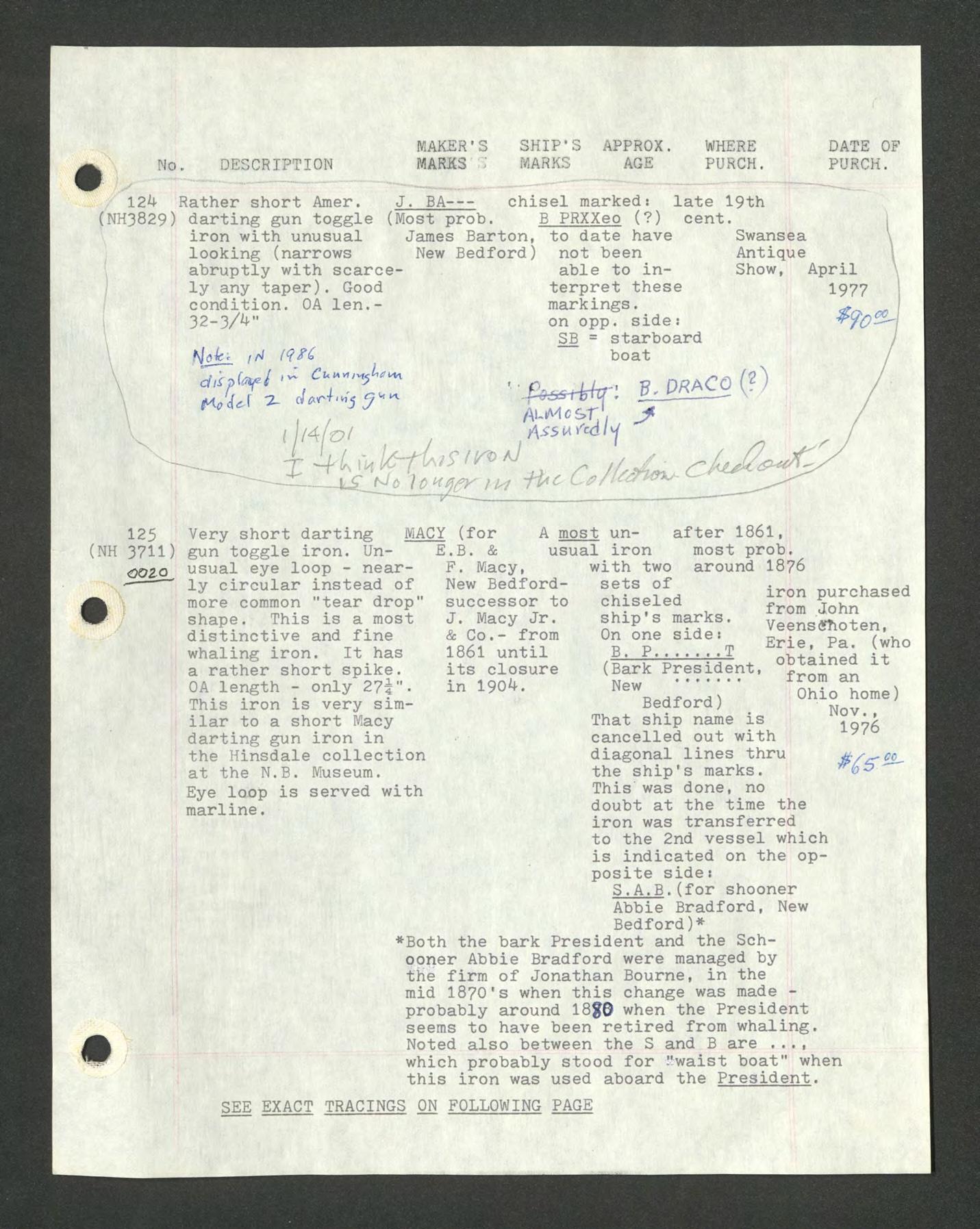
SHIP'S MARKS APPROX. AGE
chisel markeds B PRXXeo (?)
(Most prob. James Barton, New Bedford) abruptly with scarcely any taper). Good condition. OA len.32-3/4"
WHERE PURCH. late 19th cent.
DATE OF PURCH.
to date have not been able to interpret these markings. on opp. sides SB = starboard boat Swansea Antique Show, April 1977
125 (NH 3711 oozo
Very short darting )gun toggle iron. Unusual eye loop - nearly circular instead of more common "tear drop" shape. This is a most distinctive and fine whaling iron. It has a rather short spike. OA length - only 27|". This iron is very similar to a short Macy darting gun iron in the Hinsdale collection at the N.B. Museum. Eye loop is served with marline.
MACY (for E.B. & F. Macy, New Bedfordsuccessor to J. Macy Jr. & Co.- from 1861 until its closure in 1904.
A most un- after 1861, usual iron most prob. with two around 1876 sets of chiseled ship's marks. On one side: B. P .T iron purchased from John Veensghoten, Erie, Pa. (who obtained it from an Ohio home) Nov., 1976 (Bark President, New Bedford) That ship name is cancelled out with diagonal lines thru the ship's marks. This was done, no doubt at the time the iron was transferred to the 2nd vessel which is indicated on the opposite sides
S.A.B.(for shooner Abbie Bradford, New Bedford)*
*Both the bark President and the Schooner Abbie Bradford were managed by the firm of Jonathan Bourne, in the mid 1870's when this change was madeprobably around 18§0 when the President seems to have been retired from whaling. Noted also between the S and B are .... which probably stood for "waist boat" when this iron was used aboard the President.
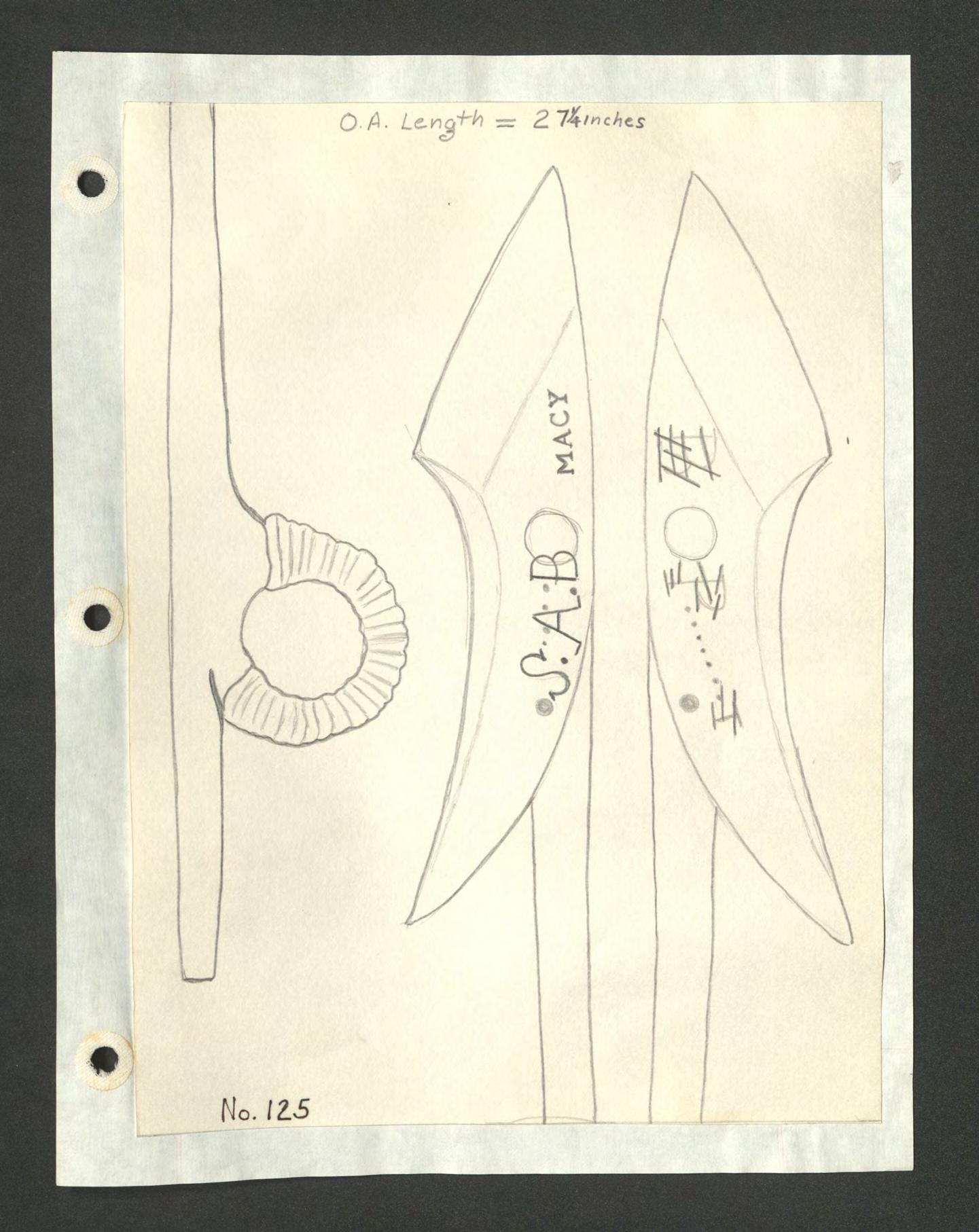
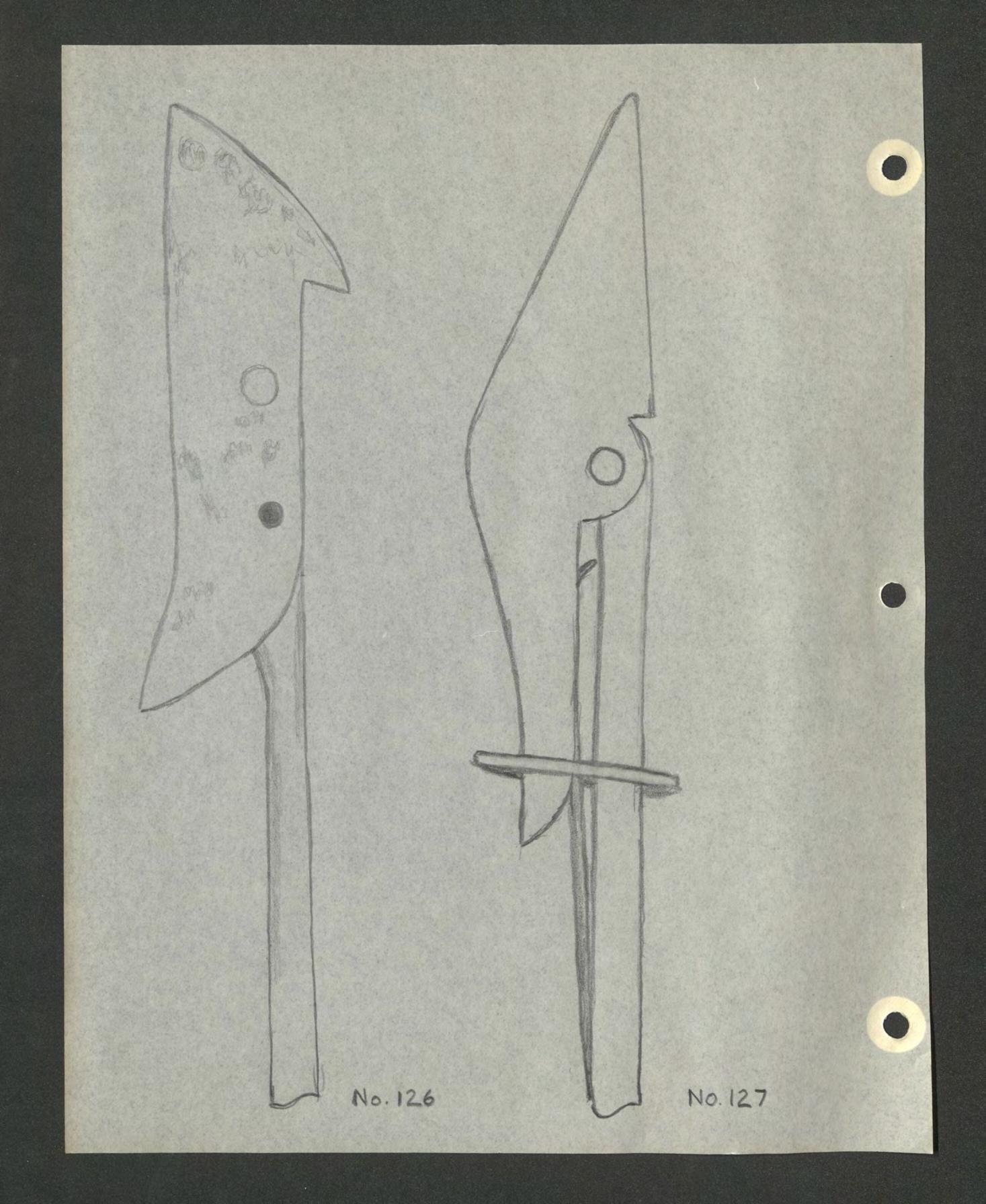
No. 126 (RH 160)
OO'L \ DESCRIPTION
MAKER*S
MARKS ;;
A most unusual toggle None iron - almost certainly not Amer. Head smooth on top with barb below. Socket closed as in English irons. Configuration of head reminds me of some early, non-toggling Japanese harpoons. Large hole in head and shaft (3/16" dia.)for wooden holding pin. Moderate amounts of pitting. OA len.- 29i"
SHIP'S APPROX. WHERE MARKS AGE PURCH. DATE OF PURCH.
None 19th Cent. Frank Sylvia Antiques at N.Y. Coloseum Show, March, 1972 #/oOc>0
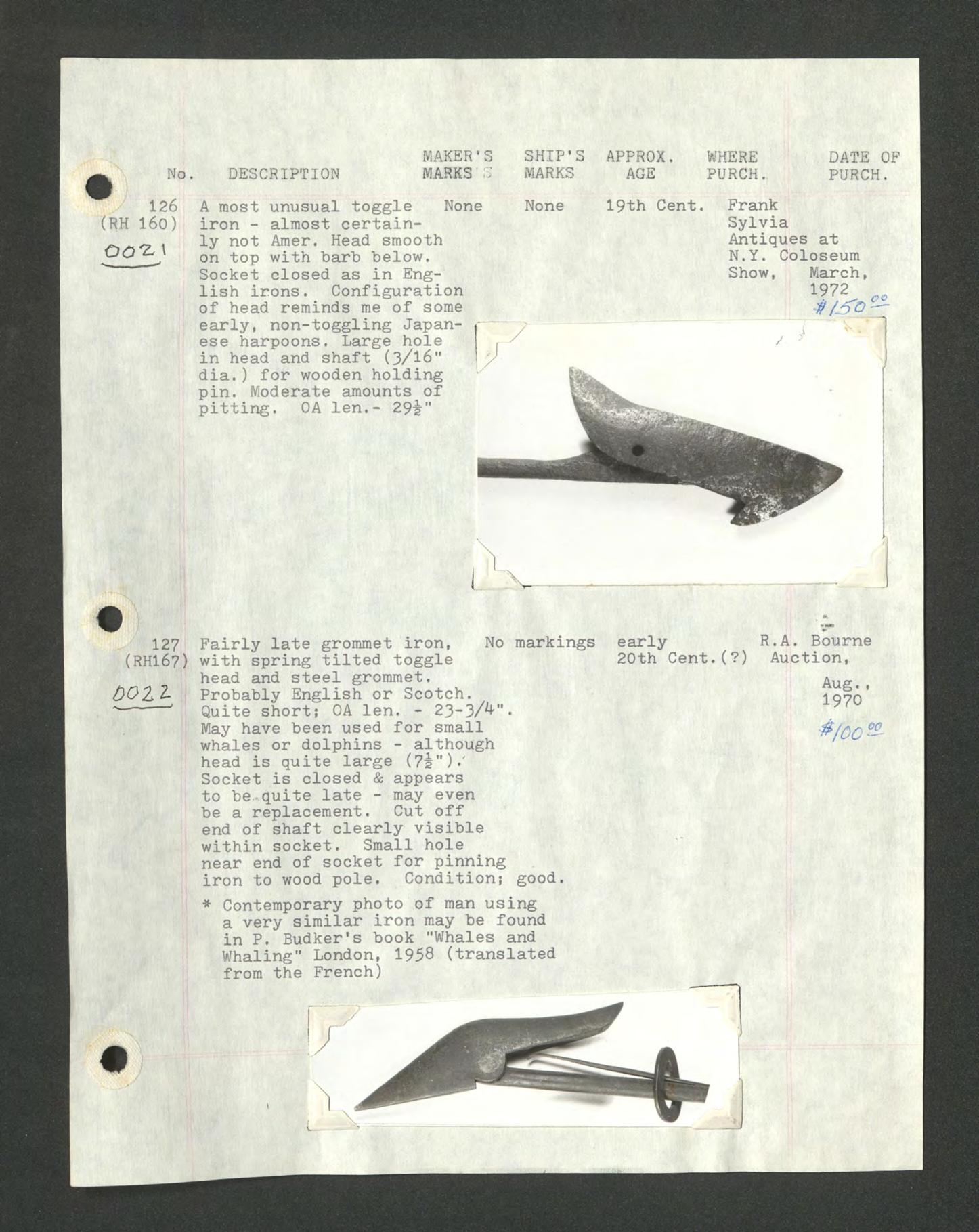
127 Fairly late grommet iron, (RH167) with spring tilted toggle head and steel grommet. &OZ2- Probably English or Scotch. ' Quite short; OA len. - 23-3/^"• May have been used for small whales or dolphins - although head is quite large (7i").' Socket is closed & appears to be quite late - may even be a replacement. Cut off end of shaft clearly visible within socket. Small hole near end of socket for pinning iron to wood pole. Condition; good.
No markings early R.A. Bourne 20th Cent.(?) Auction, Aug., 1970 fifGQ 00
* Contemporary photo of man using a very similar iron may be found in P. Budker's book "Whales and Whaling" London, 1958(translated from the French)
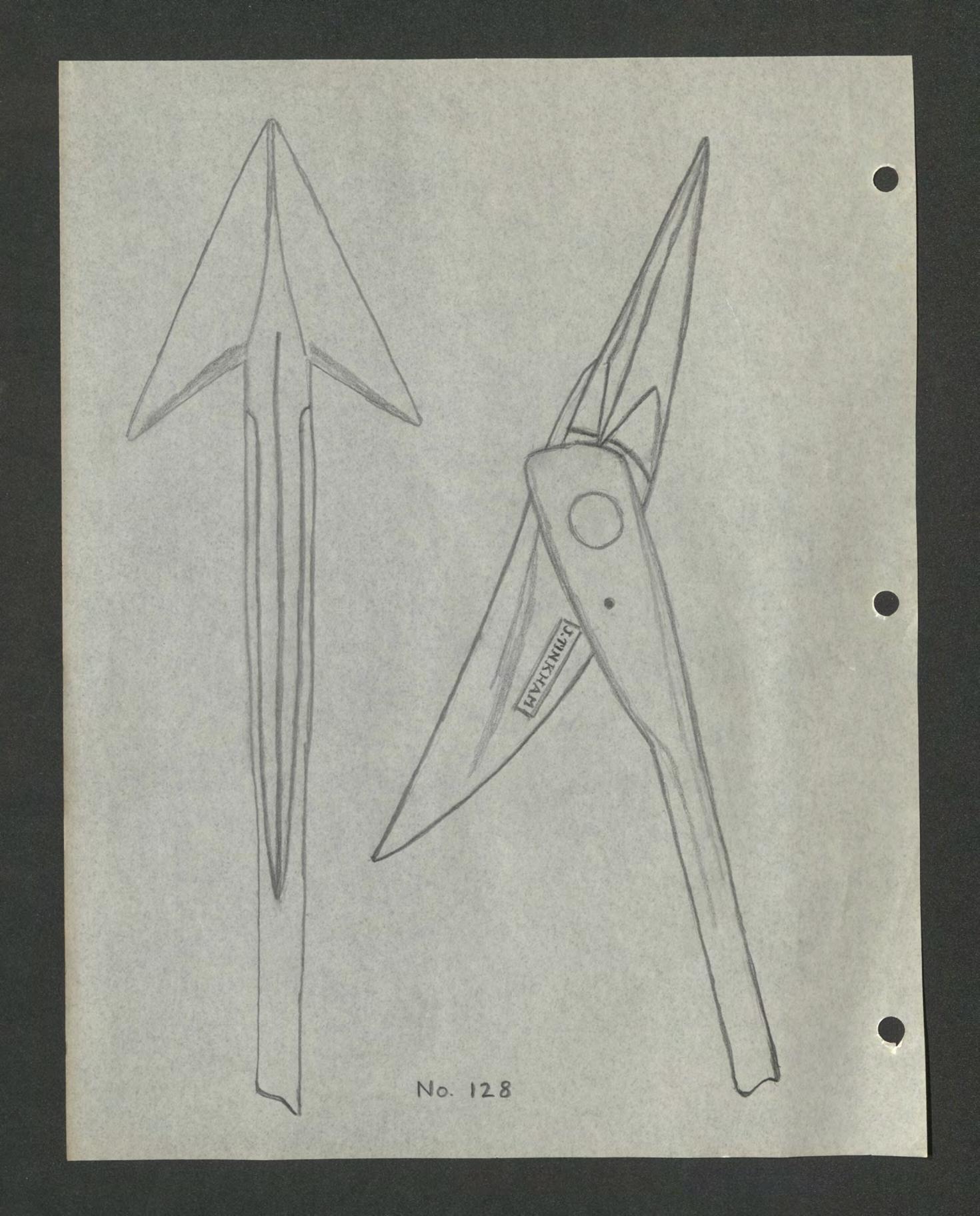
DESCRIPTION
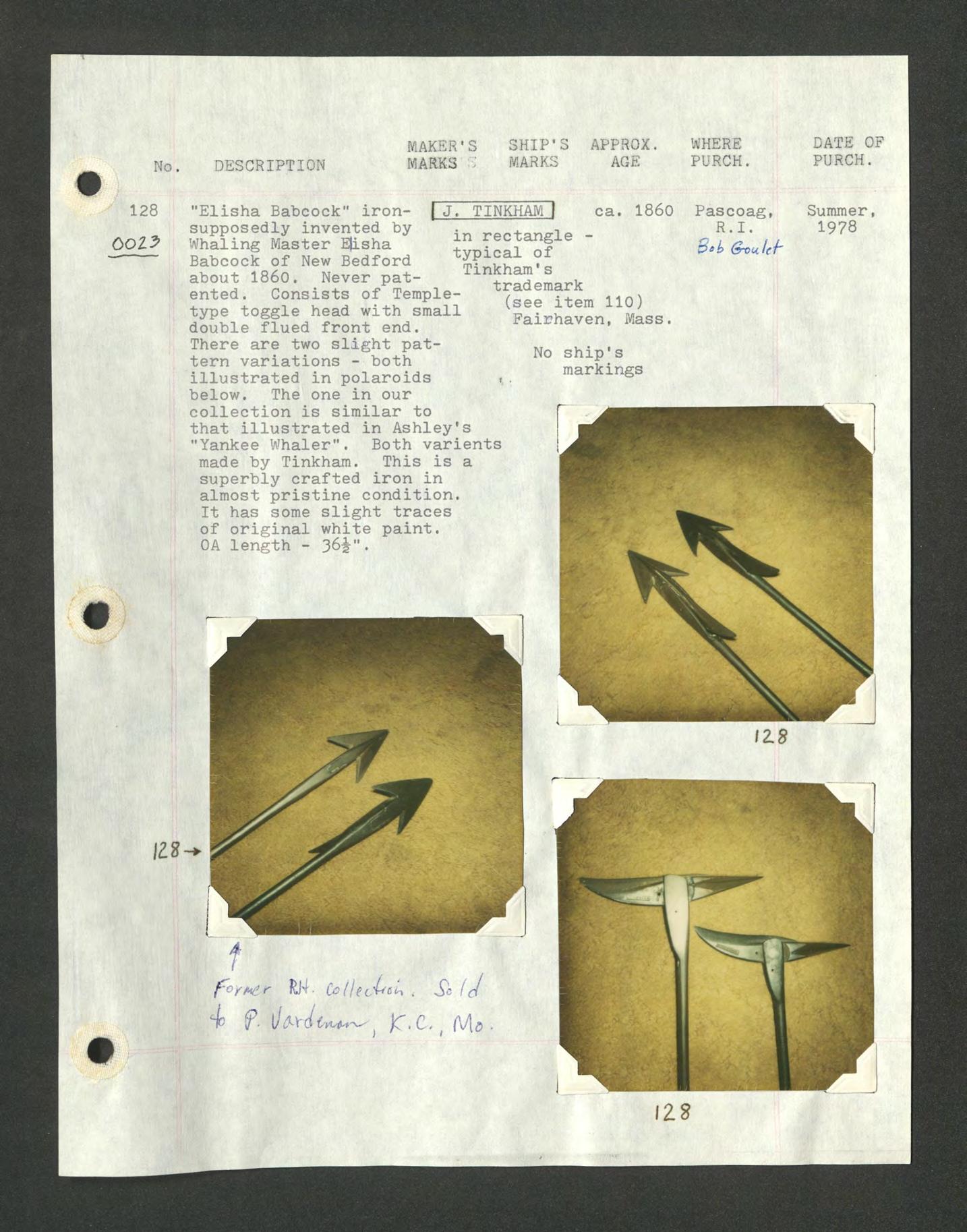
MAKER'S MARKS '
128 "Elisha Babcock" ironsupposedly invented by 0O13 Whaling Master Ejisha ~ Babcock of New Bedford about I860. Never patented. Consists of Templetype toggle head with small double flued front end. There are two slight pattern variations - both illustrated in polaroids » below. The one in our collection is similar to that illustrated in Ashley's "Yankee Whaler". Both varients made by Tinkham. This is superbly crafted iron in almost pristine condition. It has some slight traces of original white paint. OA length - 361?"•
SHIP'S MARKS APPROX. AGE WHERE PURCH.
I J. TINKHAM 1 ca. I860 in rectangletypical of Tinkham's trademark (see item 110) Fairhaven, Mass. No ship's markings Pascoag, R.I.
DATE OF PURCH.
Summer, 1978
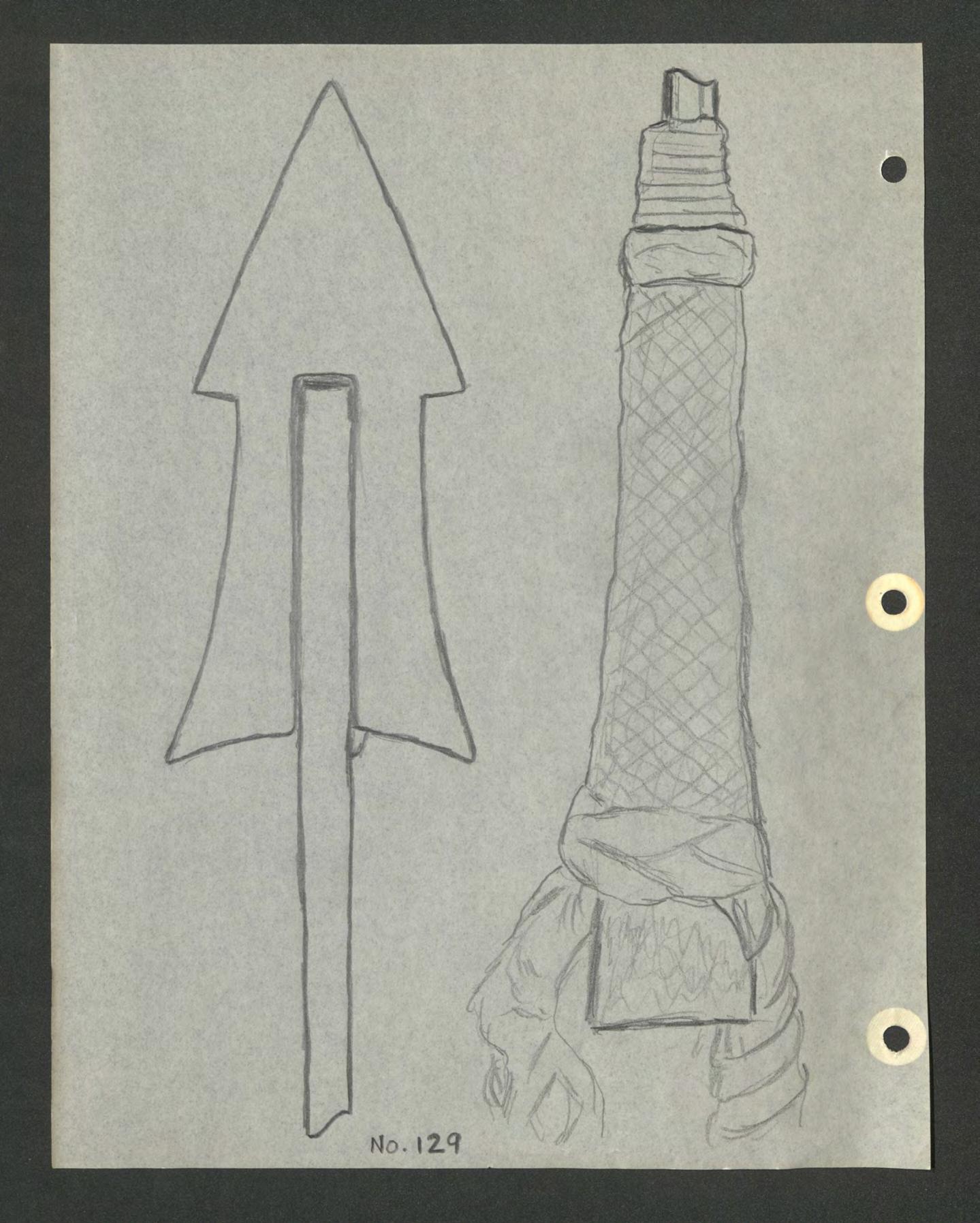
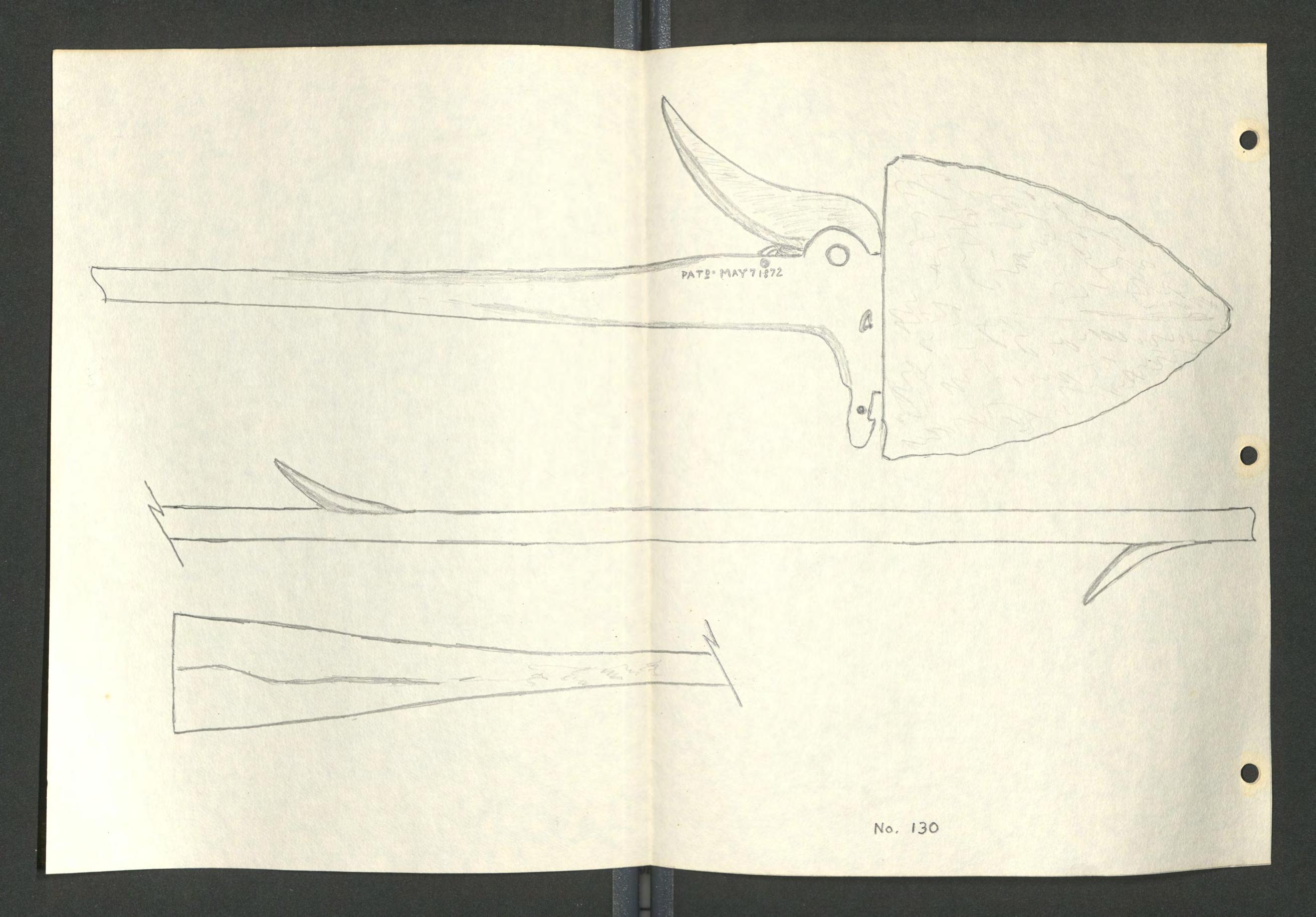
No. DESCRIPTION
129 oo 24
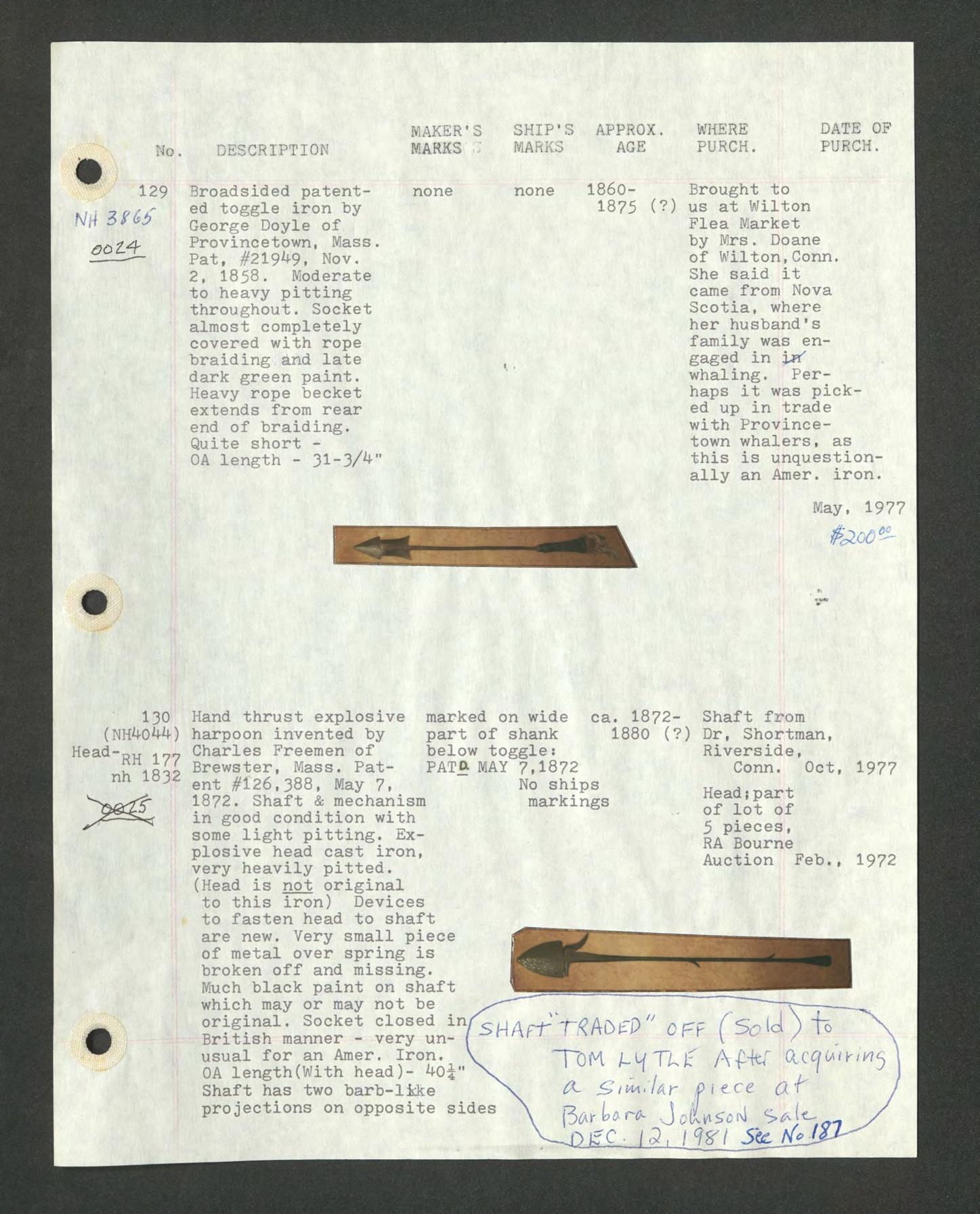
Broadsided patented toggle iron byGeorge Doyle of Provincetown, Mass. Pat, #219^9, Nov. 2, 1858. Moderate to heavy pitting throughout. Socket almost completely covered with rope braiding Ind late dark green paint. Heavy rope becket extends from rear end of braiding. Quite shortOA length - 31-3/4"
MAKER' MARKS SHIP'S MARKS APPROX. AGE WHERE PURCH.
DATE OF PURCH.
none none 18601875 (?) Brought to us at Wilton Flea Market by Mrs. Doane of Wilton,Conn. She said it came from Nova Scotia, where her husband's family was engaged in inr' whaling. Perhaps it was picked up in trade with Provincetown whalers, as this is unquestionally an Amer. iron.
May, 1977
130 Hand thrust explosive (NH4044) harpoon invented by
Head-RH 177 Charles Freemen of j;'.Q„ Brewster, Mass. Patnh ent ^126,388, May 7, 1872. Shaft & mechanism in good condition with some light pitting. Explosive head cast iron, very heavily pitted. (Head is not original to this iron) Devices to fasten head to shaft are new. Very small piece of metal over spring is broken off and missing. Much black paint on shaft which may or may not be
marked on wide part of shank below toggle: PATD- MAY 7,1872
No ships
tca. 18721880 (?) markings Shaft from Dr, Shortman, Riverside, Conn. Oct, 1977 Head;part of lot of 5 pieces, RA Bourne Auction Feb., I972
original. Socket closed iry^ OFF (So British manner - very un- ( ' V TOM I~4TL/ AT very usual for an Amer. Iron. OA length(With head)- 4o|" Shaft has two barb-like projections on opposite sides (K gim.'Ur piece Q A (T\>* J ci\i >A]cIfC • f <3, 1jjr7
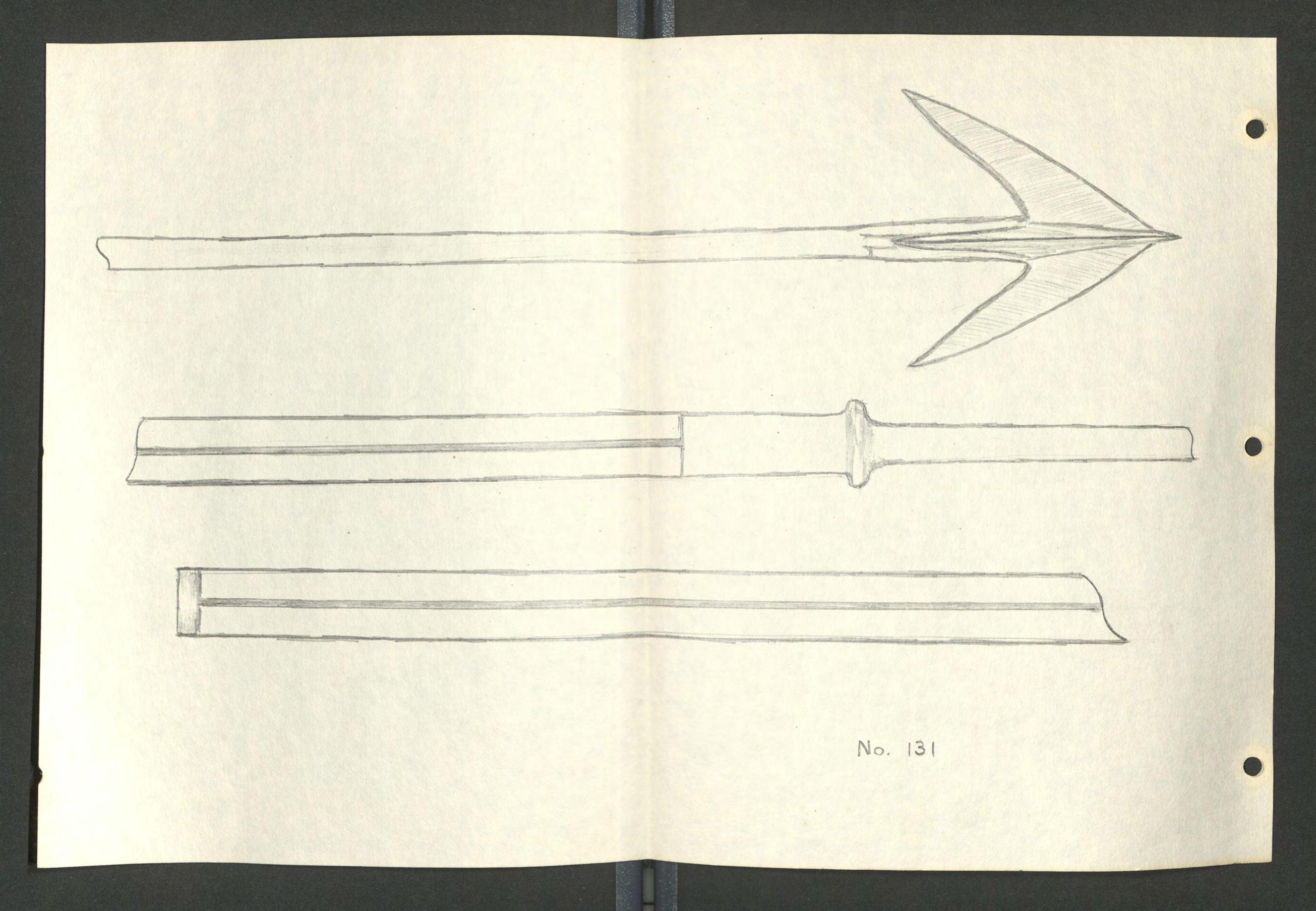
No. DESCRIPTION
ooai"
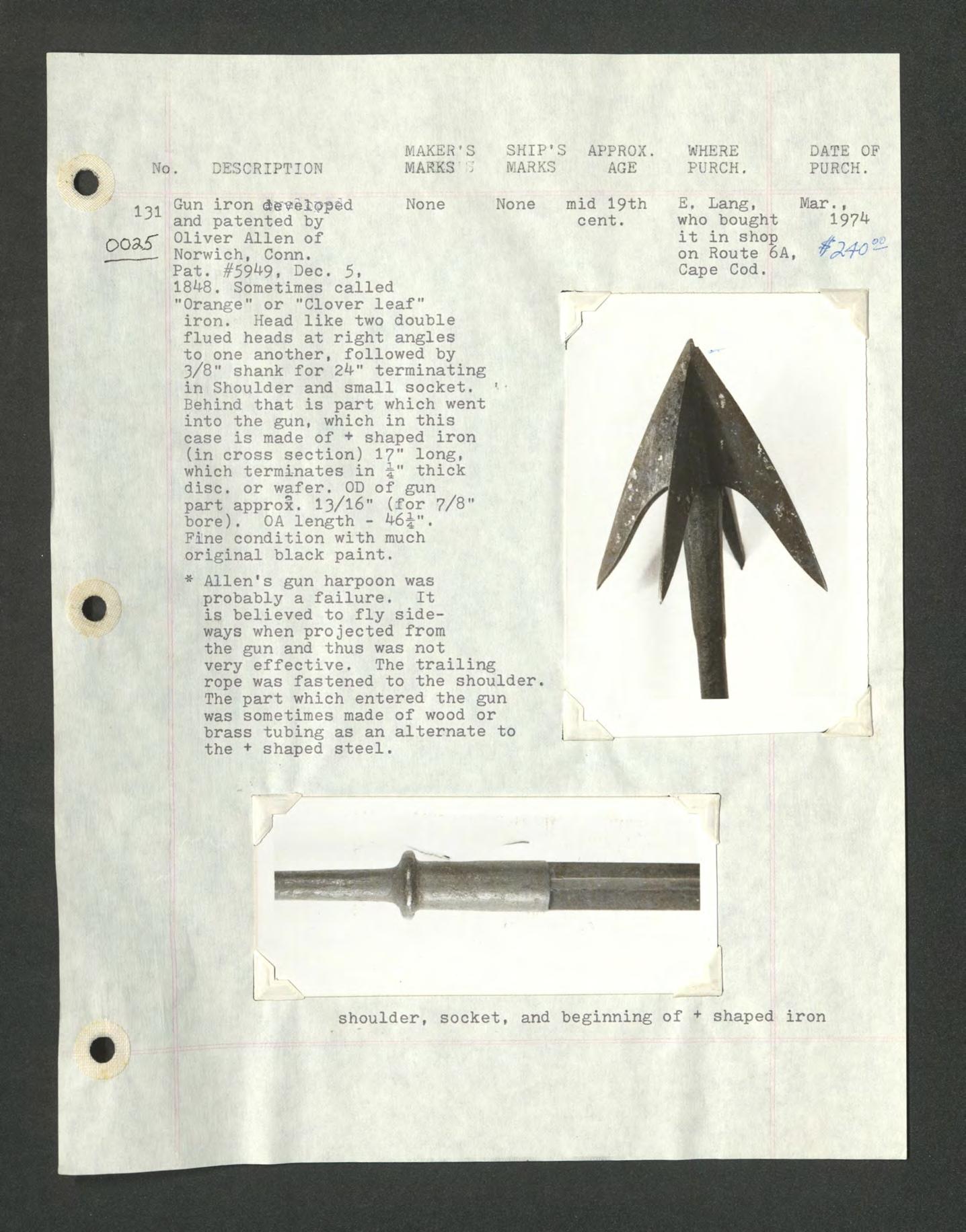
MAKER*S MARKS 'I
Gun iron de^elopsd None None and patented by Oliver Allen of Norwich, Conn. Pat. #5949, Dec. 5, 1848. Sometimes called — "Orange" or "Clover leaf" iron. Head like two double flued heads at right angles { to one another, followed by 3/8" shank for 24" terminating in Shoulder and small socket. '• Behind that is part which went into the gun, which in this case is made of + shaped iron (in cross section) 17" long, which terminates in i" thick disc, or wafer. OD of gun part approx. 13/16" (for 7/8" bore). OA length - 46^". Fine condition with much original black paint.
* Allen's gun harpoon was probably a failure. It is believed to fly sideways when projected from the gun and thus was not very effective. The trailing rope was fastened to the shoulder. The part which entered the gun was sometimes made of wood or brass tubing as an alternate to j the + shaped steel.
mid 19th cent. E. Lang, who bought it in shop on Route 6A, Cape Cod. Mar., 1974
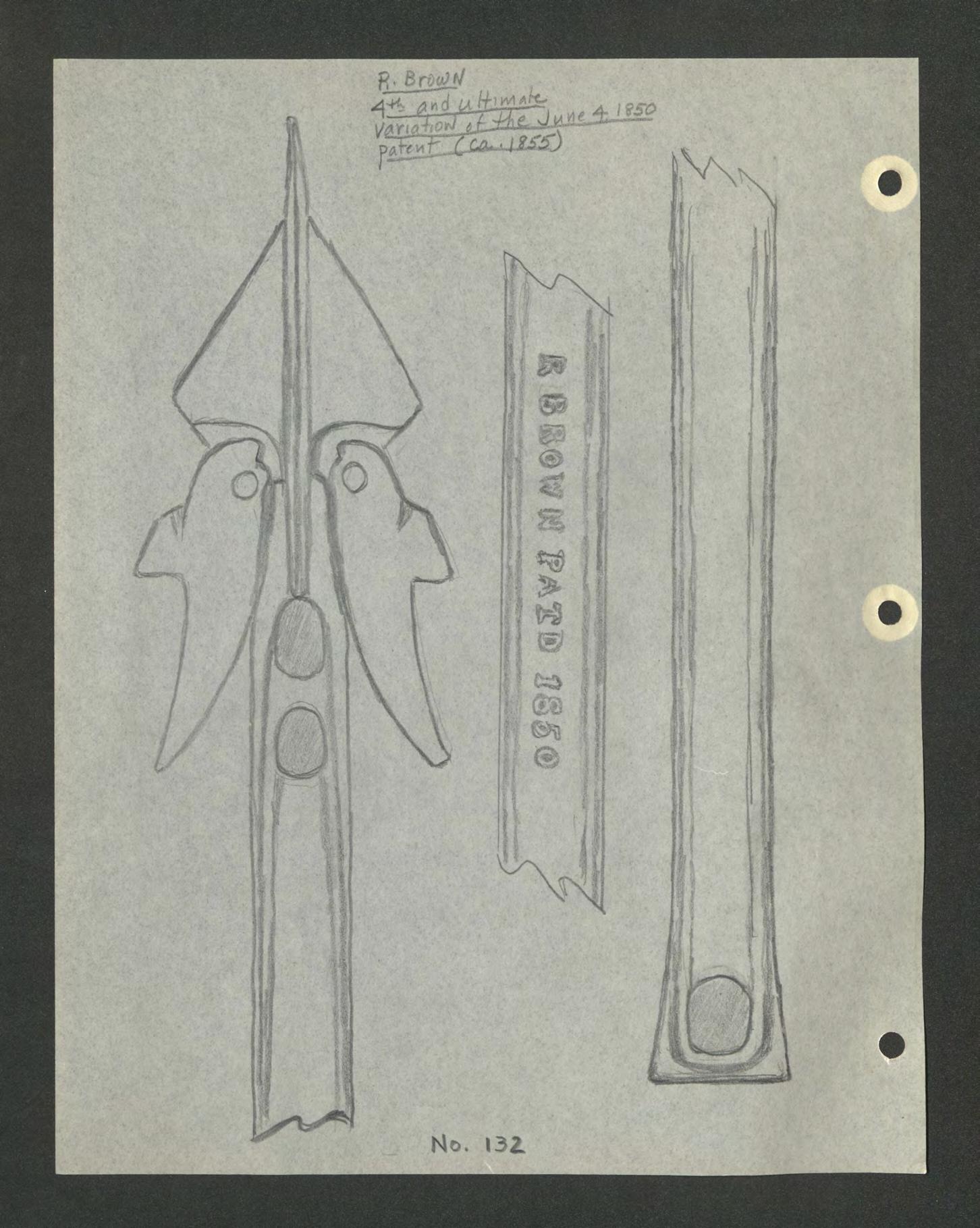
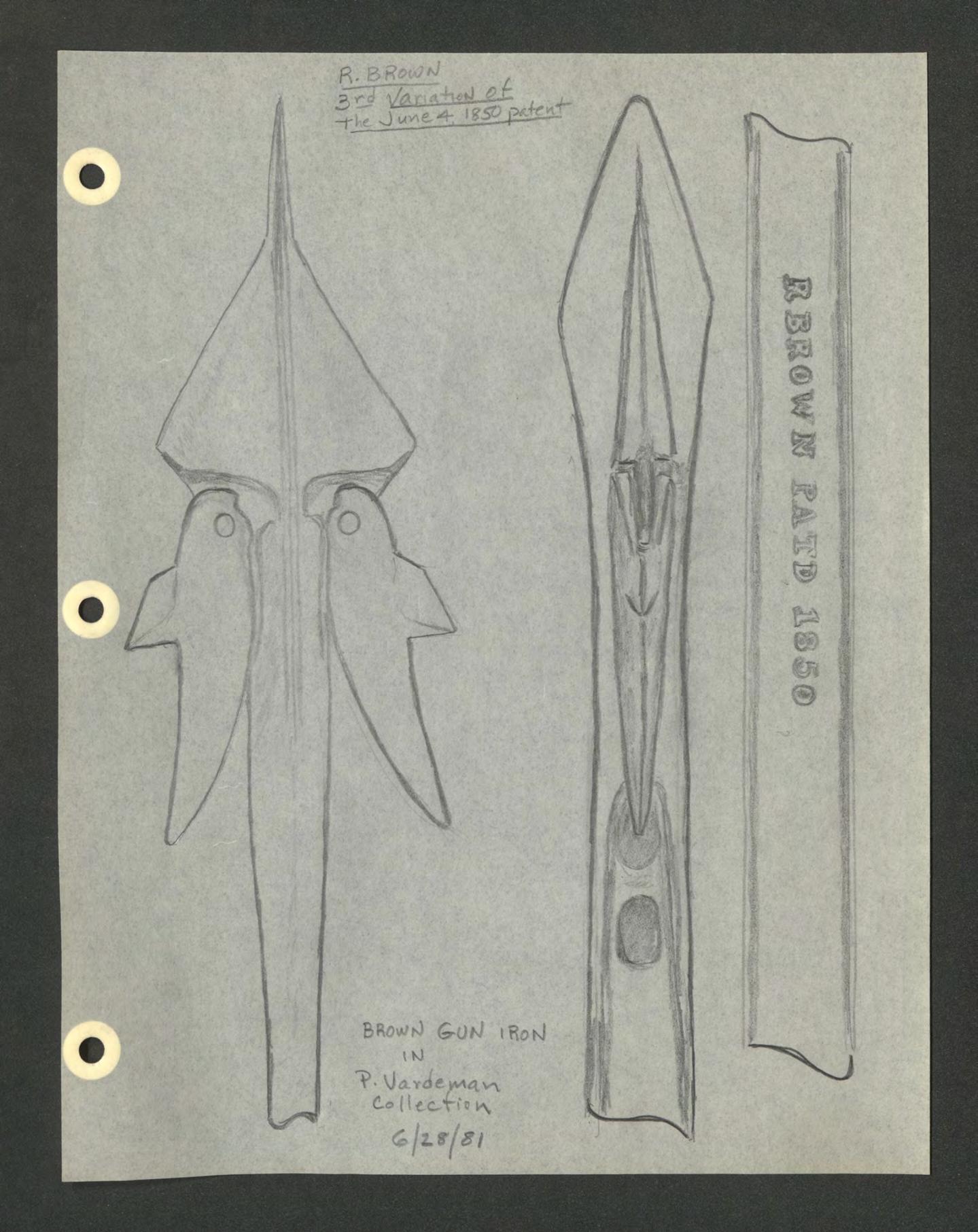
„ . MAKER'S SHIP'3 APPROX. WHERE DATS OF DESCRIPTION MARKS • MARIS AGE- PURCH. PURCH.
132a 4th (and ultimate)
ox)7~&
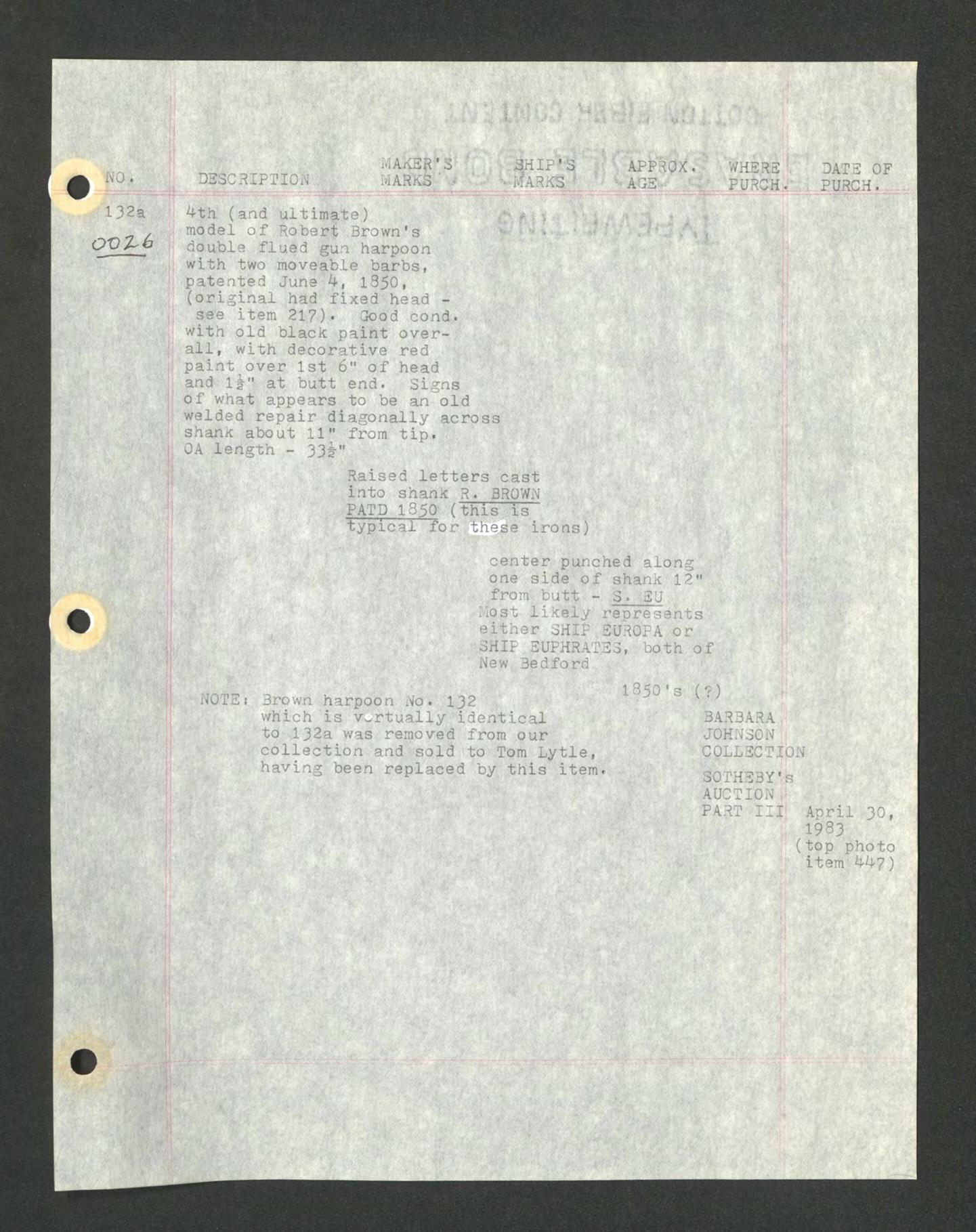
model of Robert Brown's • double flued gun harpoon with two moveable barbs, patented June 4, 1850, (original had fixed headsee item 217). Good cond. with old black paint overall, with decorative red paiht over 1st 6" of head and lJs-7 at butt end. Signs of what appears to be an^old welded repair diagonally across shank about 11" from tip.
OA length - 33|r"
Raised letters cast into shank R. BROWN PATD 1850 (this is typical for these irons)
center punched along one side of shank 12" from butt - 3• 3U host likely represents either 3HIF SUROPA or SHIP EUPHRATES, both of New Bedford
NOTEs Brown harpoon No. 132
1 ~>" ° ^^ which is virtually identical BARBARA to 132a was removed from our JOHNSON collection and sold to Tom Lytle, COLLECTION having been replaced by this item. SOTHEBY'S AUCTION
PART III April 30, 1983 (top photo item 447)
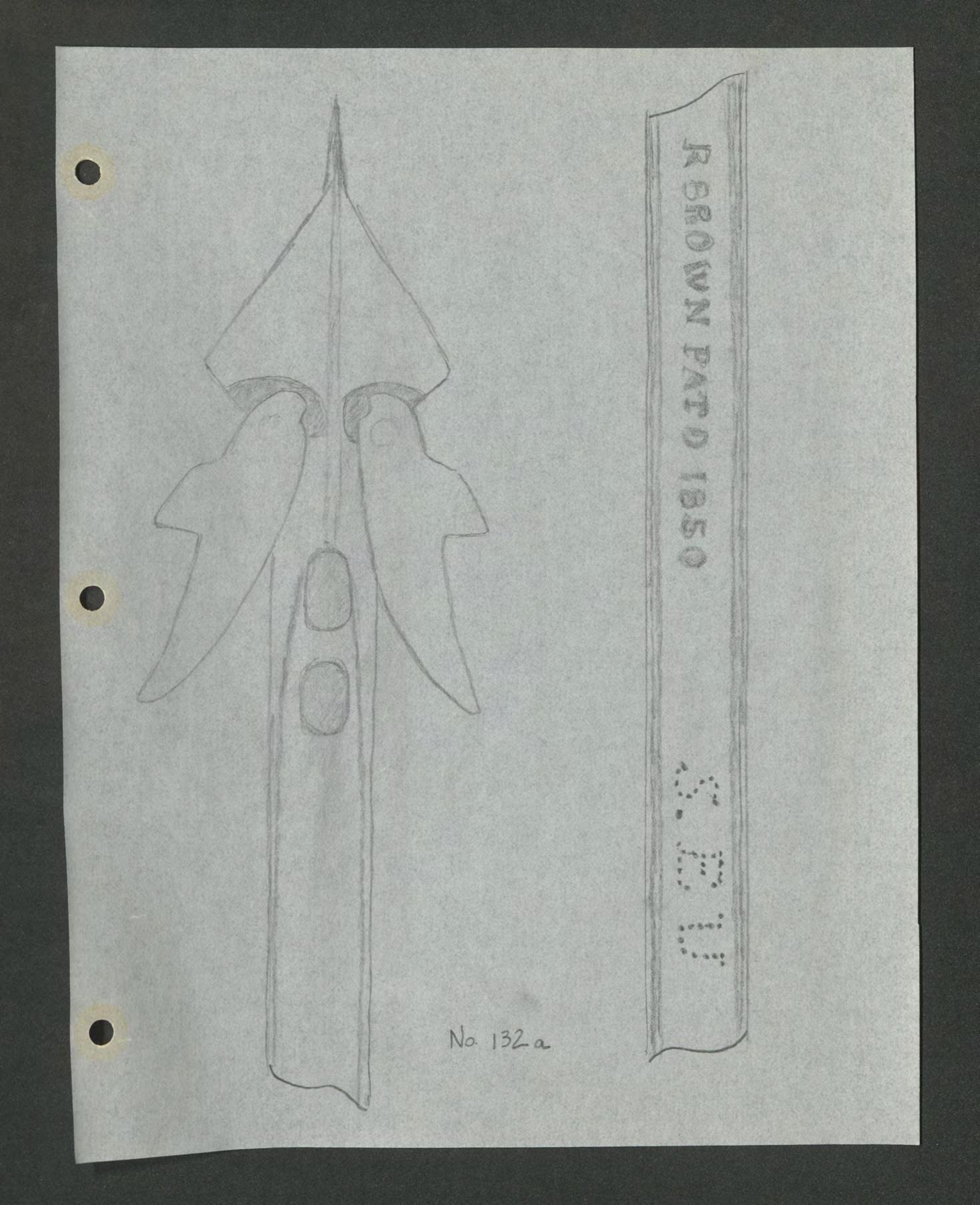
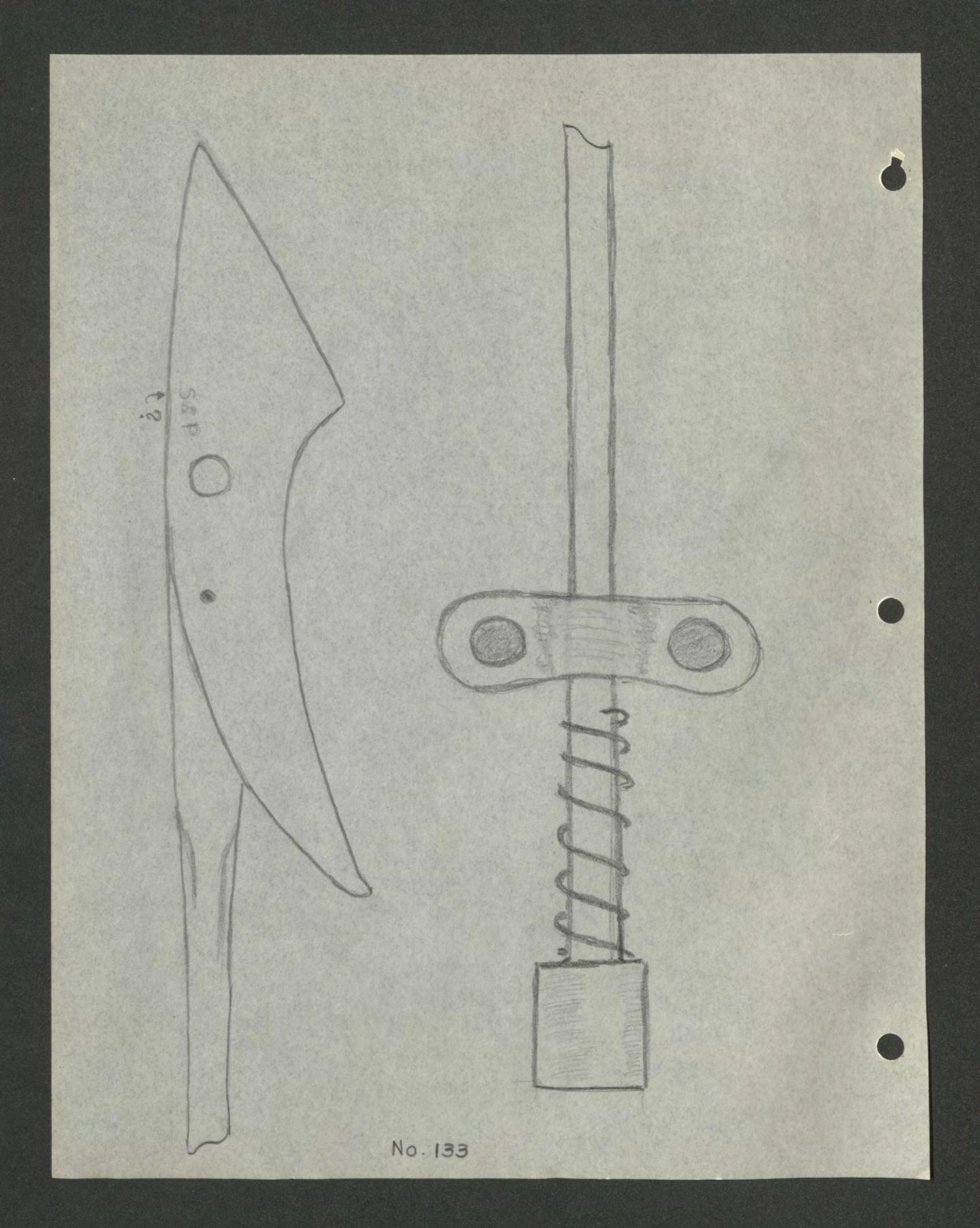
No, DESCRIPTION
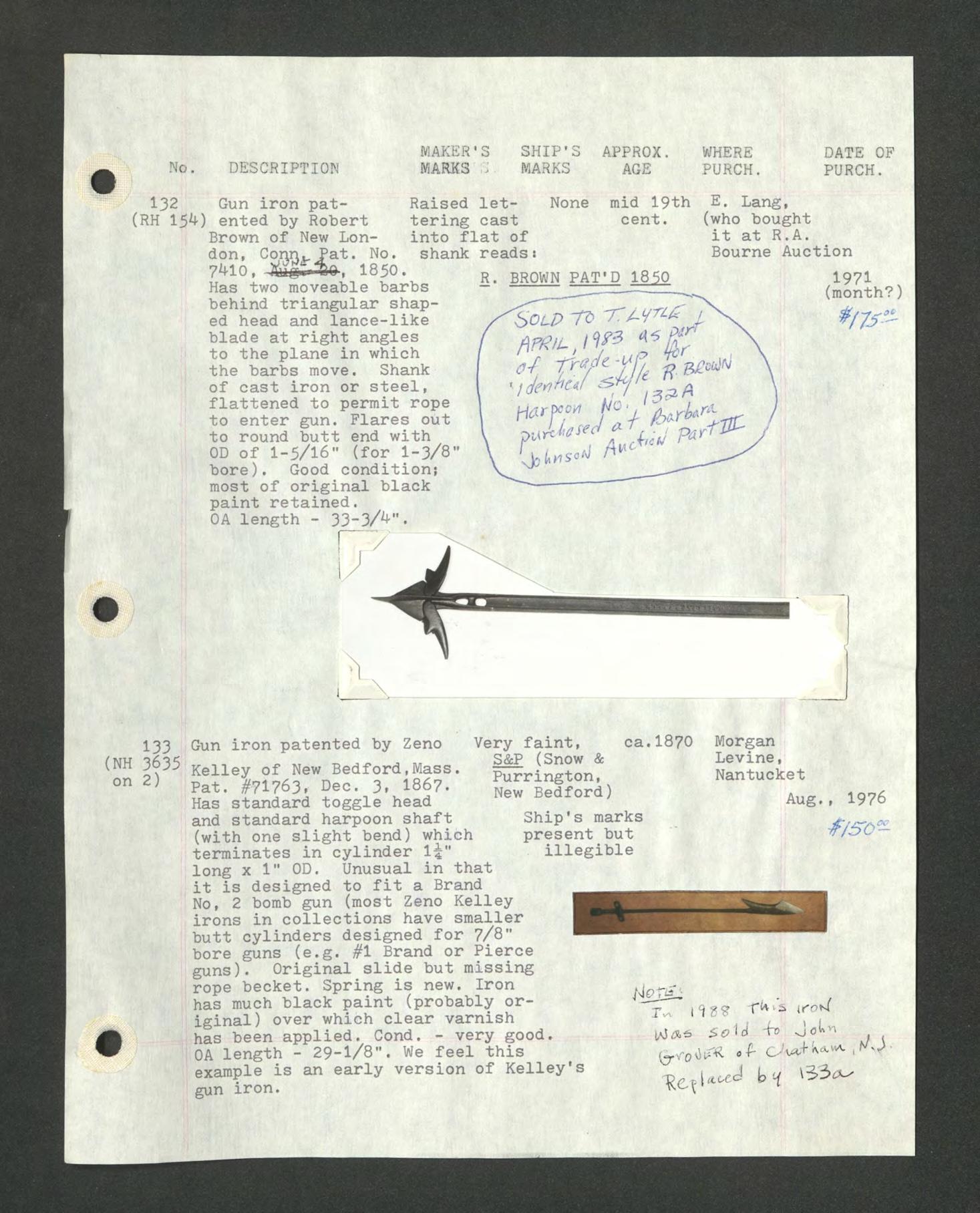
MARKS
132 Gun iron pat(RH 15*0 ented by Robert Brown of New London, Corm. Pat. No. 7410, 1850. Has two moveable barbs behind triangular shaped head and lance-like blade at right angles to the plane in which the barbs move. Shank of cast iron or steel, flattened to permit rope to enter gun. Flares out to round butt end with OD of 1-5/16" (for 1-3/8 bore). Good condition; most of original black paint retained. OA length - 33-3A".
SHIP'S MARKS APPROX. AGE WHERE PURCH,
Raised lettering cast into flat of shank readss
DATE OF PURCH.
None mid 19th cent. E. Lang, (who bought it at R.A. Bourne Auction
R. BROWN PAT'D 1850
SOLD TO R
C-F TRAF XJ/C FTBJCCB 'IDETHUL 1 J3^P 1971 N (month?)
133 Gun iron patented by Zeno (NH 3635 Kelley of New Bedford,Mass. on 2} Pat. #71763, Dec. 3, 1867. Has standard toggle head and standard harpoon shaft (with one slight bend) which terminates in cylinder If" long x 1" OD. Unusual in that it is designed to fit a Brand No, 2 bomb gun (most Zeno Kelley irons in collections have smaller butt cylinders designed for 7/8" bore guns (e.g. #1 Brand or Pierce guns). Original slide but missing rope becket. Spring is new. Iron has much black paint (probably original) over which clear varnish
Very faint, S&P (Snow & Purrington, New Bedford)
ca.I87O Morgan Levine, Nantucket
Ship's marks present but illegible Aug., 1976
• has been applied. Cond. - very good. OA length - 29-1/8". We feel this example is an early version of Kelley's gun iron.
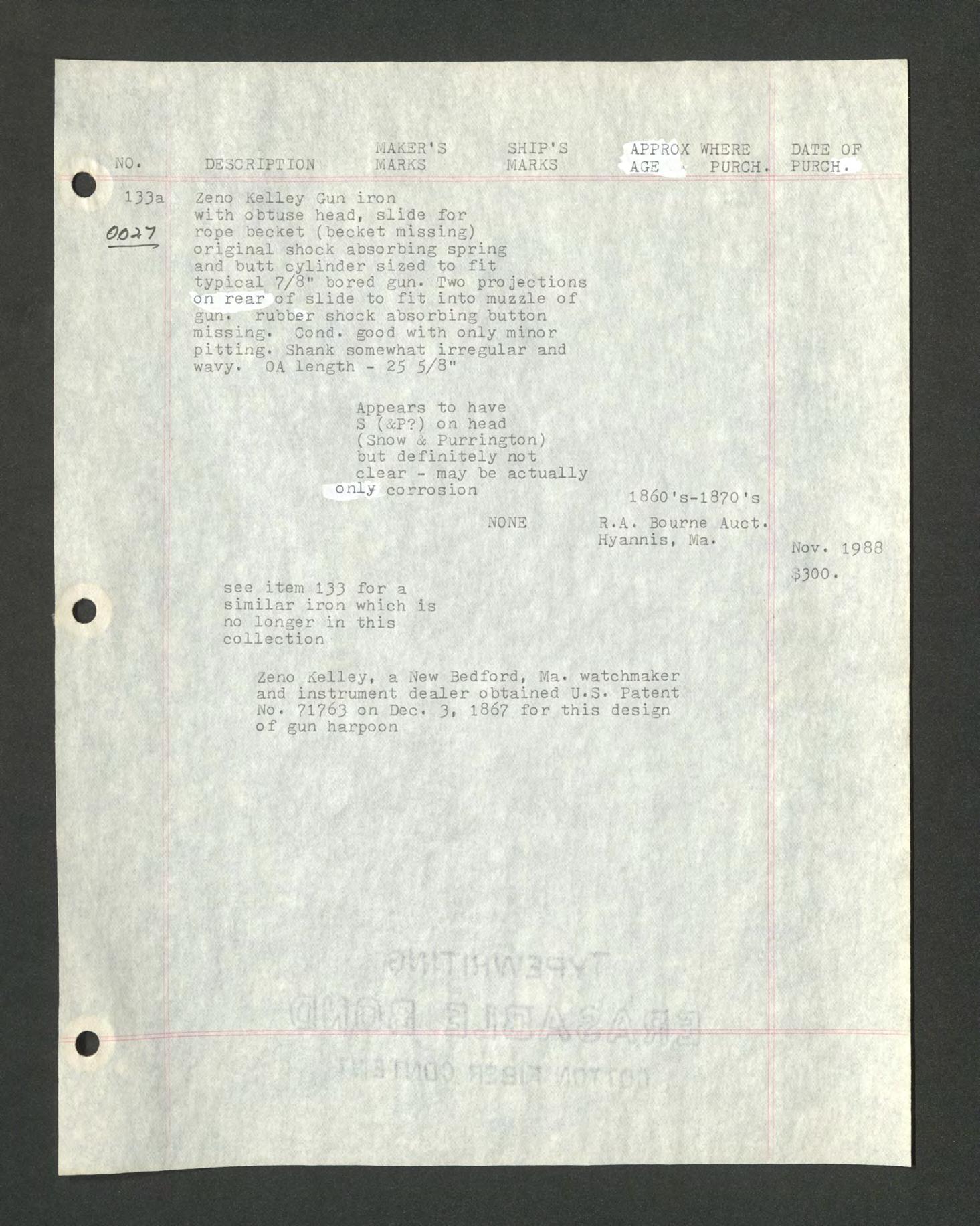
MAKER'S SHIP'S APPROX WHERE DATE OF HO. DESCRIPTION MARKS MARKS AOE - PURCH. PURCH.
133a Zeno Kelley Gun iron with obtuse head, slide for 06*7 rope becket (becket missing) original shock absorbing spring and butt cylinder sized to fit typical 7/8" bored gun. Two projections on rear of slide to fit into muzzle of gun. rubber shock absorbing button missing. Cond. good with only minor pitting. Shank somewhat irregular and wavy. OA length - 25 5/8"
Appears to have S (&P?) on head (Snow 3c Purrington) but definitely not clear - may be actually only corrosion
NONE i860's-lS70 *s
R.A. Bourne Auct. Hyannis, Ma.
see item 133 Tor a similar iron which is no longer in this collection Nov. 1988 8300.
Zeno Kelley, a New Bedford, Ma. watchmaker and instrument dealer obtained U.S. Patent No. 71763 on Dec. 3» 1867 for this design of gun harpoon
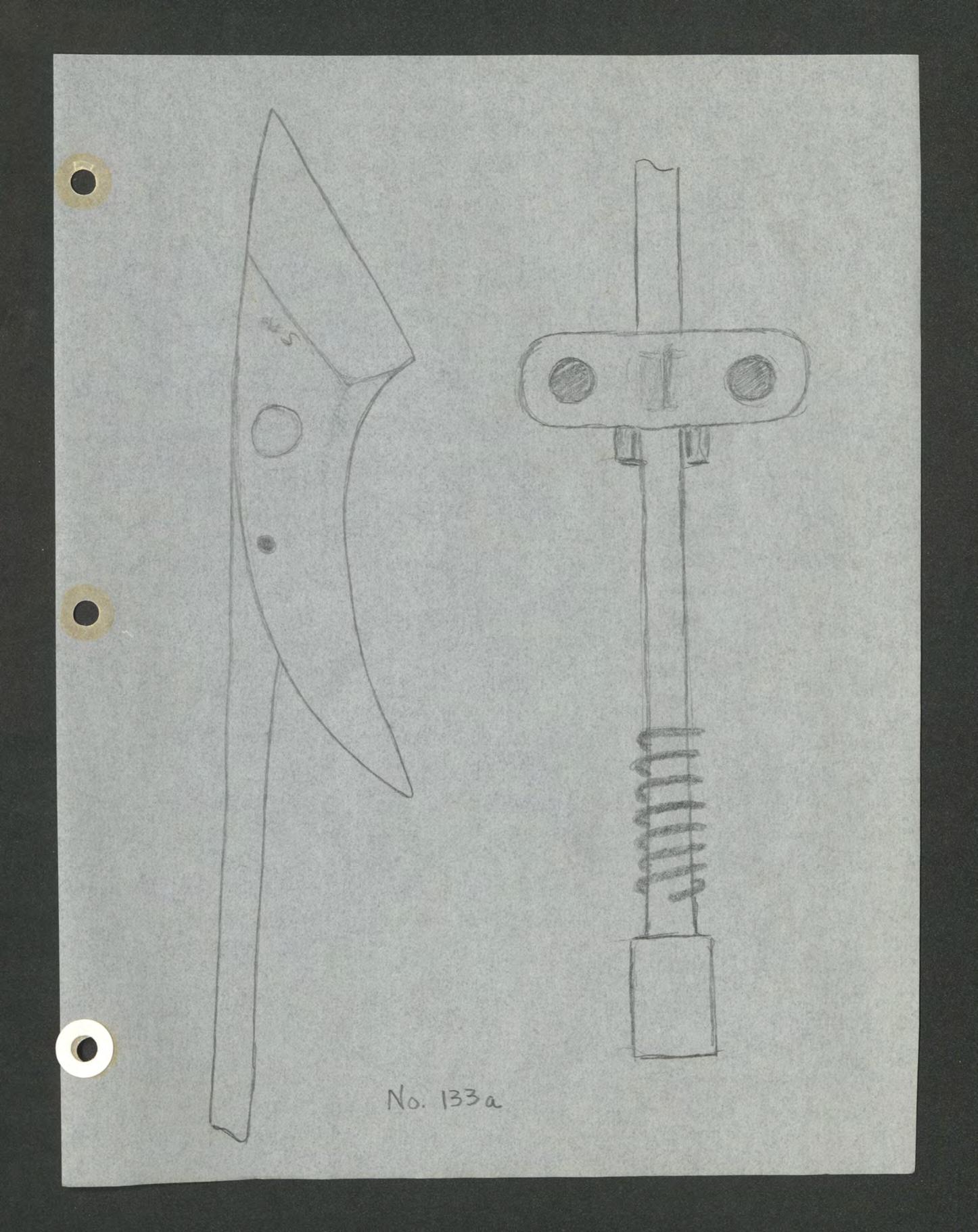
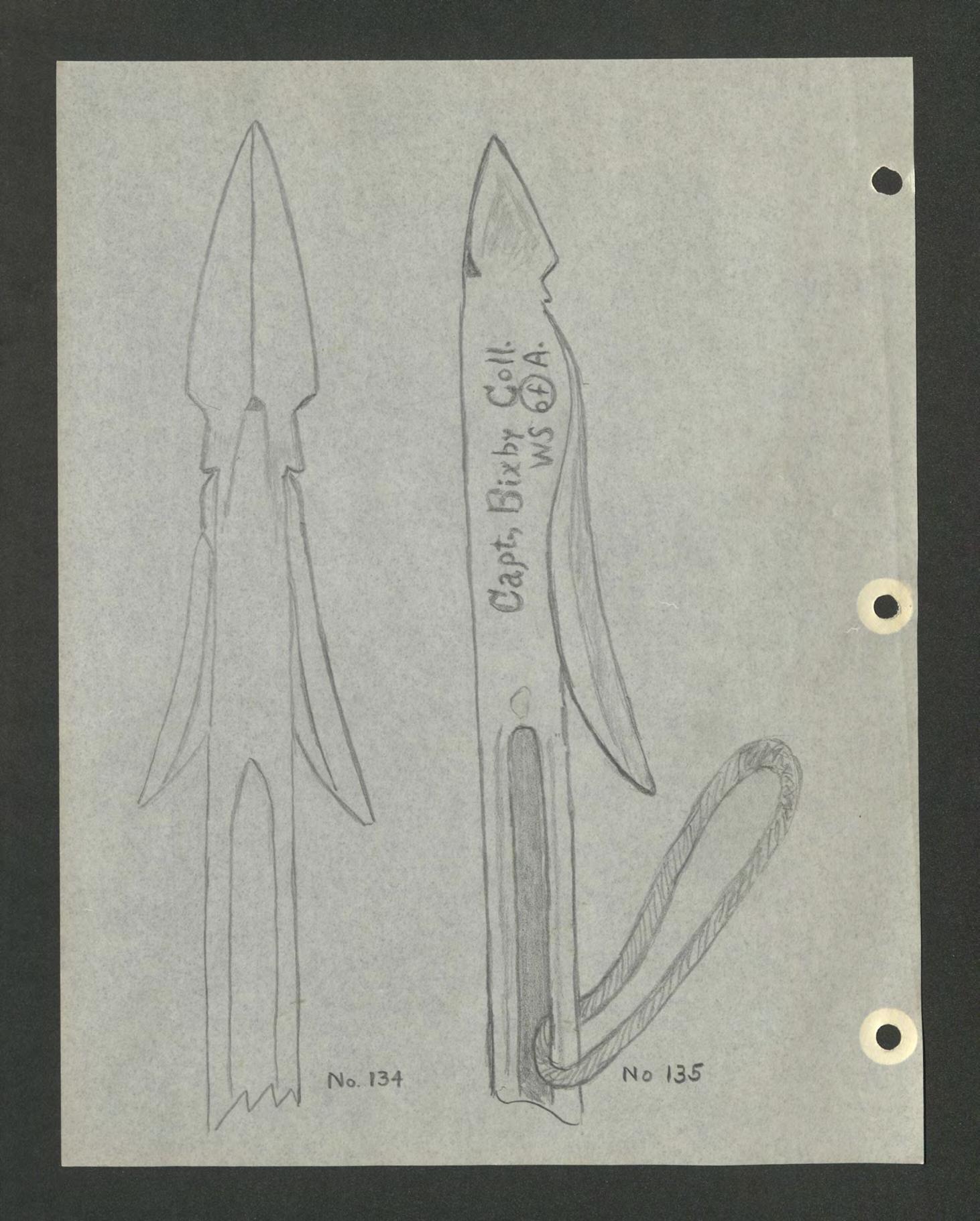
Ooz?
No, DESCRIPTION
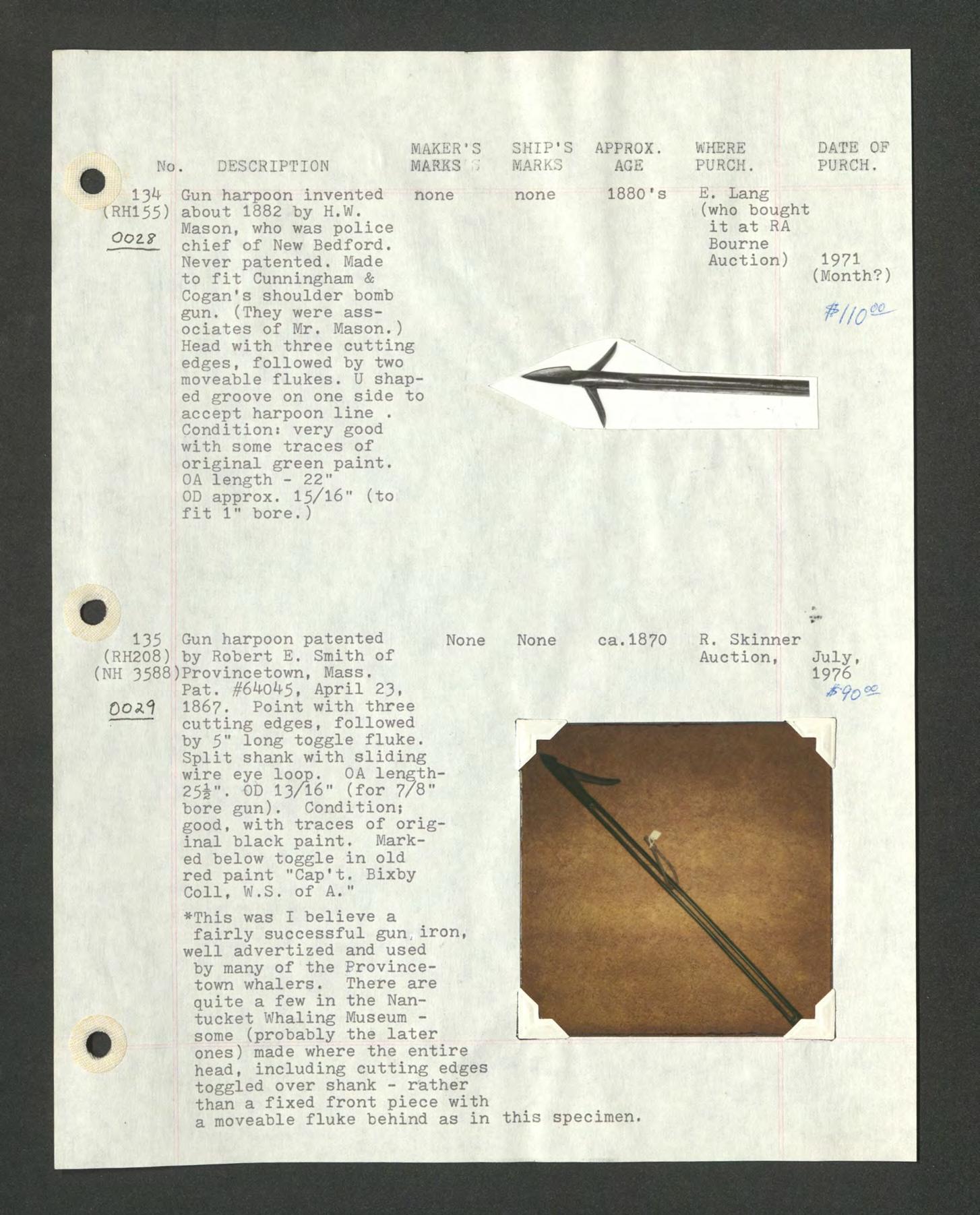
MAKER'S MARKS ;
13^ Gun harpoon invented none (RH155) about 1882 by H.W. Mason, who was police chief of New Bedford. Never patented. Made to fit Cunningham & Cogan's shoulder bomb gun. (They were associates of Mr. Mason.) Head with three cutting edges, followed by two moveable flukes. U shaped groove on one side to accept harpoon line Condition: very good with some traces of original green paint. OA length - 22" OD approx. 15/16" (to fit 1" bore.)
SHIP'S MARKS
none APPROX. AGE 1880's WHERE PURCH. DATE OF PURCH. E. Lang (who bought it at RA Bourne Auction) 1971 (Month?)
*110
135 Gun harpoon patented None (RH208) by Robert E. Smith of (NH 3588)Provincetown, Mass. Pat. #640^5, April 23, 0OA.3 I867. Point with three ' cutting edges, followed by 5" long toggle fluke. Split shank with sliding wire eye loop. OA length25|". OD 13/16" (for 7/8" bore gun). Condition; good, with traces of original black paint. Marked below toggle in old red paint "Cap't. Bixby Coll, W.S. of A."
*This was I believe a fairly successful gun,iron, well advertized and used by many of the Provincetown whalers. There are quite a few in the Nantucket Whaling Museumsome (probably the later W ones) made where the entire head, including cutting edges toggled over shank - rather than a fixed front piece with a moveable fluke behind as in
None ca.1870 R. Skinner Auction, July, 1976
^9othis specimen.
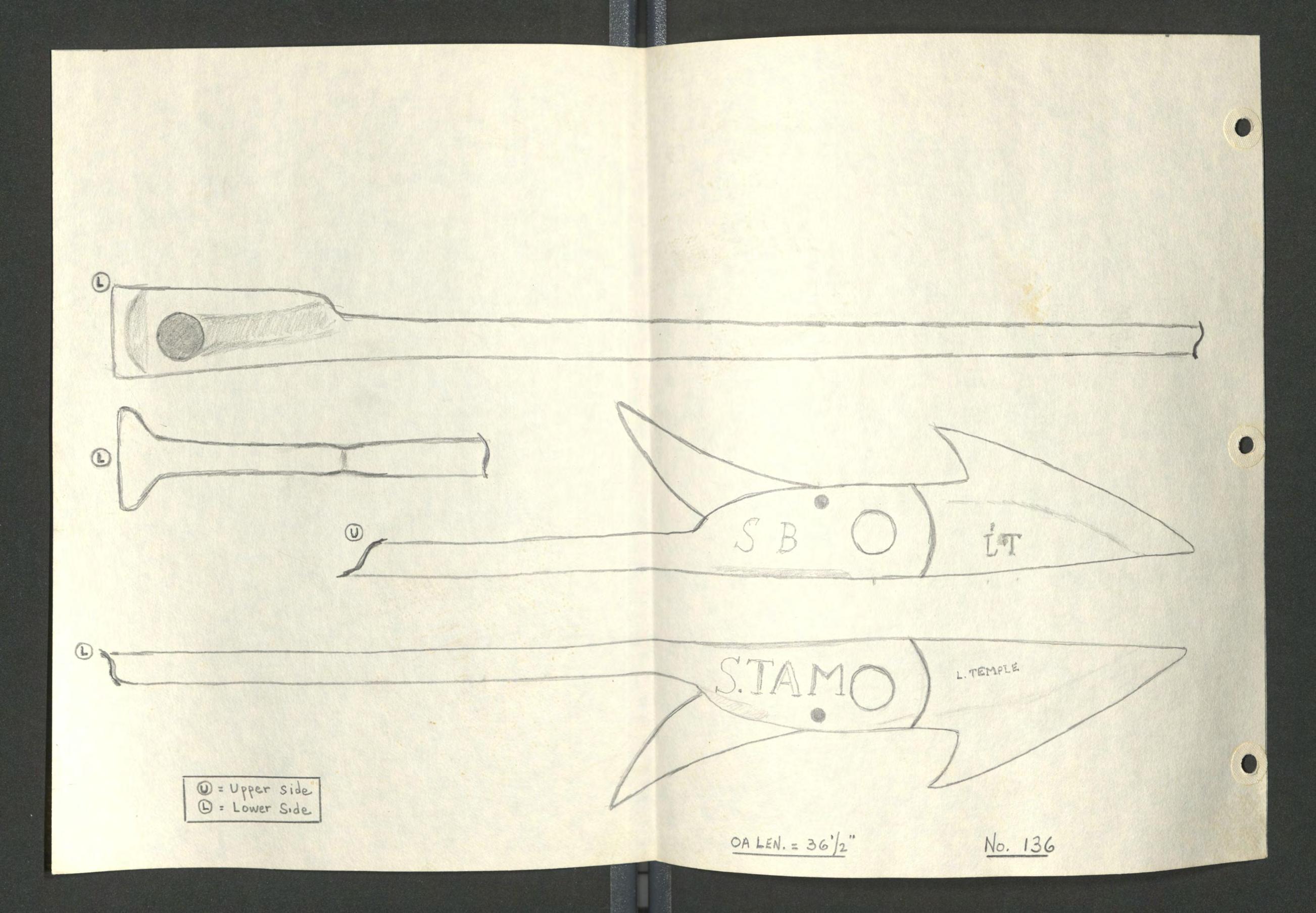
<yD - sUe^
0 = Lower
MAKER'S SHIP'S APPROX. No, DESCRIPTION MARKS G MARKS AGE WHERE PURCH. DATE OF PURCH.
136 (NH 4236)
0^3 0
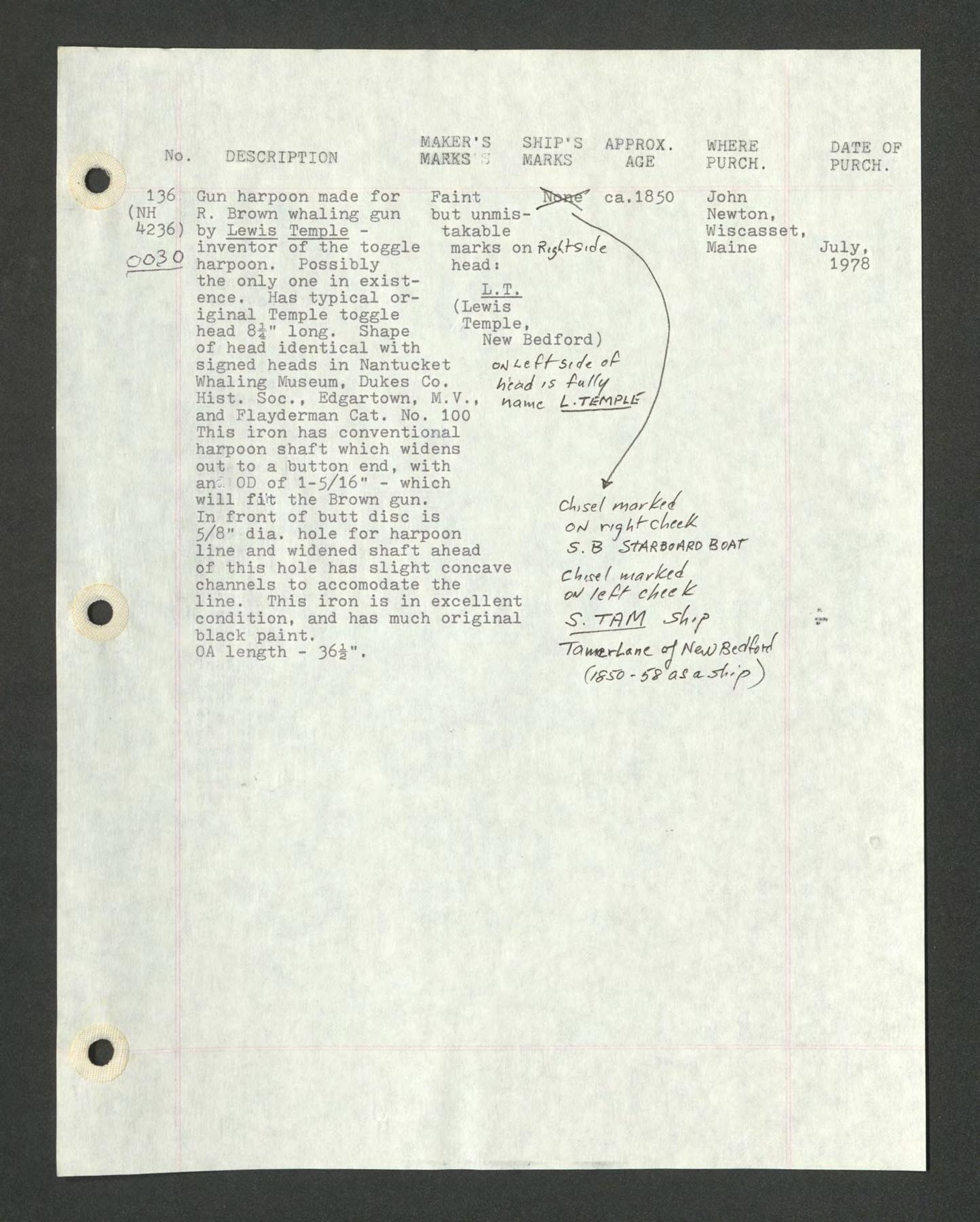
Faint
Gun harpoon made for R. Brown whaling gun by Lewis Templeinventor of the toggle harpoon. Possibly the only one in existence. Has typical original Temple toggle head 83" long. Shape of head identical with signed heads in Nantucket Whaling Museum, Dukes Co. Hist. Soc., Edgartown, M.V. and Flayderman Cat. No. 100 This iron has conventional harpoon shaft which widens out to a button end, with anc" 0D of 1-5/16" - which will fi't the Brown gun. In front of butt disc is 5/8" dia. hole for harpoon line and widened shaft ahead of this hole has slight concave channels to accomodate the line. This iron is in excellent condition, and has much original black paint. OA length - 36!".
ca.1850 but unmistakable marks on head:
L.T. (Lewis Temple, New Bedford)
OfJ £e
hc&tl >$ -Puffy L .T£MPLjf
John Newton, Wiscasset, Maine July, 1978
cL>se( OtJ
S.B S-tARSoARO Befir
C h >st( MaaPf-C d 0*A /<? c/r(£
1ato<tx-UnC aj
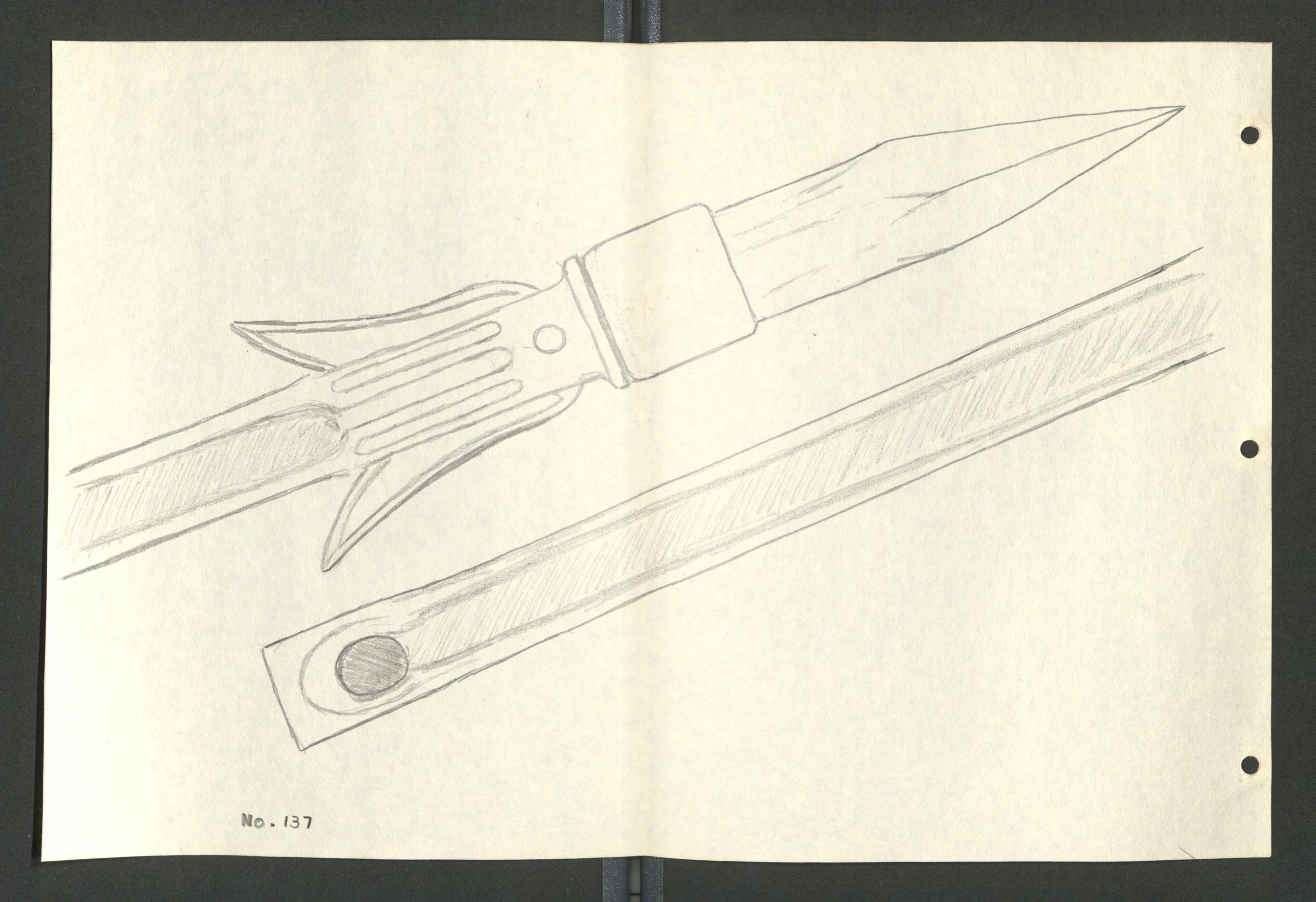
No
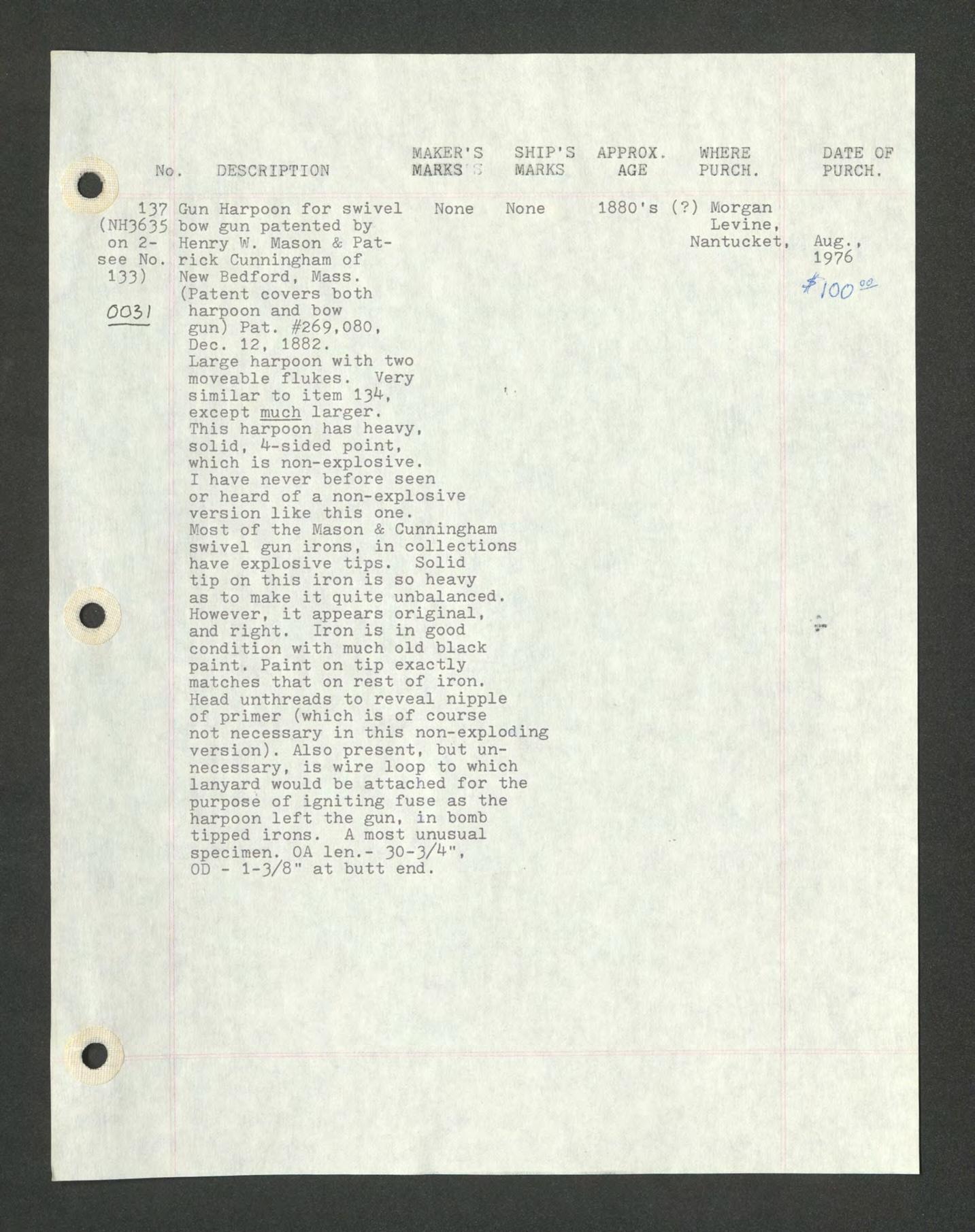
DESCRIPTION
137 Gun Harpoon for swivel
None
None (NH3635 bow gun patented by on 2- Henry W. Mason & Patsee No. rick Cunningham of 133) New Bedford, Mass. (Patent covers both 00$I harpoon and bow gun) Pat. #269,080, Dec. 12, 1882.
Large harpoon with two moveable flukes. Very similar to item 13^. except much larger. This harpoon has heavy, solid, 4-sided point, which is non-explosive. I have never before seen or heard of a non-explosive version like this one.
Most of the Mason & Cunningham swivel gun irons, in collections have explosive tips. Solid tip on this iron is so heavy as to make it quite unbalanced. However, it appears original, and right. Iron is in good condition with much old black paint. Paint on tip exactly matches that on rest of iron. Head unthreads to reveal nipple of primer (which is of course not necessary in this non-exploding version). Also present, but unnecessary, is wire loop to which lanyard would be attached for the purpose of igniting fuse as the harpoon left the gun, in bomb tipped irons. A most unusual specimen. OA len.- 30-3/^"» 0D - 1-3/8" at butt end.
1880's (?) Morgan Levine, Nantucket, Aug., 1976
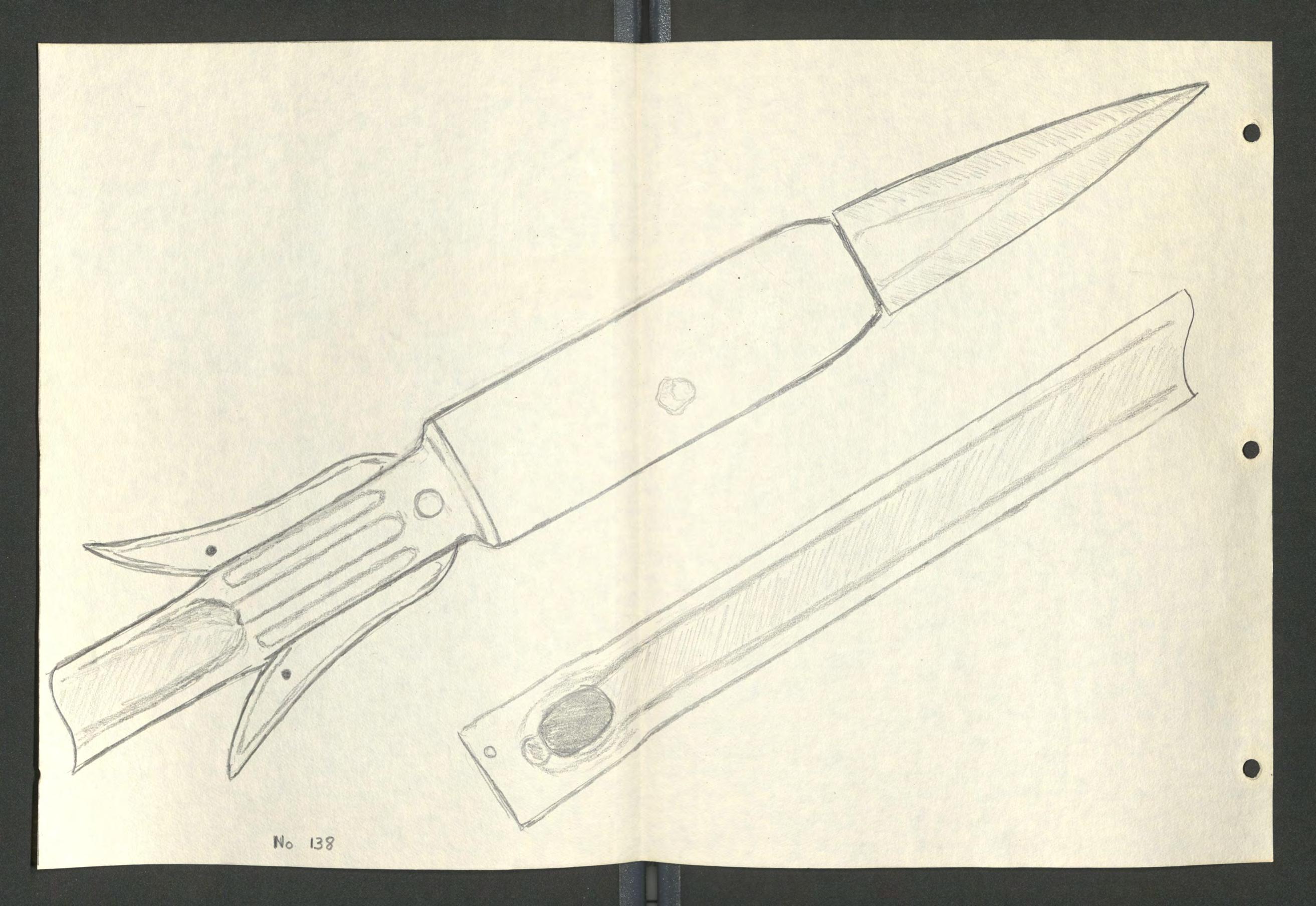
13?
No. DESCRIPTION
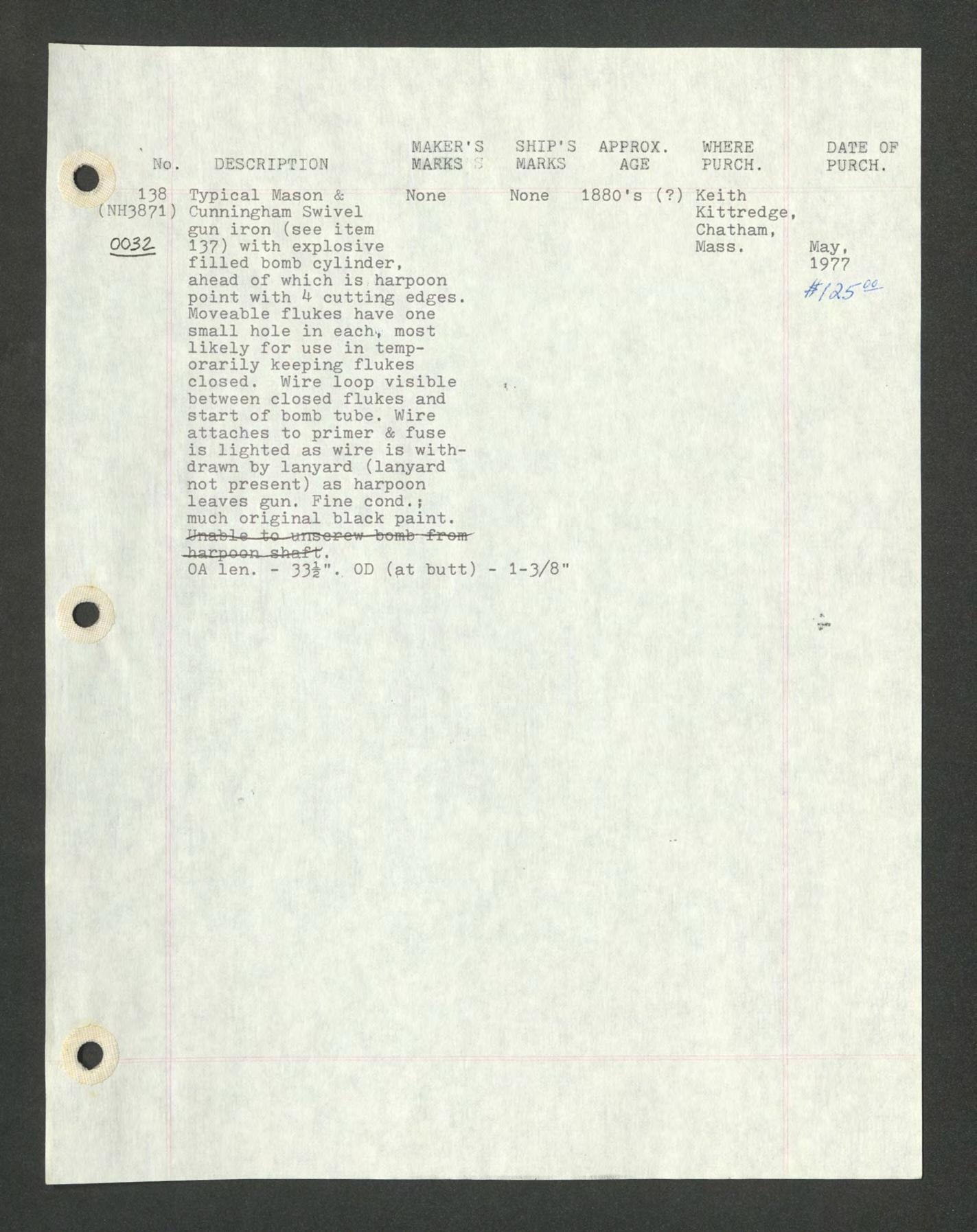
MAKER'S SHIP'S APPROX. WHERE DATE OF MARES Z MARKS AGE PURCH. PURCH.
138 Typical Mason & None (NH387I) Cunningham Swivel gun iron (see item 0032- 137) with explosive filled bomb cylinder, ahead of which is harpoon point with b cutting edges. Moveable flukes have one small hole in each., most likely for use in temporarily keeping flukes closed. Wire loop visible between closed flukes and start of bomb tube. Wire attaches to primer & fuse is lighted as wire is withdrawn by lanyard (lanyard not present) as harpoon leaves gun. Fine cond.; much original black paint.
JHITAMRE to -UTIS-CPCW bomb fronr harpoon-shaff.
OA len. - 33i">. OD (at butt)
None 1880's (?) 1-3/8 Keith Kittredge, Chatham, Mass. May, 1977
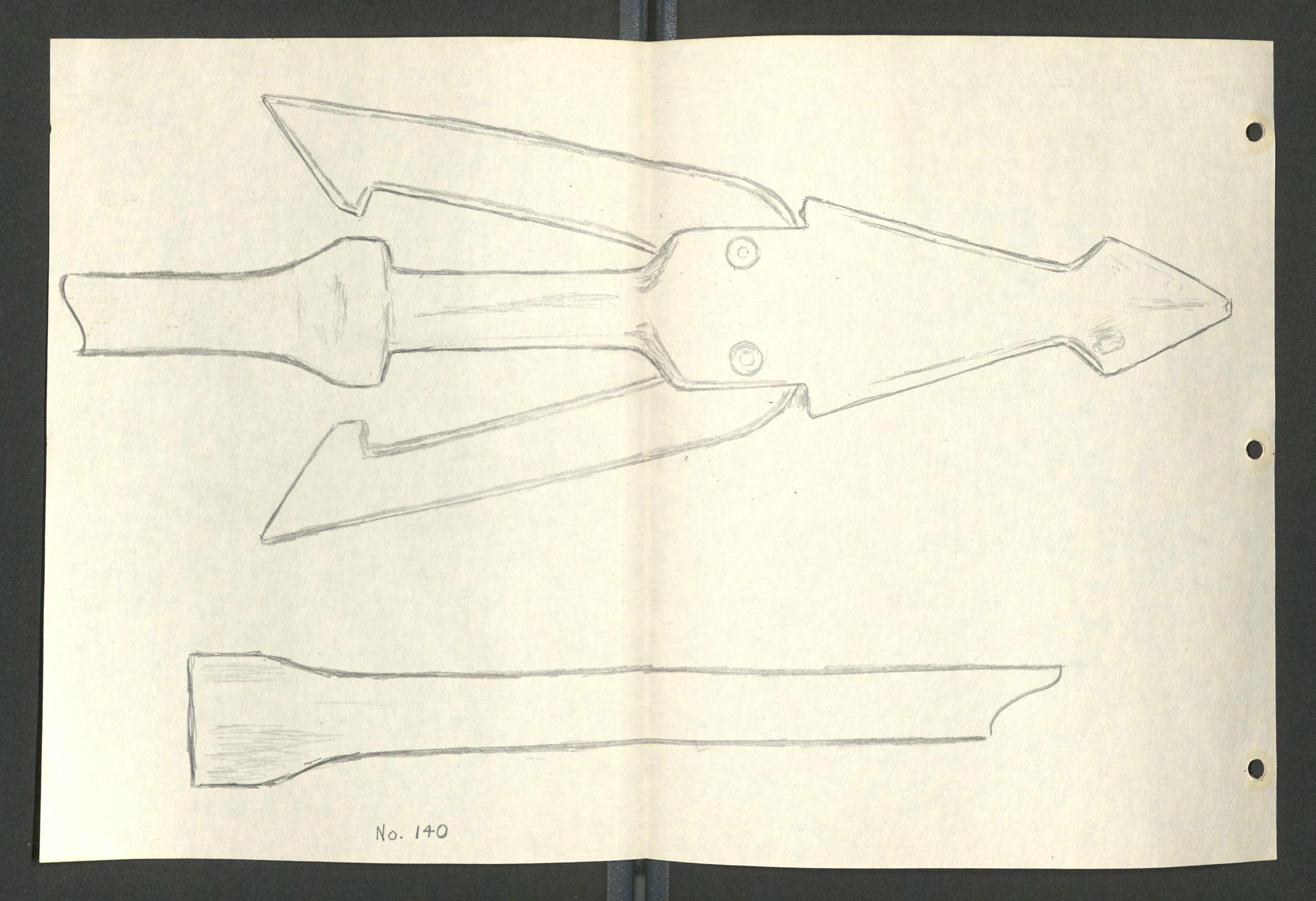
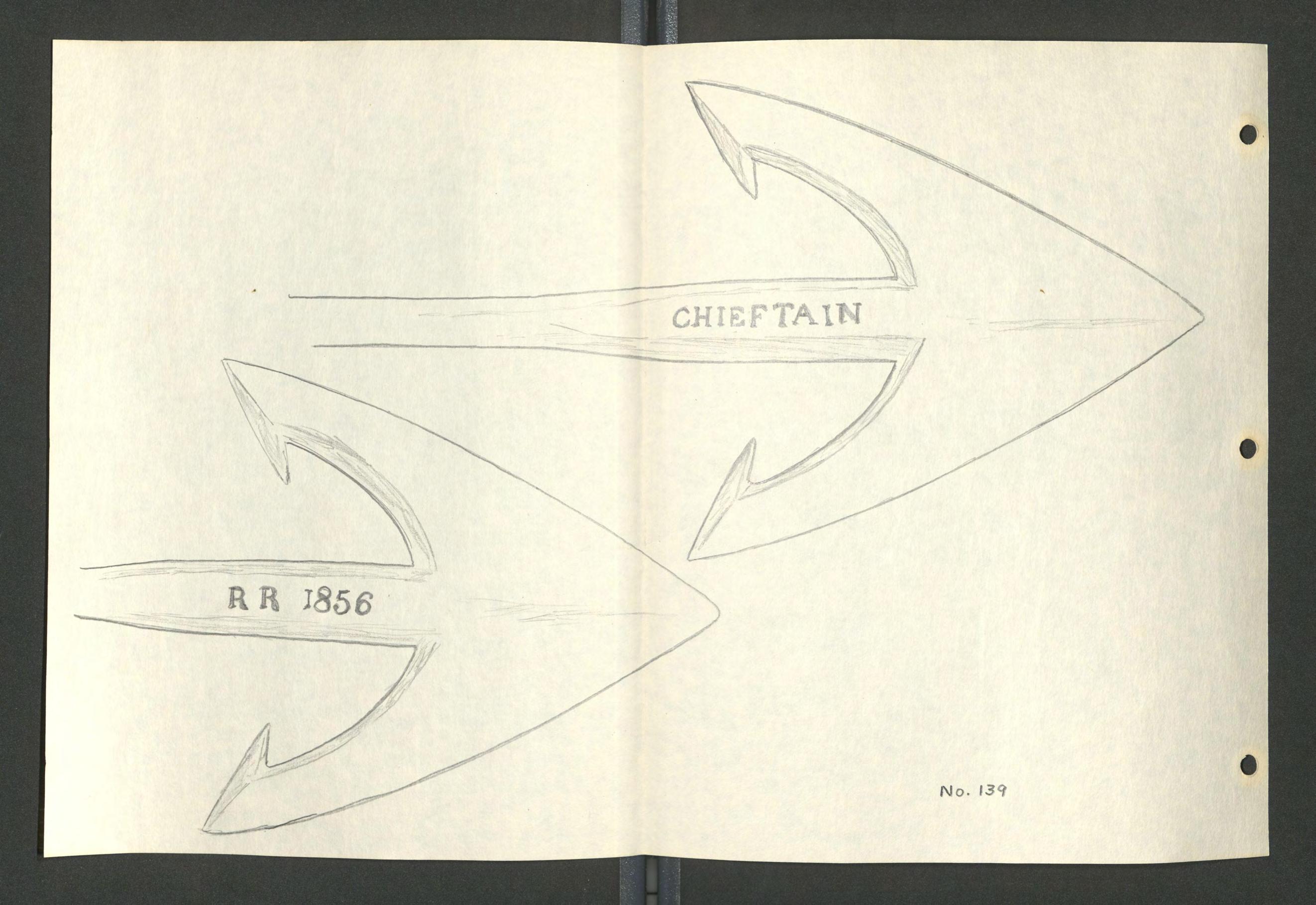
No, DESCRIPTION
139 Scotch Greener bow gun iron. Doubleaq25 flued, very large head (6i" across) with "stop-withers". Has typical split shank, with large sliding ring& thimble for rope connection.
Excellent condition.
OD at butt - 1-11/16"
OA length - 49"
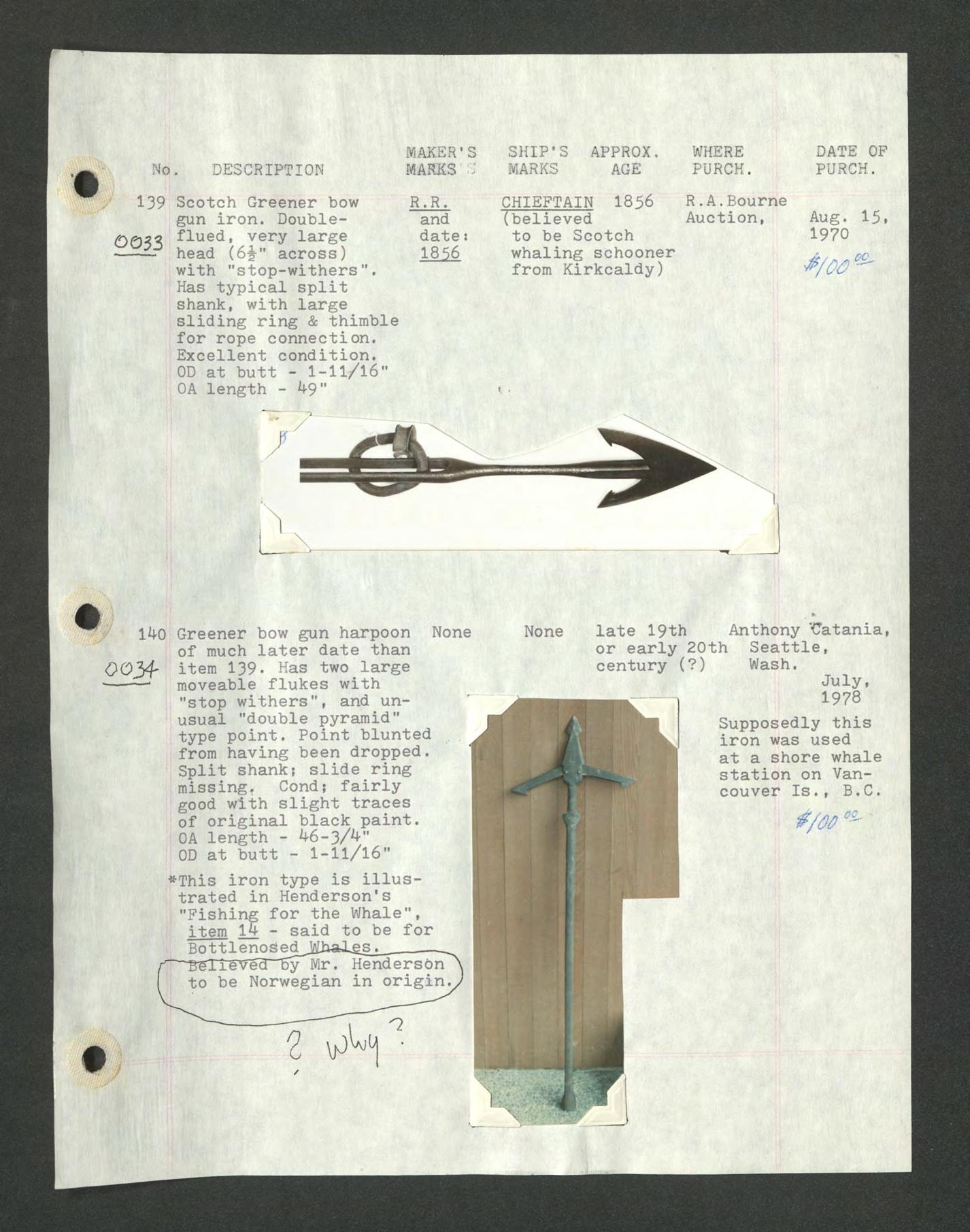
MAKER'S MARKS ; SHIP'S APPROX. WHERE MARKS AGE PURCH.
DATE OF PURCH.
R.R. CHIEFTAIN I856 R.A.Bourne and (believed Auction, Aug. 15, dates to be Scotch 1970 1856 whaling schooner » ^ from Kirkcaldy) ™/Q<3
140 Greener bow gun harpoon None of much later date than <9034* item 139. Has two large moveable flukes with "stop withers", and unusual "double pyramid" type point. Point blunted from having been dropped. Split shank; slide ring missing. Cond; fairly good with slight traces of original black paint.
OA length - 46-3/4"
OD at butt - 1-11/16"
*This iron type is illustrated in Henderson's "Fishing for the Whale", item 14 - said to be for 3 ed_JiLhaJ-gs_ ""BvMr. He: Dy Mr. Henderson to be Norwegian in origin.
None late 19th Anthony"Catania, or early 20th Seattle, century(?) Wash. July, 1978
Supposedly this iron was used at a shore whale station on Vancouver Is., B.C. $/00 00
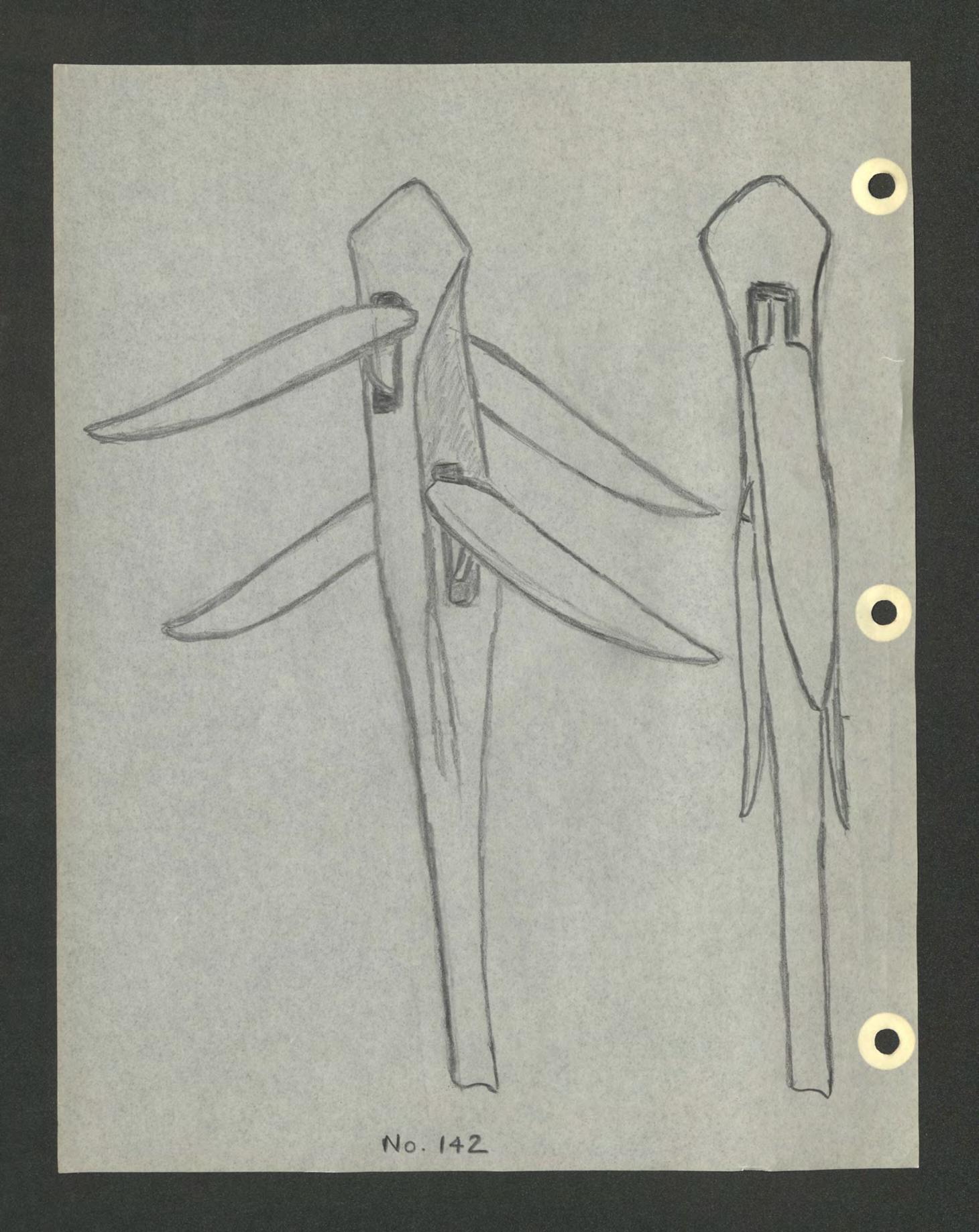
^ MAKER1
^ No. DESCRIPTION MARKS
141 Modern American None
50 mm.(drenade*^)
003{T Harpoon; shank K " deformed from use. Four moveable flukes. Slide ring made of many wire strands. Has steel shackle and traces of nylon rope.
OA length - 61"
/ pro
OD at butt - 1-15/16"
Cond.; good
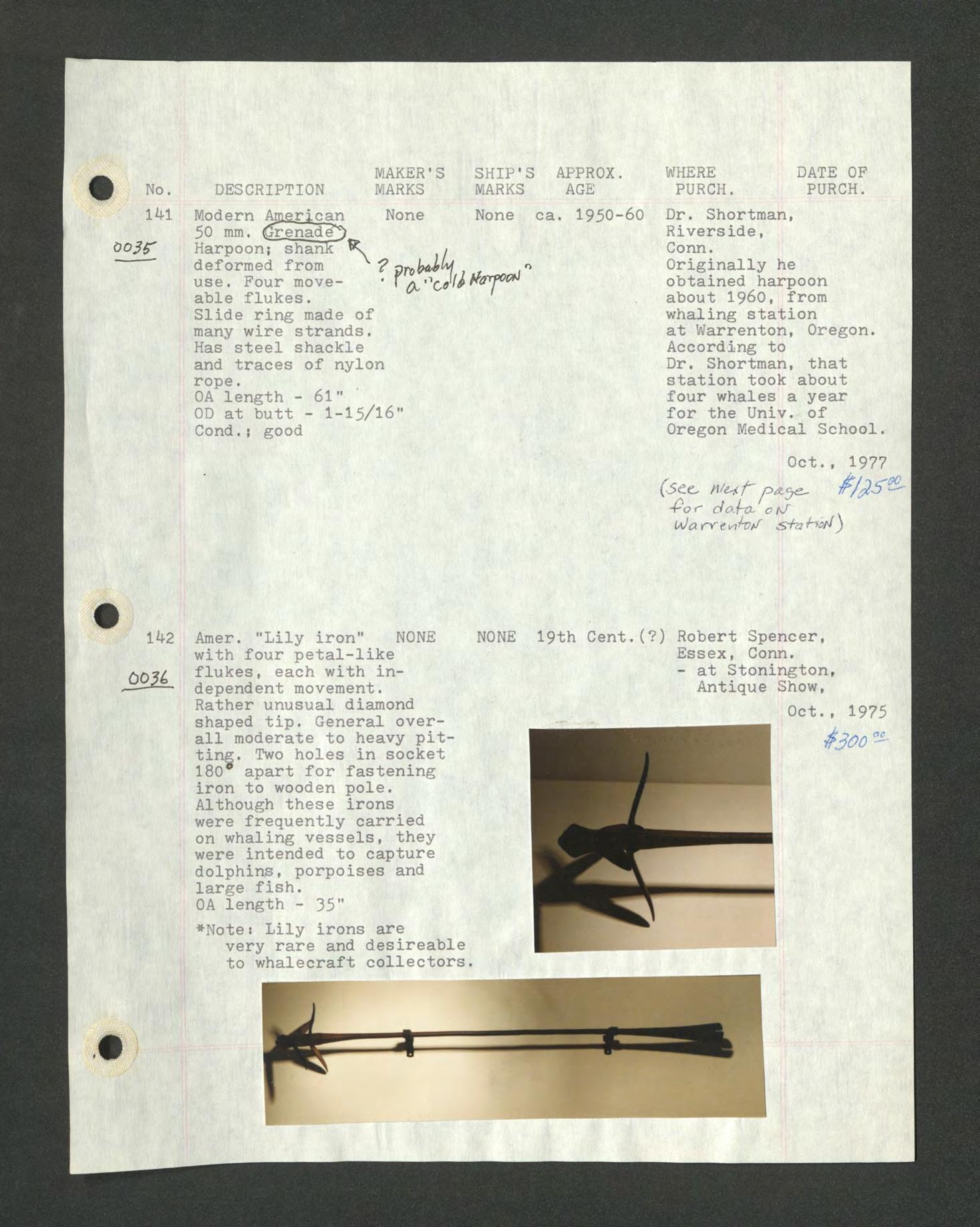
SHIP'S MARKS APPROX, AGE
None ca. 1950-60
WHERE PURCH. DATE OF PURCH. Dr. Shortman, Riverside, Conn. Originally he obtained harpoon about i960, from whaling station at Warrenton, Oregon. According to Dr. Shortman, that station took about four whales a year for the Univ. of Oregon Medical School, Oct.
(Sec, P^5<£-A?c cfaj-rx' otJ tiJ a rvf s+u'horf3 1977
142 Amer. "Lily iron" NONE with four petal-like flukes, each with independent movement. Rather unusual diamond shaped tip. General overall moderate to heavy pitting. Two holes in socket 180° apart for fastening iron to wooden pole. Although these irons were frequently carried on whaling vessels, they were intended to capture dolphins, porpoises and large fish.
OA length - 35"
*Note: Lily irons are very rare and desireable to whalecraft collectors.
NONE 19th Cent.(?) Robert Spencer, Essex, Conn. - at Stonington, Antique Show, Oct., 1975 $300
company
lUFAWU
lea. Newroposal to twenty|any offer, , but they hen cut its Ispite meIrate."°In ll who had fishermen o corntracts, the lyment for Ire was no
Ir contract pnth, with X 1
iced its in:w to share ippered by the muchrose in obubdividewfoundnot given
lie, and in(humpback to be very Iket, where pound in lhaser boats [re costs reconditions
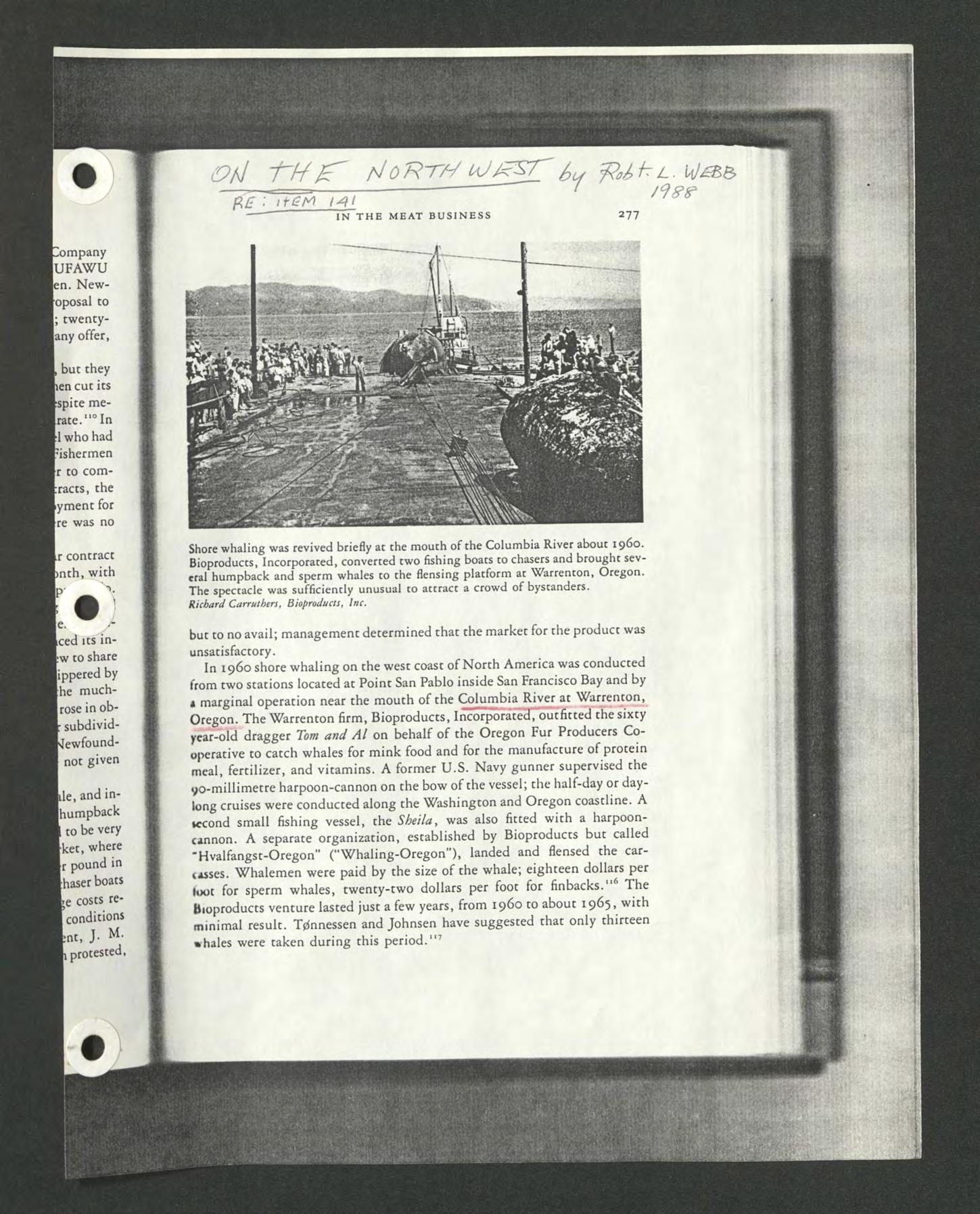
Shore whaling was revived briefly at the mouth of the Columbia River about i960. Bioproducts, Incorporated, converted two fishing boats to chasers and brought several humpback and sperm whales to the flensing platform at Warrenton, Oregon. The spectacle was sufficiently unusual to attract a crowd of bystanders. Richard Carruthers, Bioproducts, Inc.
but to no avail; management determined that the market for the product was unsatisfactory.
In i960 shore whaling on the west coast of North America was conducted from two stations located at Point San Pablo inside San Francisco Bay and by t marginal operation near the mouth of the Columbia River at Warrenton, Oregon. The Warrentonfirm, Bioproducts, Incorporated, outfitted the sixty year-old dragger Tom and Al on behalf of the Oregon Fur Producers Cooperative to catch whales for mink food and for the manufacture of protein meal, fertilizer, and vitamins. A former U.S. Navy gunner supervised the 90-millimetre harpoon-cannon on the bow of the vessel; the half-day or daylong cruises were conducted along the Washington and Oregon coastline. A iccond small fishing vessel, the Sheila, was also fitted with a harpooncannon. A separate organization, established by Bioproducts but called "Hvalfangst-Oregon" ("Whaling-Oregon ), landed and flensed the carcasses. Whalemen were paid by the size of the whale; eighteen dollars per loot for sperm whales, twenty-two dollars per foot for finbacks. The bioproducts venture lasted just a few years, from i960 to about 1965. with minimal result. T0nnessen and Johnsen have suggested that only thirteen whales were taken during this period."7
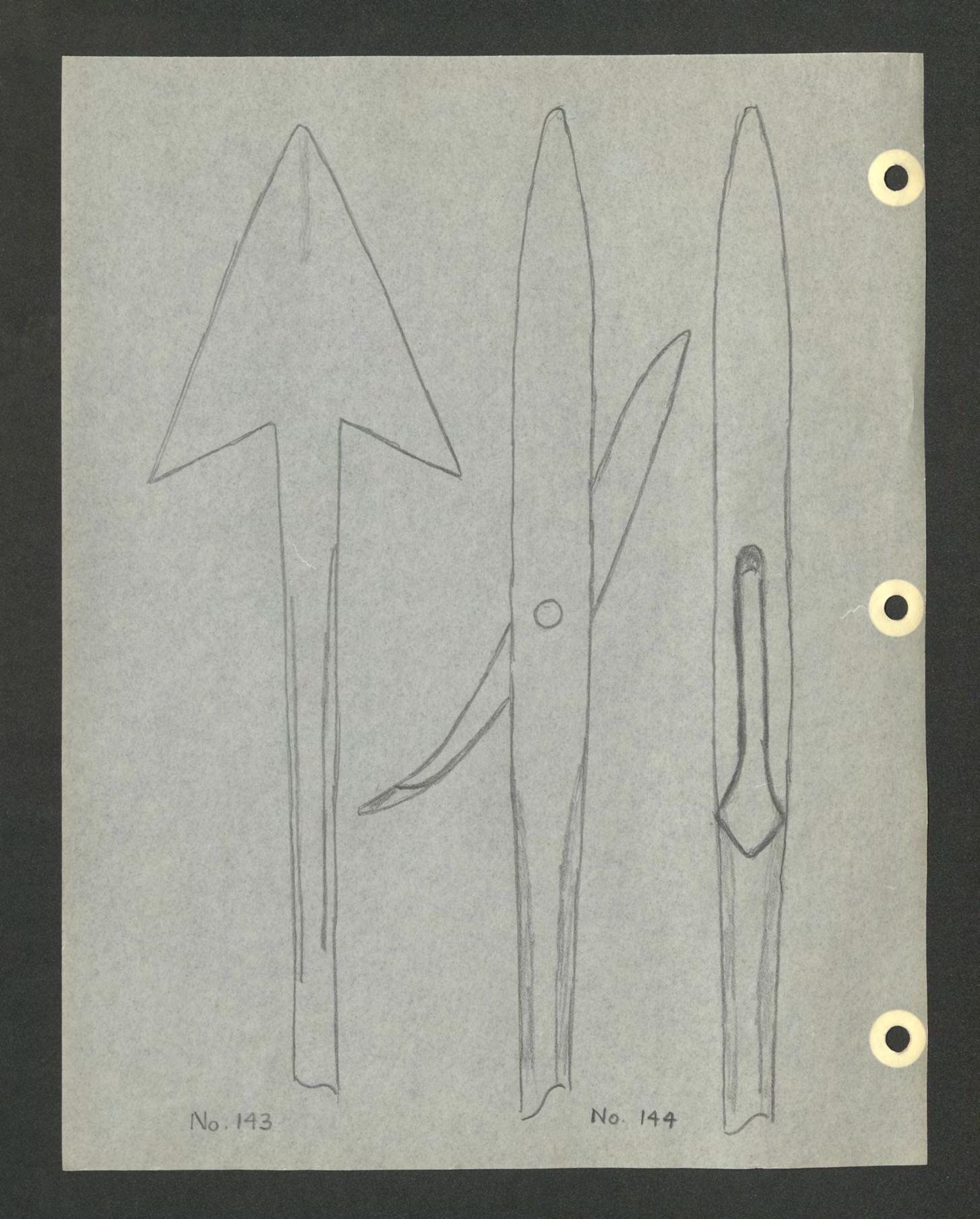
k
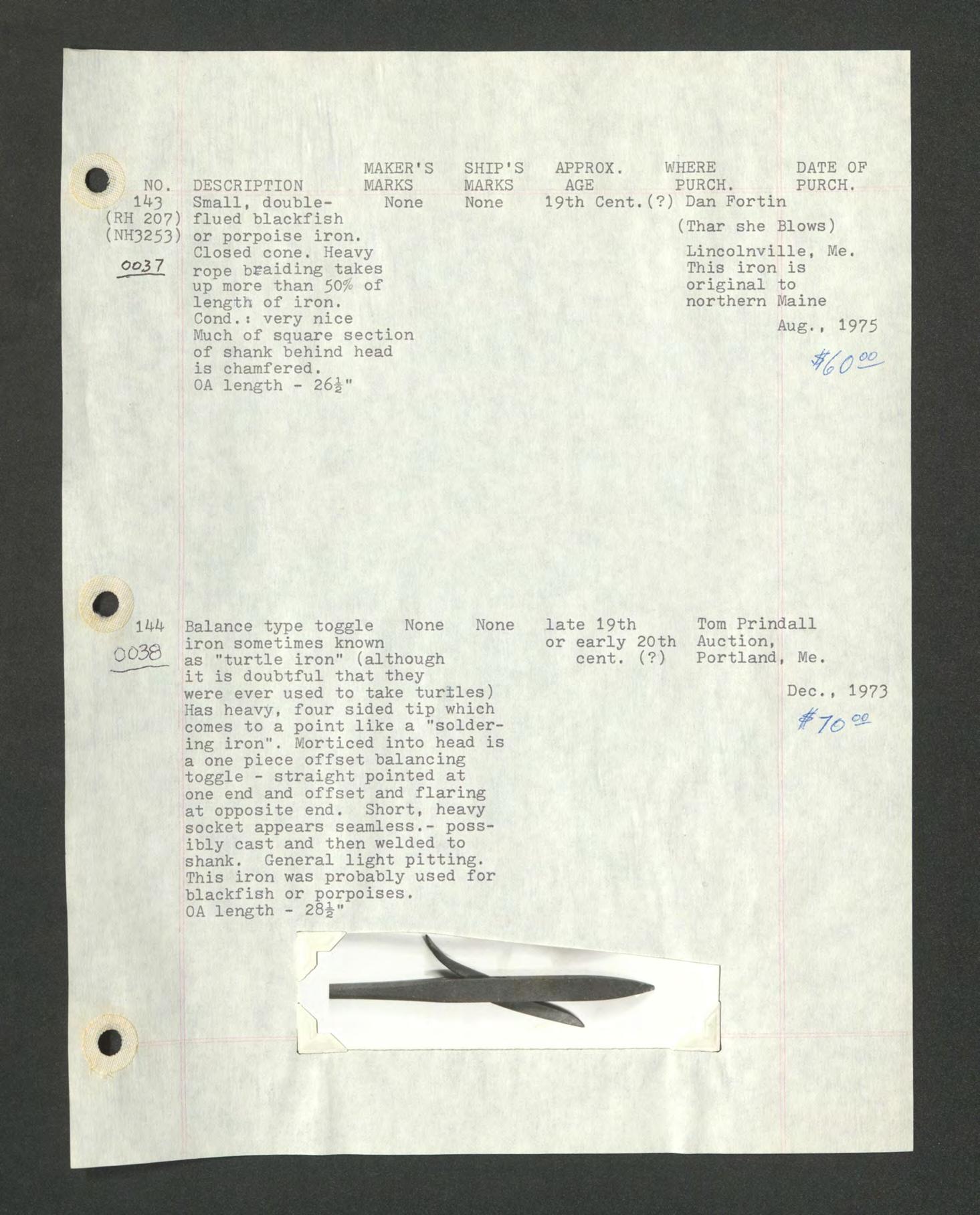
MAKER'S
P NO. DESCRIPTION MARKS
1^3 Small, double- None (RH 207) flued blackfish (NH3253) or porpoise iron. Closed cone. Heavy rope braiding takes up more than 50% of length of iron.
oo37
Cond.: very nice Much of square section of shank behind head is chamfered.
OA length - 26^"
SHIP'S APPROX. WHERE DATE OF MARKS AGE PURCH. PURCH. None 19th Cent.(?) Dan Fortin (Thar she Blows) Lincolnville, Me. This iron is original to northern Maine
Aug., 1975
00
Balance type toggle None None iron sometimes known as "turtle iron" (although it is doubtful that they were ever used to take turtles) Has heavy, four sided tip which comes to a point like a "soldering iron". Morticed into head is a one piece offset balancing toggle - straight pointed at one end and offset and flaring at opposite end. Short, heavy socket appears seamless.- possibly cast and then welded to shank. General light pitting. This iron was probably used for blackfish or porpoises.
OA length - 28-|"
late 19th or early 20th cent. (?) Tom Prindall Auction, Portland, Me.
Dec., 1973 CJ
No. DESCRIPTION
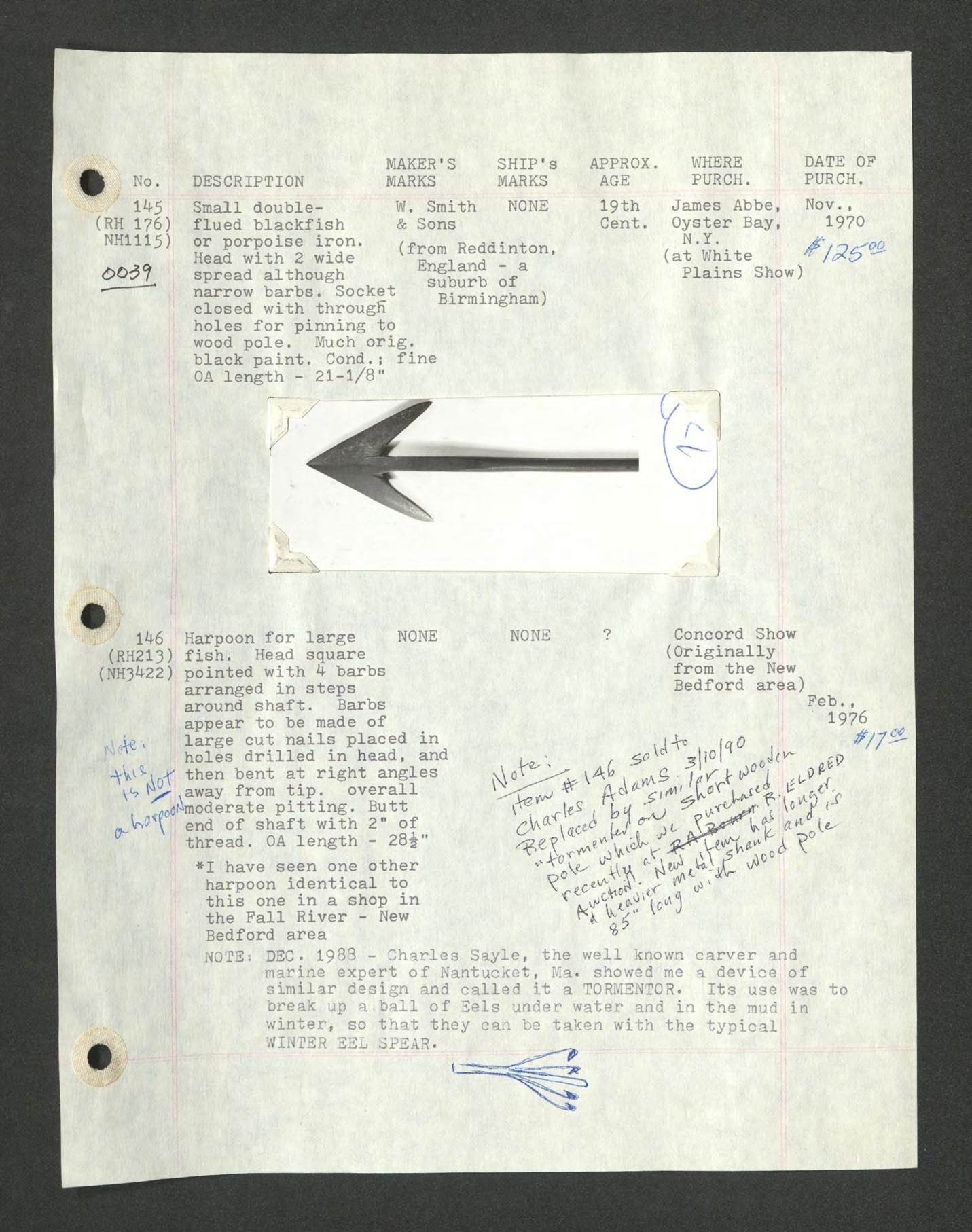
MAKER'S MARKS
145 Small double- W. Smith (RH 176) flued blackfish & Sons NH1115) or porpoise iron. Head with 2 wide £03°\ spread although """ " narrow barbs. Socket closed with through holes for pinning to wood pole. Much orig. black paint. Cond.; fine OA length - 21-1/8"
SHIP'S MARKS
NONE
(from Reddinton, England - a suburb of Birmingham)
APPROX, AGE 19th Cent.
WHERE PURCH.
DATE OF PURCH.
James Abbe, Nov., Oyster Bay, 1970
(at White flZg' Plains Show) 00.
146 Harpoon for large NONE (RH213) fish. Head square (NH3422) pointed with 4 barbs arranged in steps around shaft. Barbs appear to be made of J) large cut nails placed in holes drilled in head, and -\VSn< then bent at right angles vsN^.awav from tip. overall
Vs? vbZ away from tip .^moderate pitting. Butt W t
end of shaft with 2" of thread. OA length - 28-§"
*1 have seen one other harpoon identical to this one in a shop in the Fall River - New Bedford area
Concord Show (Originally from the New Bedford area)
Feb. , 1976 */7
NOTEs DEC. 1983 - Charles Sayle, the well known carver and marine expert of Nantucket, Ma. showed me a device of similar design and called it a TORMENTOR. Its use was to break up a ball of Eels under water and in the mud in winter, so that they can be taken with the typical WINTER EEL SPEAR.
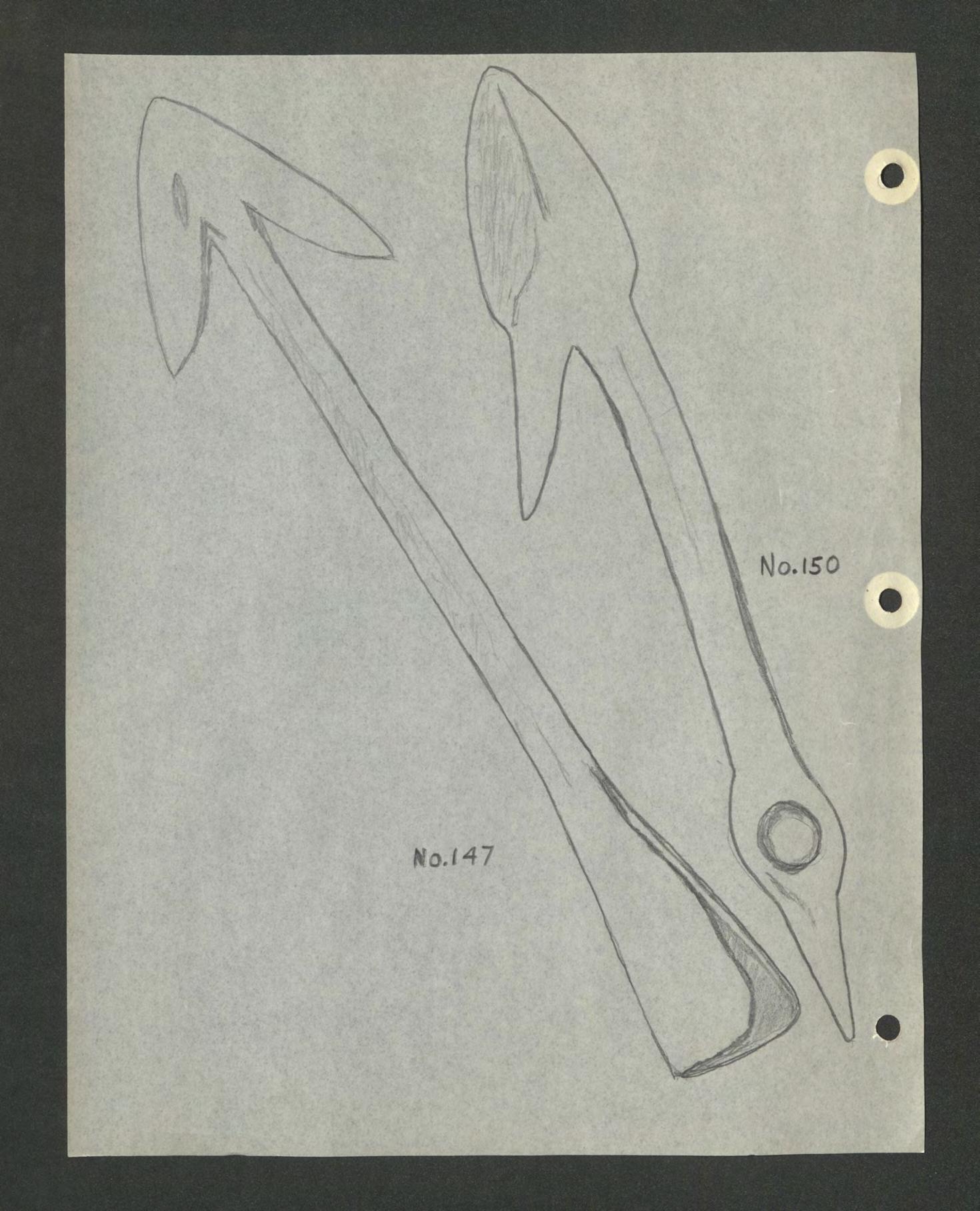
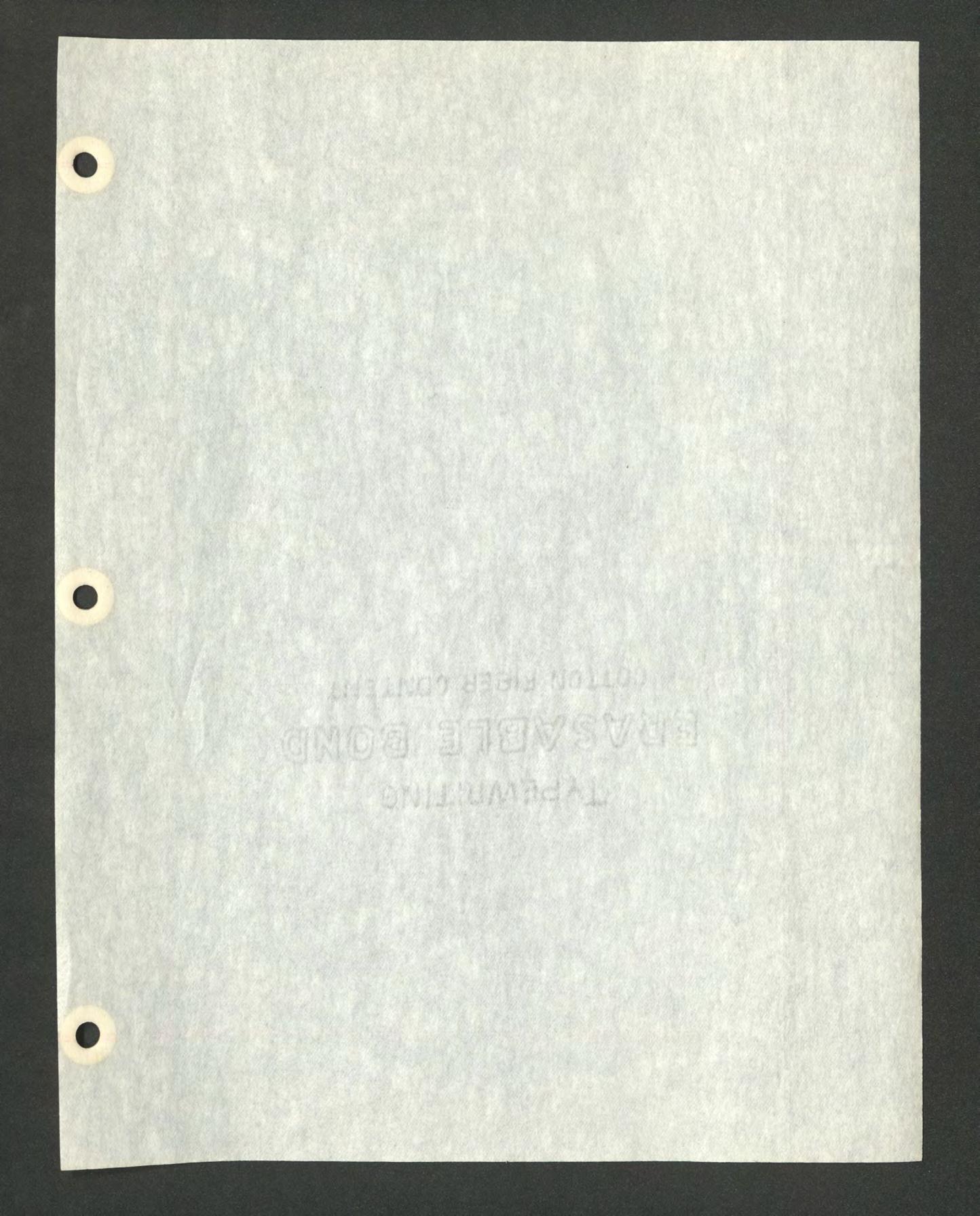
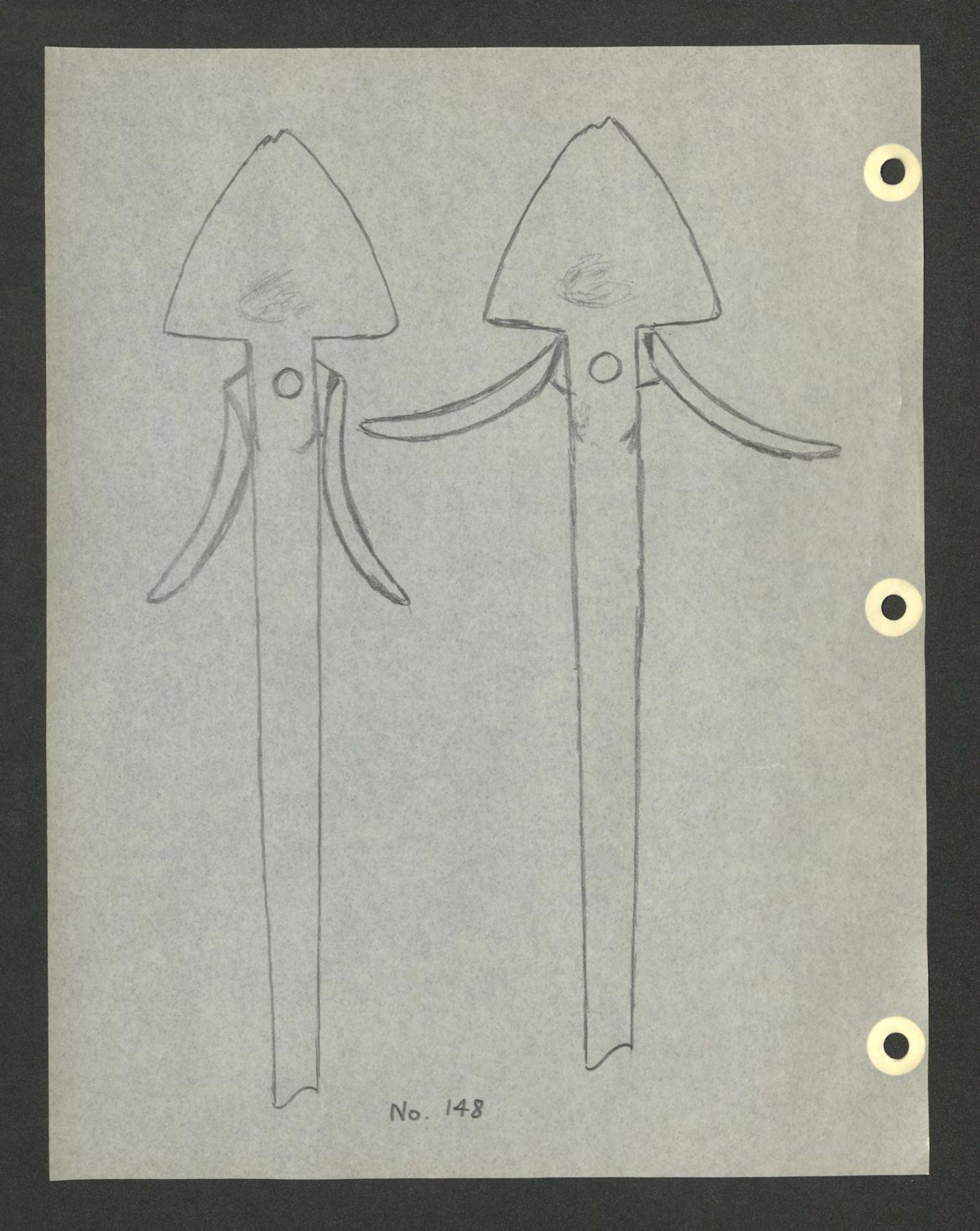
NO.
147 (NH3859) OMO
DESCRIPTION
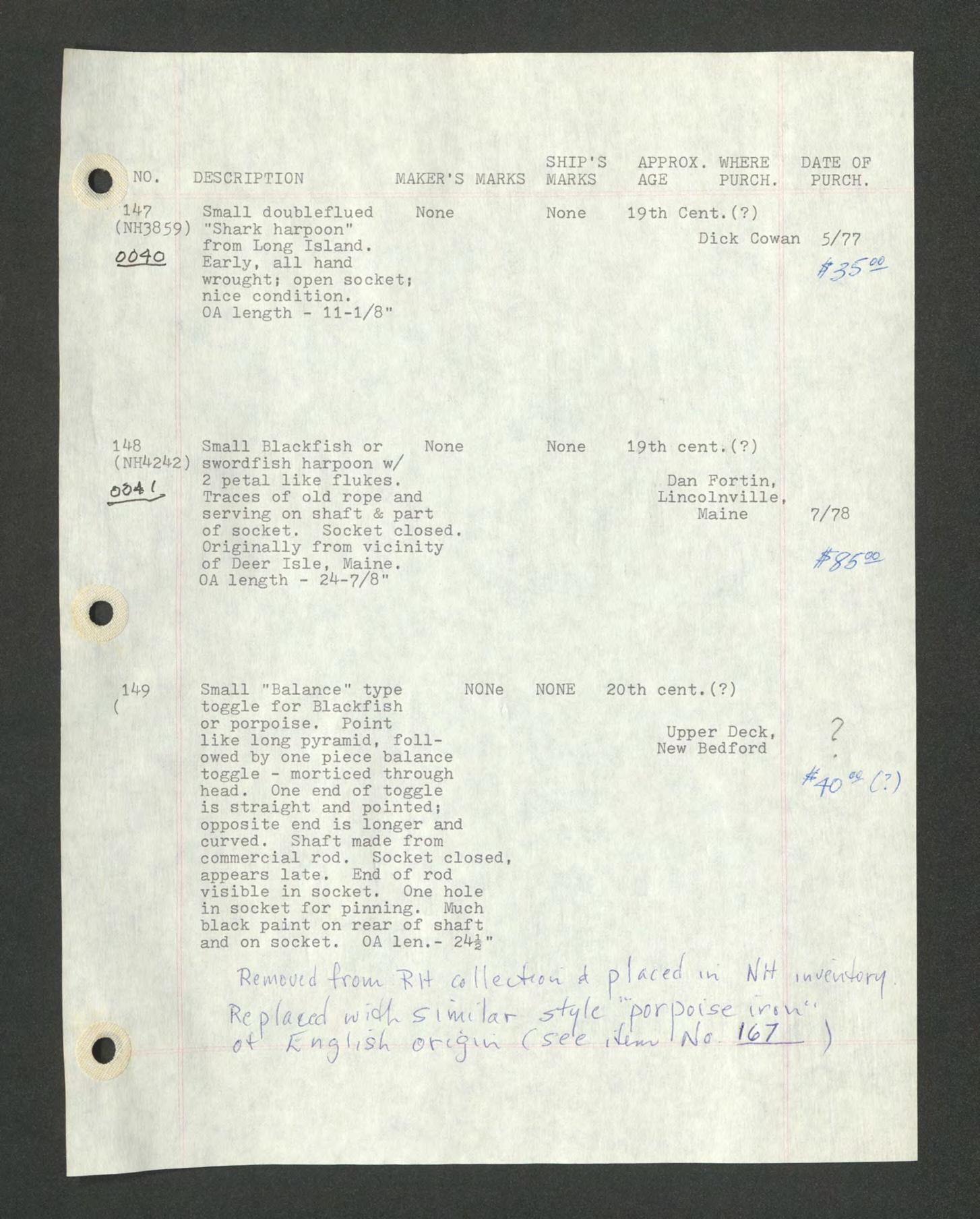
MAKER'S MARKS
Small doubleflued "Shark harpoon" from Long Island. Early, all hand wrought; open socket; nice condition. OA length - 11-1/8"
None
SHIP'S MARKS
None
APPROX AGE WHERE PURCH.
19th Cent.(?)
DATE OF PURCH.
Dick Cowan 5/77
148 Small Blackfish or None (NH4242) swordfish harpoon w/ oM 1 2 petal like flukes. Traces of old rope and serving on shaft & part of socket. Socket closed. Originally from vicinity of Deer Isle, Maine. OA length - 24-7/8"
None 19th cent.(?)
Dan Fortin, Lincolnville, Maine 7/78
OO,
149 Small "Balance" type toggle for Blackfish or porpoise. Point like long pyramid, followed by one piece balance toggle - morticed through head. One end of toggle is straight and pointed; opposite end is longer and curved. Shaft made from commercial rod. Socket closed, appears late. End of rod visible in socket. One hole in socket for pinning. Much black paint on rear of shaft and on socket. OA len.- 24|"
NONe NONE 20thcent.(?)
Upper Deck, New Bedford ? * *a)
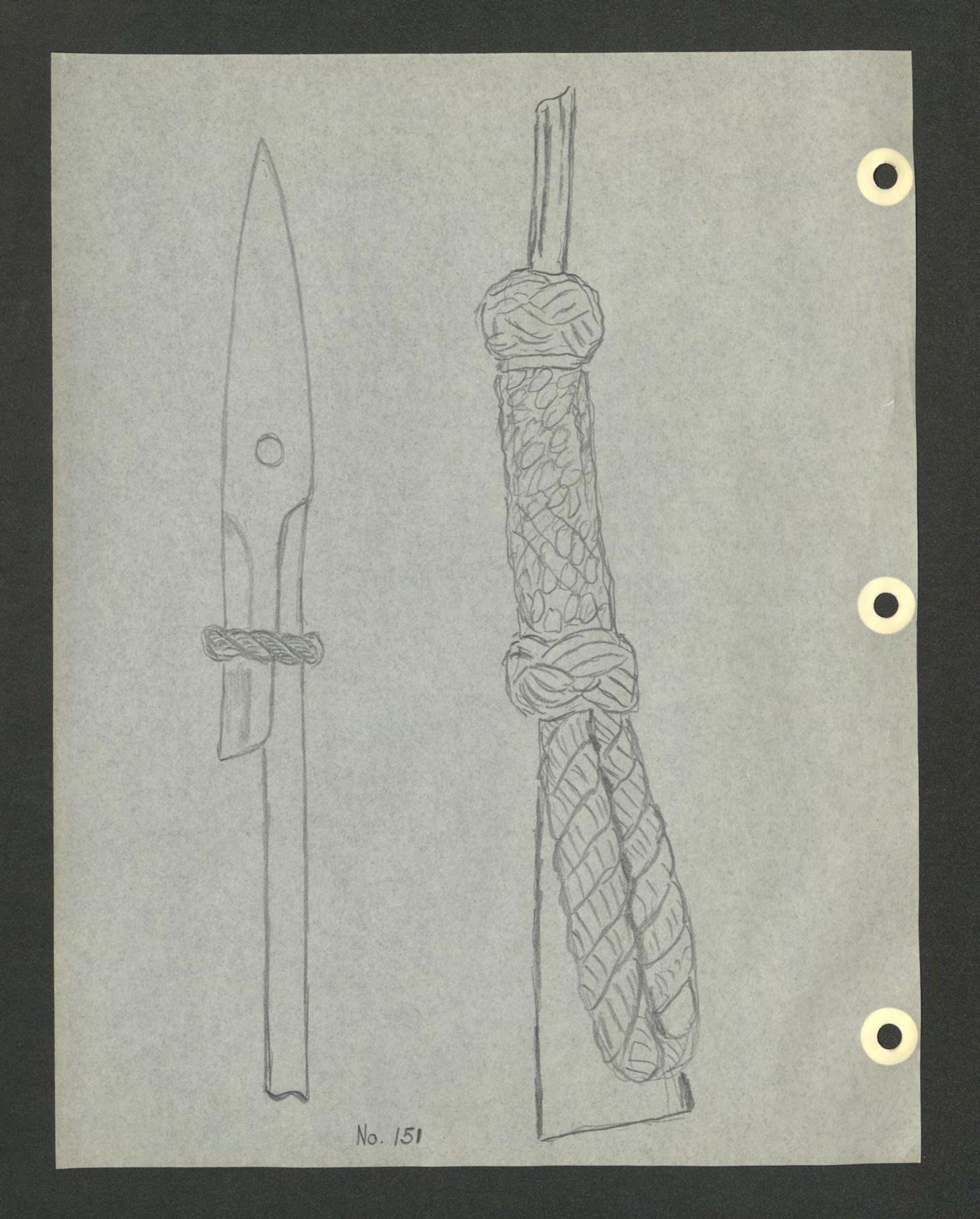
NO.
150 DESCRIPTION
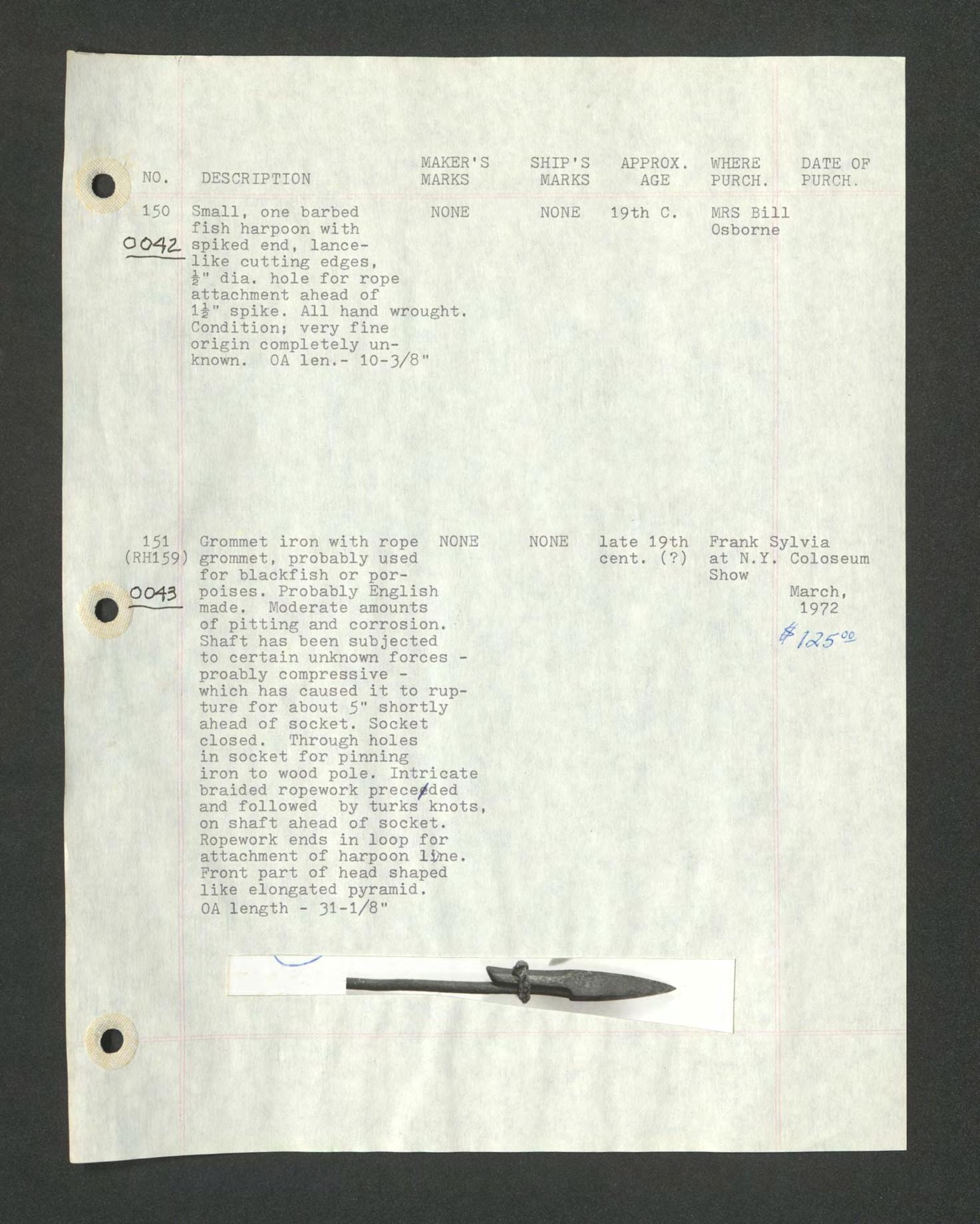
MAKER'S MARKS
NONE Small, one barbed fish harpoon with 00^2.spiked end, lance" like cutting edges, i" dia. hole for rope attachment ahead of li" spike. All hand wrought. Condition; very fine origin completely unknown. OA len.- 10-3/8"
SHIP'S MARKS
NONE APPROX. AGE 19th C. WHERE PURCH. MRS Bill Osborne
DATE OF PURCH.
151 Grommet iron with rope NONE (RH159) grommet, probably used for blackfish or porOCH3 poises. Probably English -— made. Moderate amounts of pitting and corrosion. Shaft has been subjected to certain unknown forcesproably compressivewhich has caused it to rupture for about 5" shortly ahead of socket. Socket closed. Through holes in socket for pinning iron to wood pole. Intricate braided ropework preceded and followed by turks knots, on shaft ahead of socket. Ropework ends in loop for attachment of harpoon line. Front part of head shaped like elongated pyramid. OA length - 31-1/8"
March, 1972
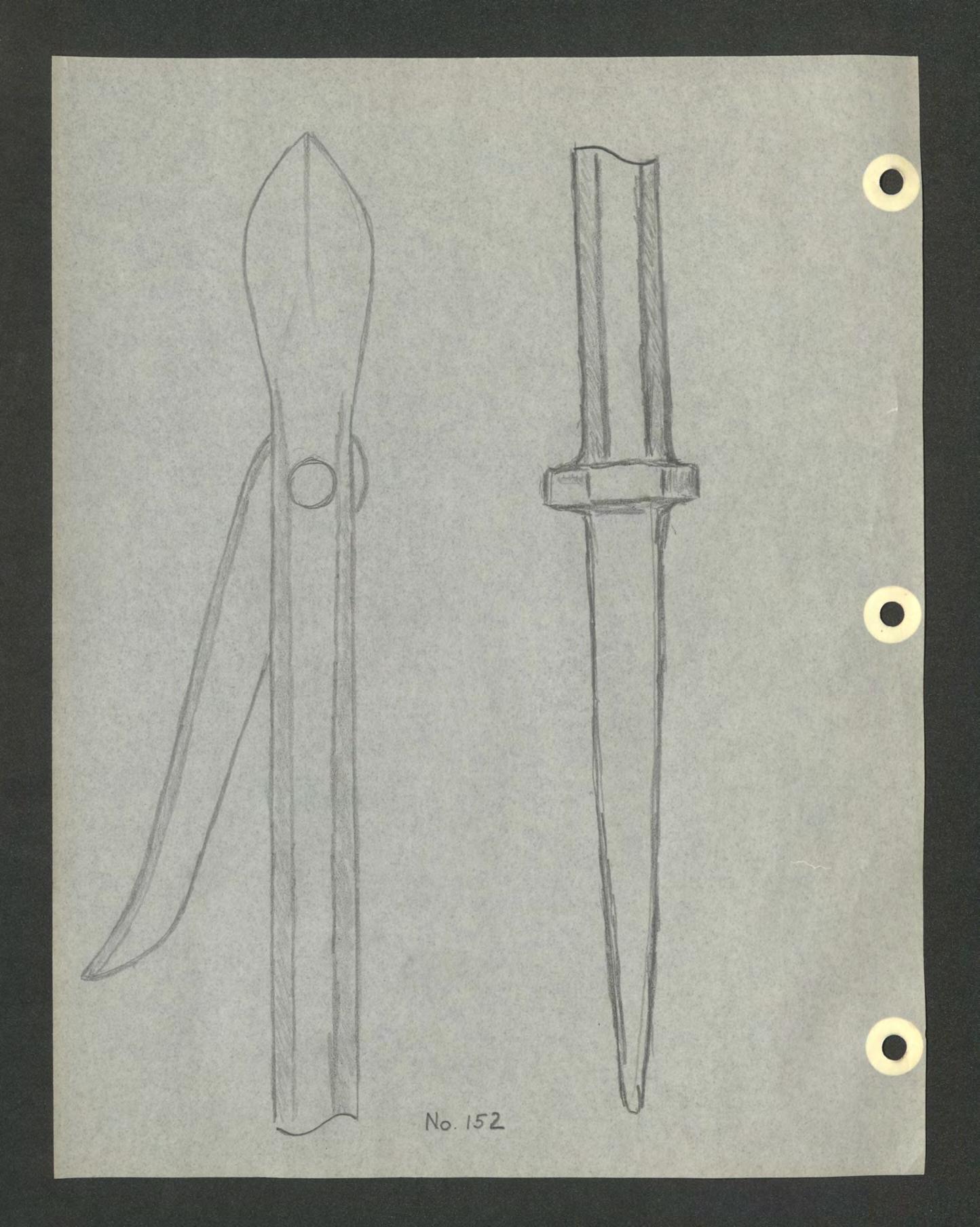
NO. DESCRIPTION
<3^44
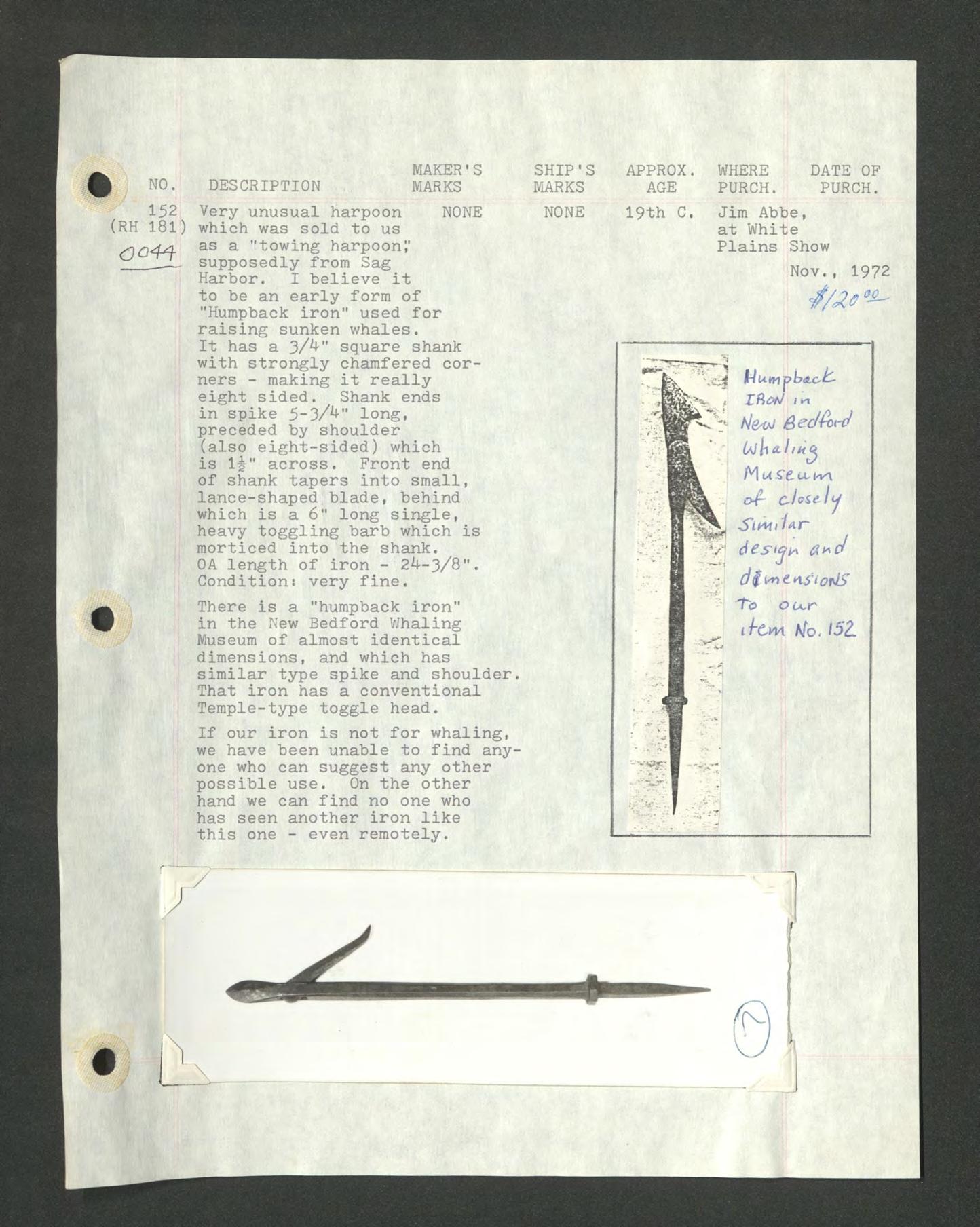
MAKER'S MARKS
NONE
152 Very unusual harpoon (RH 181) which was sold to us as a "towing harpoon" supposedly from Sag Harbor. I believe it to be an early form of "Humpback iron" used for raising sunken whales. It has a 3/4" square shank with strongly chamfered corners - making it really eight sided. Shank ends in spike 5-3/4" long, preceded by shoulder (also eight-sided) which is l|f" across. Front end of shank tapers into small, lance-shaped blade, behind which is a 6" long single, heavy toggling barb which is morticed into the shank. OA length of iron - 24-3/8". Condition: very fine. There is a "humpback iron" in the New Bedford Whaling Museum of almost identical dimensions, and which has similar type spike and shoulder, That iron has a conventional Temple-type toggle head.
If our iron is not for whaling, we have been unable to find anyone who can suggest any other possible use. On the other hand we can find no one who has seen another iron like this one - even remotely.
SHIP'S MARKS
NONE APPROX. AGE 19th C.
WHERE PURCH.
DATE OF PURCH. Jim Abbe, at White Plains Show Nov., 1972 •f/Jle bdLcteZP>o/J ir-1 hl&oJ &ec!£od (AJIMX.1 /Hg M u £t u~ im c-iostly Sim 1 1*r design d$\-n£>\SiorS To ou*r ibtm Afo.'52.
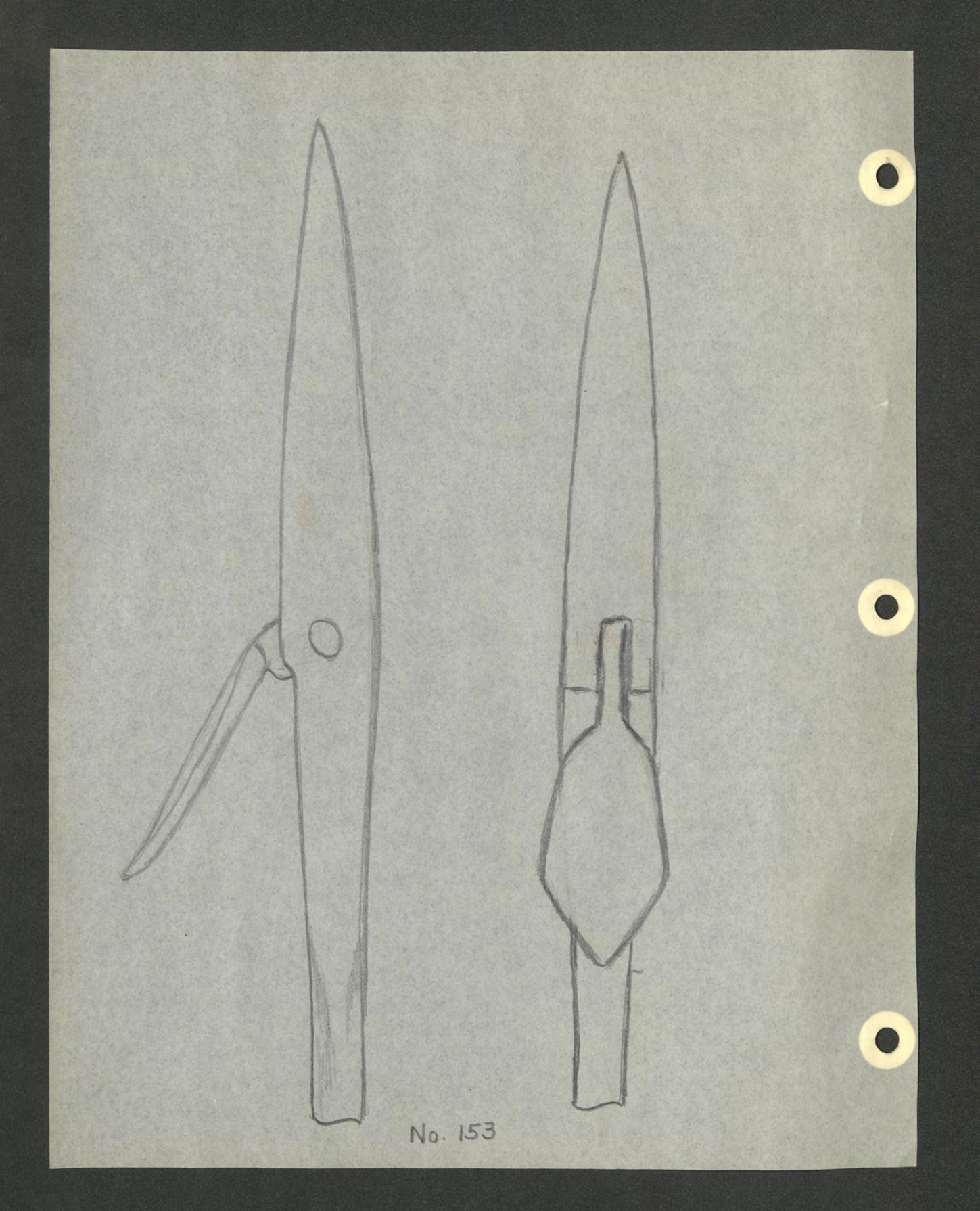
MAKER'S NO. DESCRIPTION MARKS
153 Fairly late por- wn „ (RH217) poise iron with 4" \long pyramid shaped head followed by single flat leaf shaped moveable barb which lays very flat against shank in closed position. Shank very heavy (§" dia.). Socket partially closed, applied to shank so that end of shank is visible within socket. Single hole in socket for pinning to wood pole. OA len.- 28".
Very fine cond. Harpoon has sheath made of brass tubing with wooden insert shaped to fit harpoon point, jAlso provided with canvas 'covering bag and draw string. Most probably English made.
SHIP'S APPROX. WHERE DATE MARKS AGE PURCH. OF PUR.
NONE early 20th Franklin 1/24/74 cent. Institute Of Phila. Sale of surplus "attic" items I
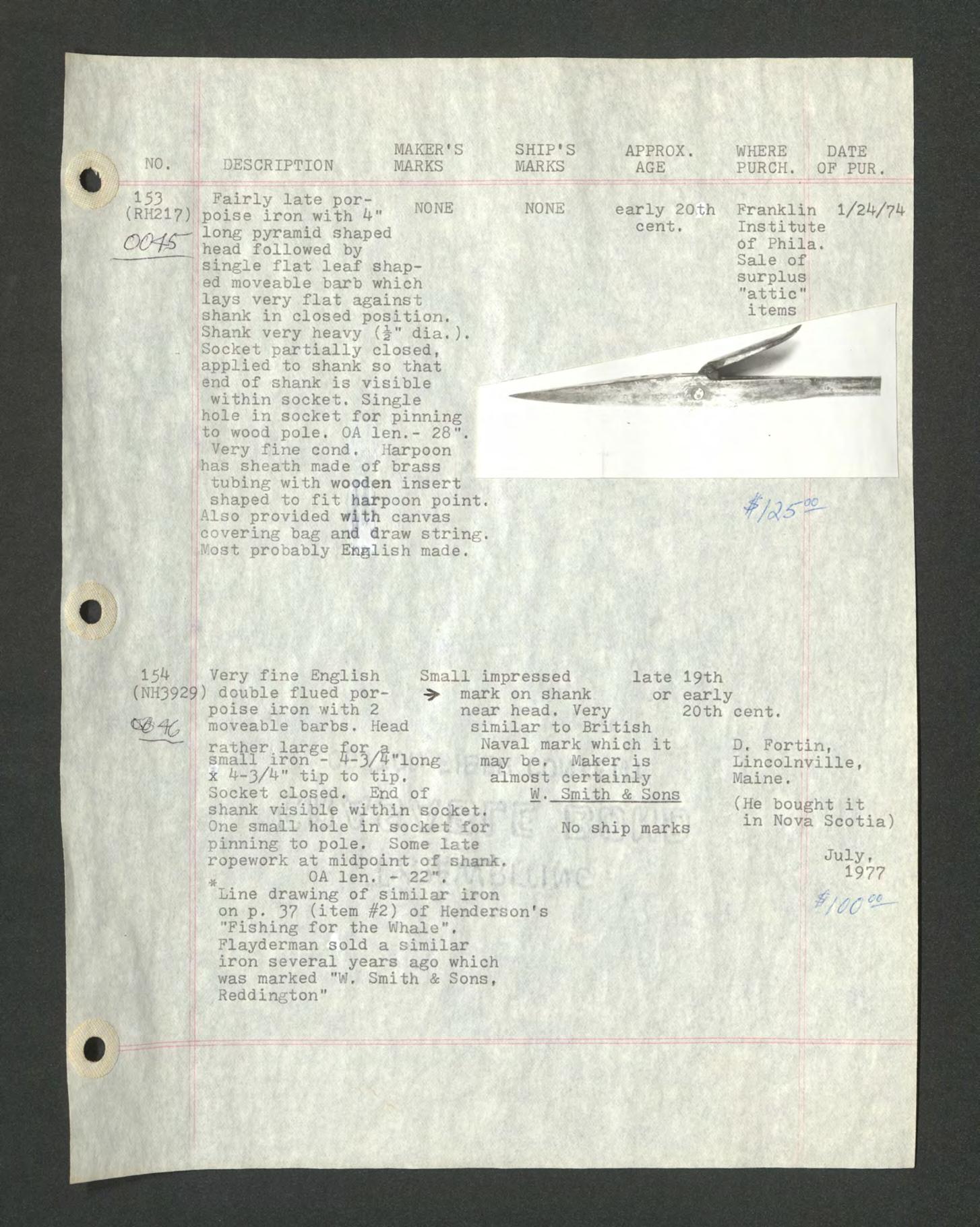
154 Very fine English (NH3929) double flued porpoise iron with 2 moveable barbs. Head rather large for.a small iron - 4-3/4"long x 4-3/4" tip to tip. Socket closed. End of _ shank visible within socket. One small hole in socket for pinning to pole. Some late ropework at midpoint of shank. # OA len. - 22".
Small impressed
mark on shank near head. Very similar to British Naval mark which it may be. Maker is almost certainly W. Smith & Sons
late 19th or early 20th cent.
D. Fortin, Lincolnville, Maine, (He bought it in Nova Scotia)
No ship marks
July, 1977
Line drawing of similar iron on p. 3?(item #2) of Henderson's "Fishing for the Whale", Flayderman sold a similar iron several years ago which was marked "W. Smith &Sons, Reddington"


NO. 155
<309-7
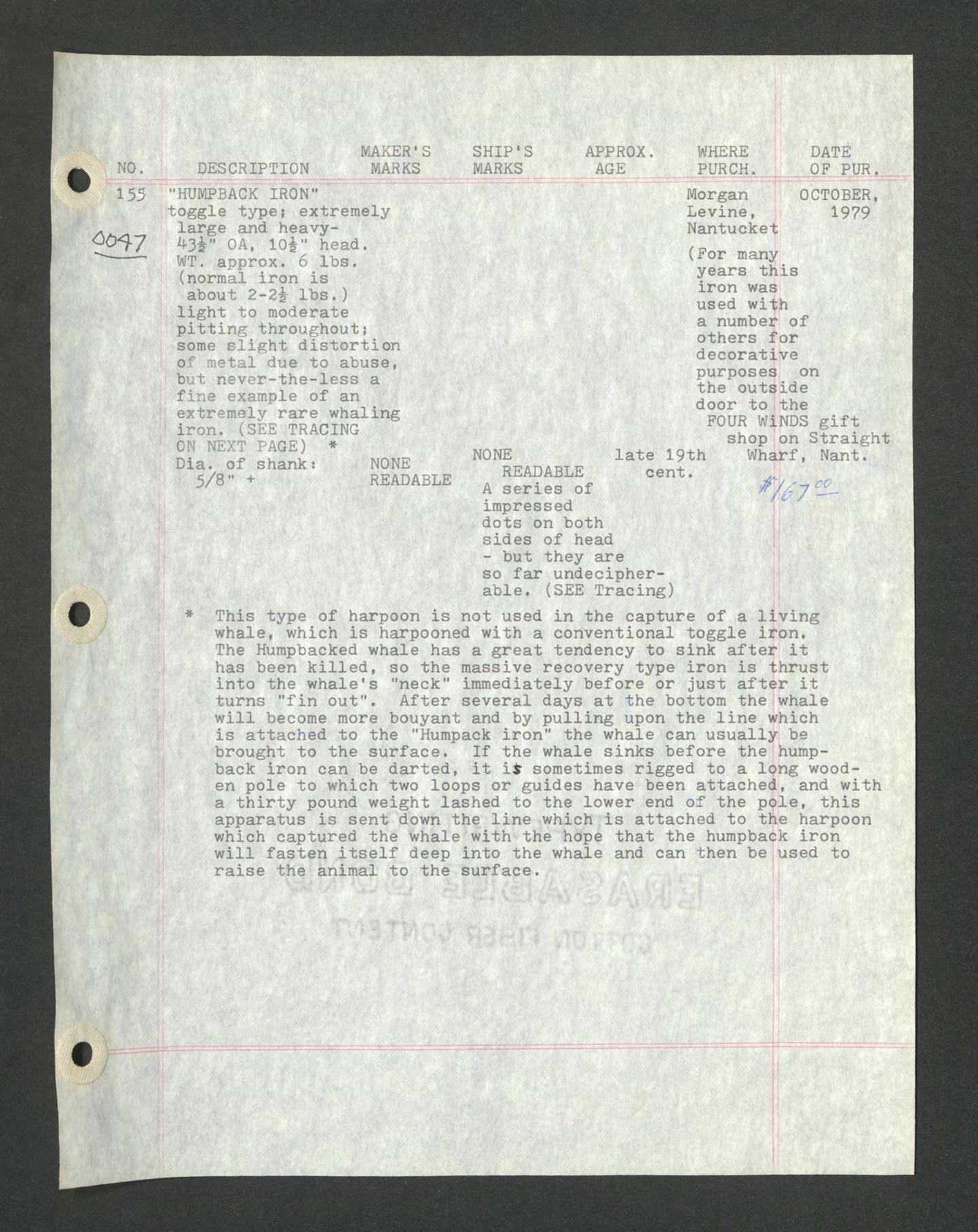
DESCRIPTION
"HUMPBACK IRON"
MAKER*i MARKS SHIP'S MARKS APPROX, AGE
toggle type? extremely large and heavyOA, 10|" head.
WT. approx, 6 lbs. (normal iron is about 2-2^ lbs.) light to moderate pitting throughout! some slight distortion of metal due to abuse, but never-the-less a fine example of an extremely rare whaling iron. (SEE TRACING ON NEXT PAGE) *
Dia. of shanks 5/8" +
NONE READABLE
WHERE PURCH. Morgan Levine, Nantucket
DATE OF PUR.
OCTOBER, 1979
(For many years this iron was used with a number of others for decorative purposes on the outside door to the FOUR WiNDS gift shop on Straight Wharf, Nant. CO NONE late 19th READABLE cent. A series of impressed dots on both sides of head - but they are so far undecipherable. (SEE Tracing)
This type of harpoon is not used in the capture of a living whale, which is harpooned with a conventional toggle iron. The Humpbacked whale has a great tendency to sink after it has been killed, so the massive recovery type iron is thrust into the whale's "neck" immediately before or just after it turns "fin out". After several days at the bottom the whale will become more bouyant and by pulling upon the line which is attached to the "Humpack iron" the whale can usually be brought to the surface. If the whale sinks before the humpback iron can be darted, it it sometimes rigged to a long wooden pole to which two loops or guides have been attached, and with a thirty pound weight lashed to the lower end of the pole, this apparatus is sent down the line which is attached to the harpoon which captured the whale with the hope that the humpback iron will fasten itself deep into the whale and can then be used to raise the animal to the surface.
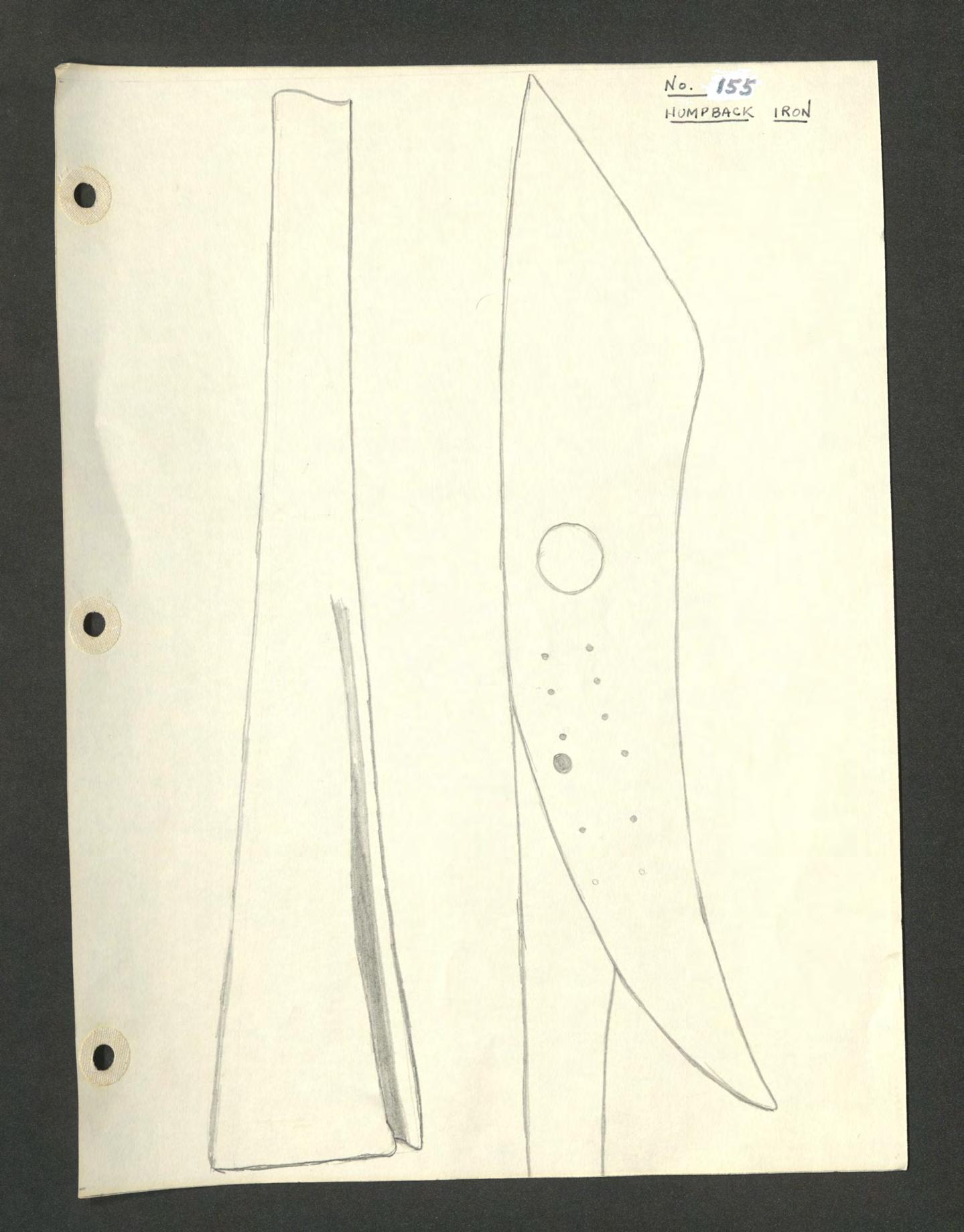
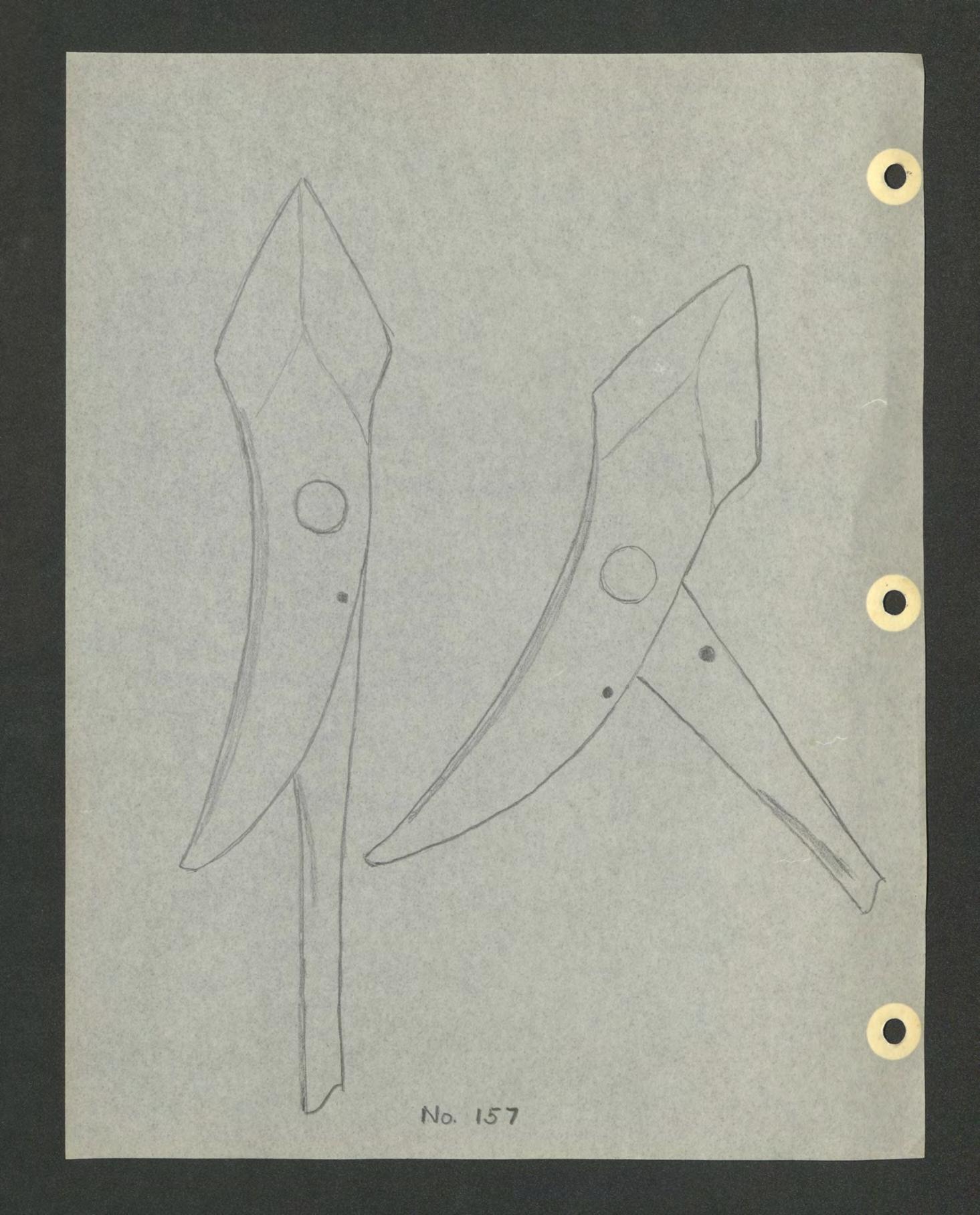
NO. ' 156 pW+f*?
004?
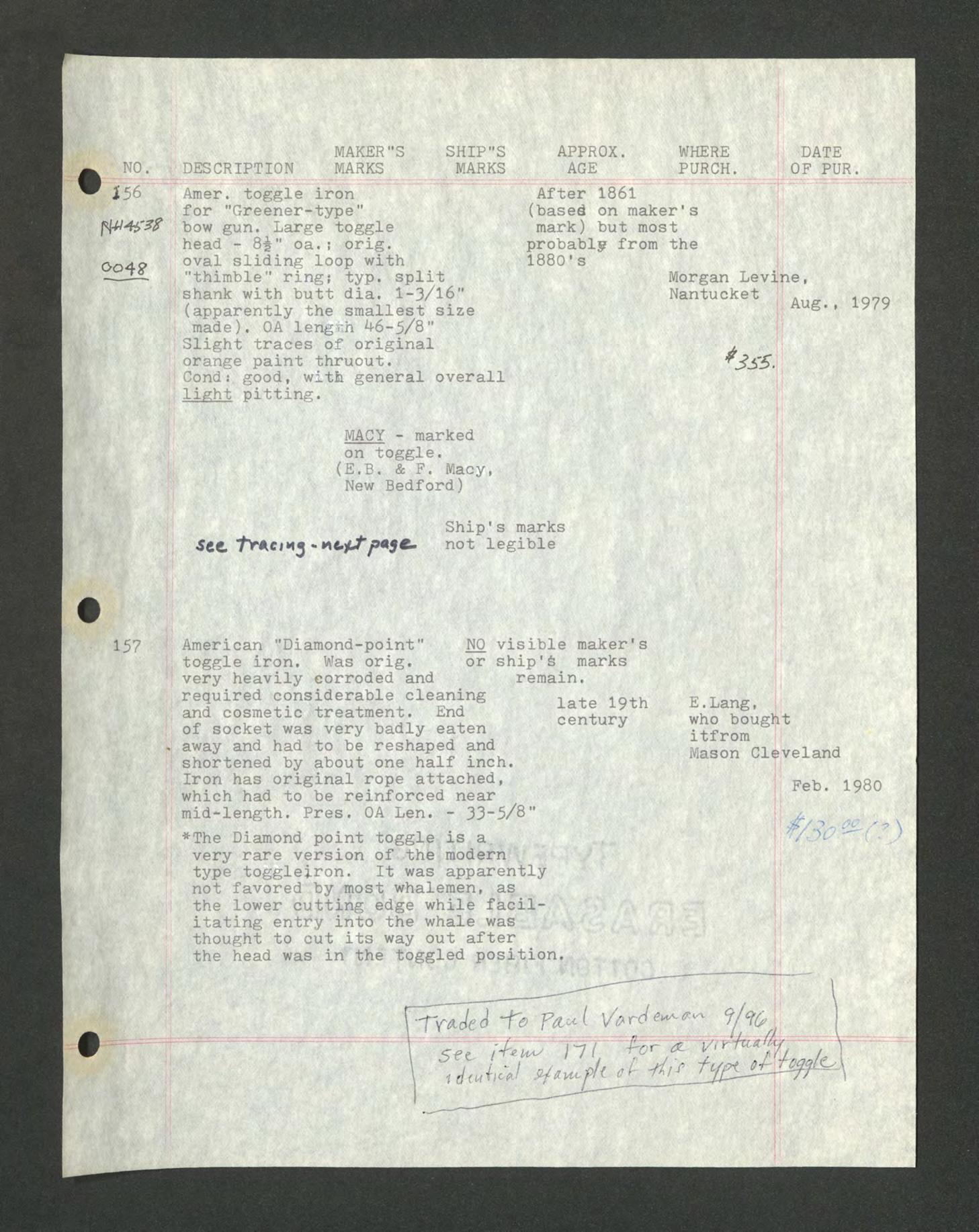
DESCRIPTION
MAKER"S MARKS SHIP"S MARKS
Amer. toggle iron for "Greener-type" bow gun. Large toggle head - 8-|" oa.; orig. oval sliding loop with "thimble" rings typ. split shank with butt dia. 1-3/16" (apparently the smallest size made). OA lengrh 46-5/8" Slight traces of original orange paint thruout. Conds good, with general overall light pitting.
MACY - marked on toggle. (E.B. & F. Macy, New Bedford)
APPROX. WHERE DATE AGE PURCH. OF PUR.
After 1861 (based on maker's mark) but most probably from the 1880's
Morgan Levine, Nantucket Aug_ _ W9
*3S5.
•See"tr*eifJt Ship's marks not legible
157 American "Diamond-point" NO visible maker's toggle iron. Was orig. or ship's marks very heavily corroded and remain, required considerable cleaning and cosmetic treatment. End of socket was very badly eaten away and had to be reshaped and shortened by about one half inch. Iron has original rope attached, which had to be reinforced near mid-length. Pres. OA Len. - 33-5/8"
late 19th century
*The Diamond point toggle is a very rare version of the modern type toggleiron. It was apparently not favored by most whalemen, as the lower cutting edge while facilitating entry into the whale was thought to cut its way out after the head was in the toggled position.
E.Lang, who bought itfrom Mason Cleveland Feb. 1980 'fr & rty^cW P& ' Vfird ^ cr[% Per a VivMxVy iPpp j "7 / " O" - / , /. \ iPi/i hc// ptvivfit p \
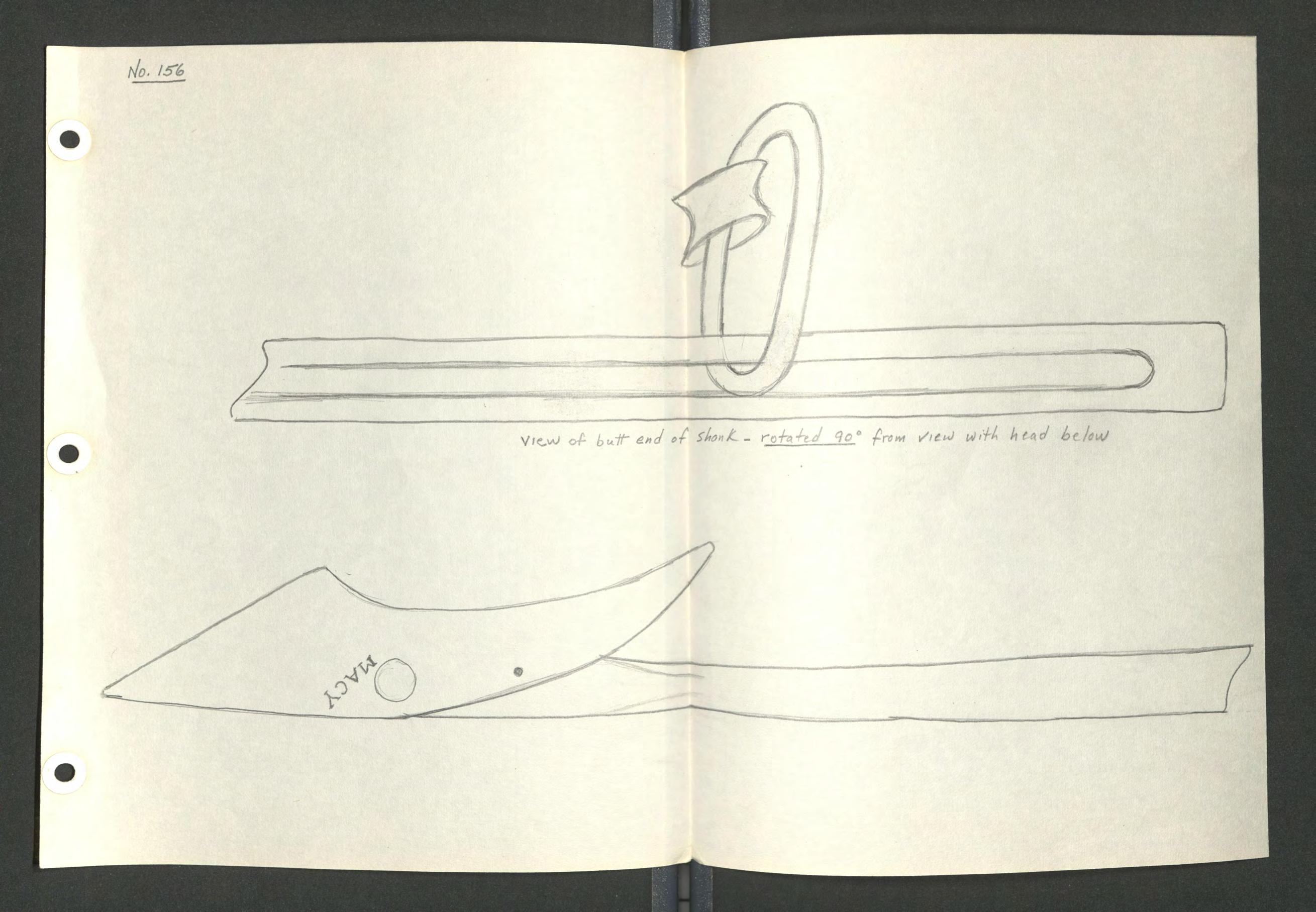
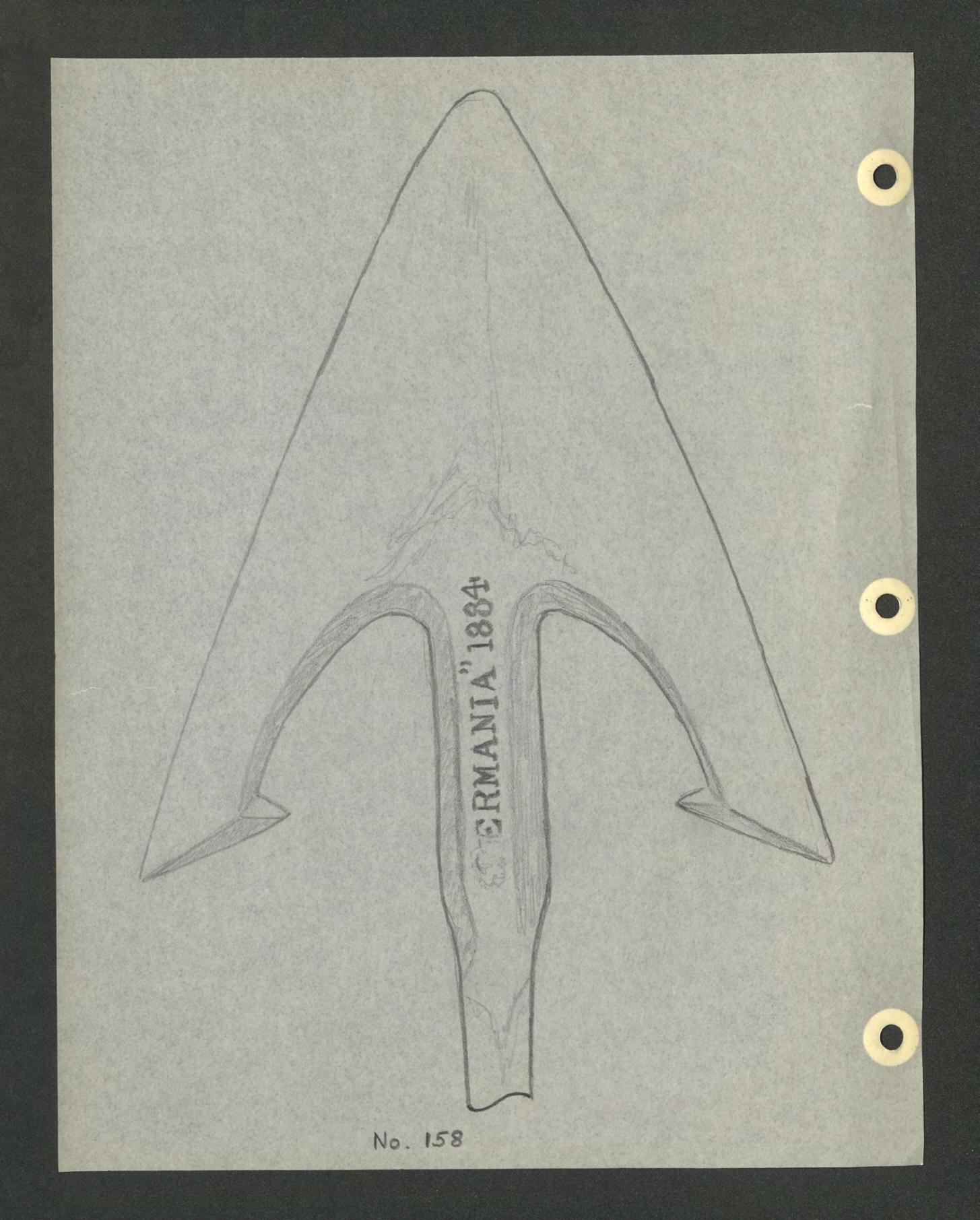
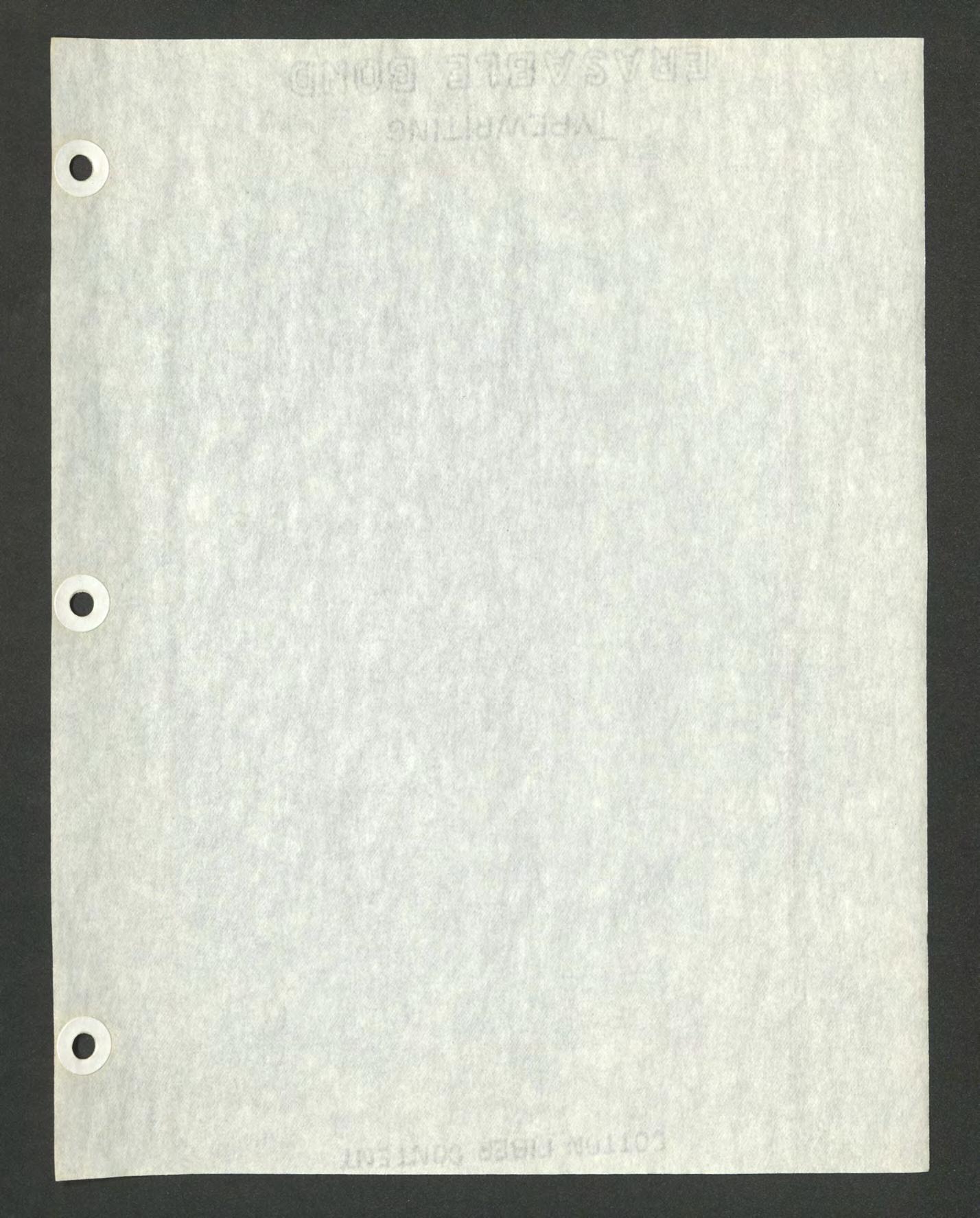
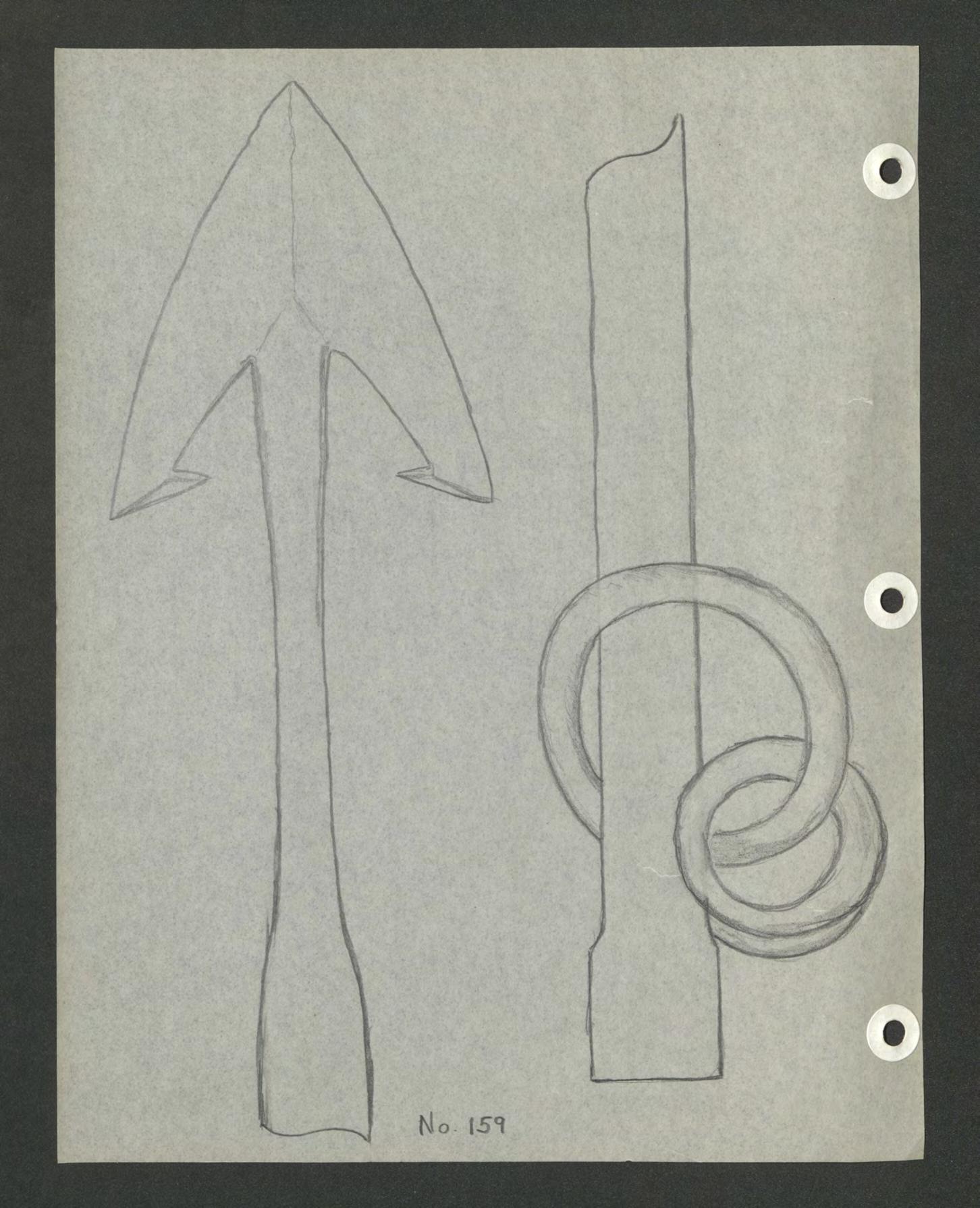
158
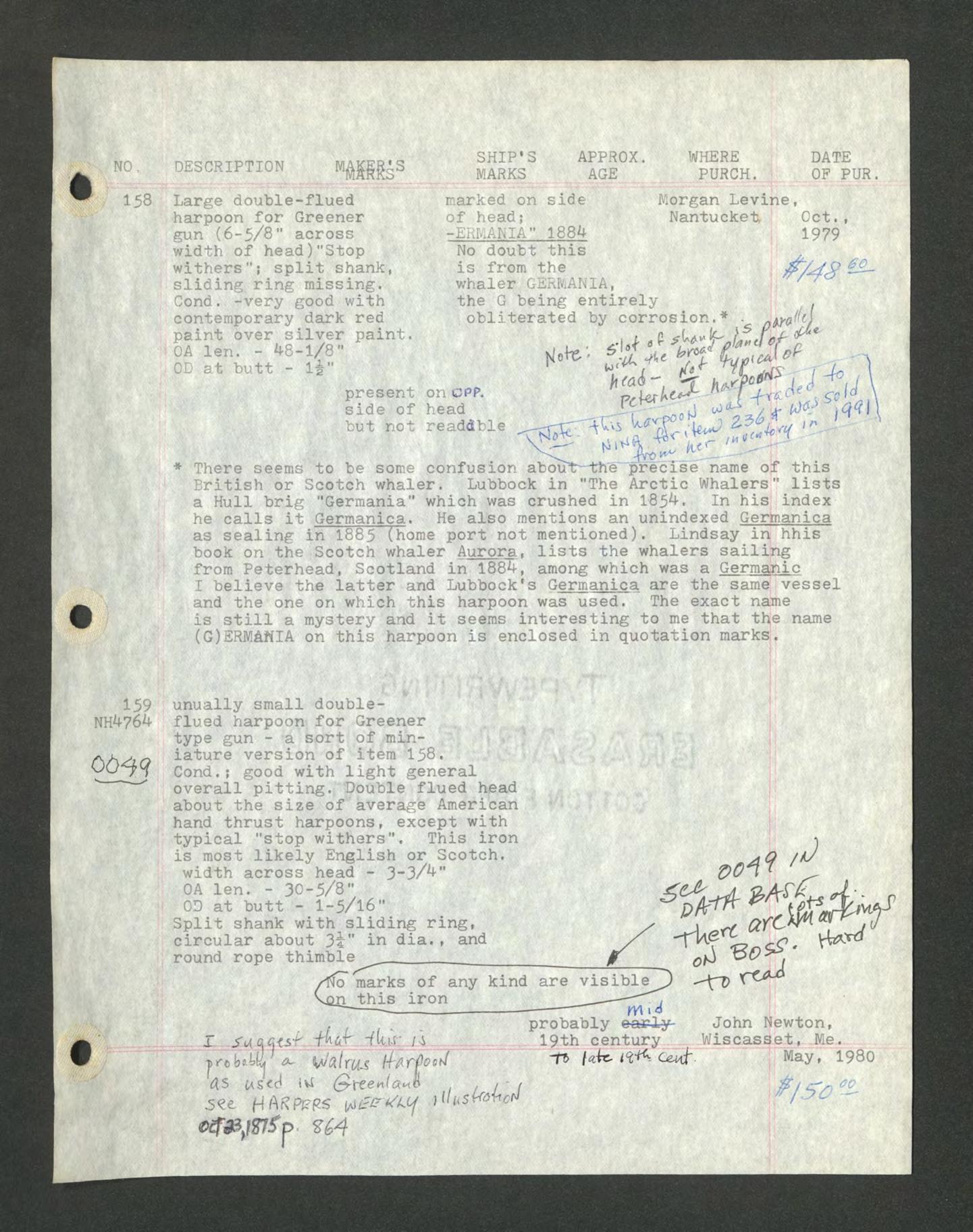
DESCRIPTION
Large double-flued harpoon for Greener gun (6-5/8" across width of head)"Stop withers"} split shank, sliding ring missing. Cond. -very good with contemporary dark red paint over silver paint.
OA len. - *1-8-1/8"
OD at butt - li"
SHIP'S MARKS
APPROX. WHERE AGE PURCH.
marked on side of head} -ERMANIA" 1884 No doubt this is from the whaler GERMANIA, the G being entirely obliterated by corrosion.*
Morgan Levine, Nantucket.
present on CPP. side of head but not readable
There seems to be some confusion abou British or Scotch whaler. Lubbock in a Hull brig "Germania" which was crushed in 185**-. In his index he calls it Germanica. He also mentions an unindexed Germanica as sealing in 1885 (home port not mentioned). Lindsay in hhis book on the Scotch whaler Aurora, lists the whalers sailing from Peterhead, Scotland in I88*i-, among which was a Germanic I believe the latter and Lubbock's Germanica are The the same vessel exact name and the one on which this harpoon was used, is still a mystery and it seems interesting to me that the name (G)ERMAfilA on this harpoon is enclosed in quotation marks.
159 NH476*1 unually small doubleflued harpoon for Greener type gun - a sort of miniature version of item 158.
Cond.j good with light general overall pitting. Double flued head about the size of average American hand thrust harpoons, except with typical "stop withers". This iron is most likely English or Scotch, width across head - 3-3/^"
OA len. - 30-5/8"
OD at butt - 1-5/16"
Split shank with sliding ring, circular about 3i" in dia., and round rope thimble
the precise name of this "The Arctic Whalers" lists
to marks of any kind are visible m this iron
fb hub -cs-k ihcit ikjr JA o~ IrArPo™
AS iAs/d iv£ Q-Xte0a«.K / J'( (MAf?Pi?£S (a)iFtrtSLOf * Kusrtohefi pprobably early19th century TE> 0^- It^- Aen/
John Newton, Wiscasset, Me.
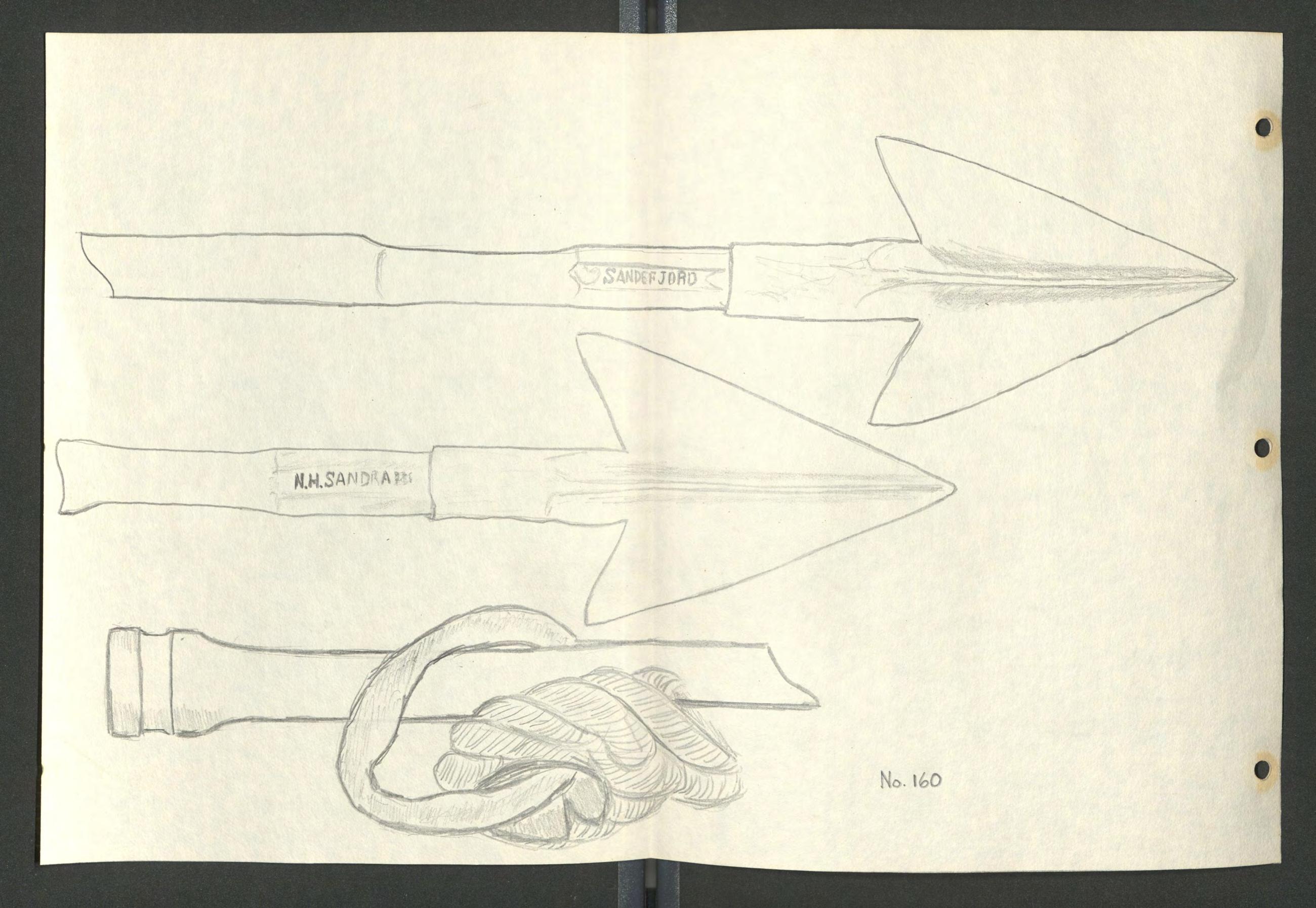
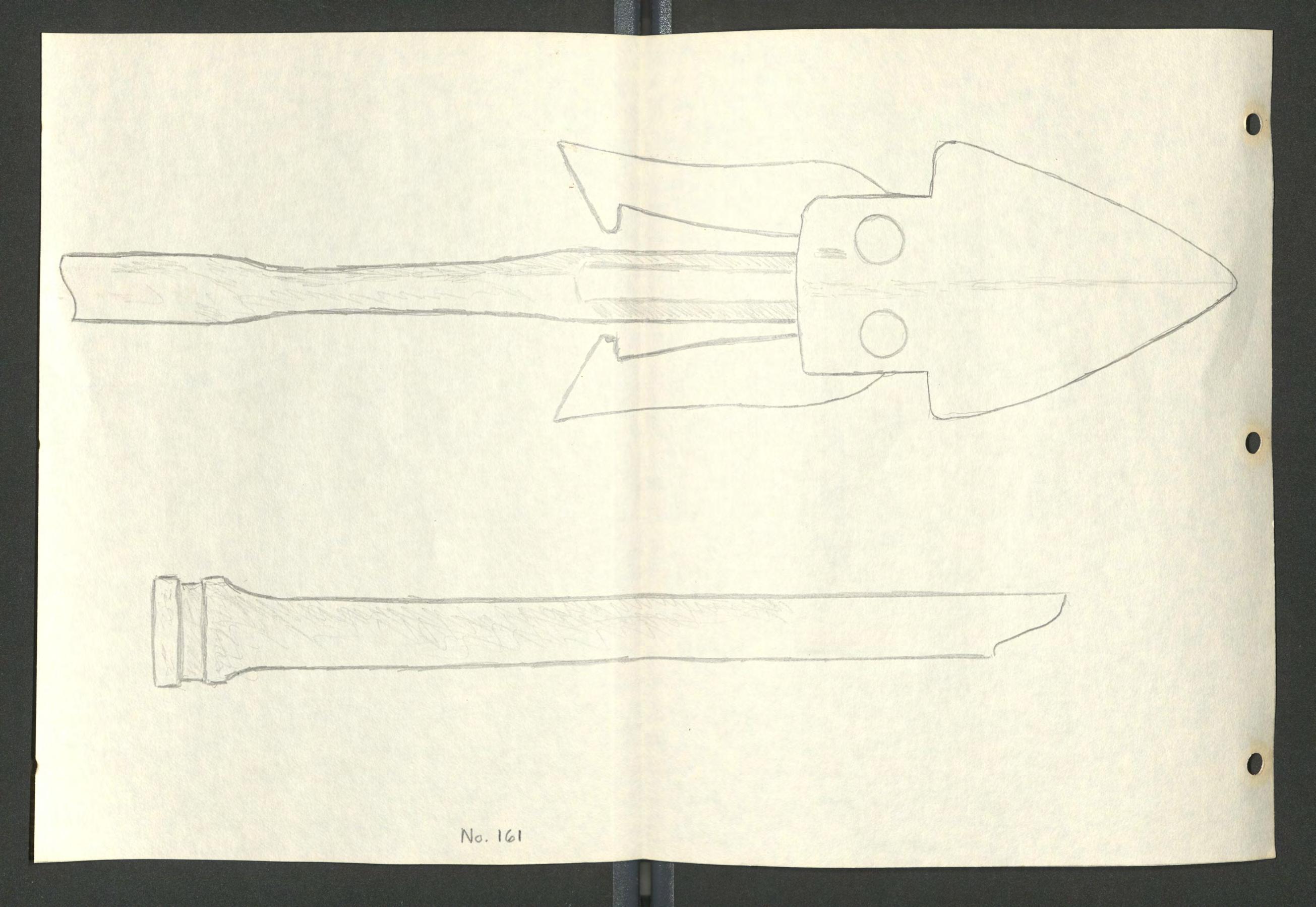
NO. DESCRIPTION
160 Large Norwegian Greener gun iron.
MAKER'S MARKS SHIP'S MARKS APPROX. AGE WHERE PURCH.
marked on side of shank behind head: ft ft)
OO&O Unusual double flued head - possibly a repair or replacement (see tracing)
Width across head - 3-3/^"
OA length - 4-6-3/8"
OD at butt - 1-7/16"
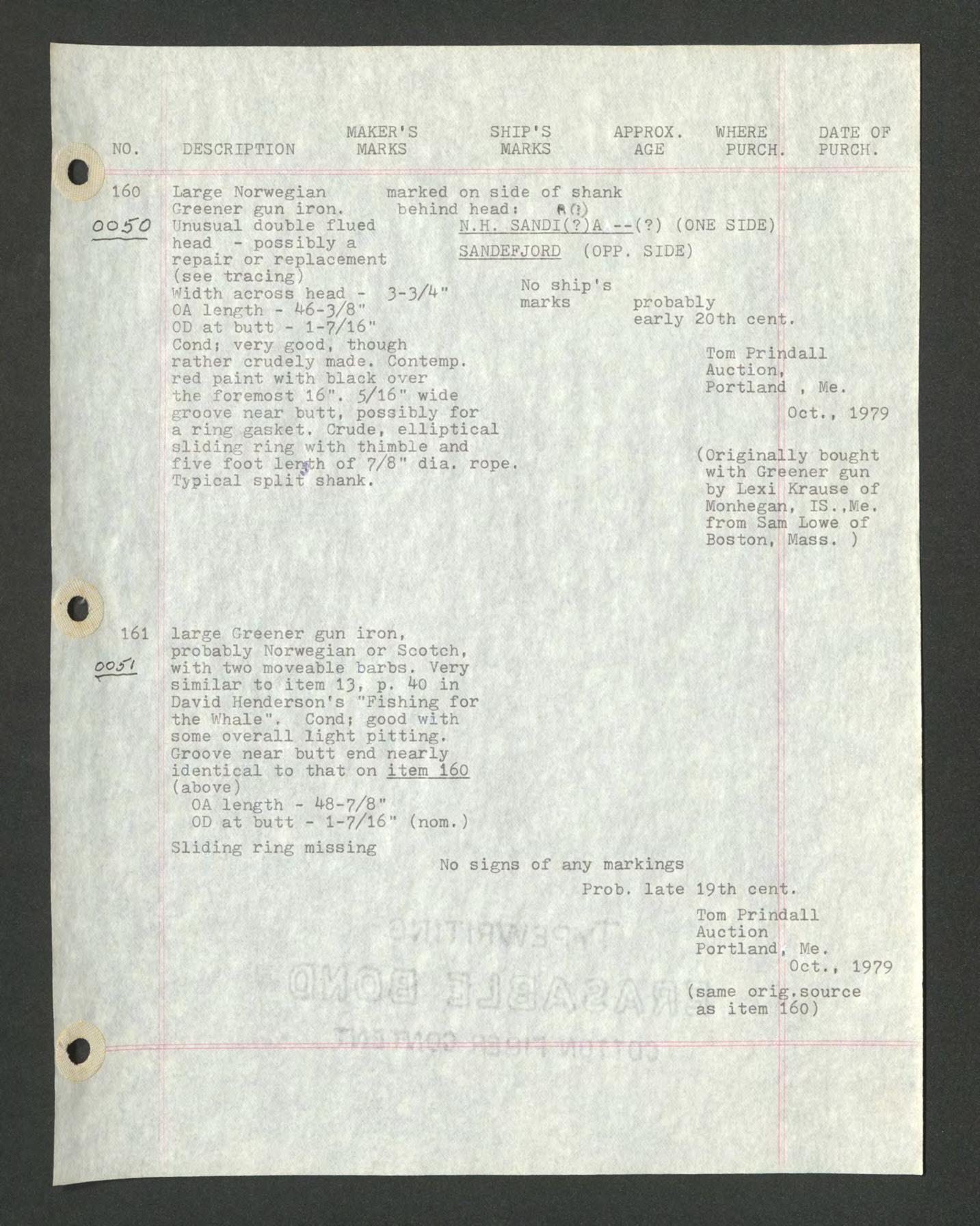
DATE OF PURCH.
N.H. SANDI(?")A --(?) (ONE SIDE)
SANDEFJORD (OPP. SIDE)
No ship's marks probably early 20th cent.
Condj very good, though rather crudely made. Contemp. red paint with black over the foremost 16". 5/16" wide groove near butt, possibly for a ring gasket. Crude, elliptical sliding ring with thimble and five foot len§th of 7/8" dia. rope, Typical spli£ shank.
•161 large Greener gun iron, probably Norwegian or Scotch, oofL with two moveable barbs, Very similar to item 13. p. 4-0 in David Henderson's "Fishing for the Whale", Cond; good with some overall light pitting. Groove near butt end nearly identical to that on item 160 (above)
OA length - 4-8-7/8"
OD at butt - 1-7/16" (nom.)
Sliding ring missing
Tom Prindall Auction, Portland Me. Oct., 1979
(Originally bought with Greener gun by Lexi Krause of Monhegan, IS.,Me. from Sam Lowe of Boston, Mass. )
No signs of any markings
Prob. late 19th cent.
Tom Prindall Auction Portland, Me, Oct., 1979
(same orig,source as item 160)
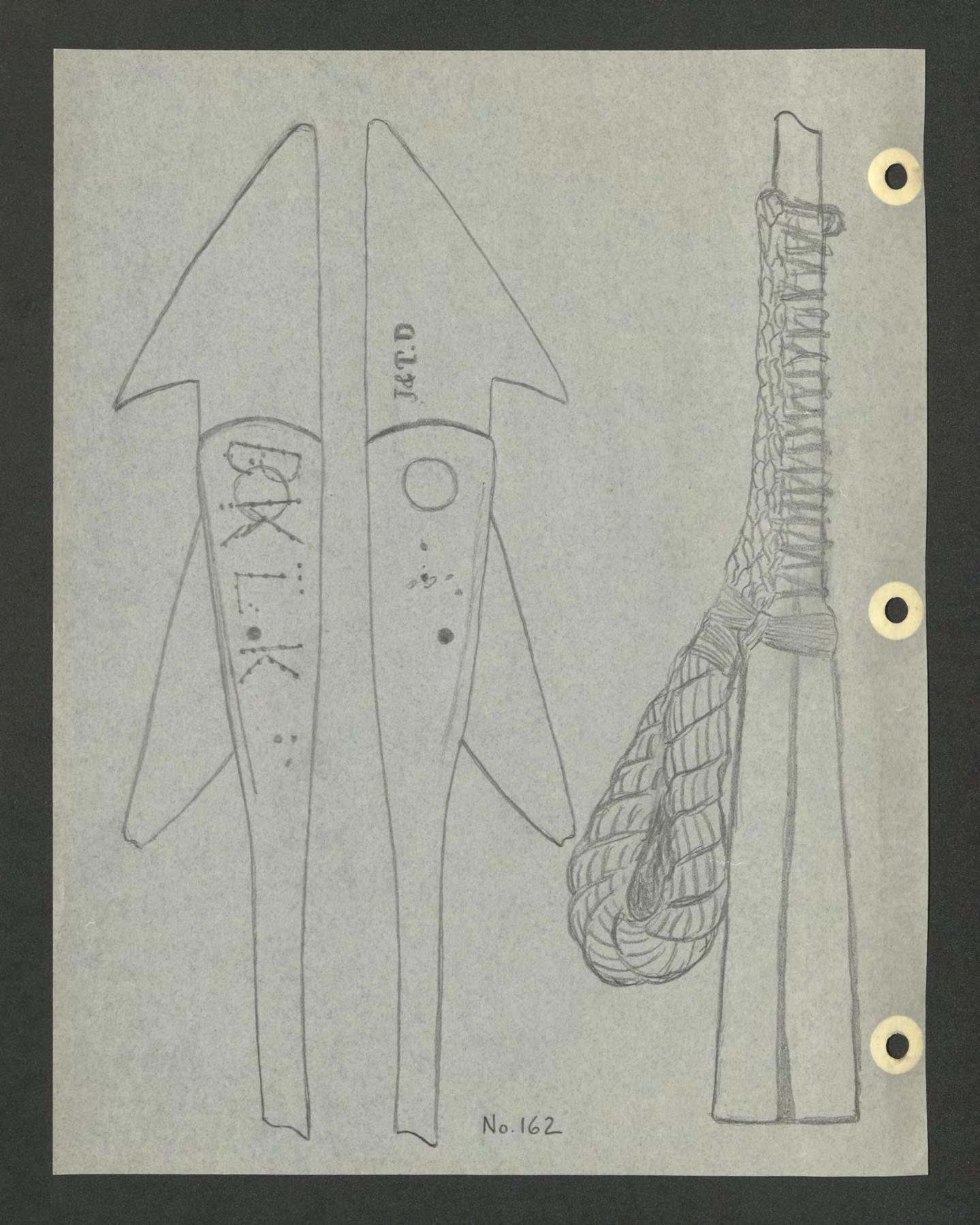
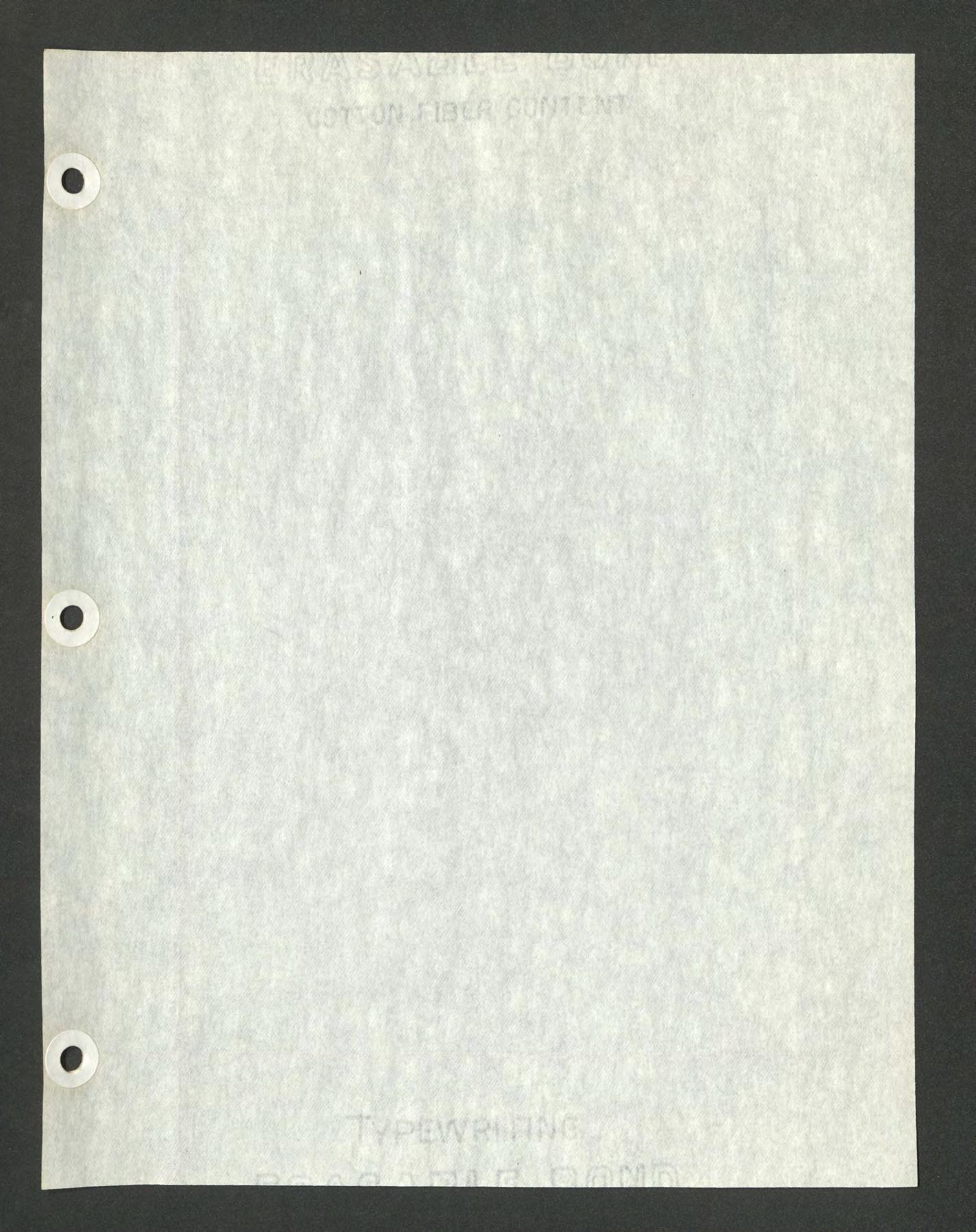
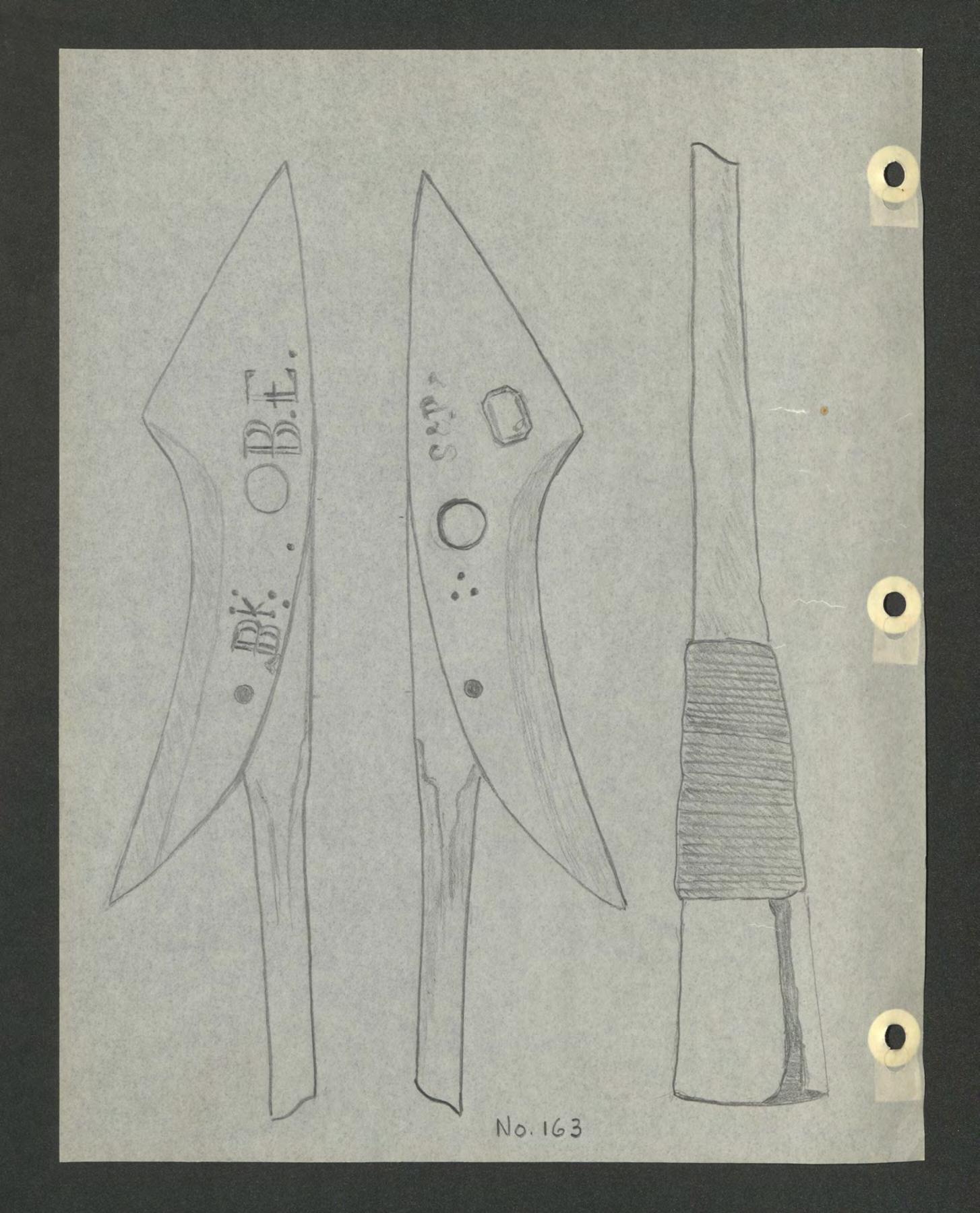
NO.
* 162
hlri-tHi ( Zojtjl
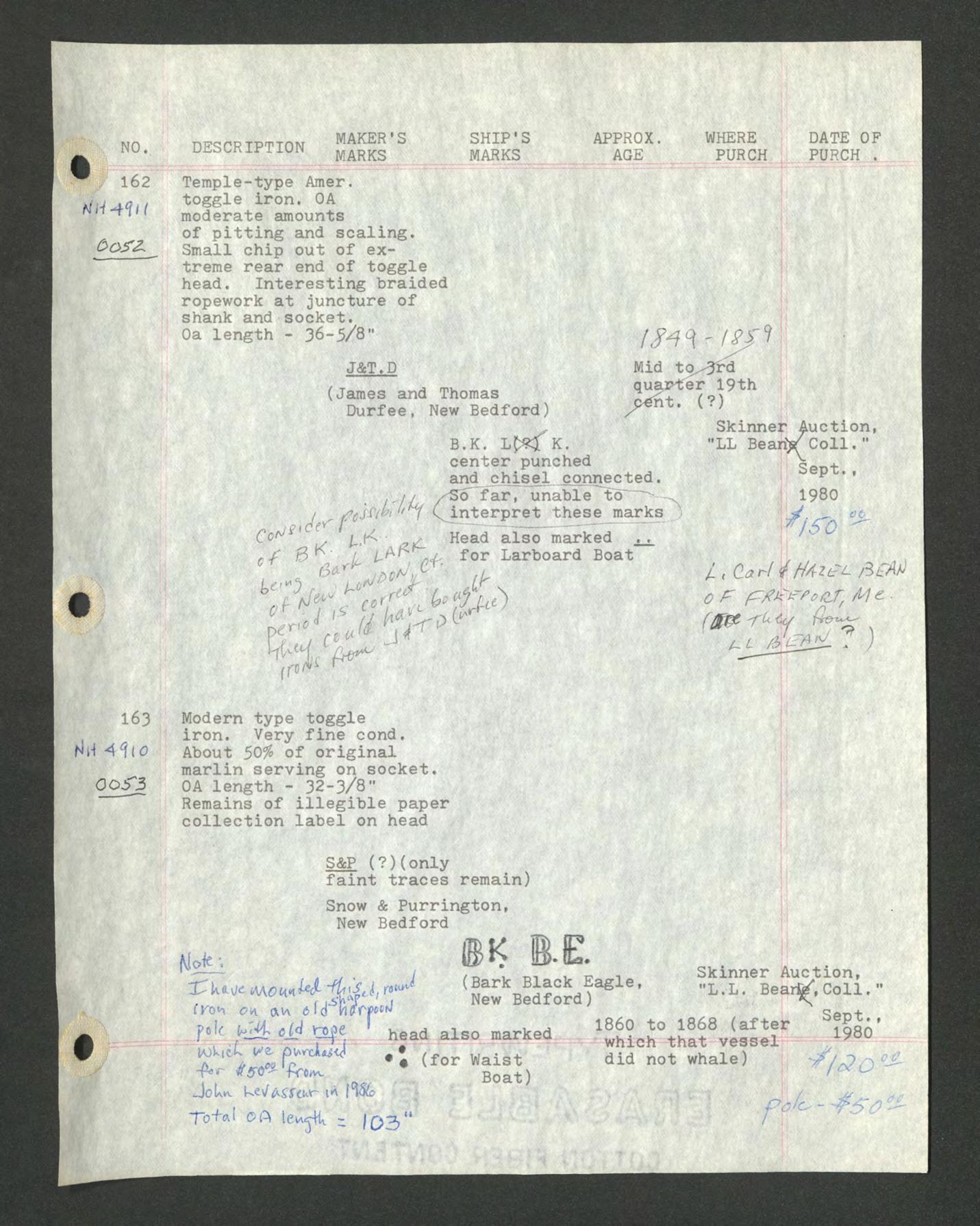
DESCRIPTION
MAKER'S MARKS SHIP'S MARKS APPROX. AGE WHERE PURCH DATE OF PURCH .
Temple-type Amer. toggle iron. OA moderate amounts of pitting and scaling. Small chip out of extreme rear end of toggle head. Interesting braided ropework at juncture of shank and socket. Oa length - 36-5/8"
J&T.D
(James and Thomas Durfee, New Bedford)
Mid tq..-3rd quarter 19th cent. (?)
B.K. K. center punched and chisel connected. ,// /So far, unable to >— / ,fcSfiVi''(( interpret these marks '/_,K" Head also marked ±j_ 0 L 7<f. for Larboard Boat y:<*cj h' ^ jjr N Skinner Auction, 'LL BeanVColl." Sept., 1980 W,!6~0 00 / ( Car-l 4 tfArltrt- /3CAti o CT ^/?k^Po(ZTf A-1 e- • ($& -T^ V A L ; )
Modern type toggle iron. Very fine cond. About 50% of original marlin serving on socket. OA length - 32-3/8" Remains of illegible paper collection label on head
S&P (?)(only faint traces remain)
Snow & Purrington, New Bedford ©K ©.£.
X^k<L\it raWl lv0'--> OA (XV\ 6 rd S M^ lApCCfd f°k head also marked
(Bark Black Eagle, New Bedford)
1£ *'• < for Waist -Per PW Boatj Jokn. keVAfffwr iA[l$l; To+ftl oA iew^k X 103"
i860 to 1868 (after which that vessel did not whale) Skinner Auction, "L.L. Bearjjj/,Coll." Sept,, 1980
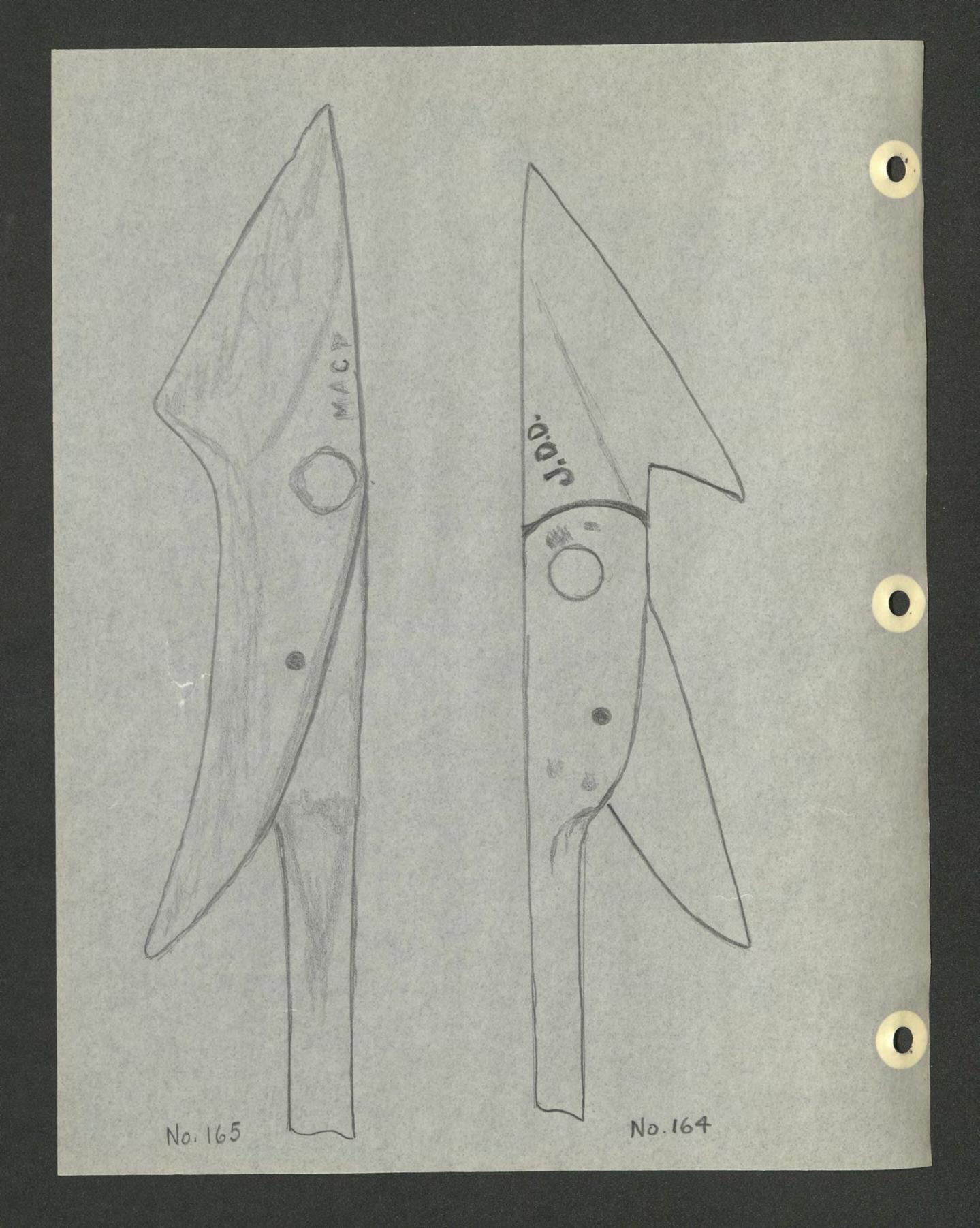
DESCRIPTION
164
GOf4
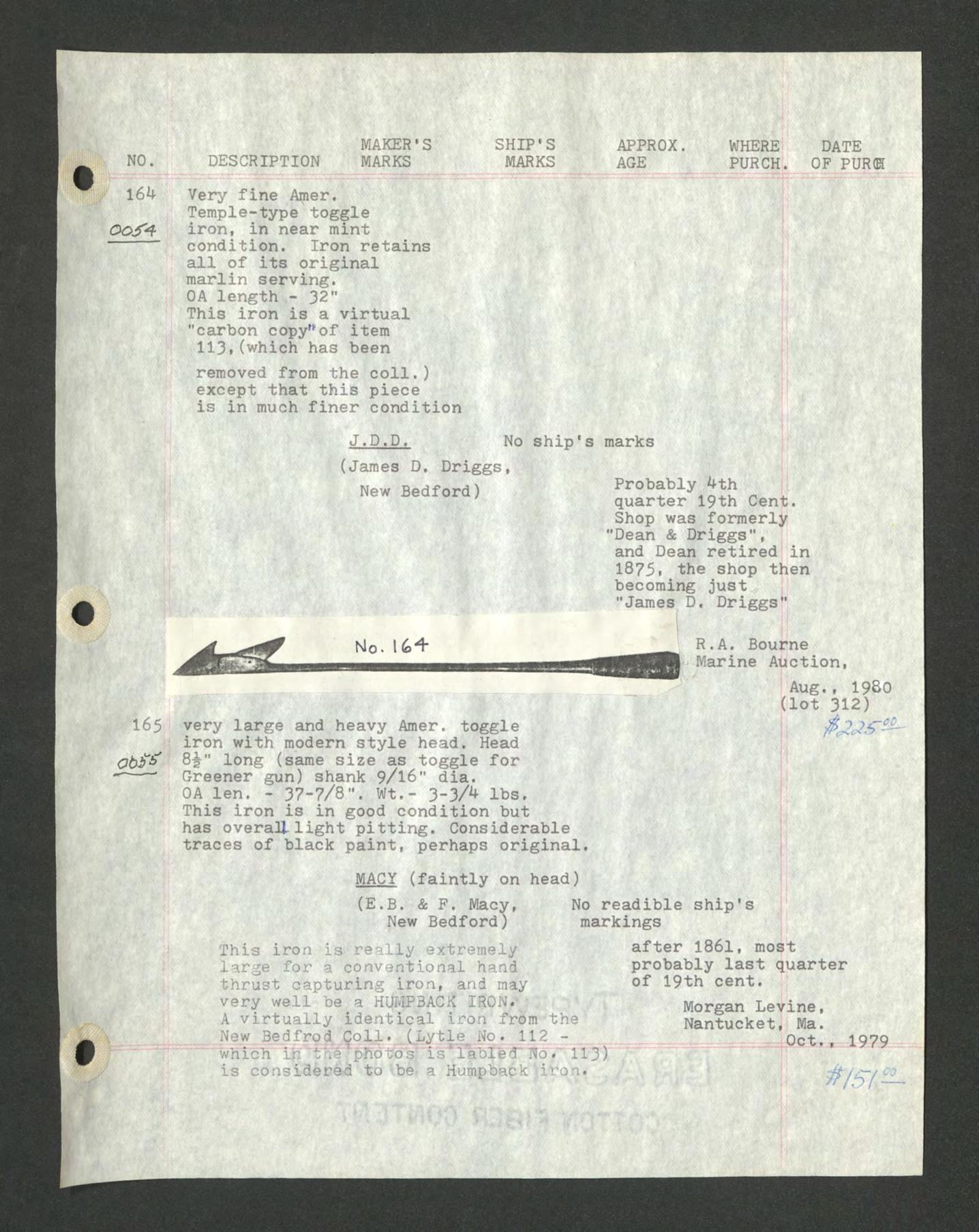
MAKER•S MARKS
Very fine Ainer. Temple-type toggle iron, in near mint condition. Iron retains all of its original marlin serving.
OA length - 32" This iron is a virtual "carbon copy"'of item 113,(which has been removed from the coll.) except that this piece is in much finer condition
SHIP•S MARKS APPROX. AGE WHERE PURCH. DATE OF PUR©
J.P.P. No ship's marks (James D. Driggs, New Bedford)
Probably 4th quarter 19th Cent. Shop was formerly Dean & Driggs", and Dean retired in 1875, the shop then becoming just "James D. Driggs"
Mo.I<s>4
165 very large and heavy Amer. toggle iron with modern style head. Head long (same size as toggle for Greener gun) shank 9/16" dia.
OA len. - 37-7/8", Wt.- 3-3/4 lbs. This iron is in good condition but has overall,light pitting. Considerable traces of black paint, perhaps original.
MACY (faintly on head)
(E.B. & F. Macy, New Bedford)
This iron is really extremely large for a conventional hand thrust capturing iron, and may very well be a HUMPBACK IRON.
R.A. Bourne Marine Auction,
Aug., 1980 (lot 312)
No readible ship's markings
after 1861, most probably last quarter of 19th cent.
A virtually identical iron from the New Bedfrod Coll, (Lytle No. 112which in the 1 pRoto's;is1 l'able<3T No. 113) is considered to be a Humpback iron.
Morgan Levine, Nantucket, Ma. Oct., 1979 #/S~L
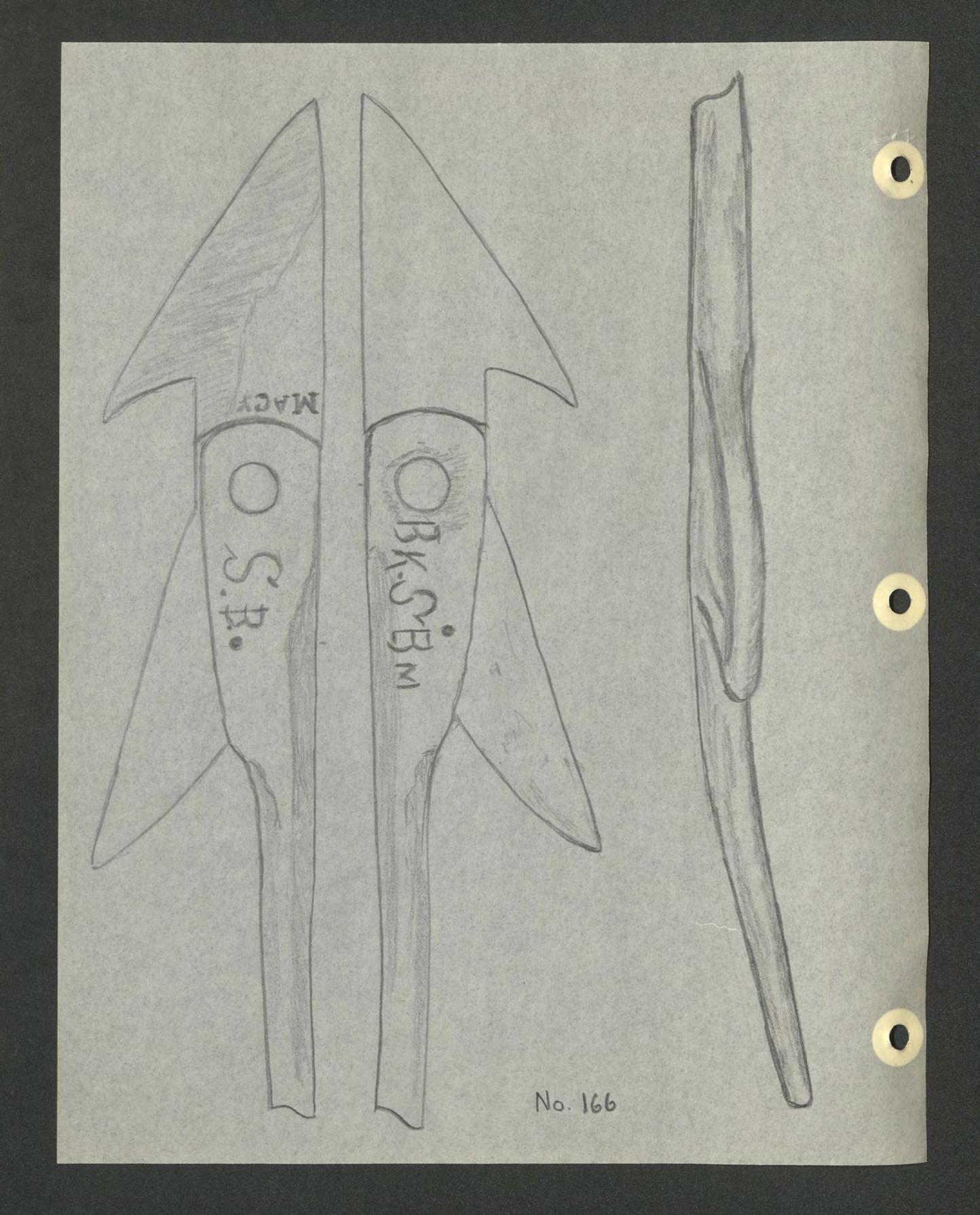
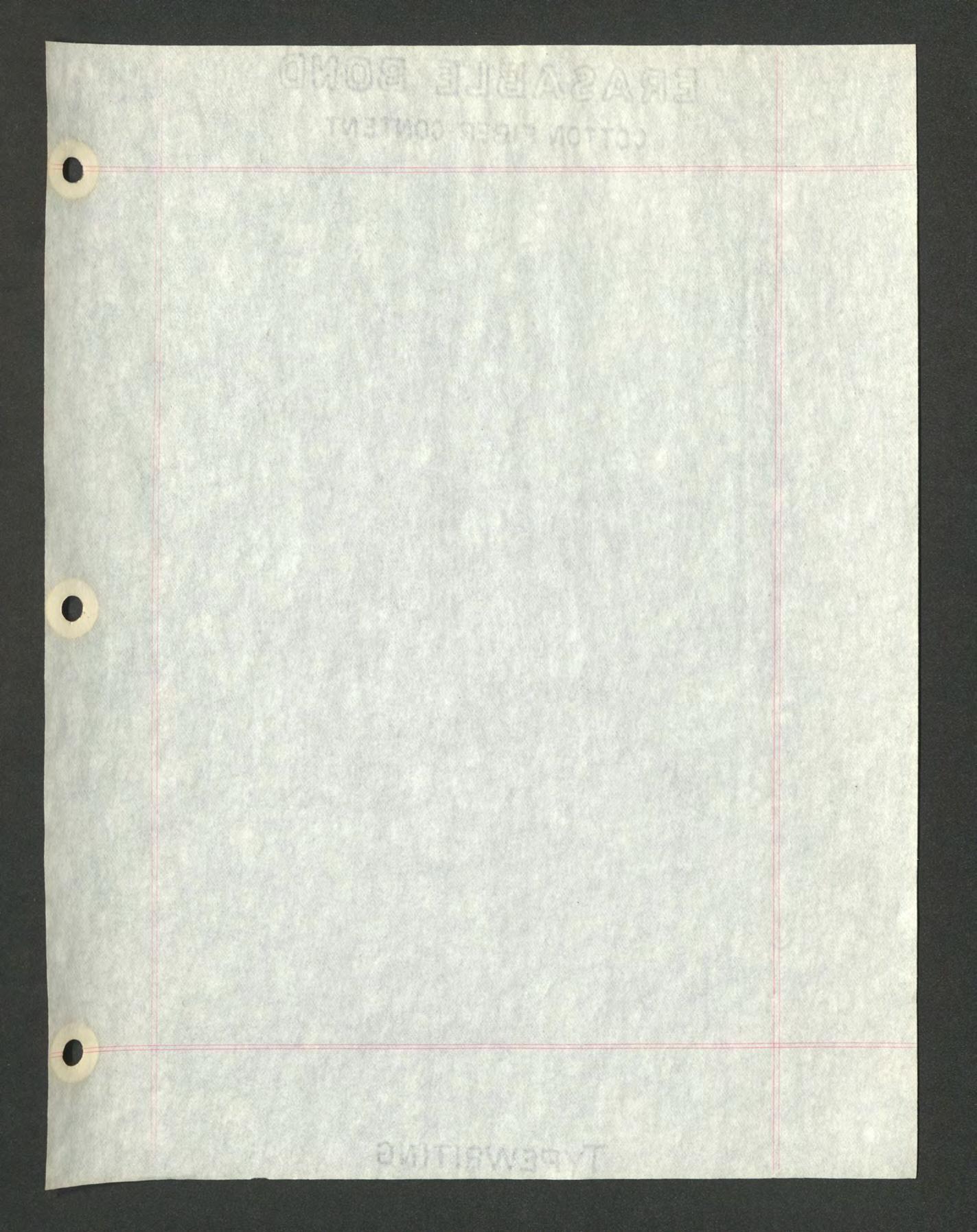

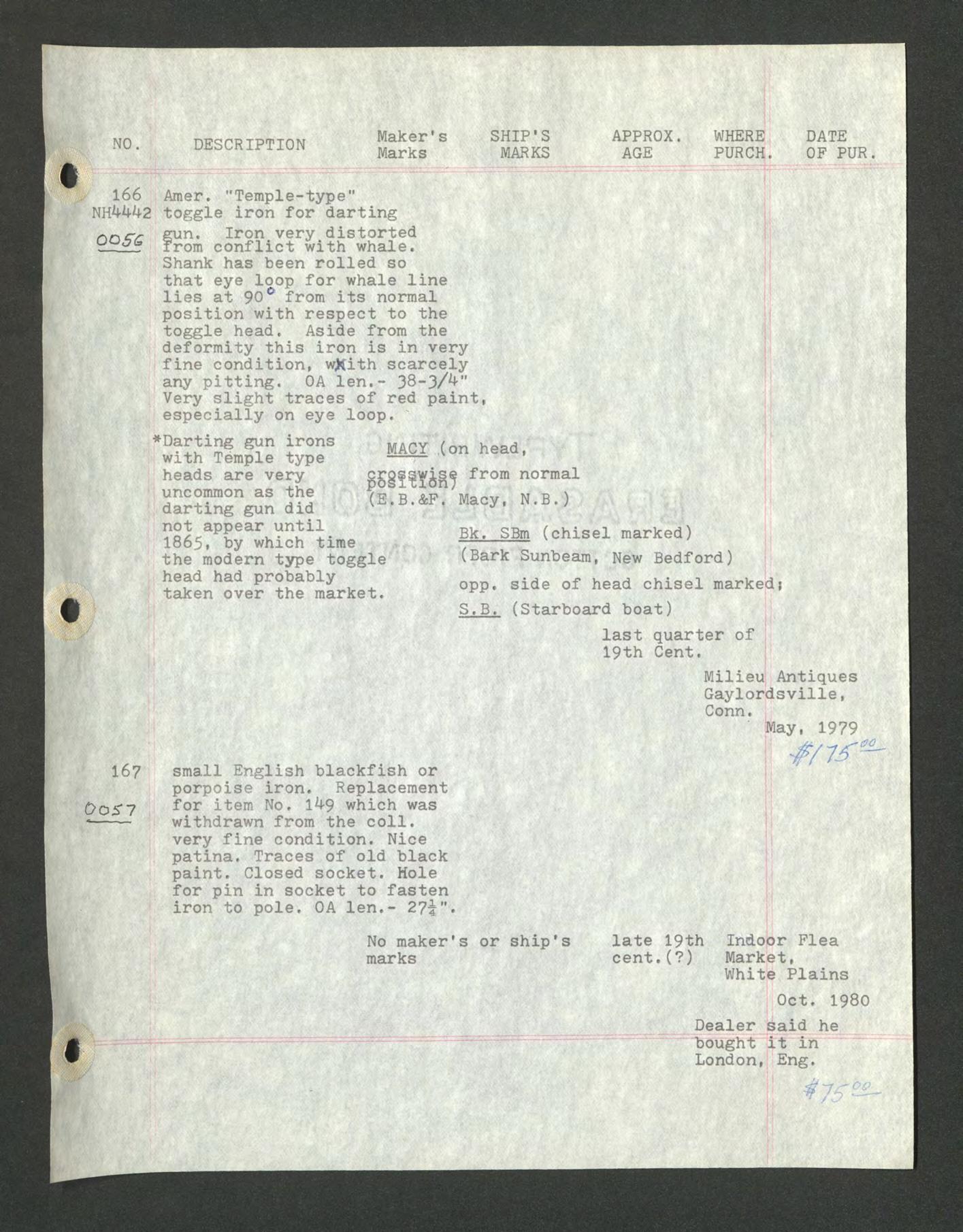
166 Amer. "Temple-type"
NH4442 toggle iron for darting err gun. Iron very distorted from conflict with whale. Shank has been rolled so that eye loop for whale line lies at 900 from its normal position with respect to the toggle head. Aside from the deformity this iron is in very fine condition, wXith scarcely any pitting. OA len.- 38-3/^" Very slight traces of red paint, especially on eye loop.
*Darting gun irons with Temple type heads are very uncommon as the darting gun did not appear until 186.5, by which time the modern type toggle head had probably taken over the market.
MACY (on head, poSffi^n^ ^rom normal (E.B.&F. Macy, N.B.)
Bk, SBm (chisel marked) (Bark Sunbeam, New Bedford) opp, side of head chisel marked; S.B. (Starboard boat) last quarter of 19th Cent, Milieu Antiques Gaylordsville, Conn. May, 1979
small English blackfish or porpoise iron. Replacement for item No, 1^9 which was withdrawn from the coll. very fine condition. Nice patina. Traces of old black paint. Closed socket. Hole for pin in socket to fasten iron to pole. OA len.- 27i".
No maker's or ship's marks late 19th cent.(?) Indoor Flea Market, White Plains
Oct, 1980
Dealer said he bought it in London, Eng. W ;s -
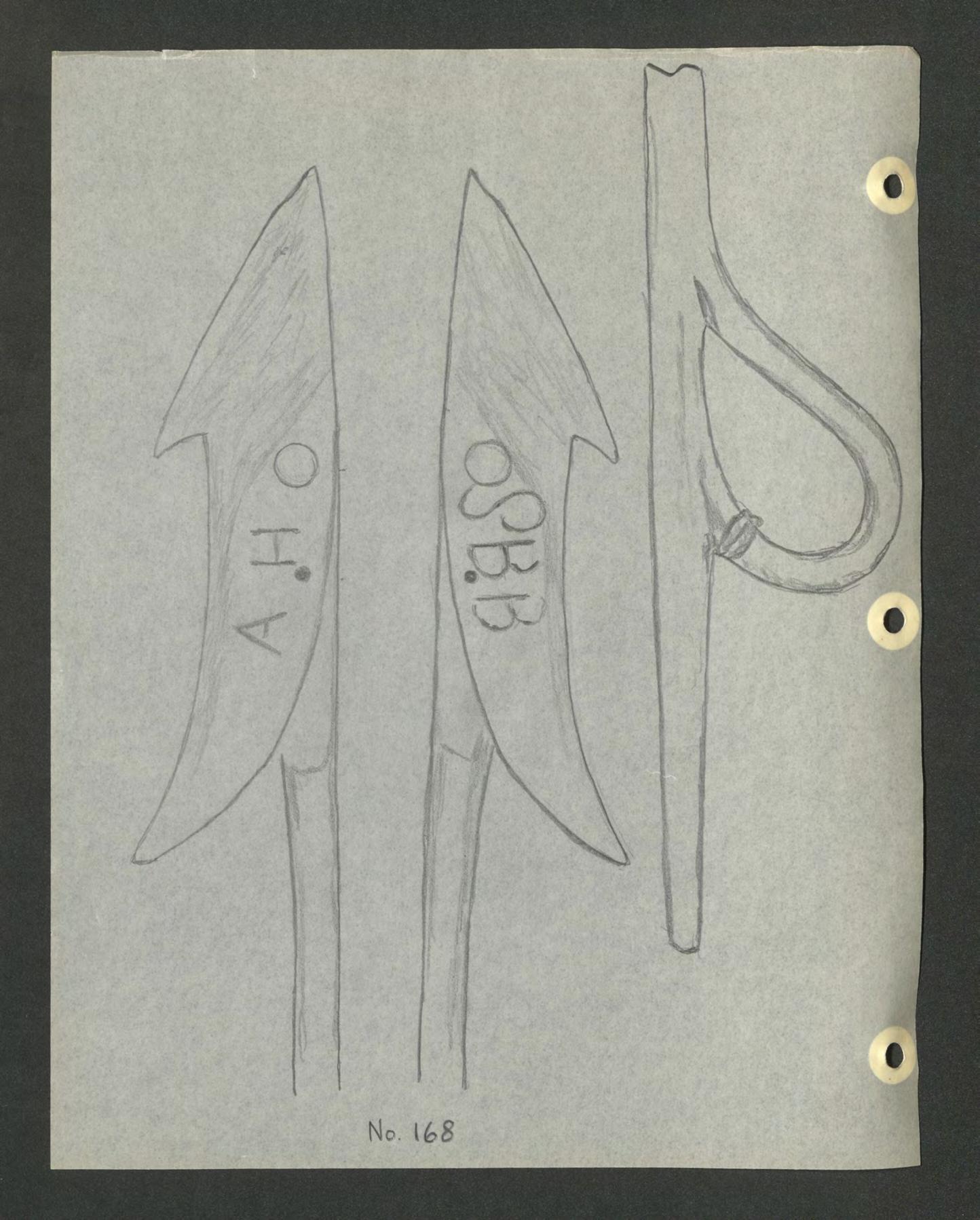
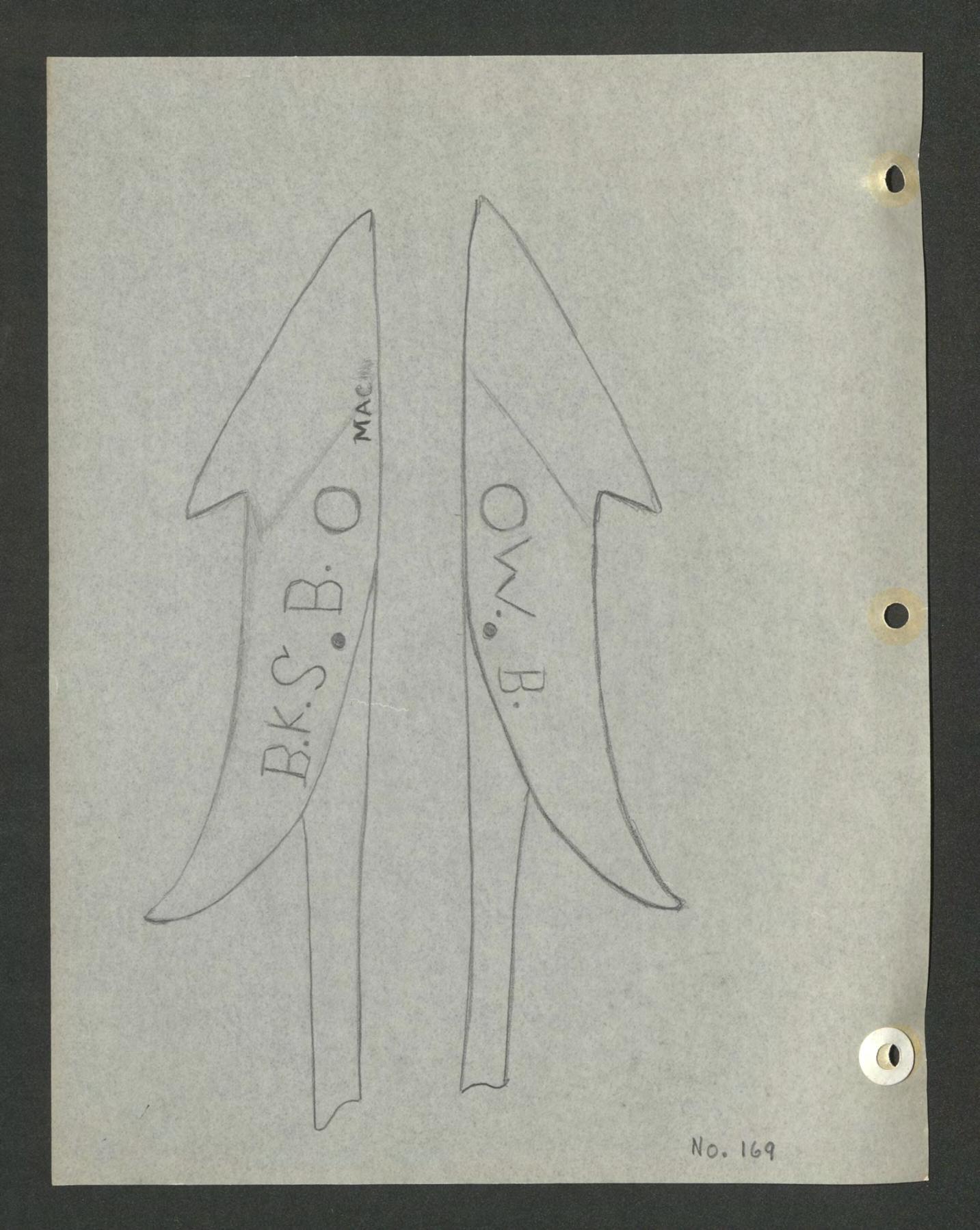
DESCRIPTION
Modern style toggle darting iron.
MAKER•S MARKS SHIP'S MARKS APPROX. AGE WHERE PURCH.
OA moderate to heavy pitting. Very slight trace of rope serving on eye loop. OA len- 38-1/8"
(ri if 86 c{rsyttby-ecf oh pierce k'^otd
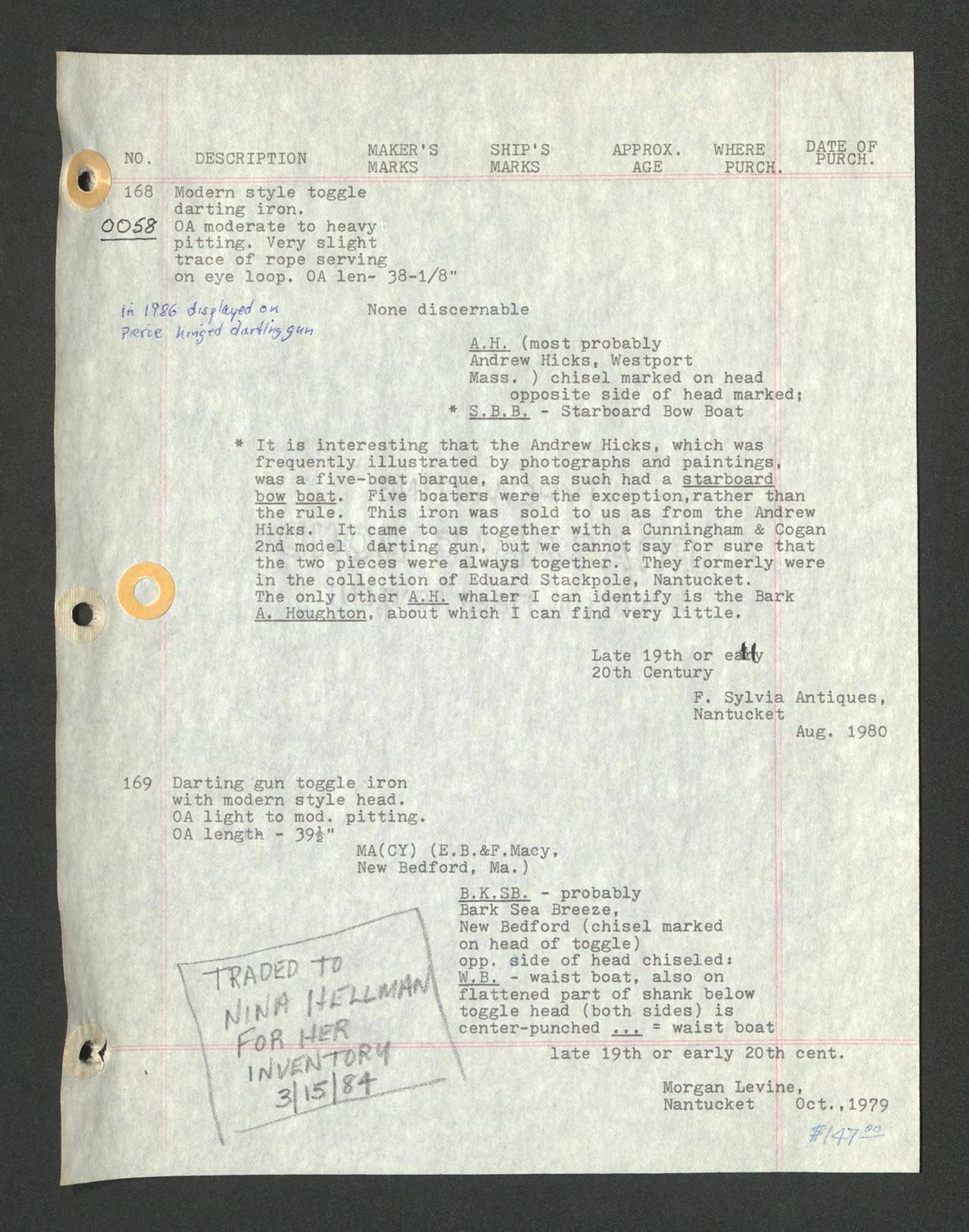
DATE OF PURCH.
None discernable
A.H. (most probably Andrew Hicks, Westport Mass. )chisel marked on head opposite side of head marked; * S,B.B. - Starboard Bow Boat
* It is interesting that the Andrew Hicks, which was frequently illustrated by photographs and paintings, was a five-boat barque, and as such had a starboard bow boat. Five boaters were the exception,rather than the rule. This iron was sold to us as from the Andrew Hicks. It came to us together with a Cunningham & Cogan 2nd modeli darting gun, but we cannot say for sure that the two pieces were always together. They formerly were in the collection of Eduard Stackpole, Nantucket. The only other A.H. whaler I can identify is the Bark A. Houghton, about which I can find very little.
Late 19th or e^Hy 20th Century F, Sylvia Antiques, Nantucket Aug. 1980
169 Darting gun toggle iron with modern style head.
OA light to mod, pitting. OA length - 39i"
MA(CY) (E.B.&F.Macy, New Bedford, Ma.)
B.K.SB. - probably Bark Sea Breeze, New Bedford (chisel marked on head of toggle) opp. side of head chiseled: W,B, - waist boat, also on flattened part of shank below \ toggle head (both sides) is center-punched = waist boat late 19th or early 20th cent.
Morgan Levine, Nantucket Oct.,1979 w /SO
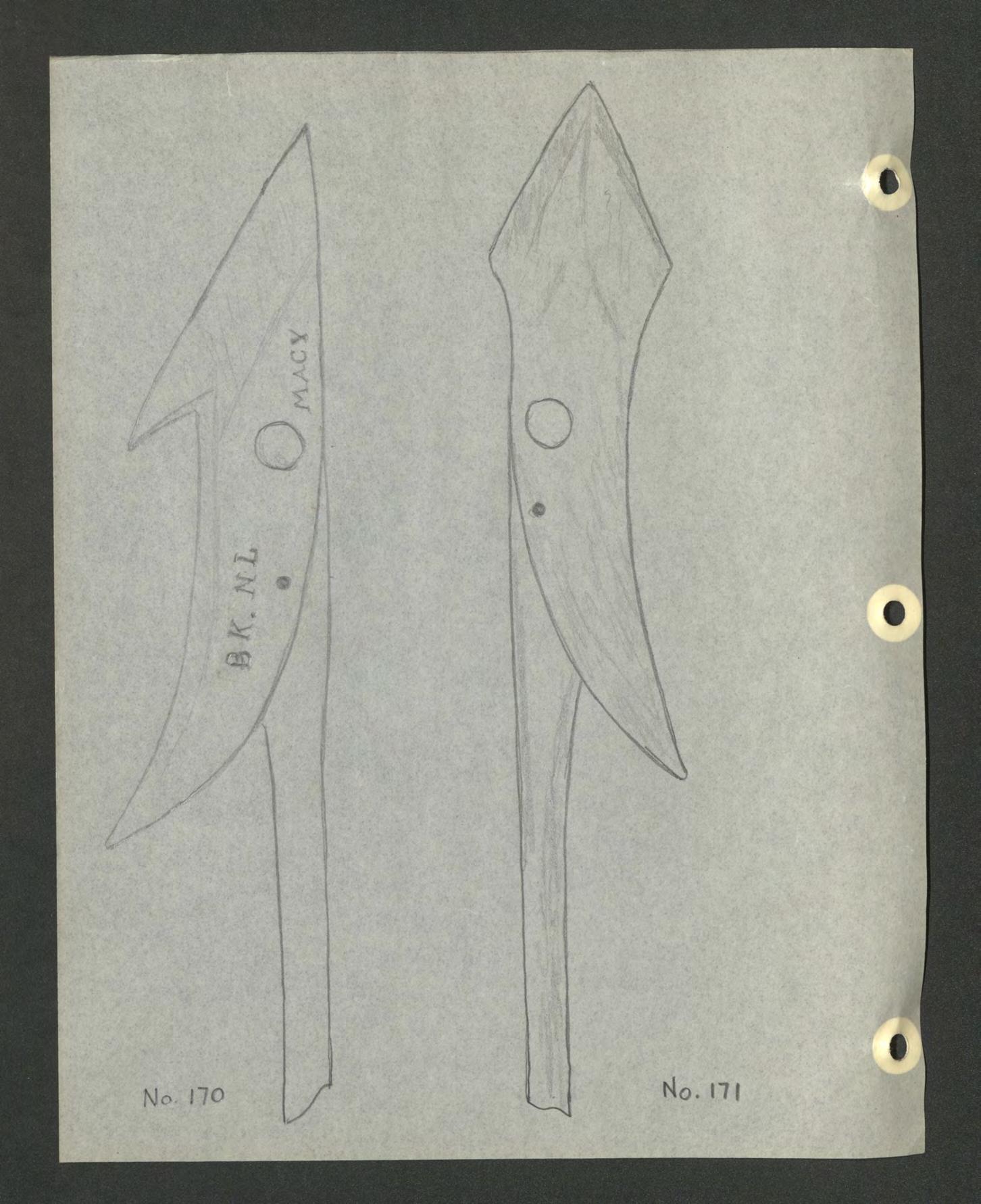
No. DESCRIPTION
170 fiJak.
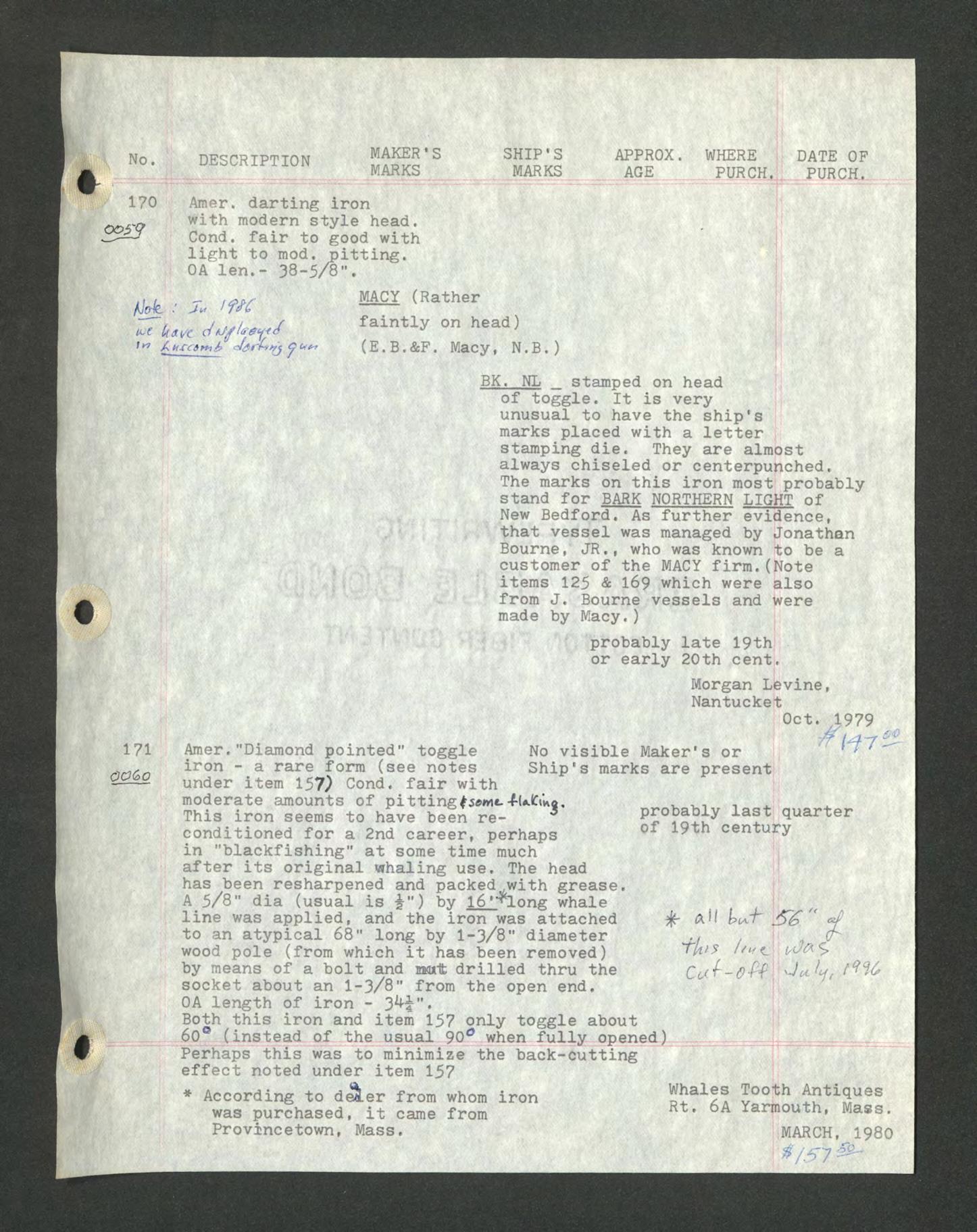
Amer. darting iron with modern style head. Cond. fair to good with light to mod. pitting.
OA len.- 38-5/8".
J-M itavc c/ktjf i" Aurea mj, JarbtAj J
1?1
COGo
MACY (Rather faintly on head) (E.B.&F. Macy, N.B.)
BK. NL _ stamped on head of toggle. It is very unusual to have the ship's marks placed with a letter stamping die. They are almost always chiseled or centerpunched. The marks on this iron most probably stand for BARK NORTHERN LIGHT of New Bedford. As further evidence, that vessel was managed by Jonathan Bourne, JR., who was known to be a customer of the MACY firm.(Note items 125 & 169 which were also from J. Bourne vessels and were made by Macy.) probably late 19th or early 20th cent, Morgan Levine, Nantucket Oct. 1979 >7 U4-7£5No visible Maker's or 1 Ship's marks are present
Amer."Diamond pointed" toggle iron - a rare form (see notes under item 157) Cond. fair with moderate amounts of pittingfwwt--f-UiCiko, This iron seems to have been reconditioned for a 2nd career, perhaps in "blackfishing" at some time much after its original whaling use. The head has been resharpened and packed with grease. A//8" dia (usual is i") by 16'Tlong whale line was applied, and the iron was attached to an atypical 68" long by 1-3/8" diameter wood pole (from which it has been removed) by means of a bolt and mat; drilled thru the socket about an 1-3/8" from the open end, OA length of iron - 3^i"'
probably last quarter of 19th century #• all U&'S6' "T~in? ///-/{_ CaP-0-Pf 'J(•<- 'ci /
Both this iron and item 157 only toggle about 60° (instead of the usual 90° when fully opened) Perhaps this was to minimize the back-cutting effect noted under item 157
* According to de&Ler from whom iron p+^Ia y00"1^ was purchased, it came from Yarmouth, Mass. Provincetown, Mass, MARCH, 1980 $/51^
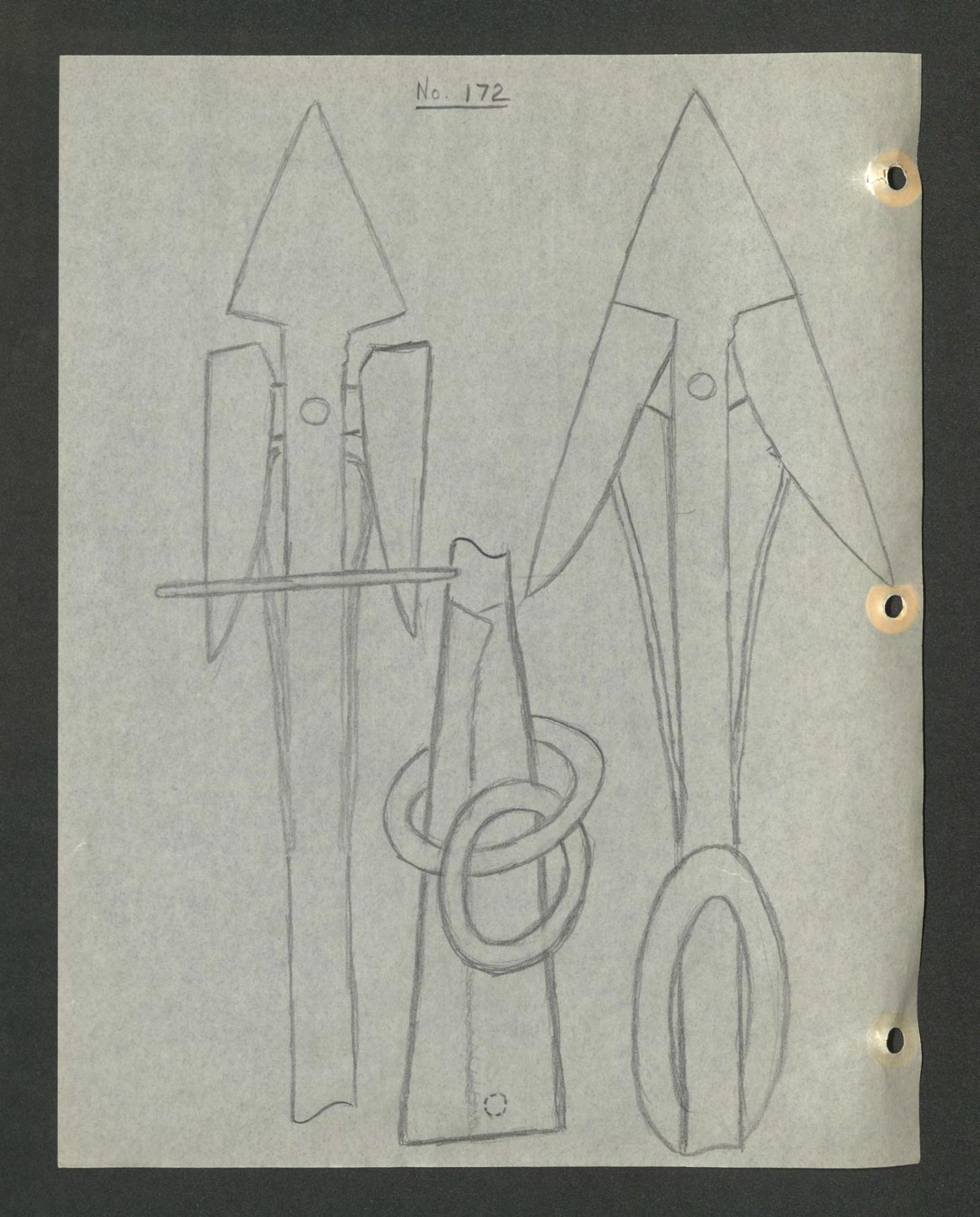
173
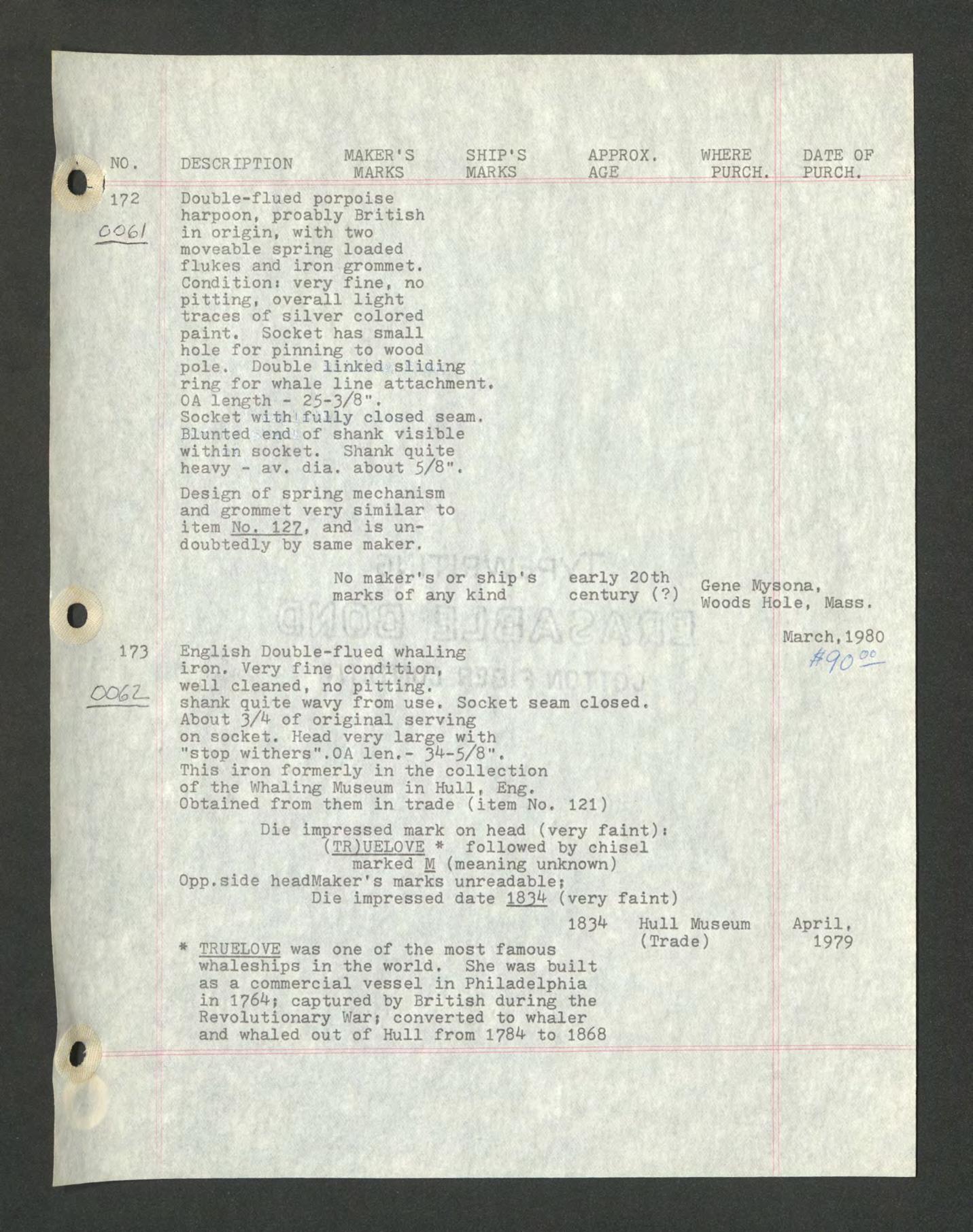
DESCRIPTION
MAKER'S MARKS SHIP'S MARKS APPROX, AGE WHERE PURCH. DATE OF PURCH.
Double-flued porpoise harpoon, proably British in origin, with two moveable spring loaded flukes and iron grommet. Condition: very fine, no pitting, overall light traces of silver colored paint. Socket has small hole for pinning to wood pole. Double linked sliding ring for whale line attachment.
OA length - 25-3/8".
Socket with!fully closed seam. Blunted end of shank visible within socket. Shank quite heavy - av. dia. about 5/8".
Design of spring mechanism and grommet very similar to item No. 127. and is undoubtedly by same maker.
No maker's or ship's marks of any kind early 20th century (?)
English Double-flued whaling iron. Very fine condition, well cleaned, no pitting. shank quite wavy from use. Socket seam closed. About 3/4 of original serving on socket. Head very large with "stop withers".OA len.- 34-5/8". This iron formerly in the collection of the Whaling Museum in Hull, Eng. Obtained from them in trade (item No. 121)
Die impressed mark on head (very faint): (TR)UELOVE * followed by chisel marked M (meaning unknown) 0pp.side headMaker's marks unreadable; Die impressed date 1834 (very faint)
Gene Mysona, Woods Hole, Mass.
March,1980 1834
TRUELOVE was one of the most famous whaleships in the world. She was built as a commercial vessel in Philadelphia in 1764; captured by British during the Revolutionary War; converted to whaler and whaled out of Hull from 1784 to 1868
Hull Museum (Trade) April, 1979
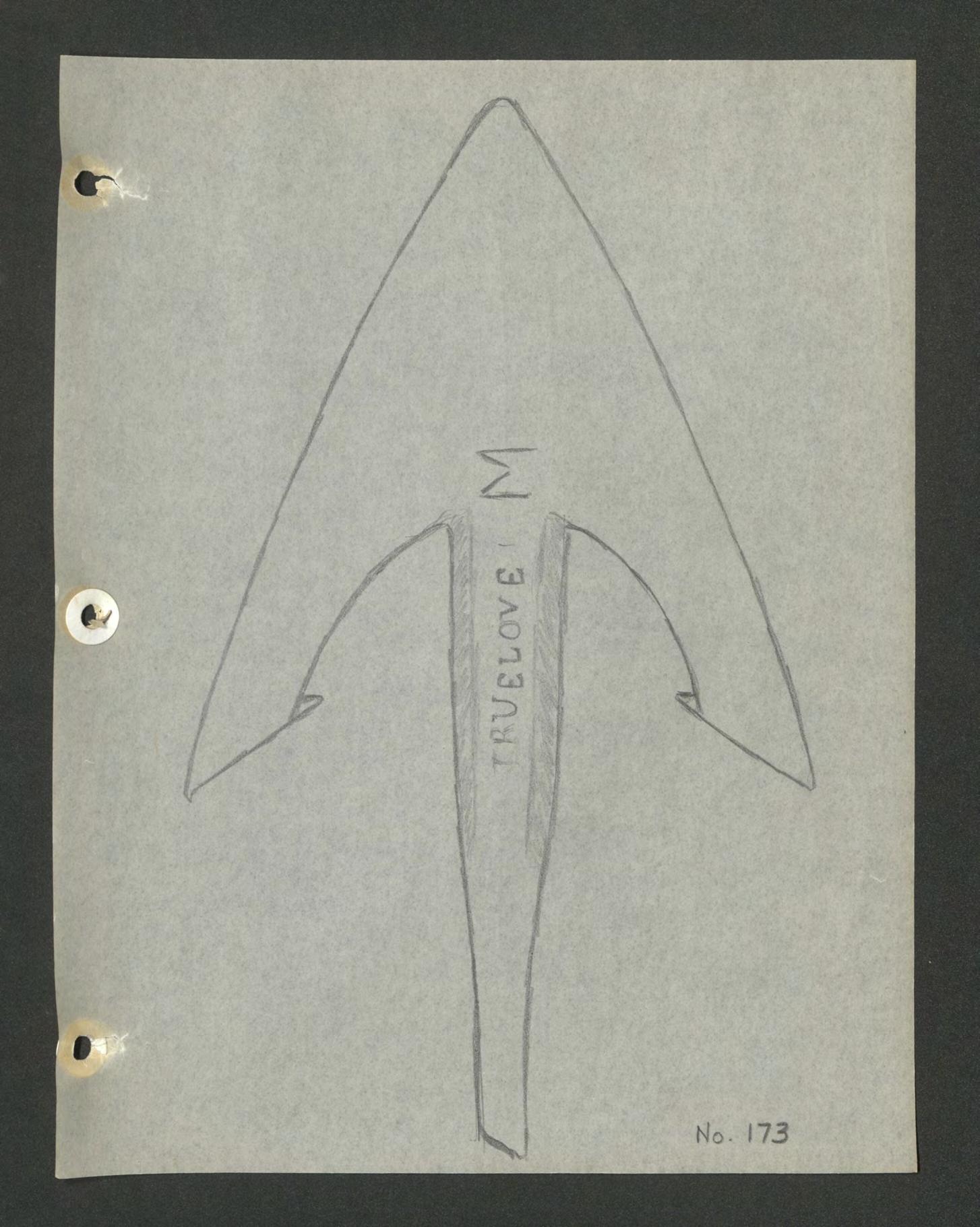
Handy as a cutter, safeas a lifeboat':The 'Truelove' and whaling in transition Lecture-Hall the TWO
Milt ,i»ni F<timlf,rt hnnw hy J'rnrhf v of lluti fam* X>arHrk.lu iWt'M of f***'$#' .Straps
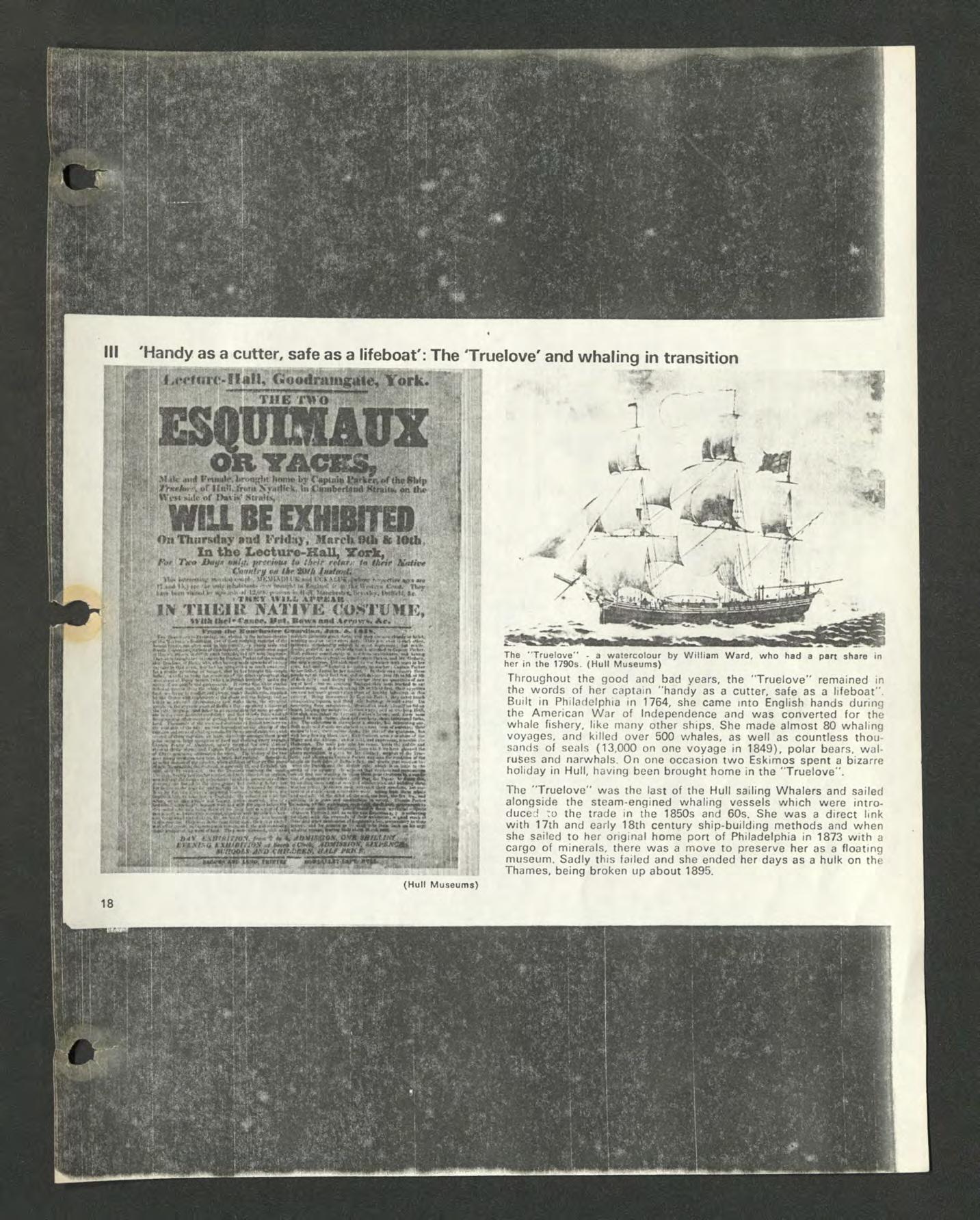
iiu r»tVrrtof fheFlup yertfliKl Mtraifj* the
Ot» Thursday aad TrMay, March Mb & 10th
In the Leeture-Kall, York,
/•V Tied JMffs unlit, prtt foto in iffvir rtlnr, fti thrir fasti tv Cart ittry att Ike 20//; Instant, Vhi* w.u.t-4 eeoffc:, IK»i.-jl'<:Kr.-HCftr* are (" «Mt \}>.) tf '«< "»!>' iiifvbiMHt- •-<:»fcutfcttn! ii ai'sii*U:;-^ 't» <>»*». 7W hawt+iii »vh)i*.lb- *J*4ph »f IS,#®; biH>;VM#urbt«ht»'V»iik*,(ht&rtJ,Ac TMKi » at .tl'rKAK m TilKIIf NATIVE roSTUMH,
The "Truelove" - a watercolour by William Ward, who had a part share in her in the 1790s. (Hull Museums)
Throughout the good and bad years, the "Truelove" remained in the words of her captain "handy as a cutter, safe as a lifeboat". Built in Philadelphia in 1764, she came into English hands during the American War of Independence and was converted for the whale fishery, like many other ships. She made almost 80 whaling voyages, and killed over 500 whales, as well as countless thousands of seals (13,000 on one voyage in 1849), polar bears, walruses and narwhals. On one occasion two Eskimos spent a bizarre holiday in Hull, having been brought home in the "Truelove".
The "Truelove" was the last of the Hull sailing Whalers and sailed alongside the steam-engined whaling vessels which were introduced to the trade in the 1850s and 60s. She was a direct link with 17th and early 18th century ship-building methods and when she sailed to her original home port of Philadelphia in 1873 with a cargo of minerals, there was a move to preserve her as a floating museum. Sadly this failed and she ended her days as a hulk on the Thames, being broken up about 1895.
